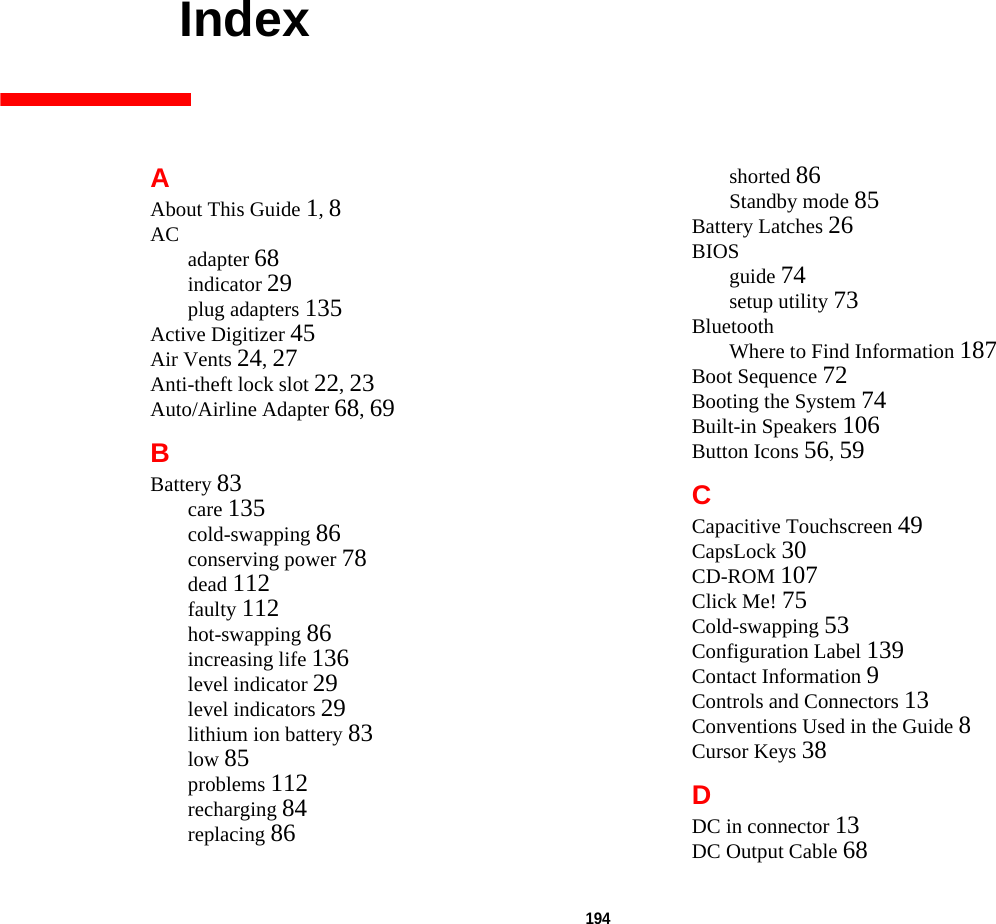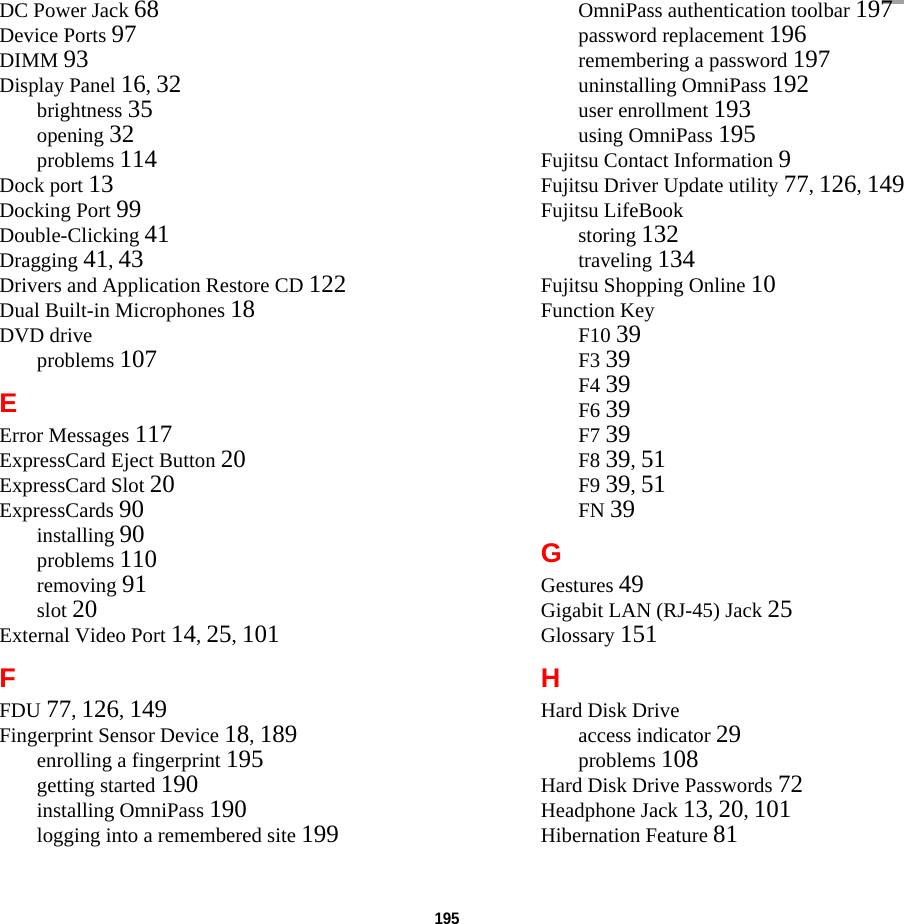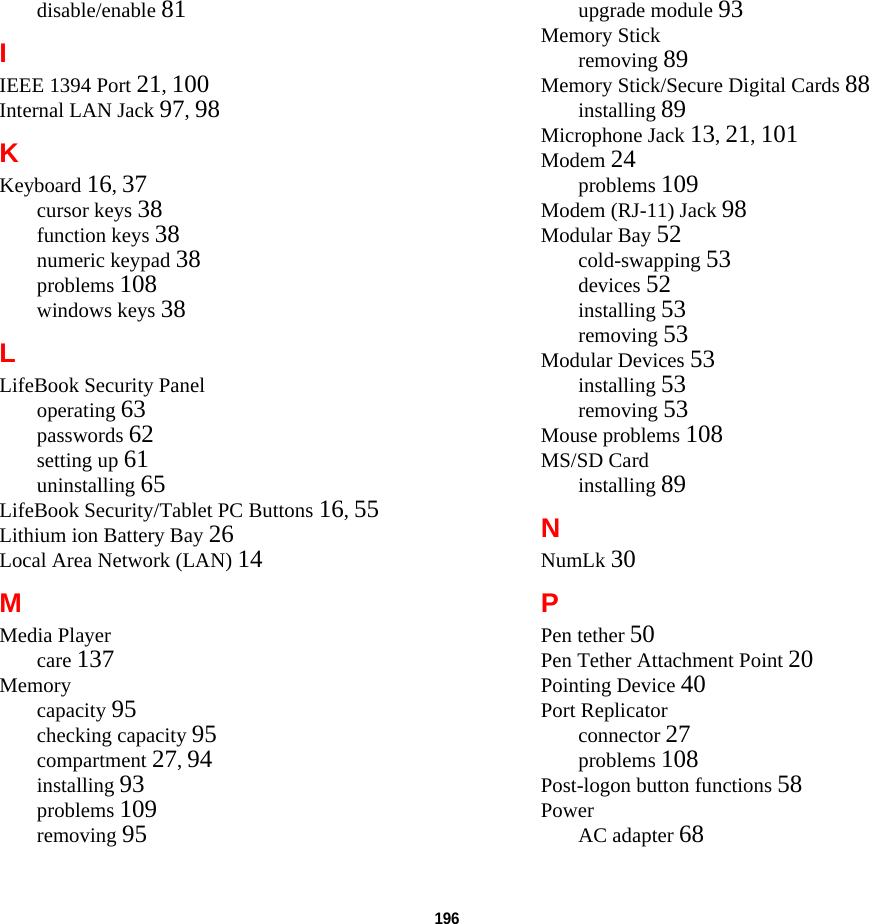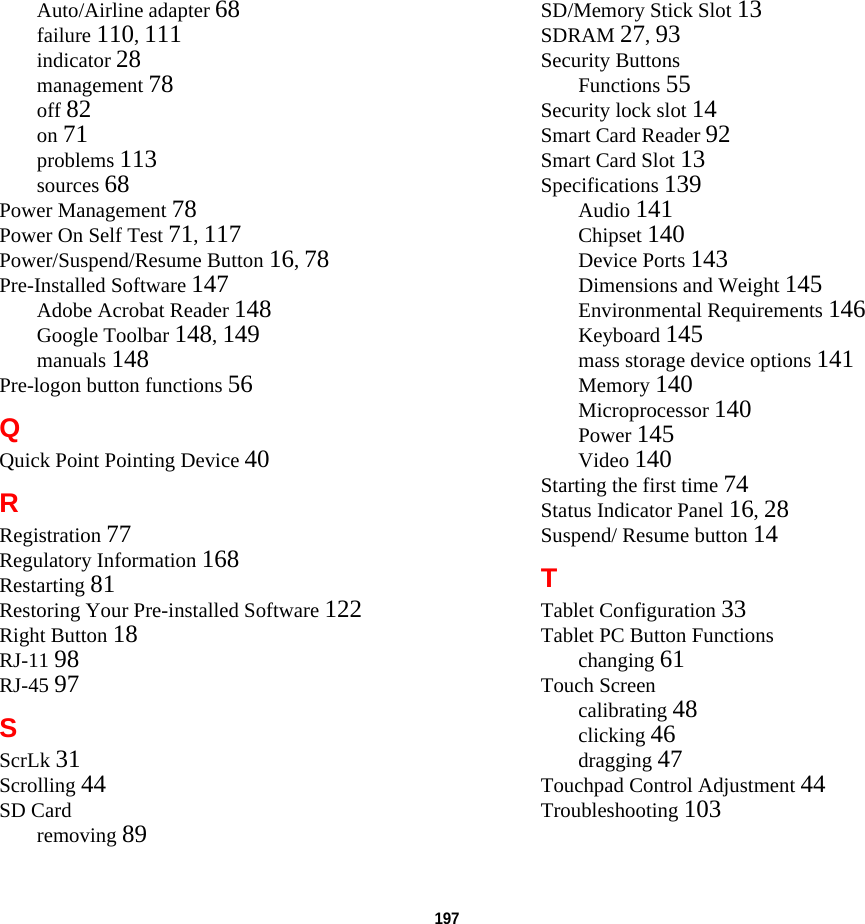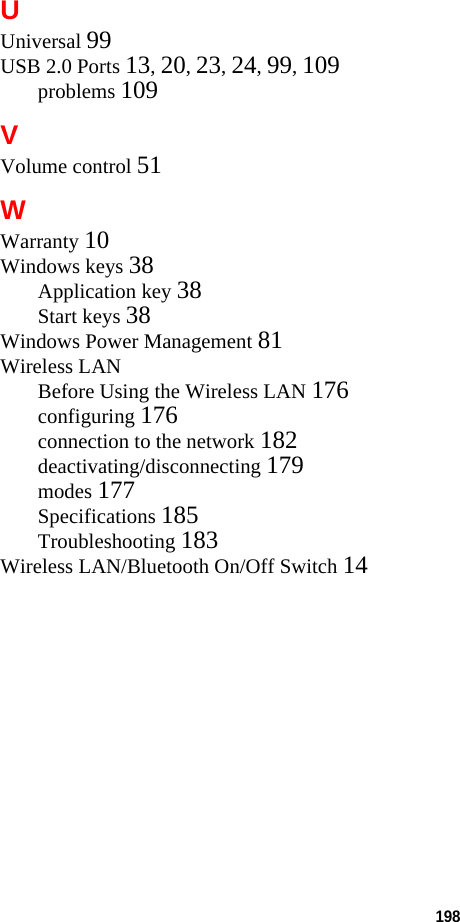Fujitsu Client Computing WL0024 PORTABLE PC LIFEBOOK T SERIES WITH 62205ANHMW WLAN User Manual Stork T901
Fujitsu Limited PORTABLE PC LIFEBOOK T SERIES WITH 62205ANHMW WLAN Stork T901
Contents
- 1. User Manual
- 2. Updated User Manual for CRN99288
- 3. Updated manual
Updated manual
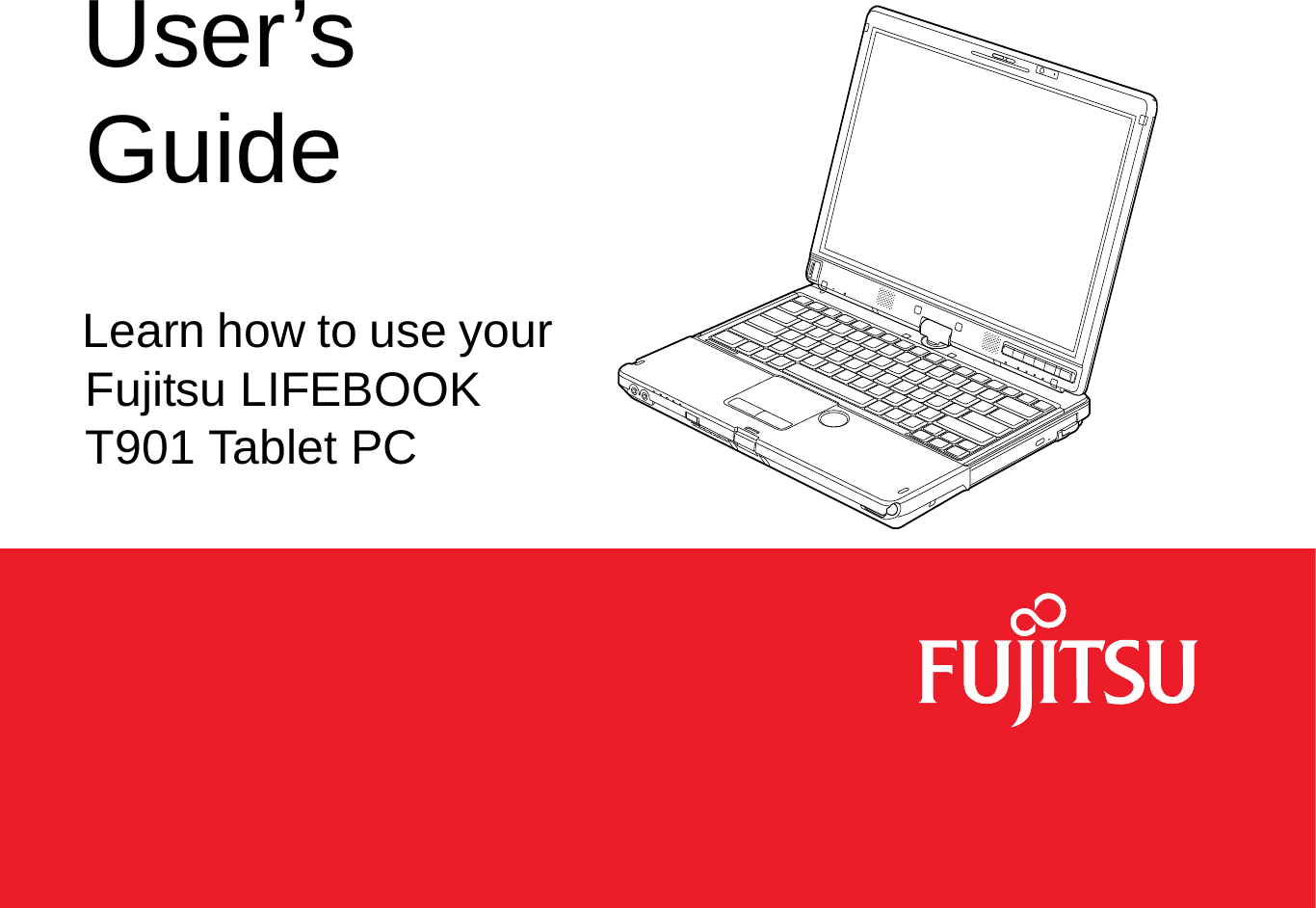
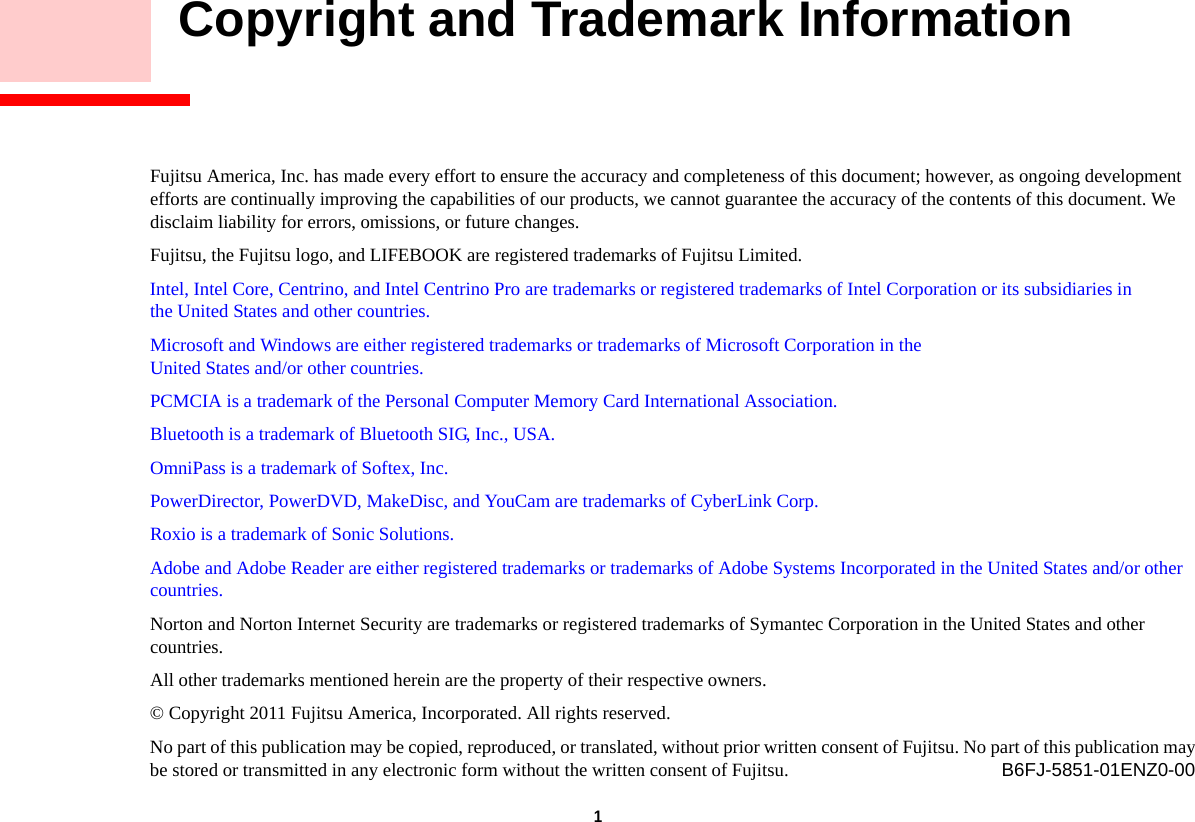
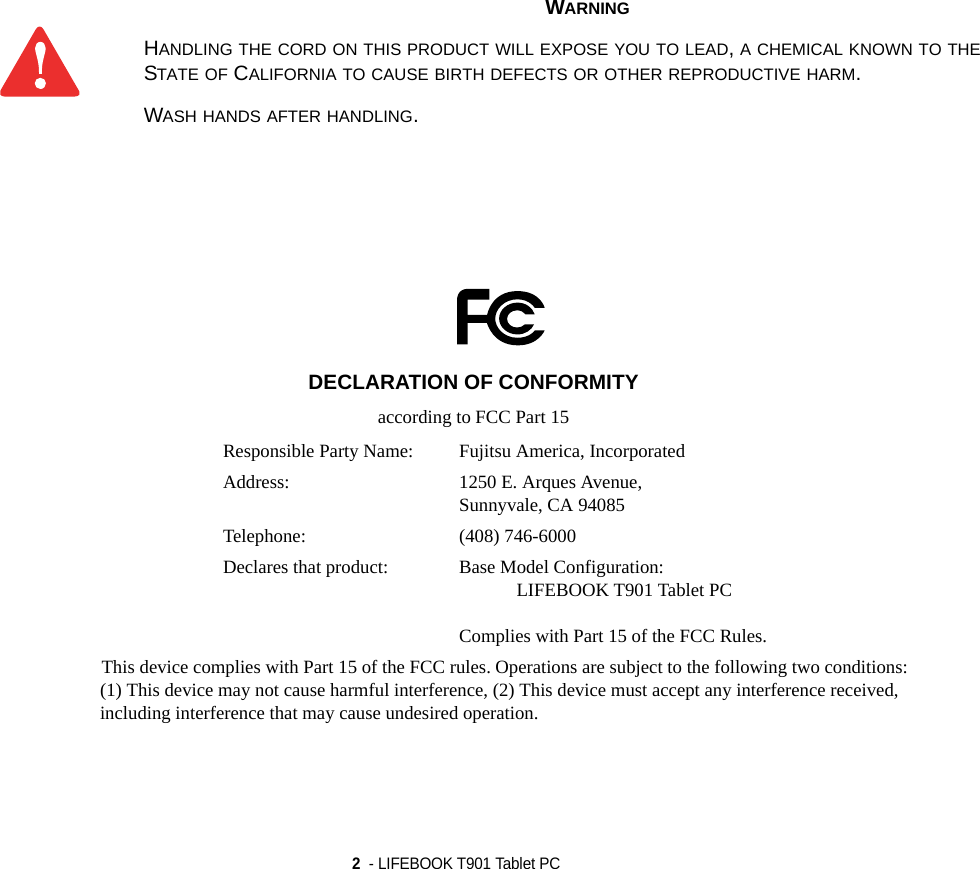
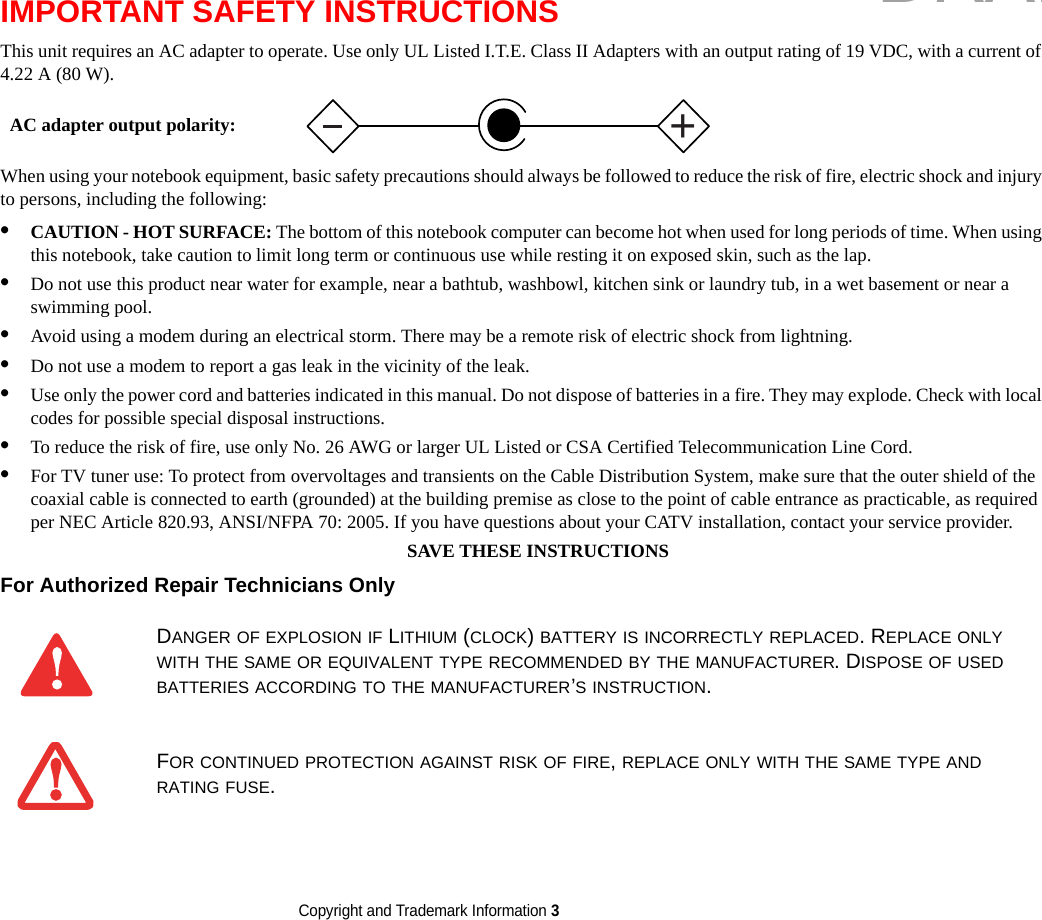

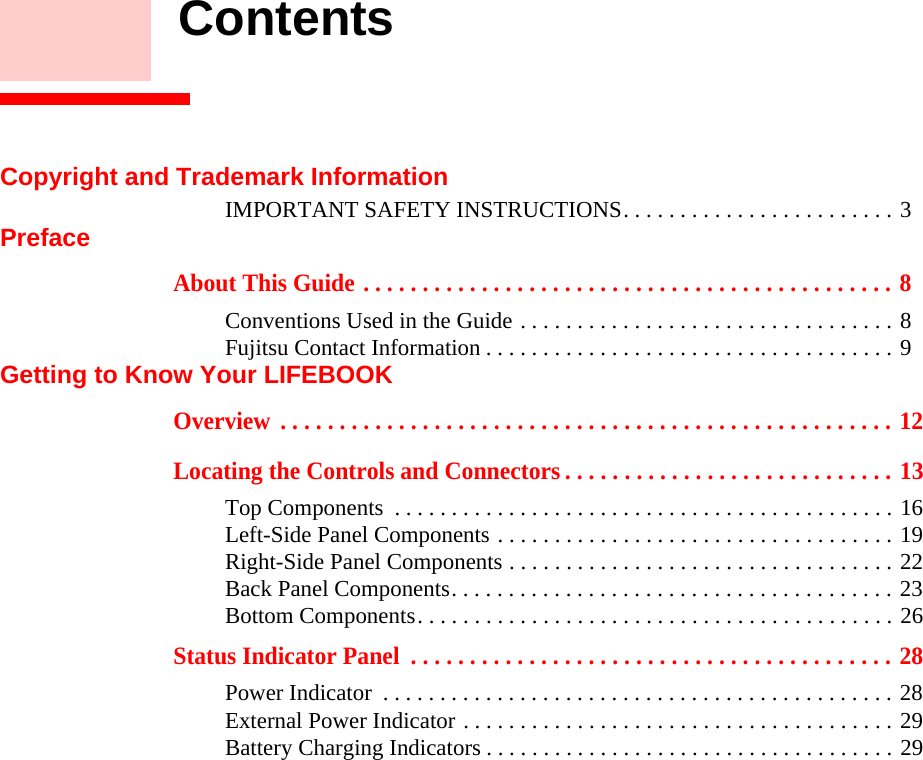
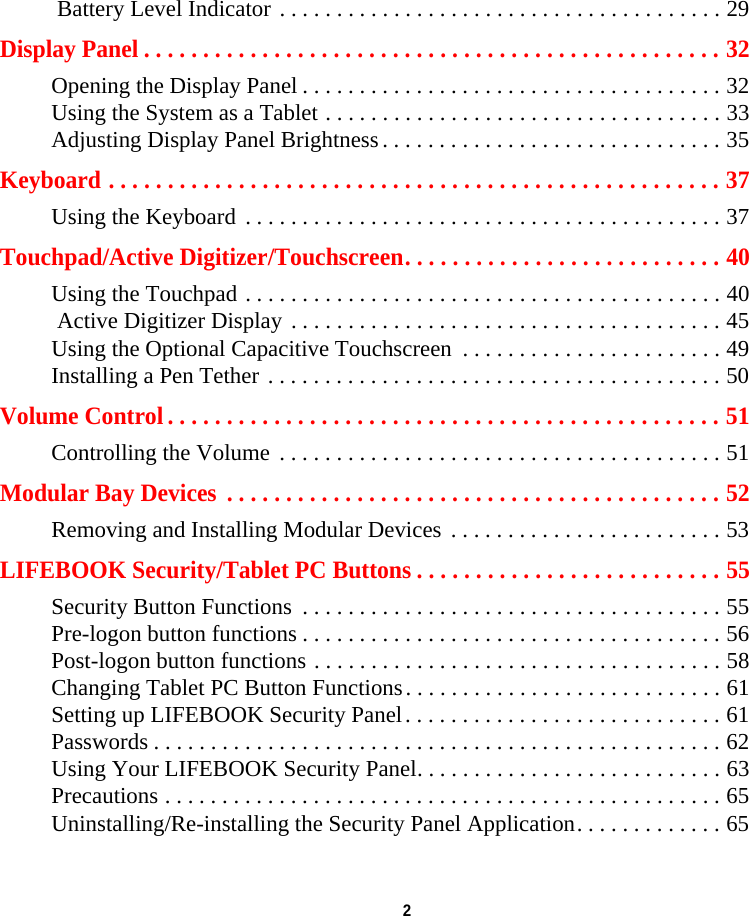
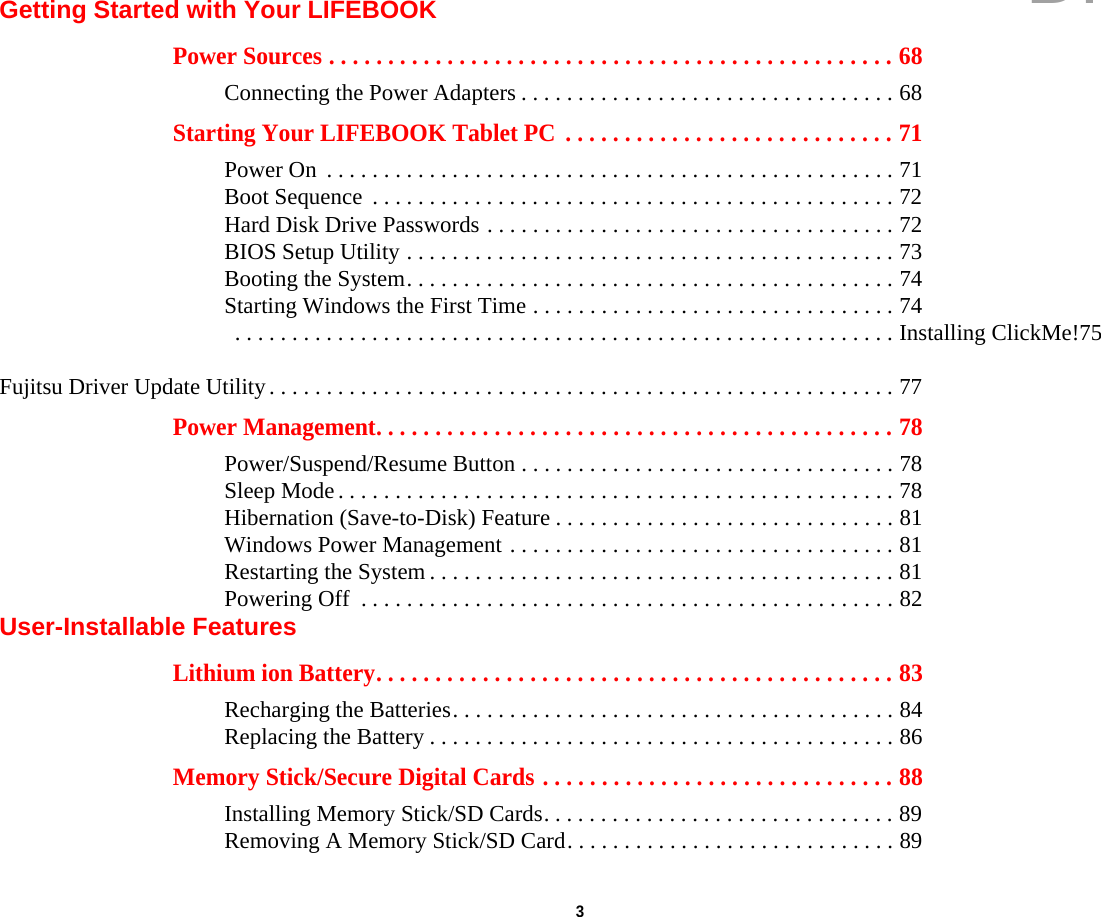
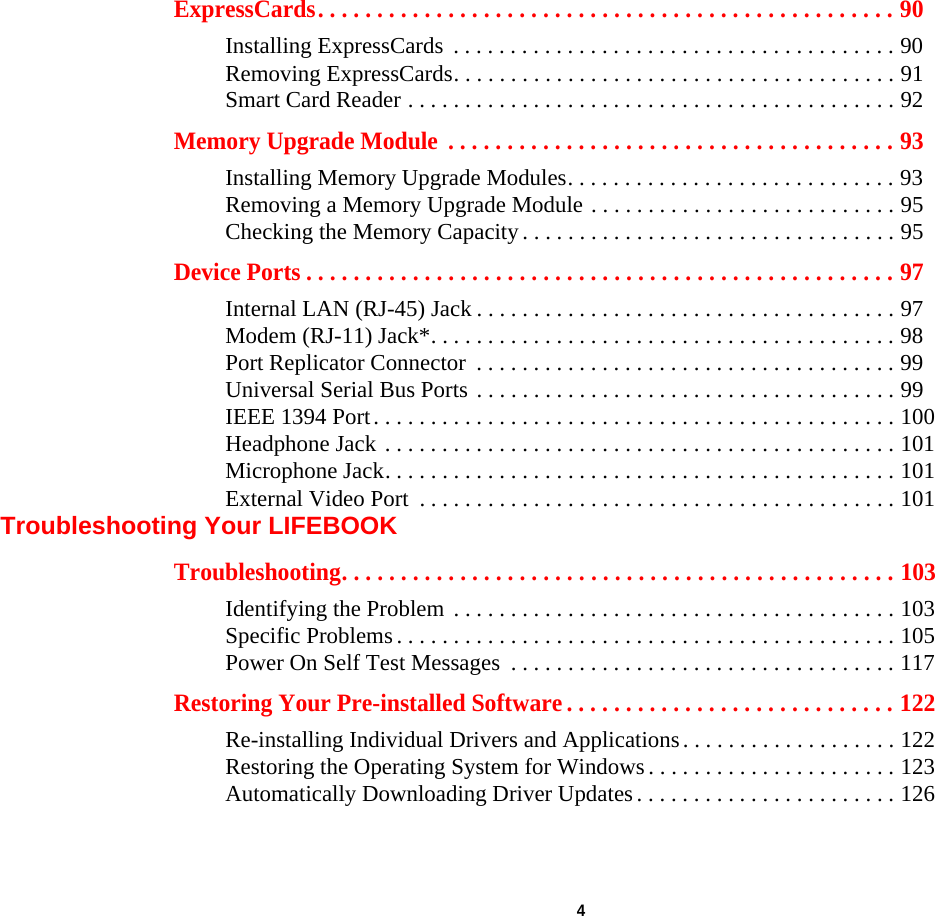
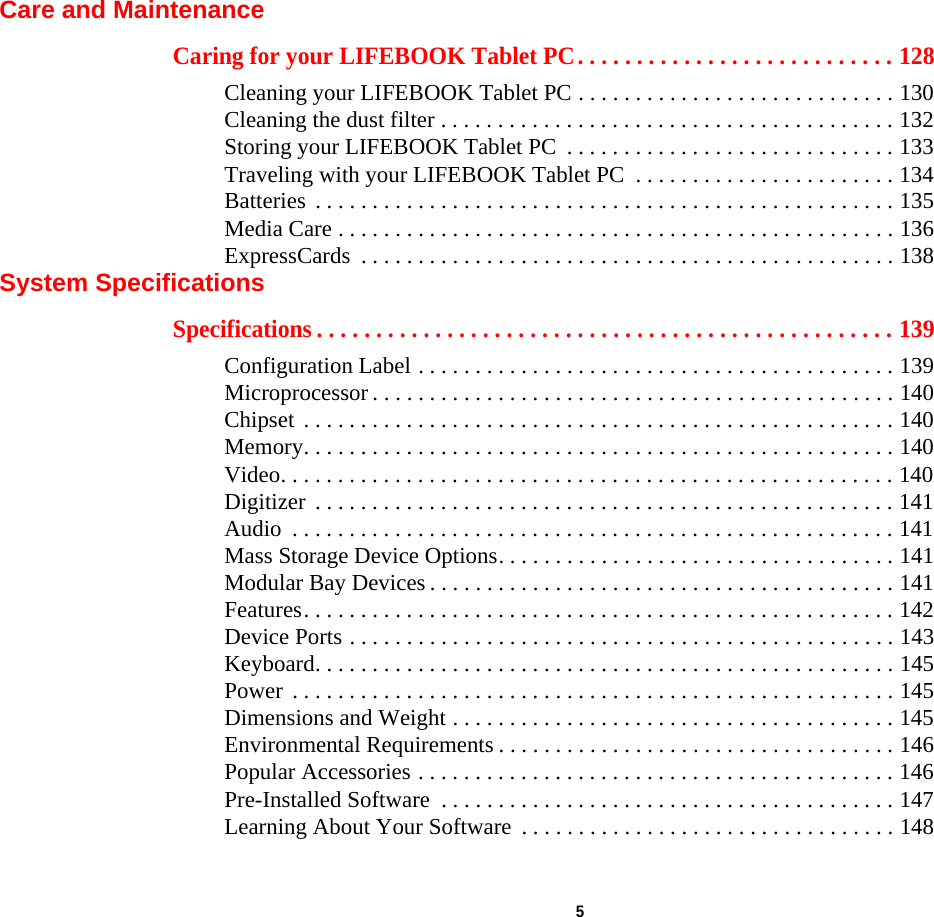
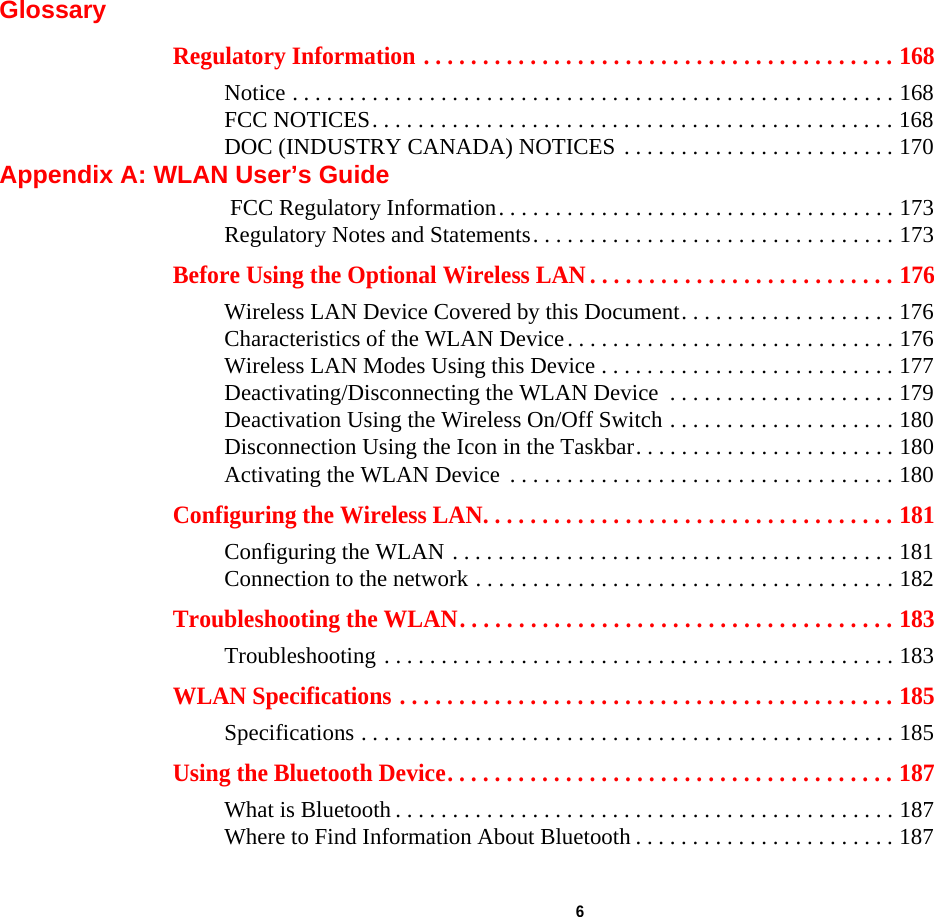
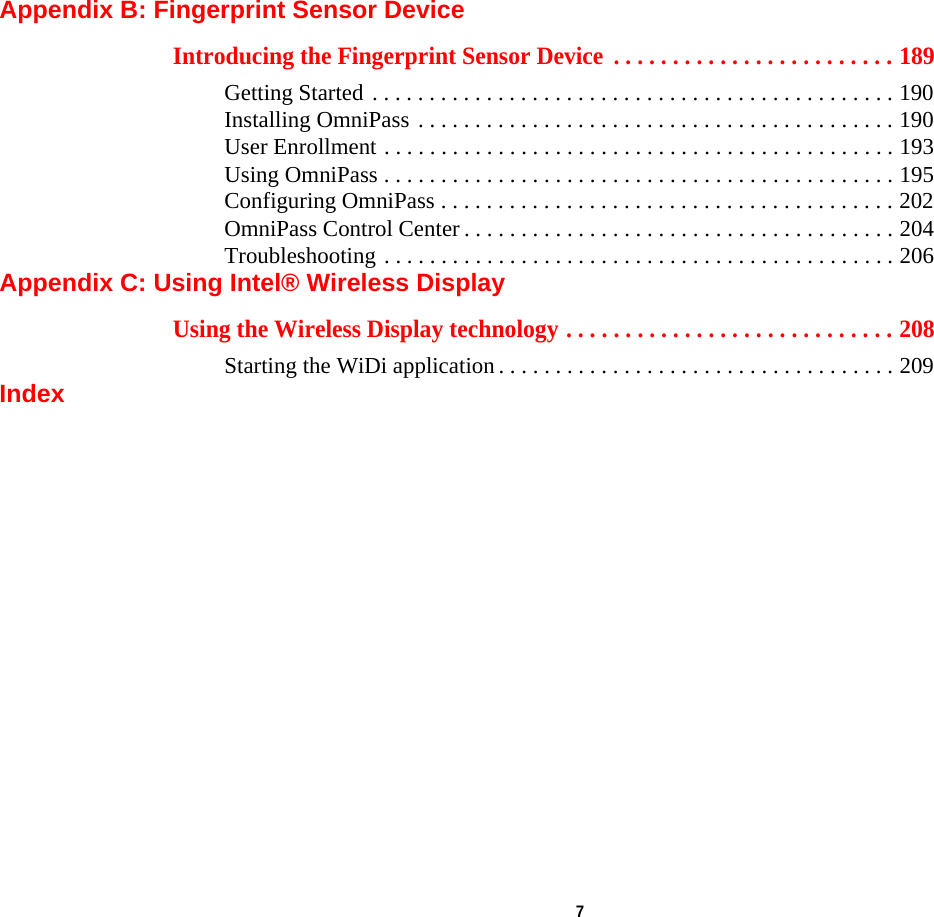
![8 PrefaceAbout This GuideThe LIFEBOOK T901 Tablet PC from Fujitsu America is a powerful convertible computer. It can be used either as a standard notebook using keyboard input, or in tablet configuration using pen input. It is powered by the new 2nd Generation Intel® Core™ Processor, has a built-in color display with either an active digitizer or optional dual digitizer, and brings the computing power of desktop personal computers (PCs) to a portable and versatile environment.This manual explains how to operate your LIFEBOOK T901 Tablet PC’s hardware and pre-installed system software. Conventions Used in the GuideKeyboard and on-screen keys appear in brackets. Example: [Fn], [F1], [ESC], [ENTER] and [CTRL].Pages with additional information about a specific topic are cross-referenced within the text.For example: (“See Installation Procedure on page 43”.) Note that all cross-references are linked to the referenced items, so by clicking the link, you will automatically go to the referenced item or page.On-screen menu items appear in bold. Example: “Click Fujitsu Menu, and select your choice”.DRAFT](https://usermanual.wiki/Fujitsu-Client-Computing/WL0024.Updated-manual/User-Guide-1450965-Page-13.png)
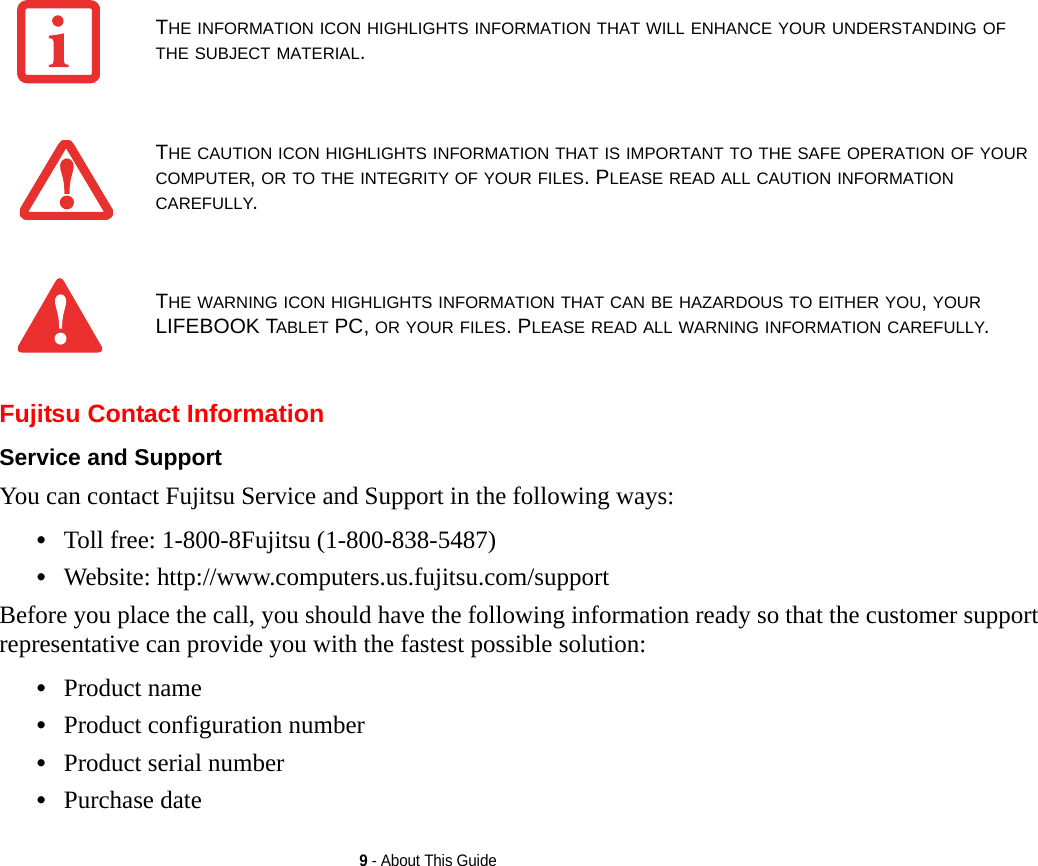
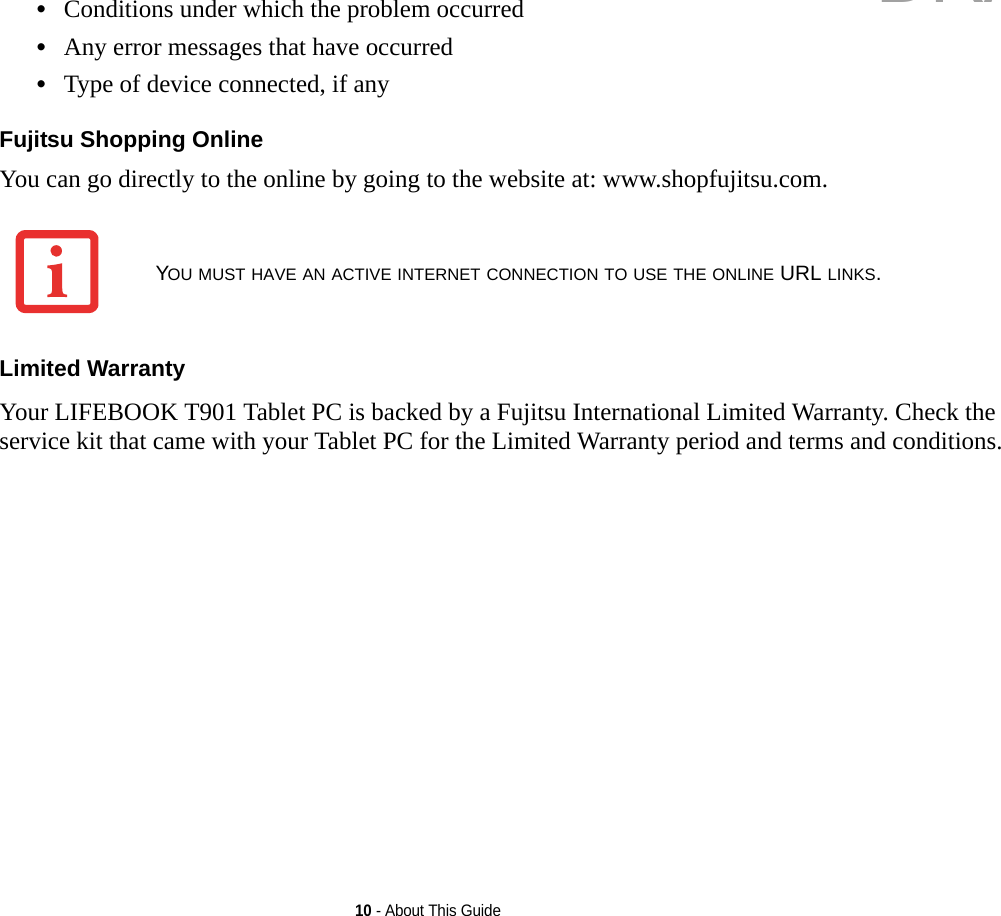
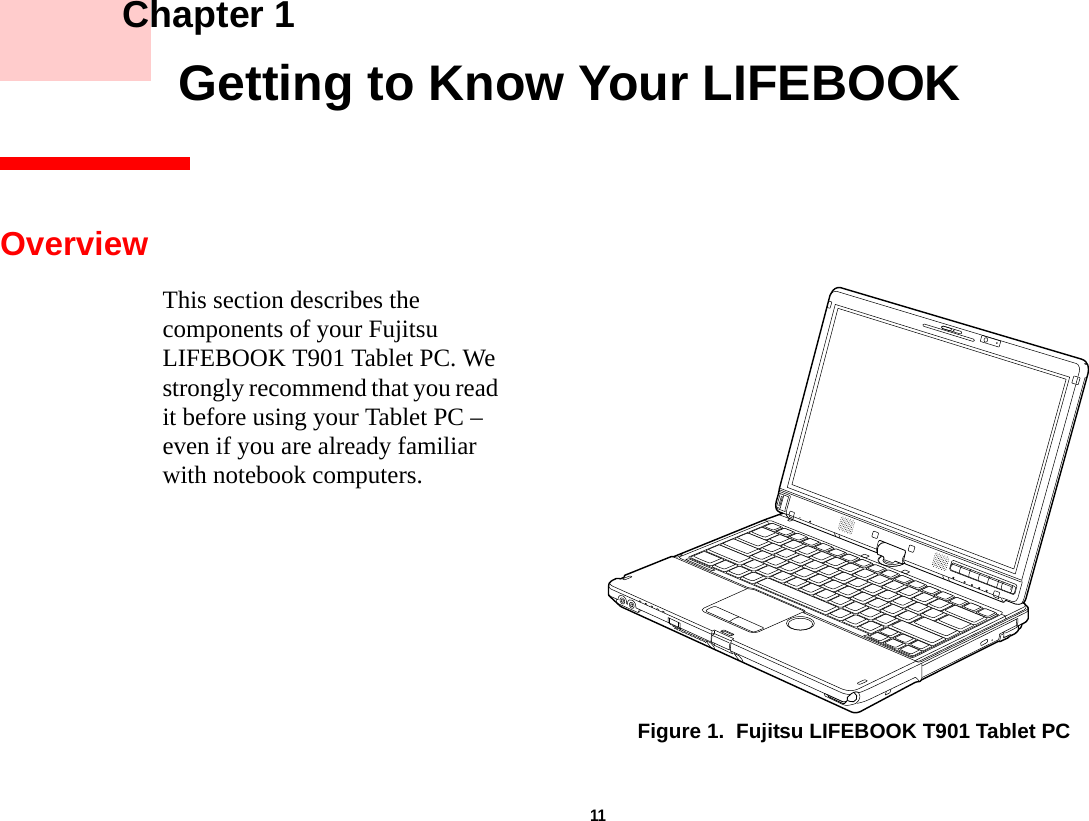
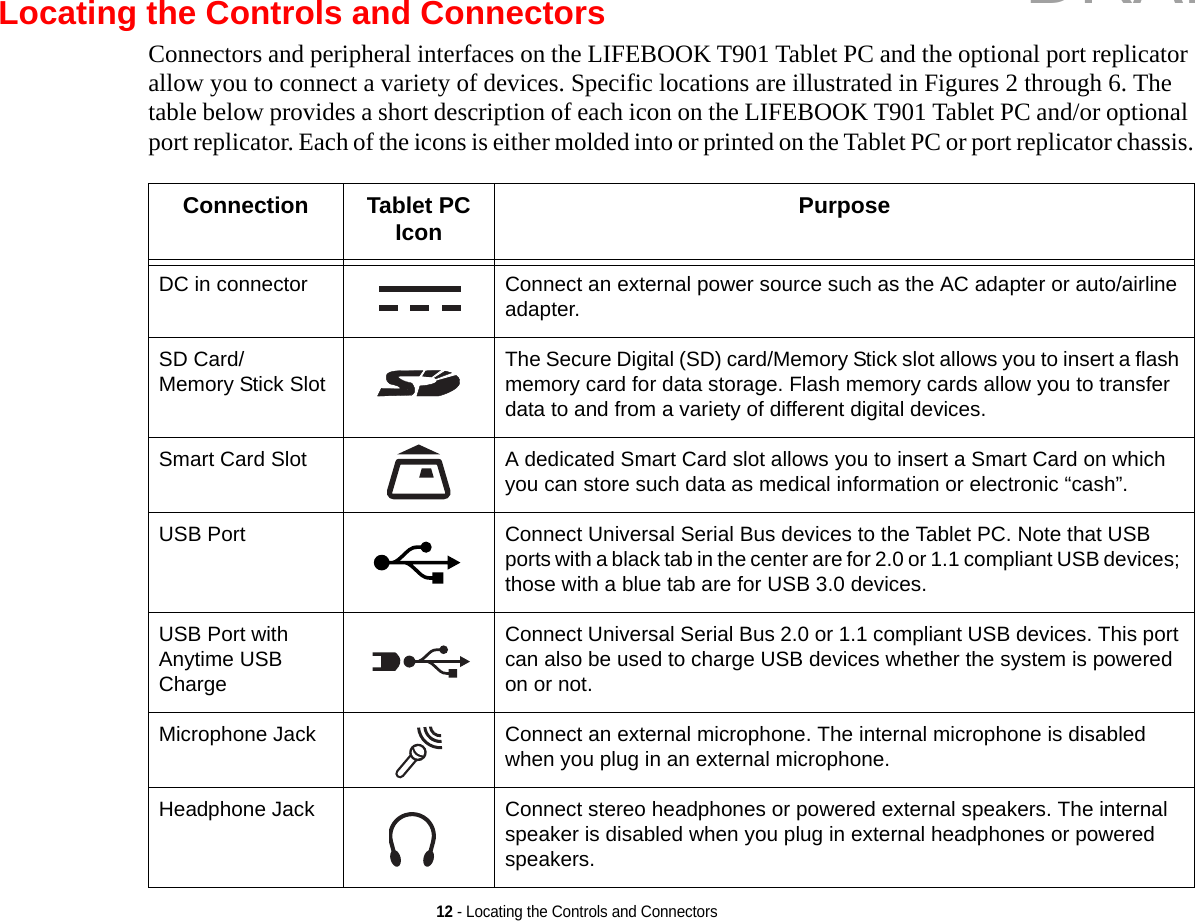
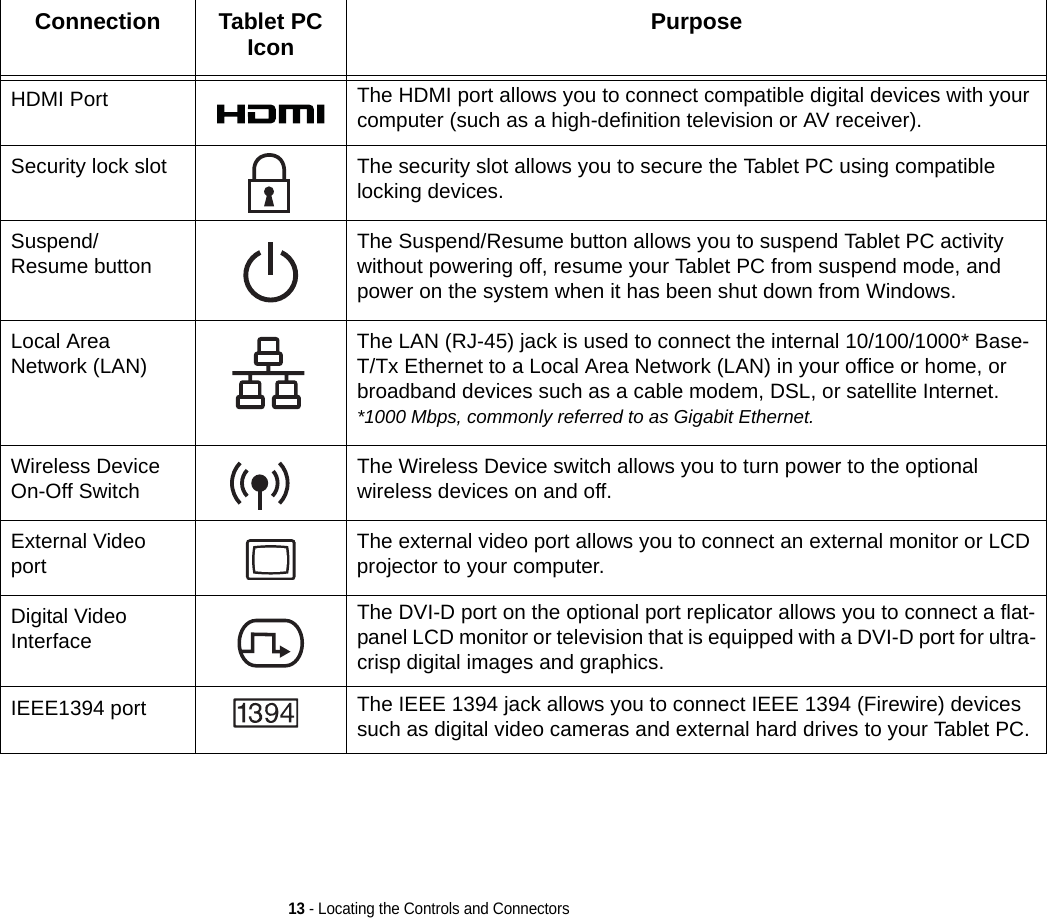
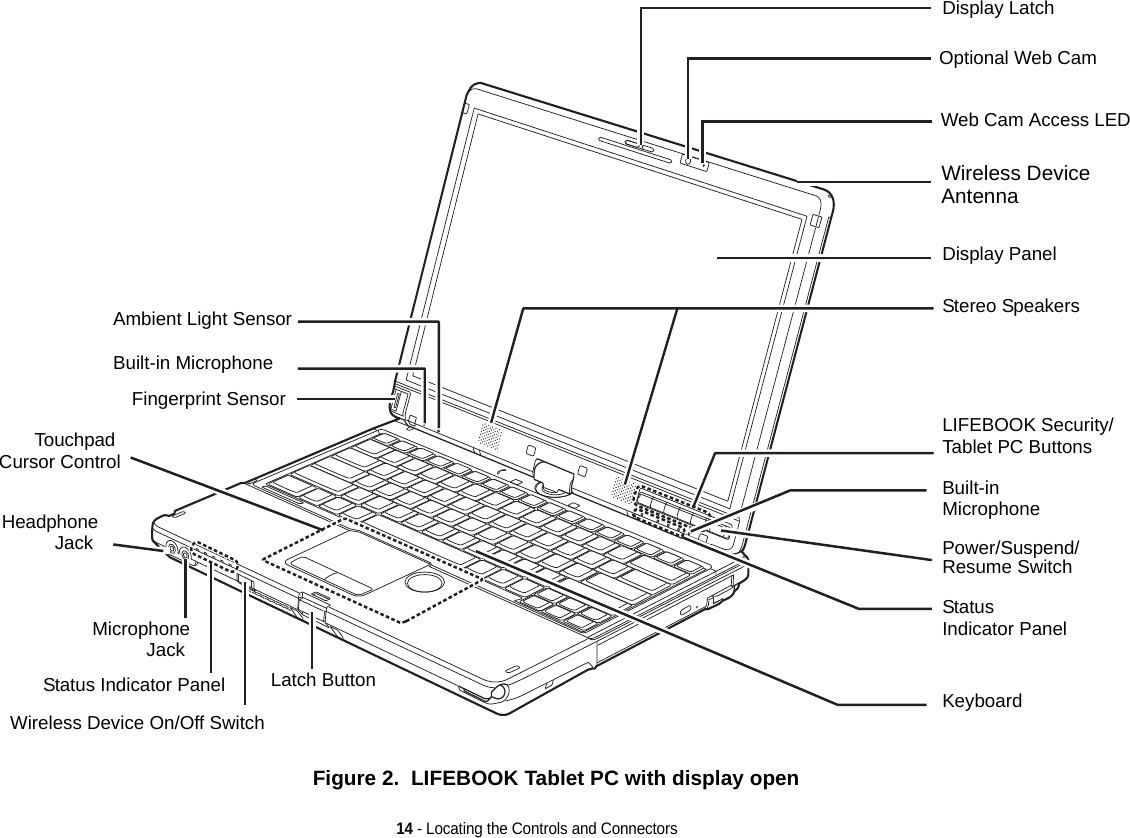
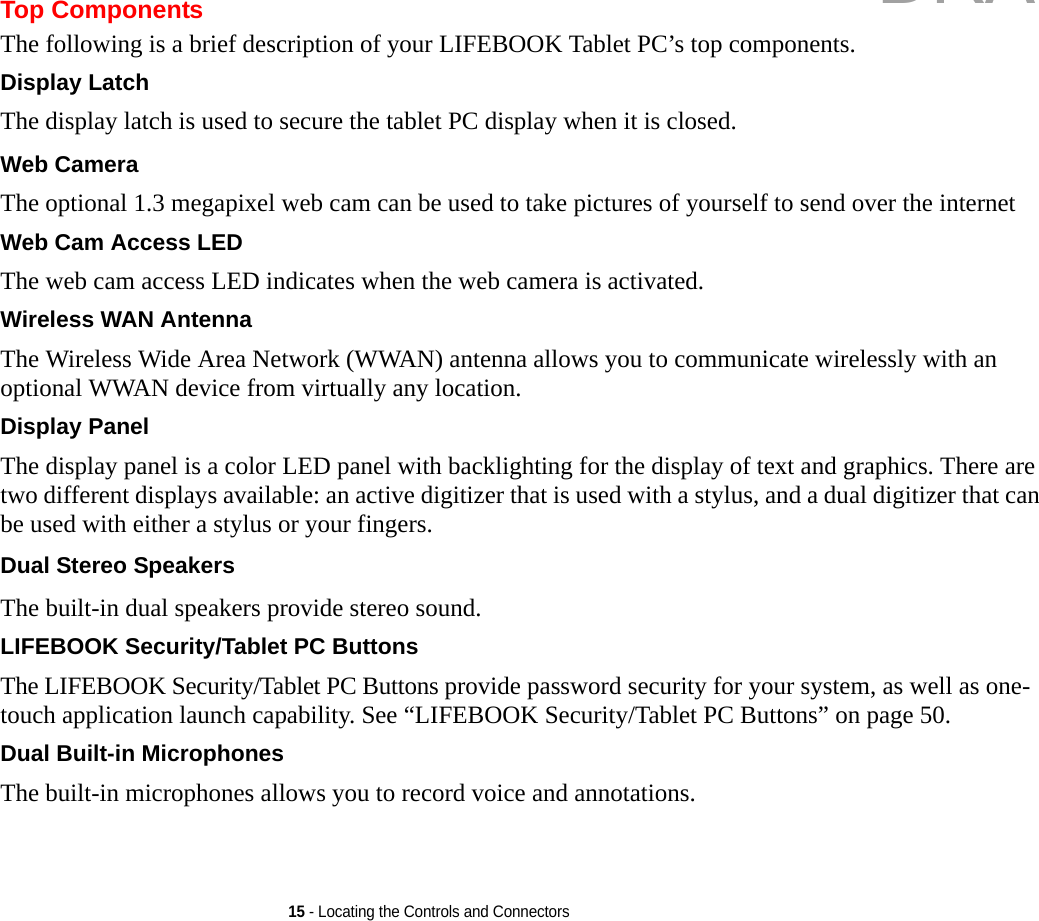
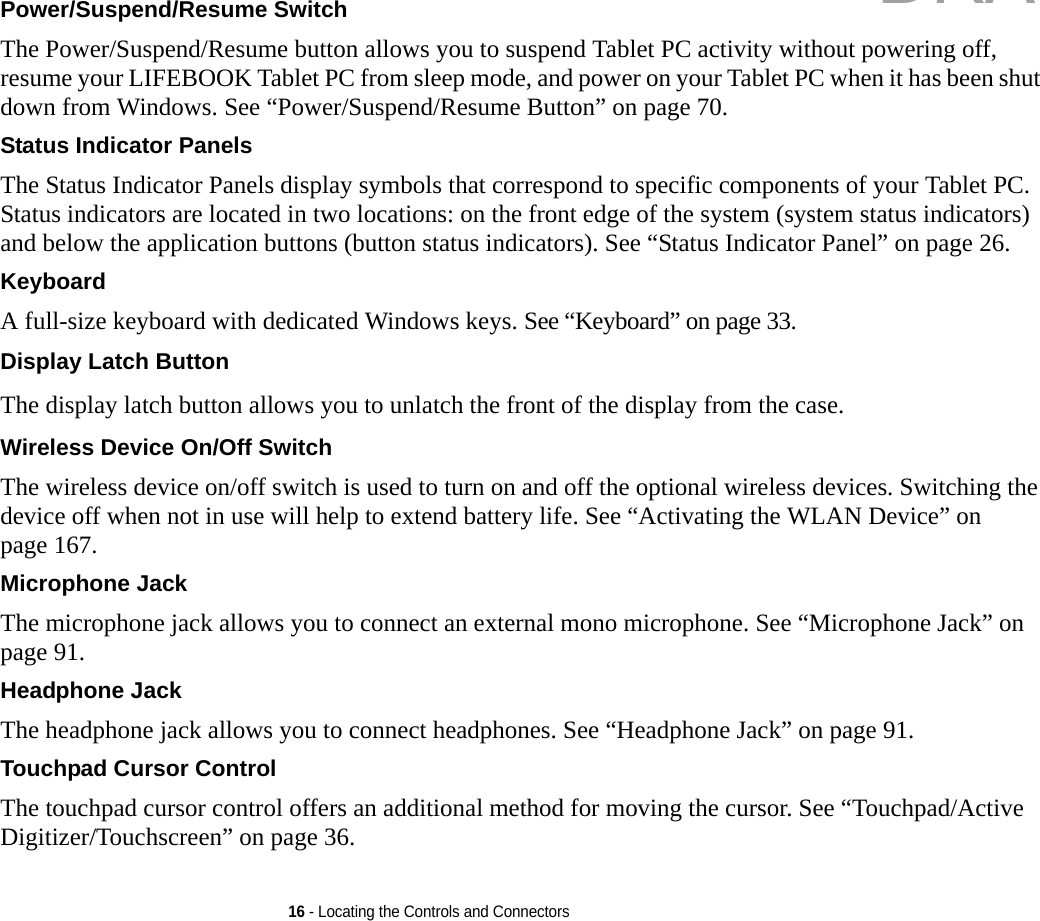
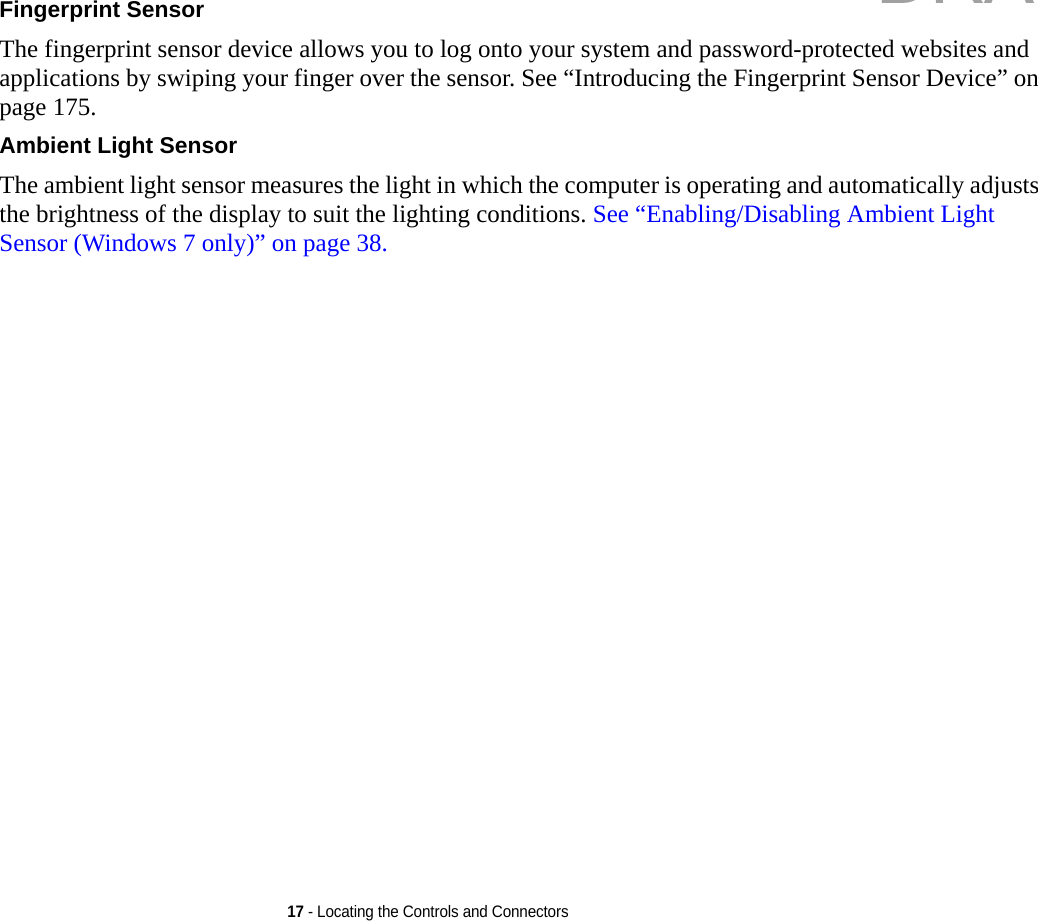
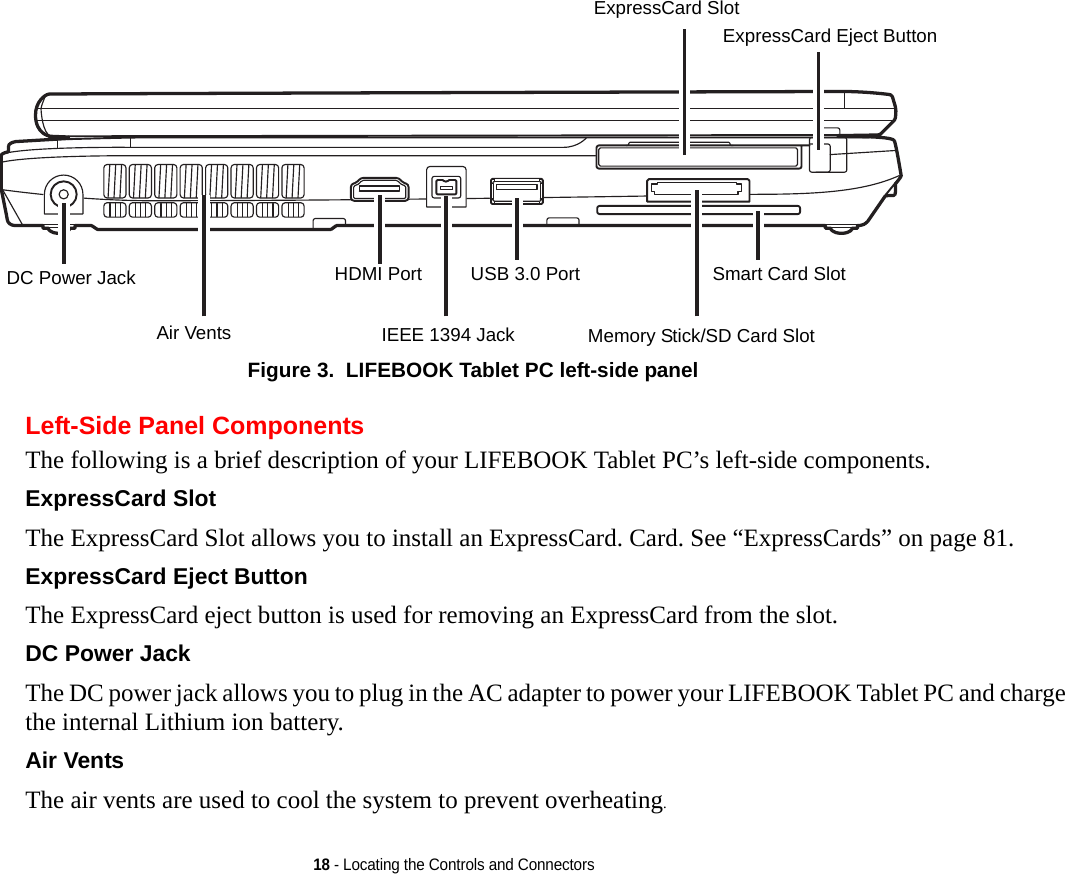
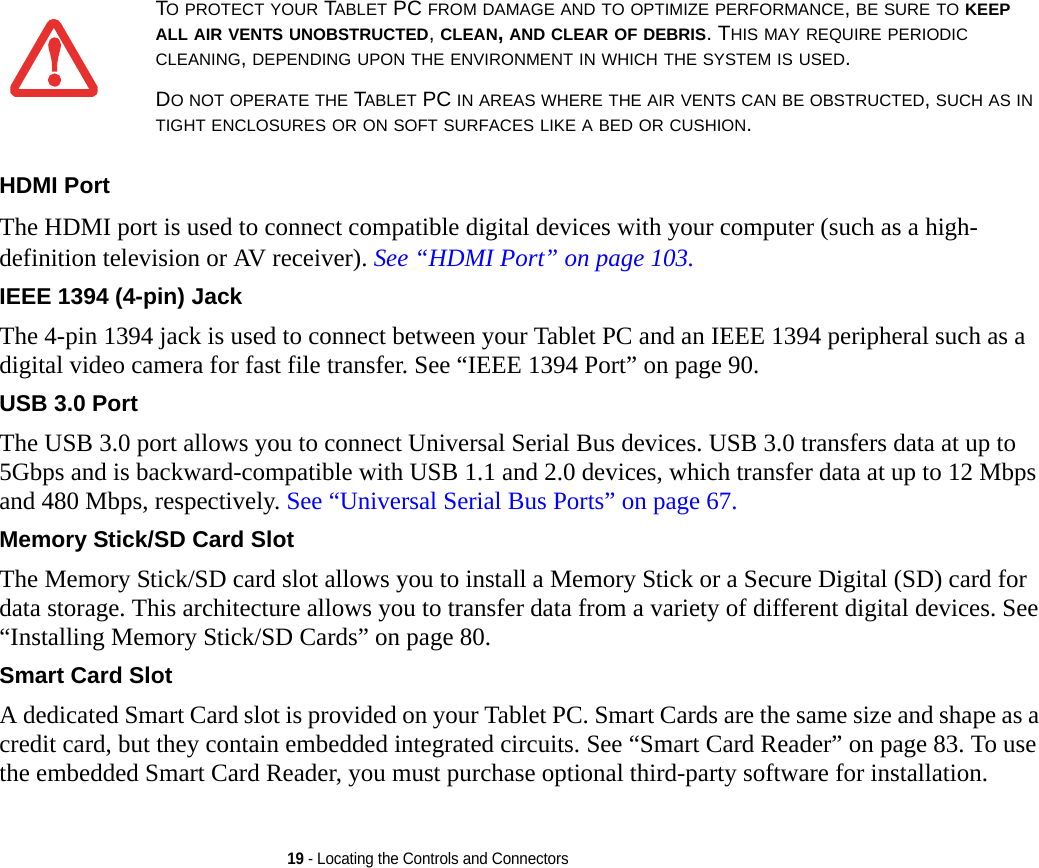
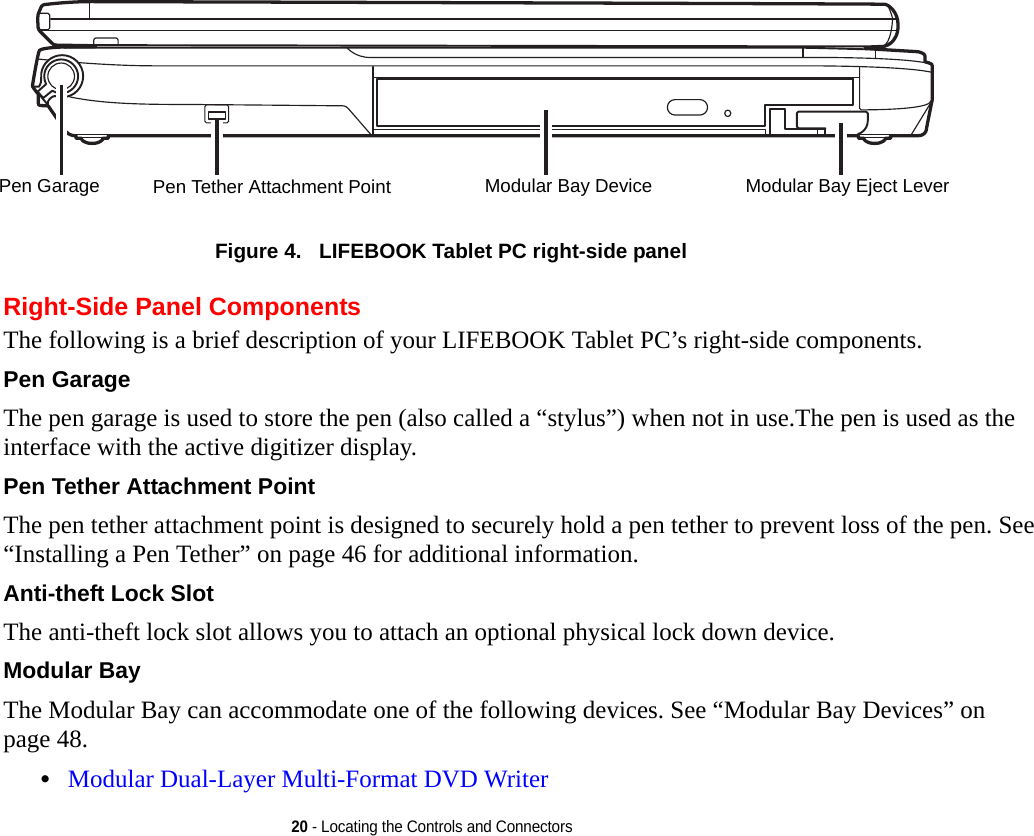
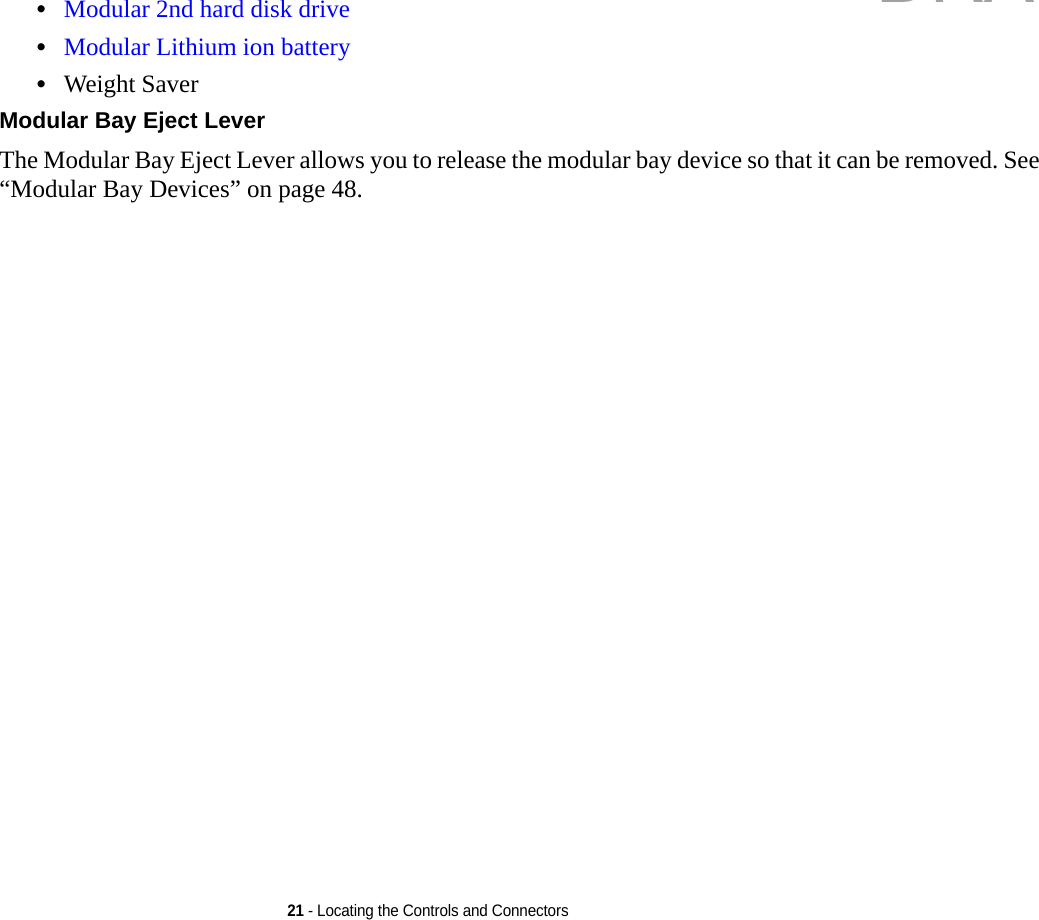
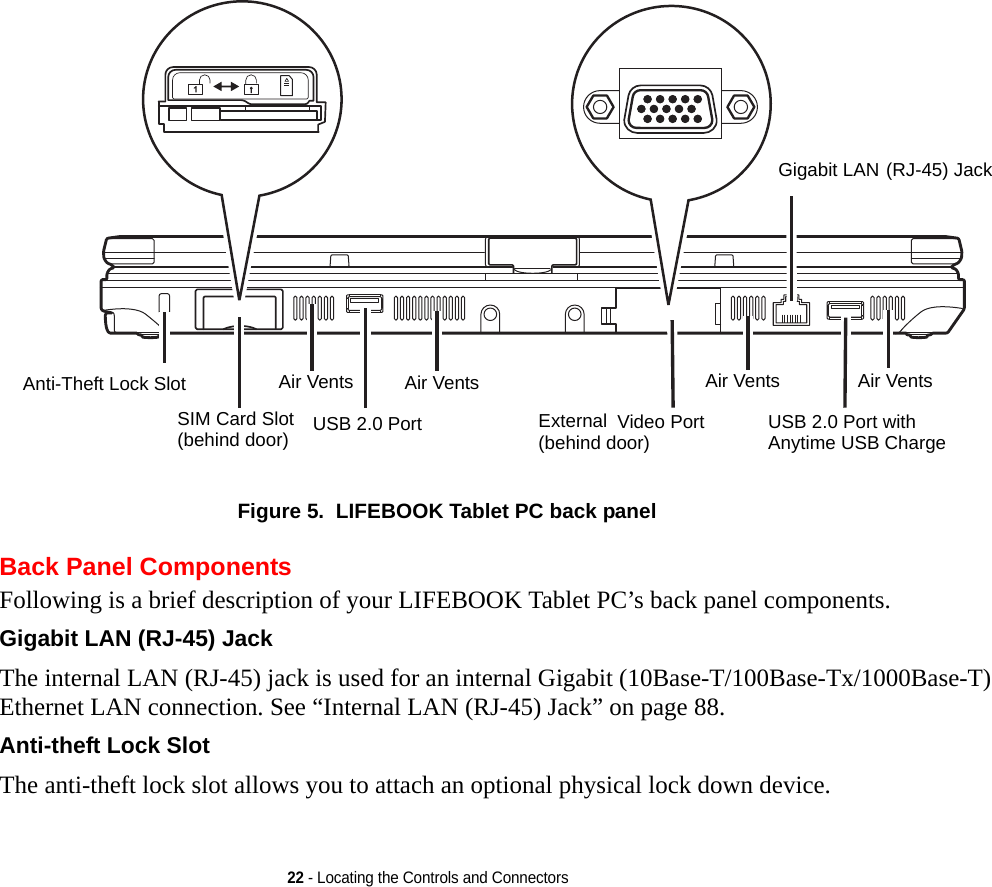
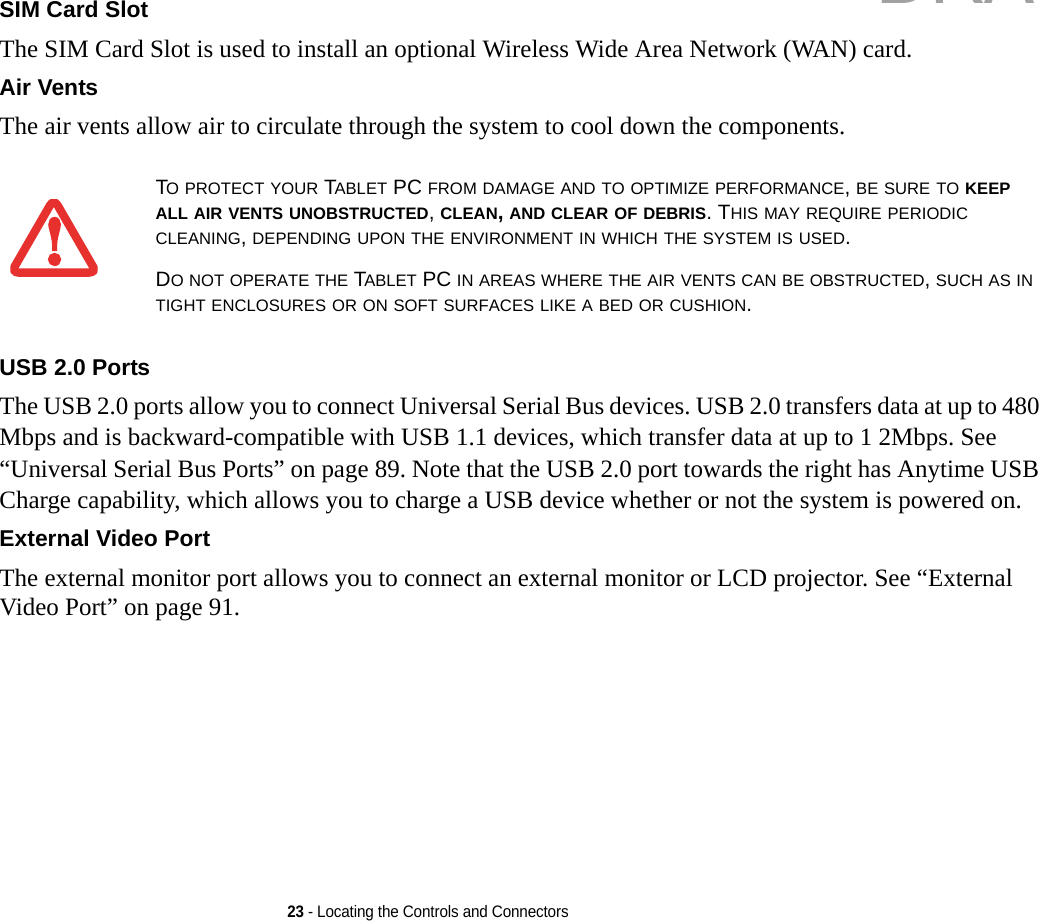
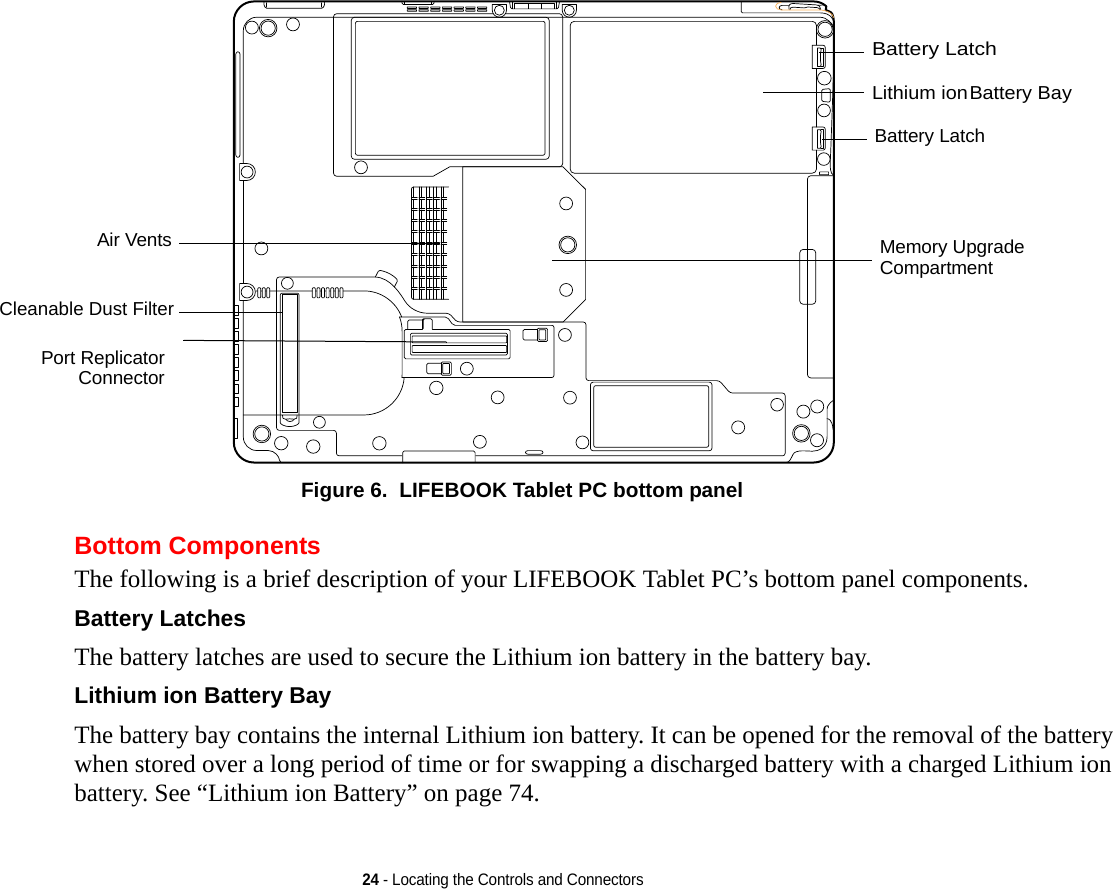
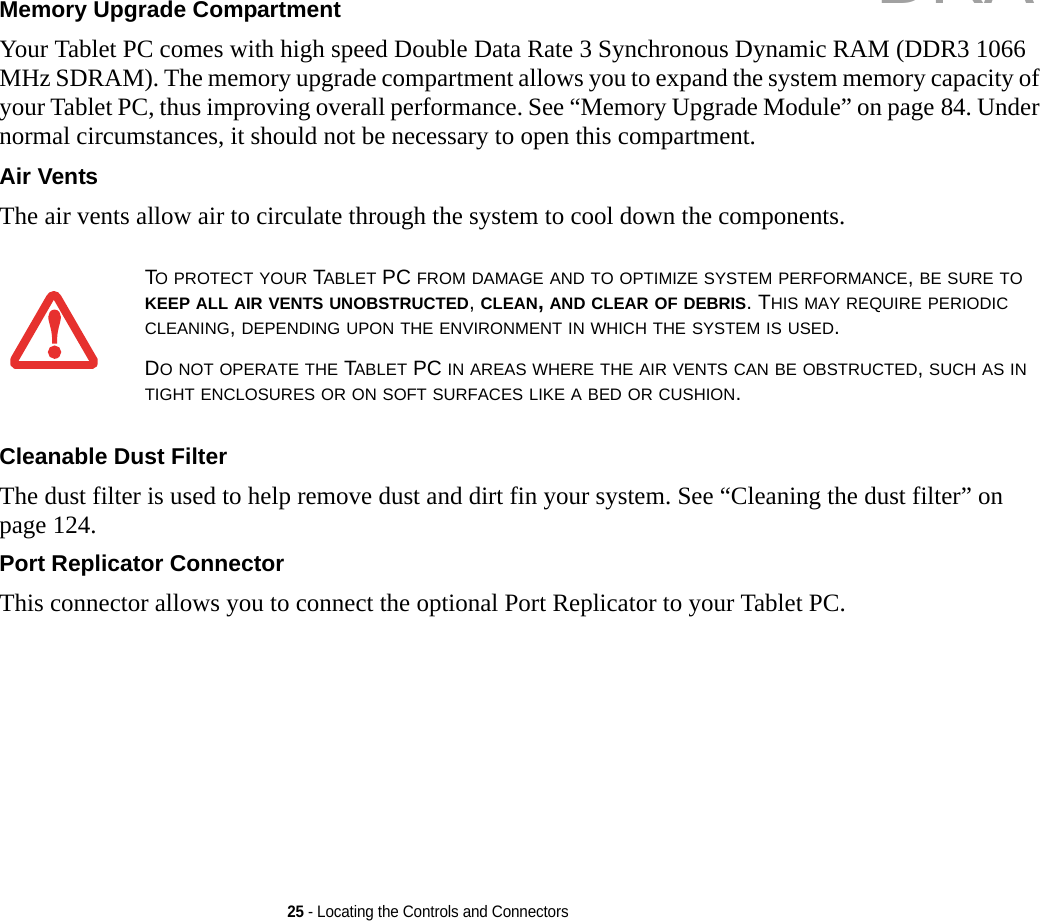
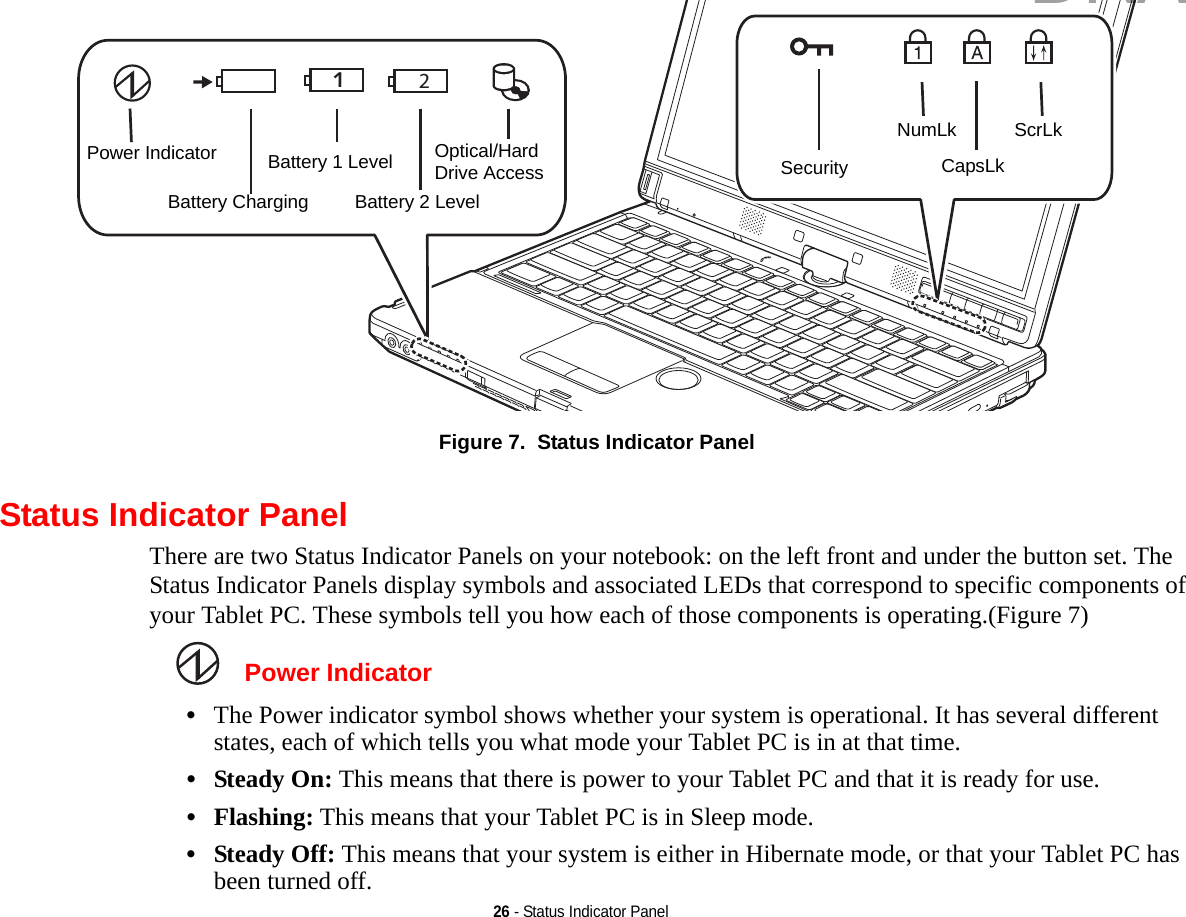
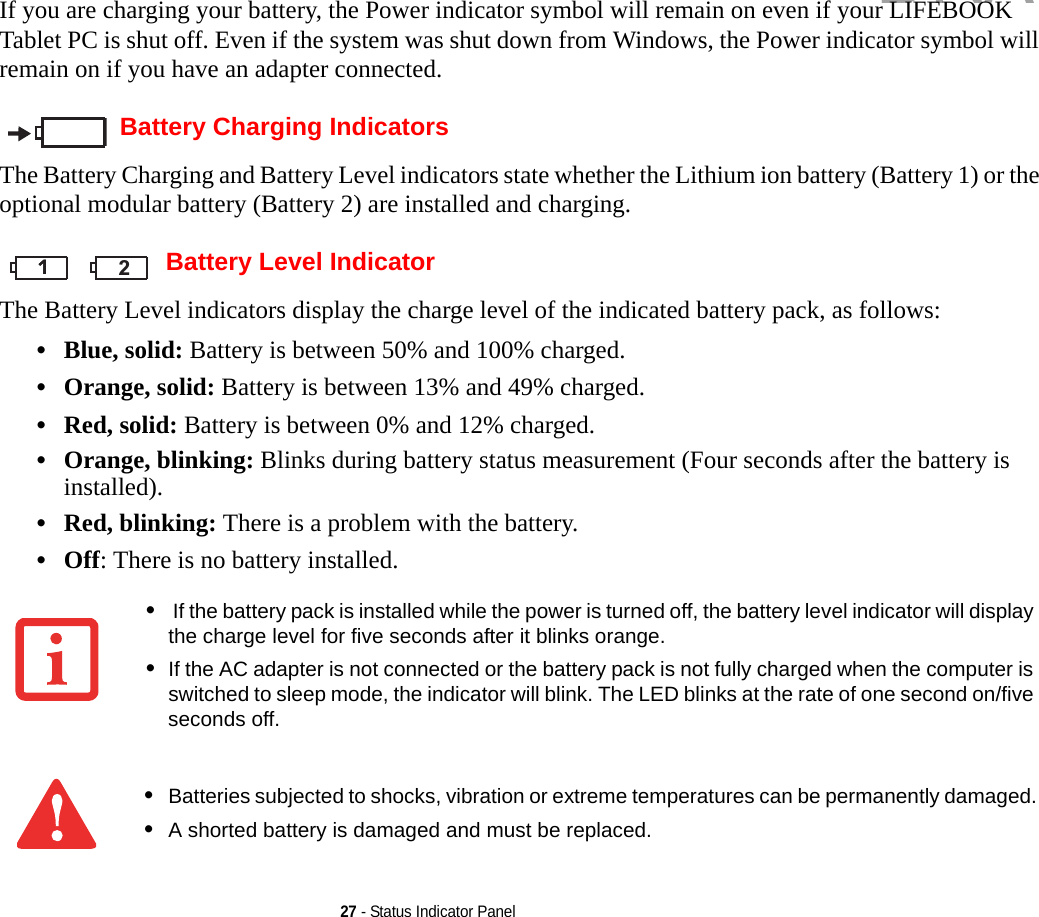
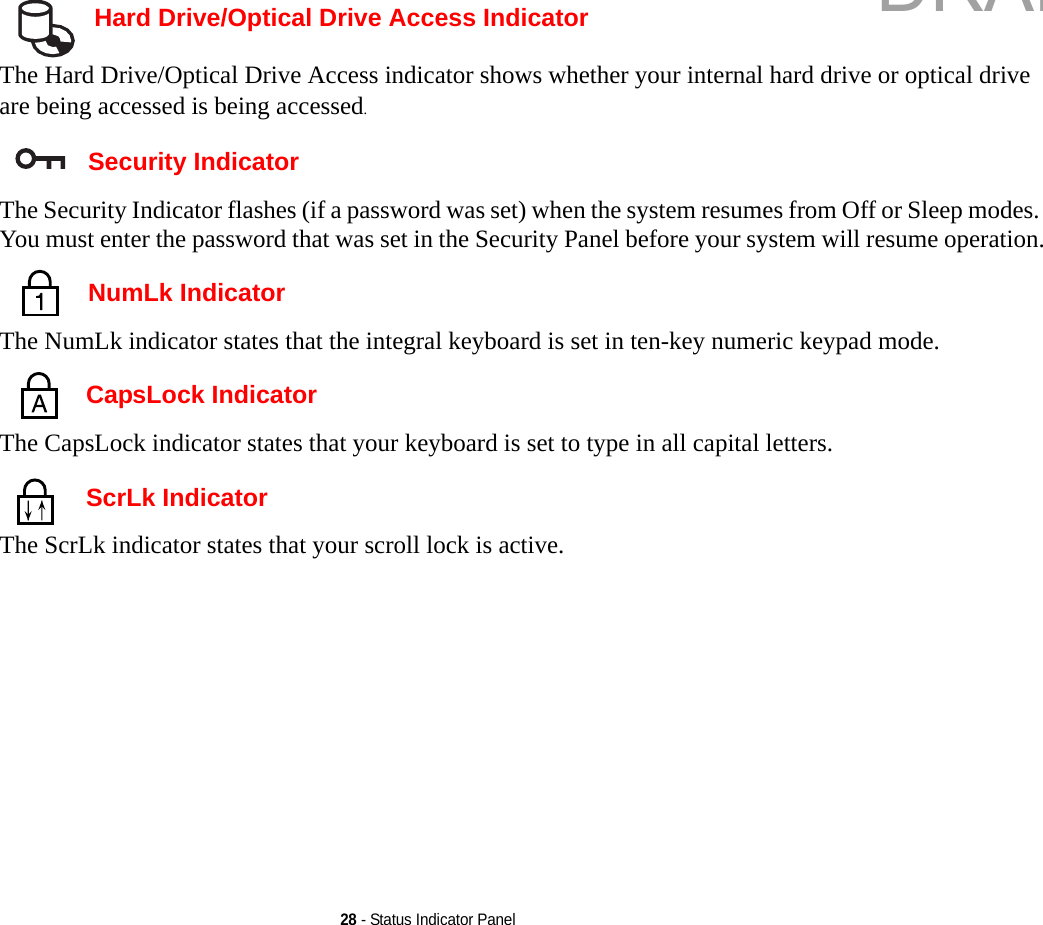
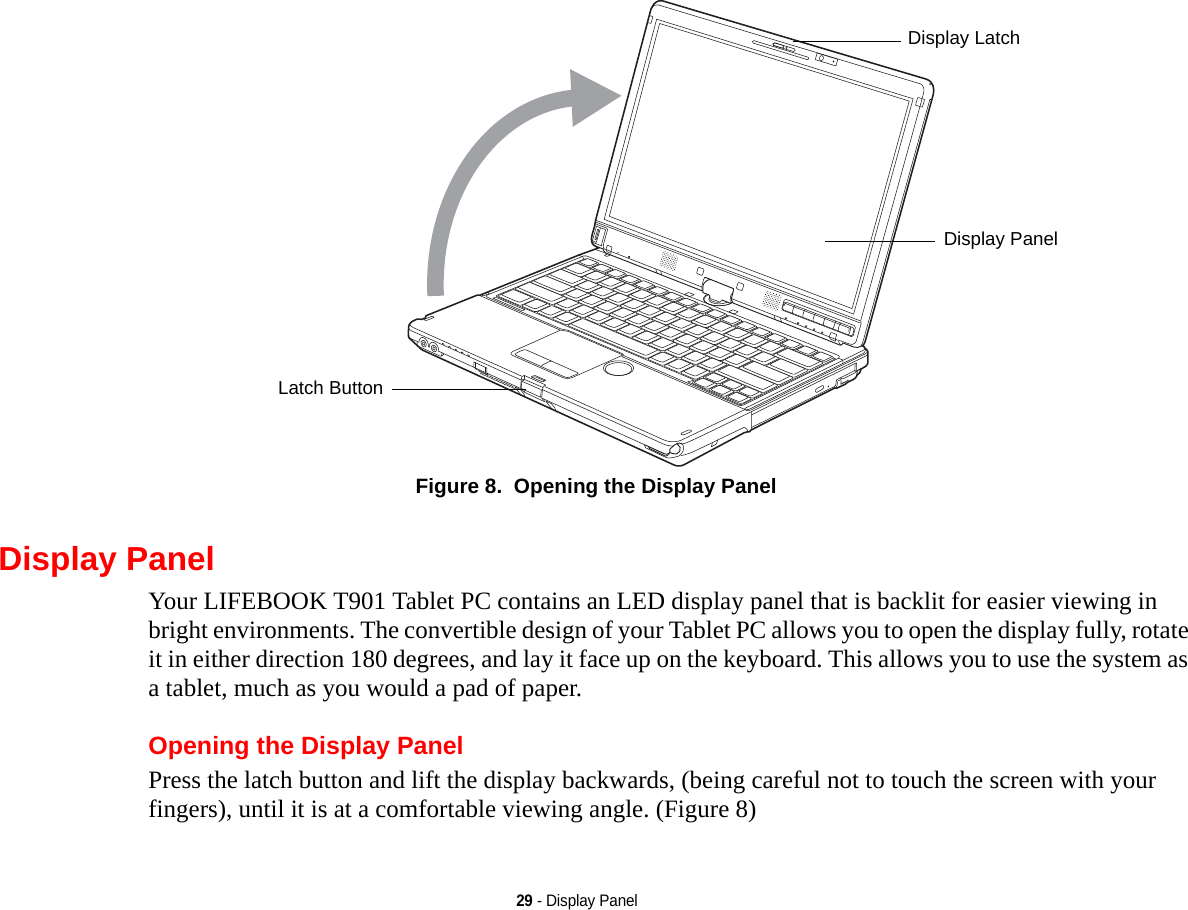
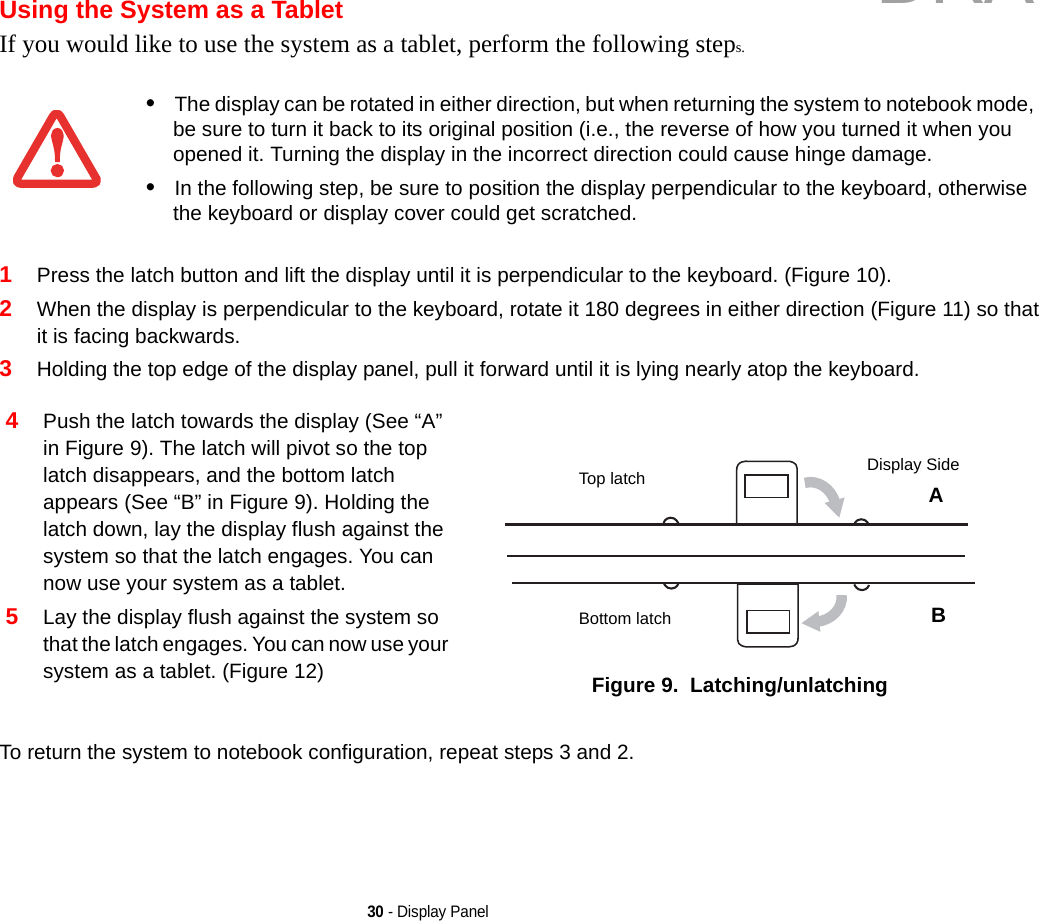
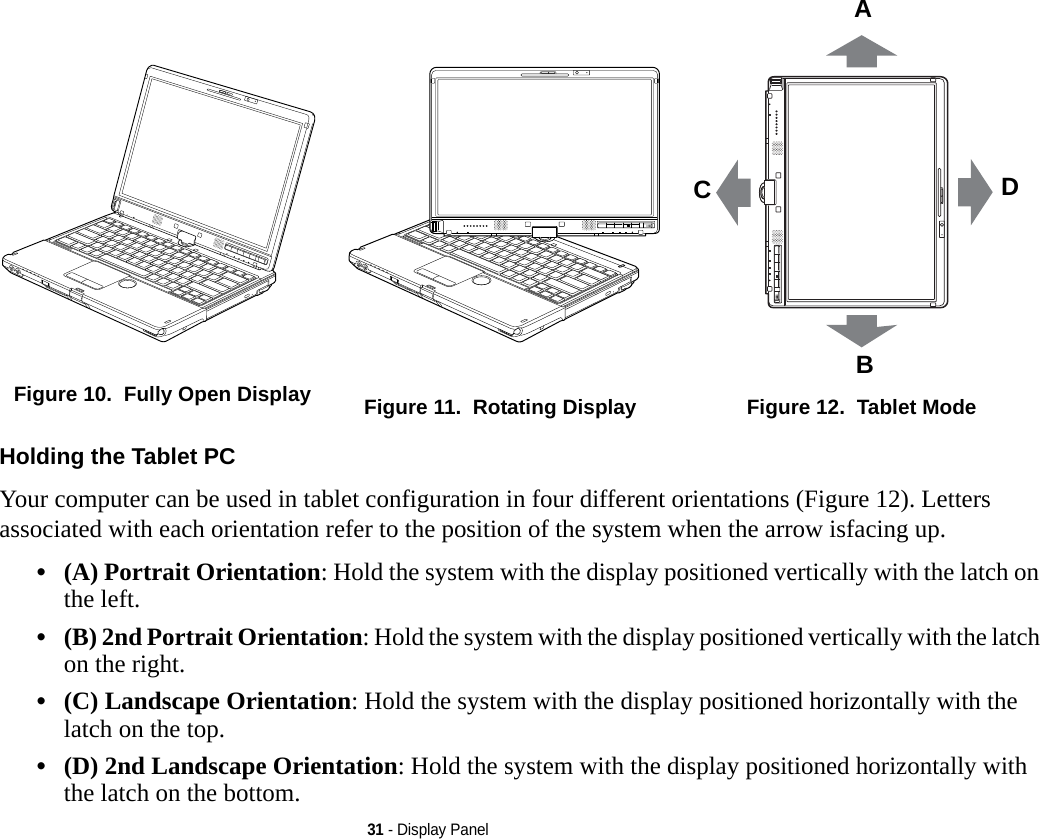
![32 - Display PanelAdjusting Display Panel BrightnessOnce you have turned on your Tablet PC, you may want to adjust the brightness level of the screen to a more comfortable viewing level. There are three ways to adjust the brightness: keyboard, power management utility, and Fujitsu Menu. Using Keyboard to Adjust Brightness Adjusting the brightness using the keyboard changes the system setting (i.e., the settings you make via the function keys automatically changes the brightness settings in the system’s Pen and Tablet Settings). •[Fn+F6]: Pressing repeatedly will lower the brightness of your display.•[Fn+F7]: Pressing repeatedly will increase the brightness of the display.Using Power Management to Adjust Brightness To adjust brightness with the power management utility:Click Start -> Control Panel. In View by:, select one of the icon views. Select Display, then click Adjust brightness in the left pane. Drag the Screen brightness: slider to the left or right, depending upon your preference.Using the Fujitsu Menu to Adjust Brightness To adjust brightness using the Fujitsu menu, click on the Fujitsu Menu icon in the system tray in the lower right corner of the screen. (You can also open the Fujitsu menu by clicking the [Fn] button twice in succession.) Scroll down to the Mobility Center and double-click it, then double-click the icon adjacent to Display brightness. Set the screen brightness sliders for On battery and Plugged in scenarios.IF USING AC POWER, YOUR BRIGHTNESS SETTING IS SET TO ITS HIGHEST LEVEL BY DEFAULT. IF USING BATTERY POWER, YOUR BRIGHTNESS SETTINGS IS SET TO APPROXIMATELY MID-LEVEL BY DEFAULT.THE HIGHER THE BRIGHTNESS LEVEL, THE MORE POWER THE TABLET PC WILL CONSUME AND THE FASTER YOUR BATTERIES WILL DISCHARGE. FOR MAXIMUM BATTERY LIFE, MAKE SURE THAT THE BRIGHTNESS IS SET AS LOW AS POSSIBLE.DRAFT](https://usermanual.wiki/Fujitsu-Client-Computing/WL0024.Updated-manual/User-Guide-1450965-Page-37.png)
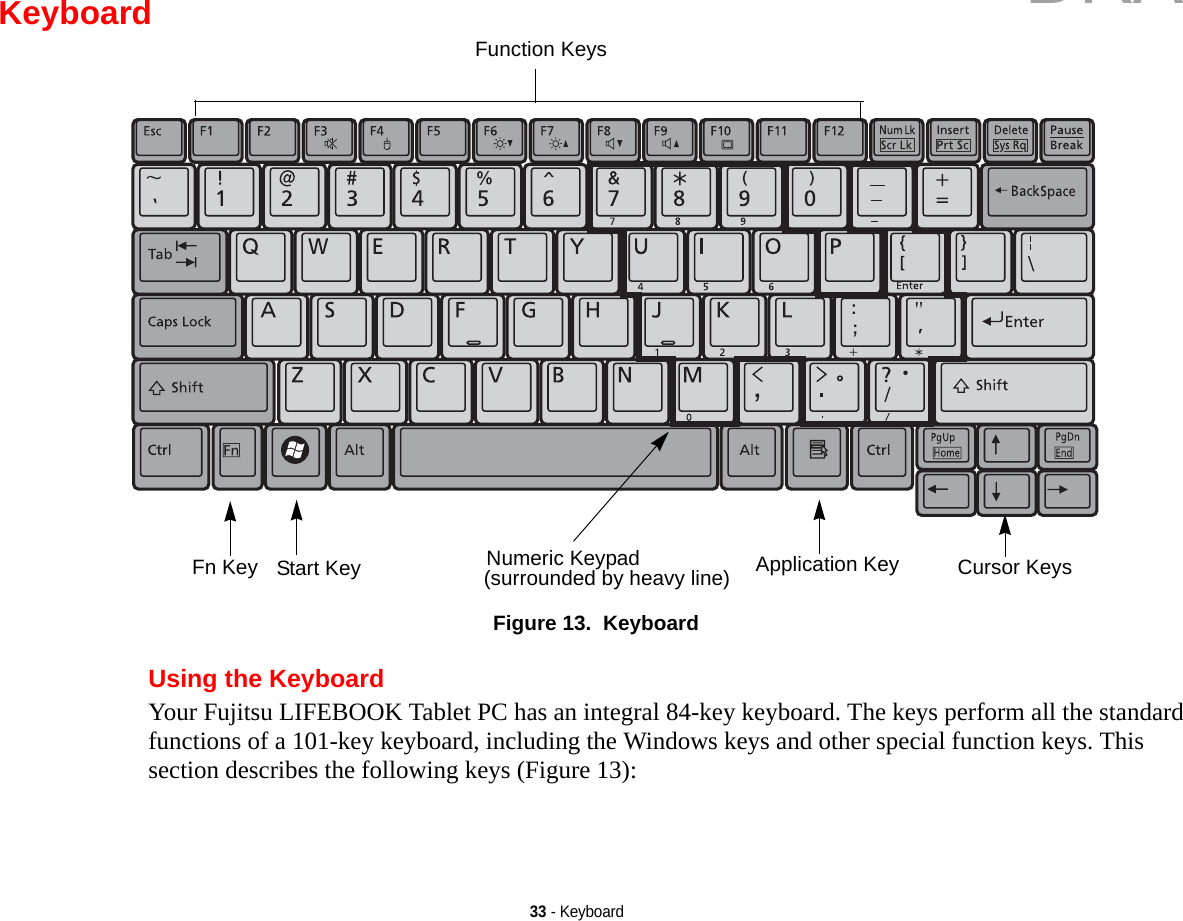
![34 - Keyboard•Numeric keypad: Your Tablet PC allows certain keys to serve dual purposes, both as standard characters and as numeric and mathematical keys. The ability to toggle between the standard character and numeric keys is controlled through the [NumLk] key.•Cursor keys: Your keyboard contains four arrow keys for moving the cursor or insertion point to the right, left, up, or down within windows, applications and documents. •Function keys: The keys labeled [F1] through [F12], are used in conjunction with the [Fn] key to produce special actions that vary depending on what program is running. •Windows keys: These keys work with your Windows operating system and function the same as the onscreen Start menu button, or the right button on your pointing device.Numeric Keypad Certain keys on the keyboard perform dual functions as both standard character keys and numeric keypad keys. NumLk can be activated by pressing the [NumLk] keys. Turning off the NumLk feature is done the same way. Once this feature is activated you can enter numerals 0 through 9, perform addition ( + ), subtraction ( - ), multiplication ( * ), or division ( / ), and enter decimal points ( . ) using the keys designated as ten-key function keys. The keys in the numeric keypad are marked on the front edge of the key to indicate their secondary functions. Windows Keys Your LIFEBOOK Tablet PC has two Windows keys, consisting of a Start key and an Application key. The Start key displays the Start menu. This button functions the same as your onscreen Start menu button. The Application key functions the same as your right mouse button and displays shortcut menus for the selected item. (Please refer to your Windows Help and Support documentation in the Start menu for additional information regarding the Windows keys.) Cursor Keys The cursor keys are the four arrow keys on the keyboard which allow you to move the cursor up, down, left and right in applications. In programs such as Windows Explorer, it moves the “focus” (selects the next item up, down, left, or right). DRAFT](https://usermanual.wiki/Fujitsu-Client-Computing/WL0024.Updated-manual/User-Guide-1450965-Page-39.png)
![35 - KeyboardFunction Keys Your LIFEBOOK Tablet PC has 12 function keys, F1 through F12. Functions assigned to these keys differ for each application. You should refer to your software documentation to find out how these keys are used. •The [Fn] key provides extended functions for the Tablet PC and is always used in conjunction with another key. •[Fn+F3]: Pressing [F3] while holding [Fn] will toggle the Audio Mute on and off.•[Fn+F4]: Pressing [F4] while holding [Fn] will toggle the Quick Point feature on and off. Note that the [Fn+F4] combination only works if Manual Setting is selected in the BIOS. (See “BIOS Setup Utility” on page 66)•[Fn+F6]: Pressing [F6] repeatedly while holding [Fn] will lower the brightness of your display.•[Fn+F7]: Pressing [F7] repeatedly while holding [Fn] will increase the brightness of the display.•[Fn+F8]: Pressing [F8] repeatedly while holding [Fn] will decrease the volume of your LIFEBOOK Tablet PC.•[Fn+F9]: Pressing [F9] repeatedly while holding [Fn] will increase the volume of your LIFEBOOK Tablet PC.•[Fn+F10]: Pressing [F10] while holding [Fn] allows you to change your selection of where to send your display video. Each time you press the combination of keys you will step to the next choice. The choices, in order, are: built-in display panel only, external monitor only, and both built-in display panel and external monitor.DRAFT](https://usermanual.wiki/Fujitsu-Client-Computing/WL0024.Updated-manual/User-Guide-1450965-Page-40.png)
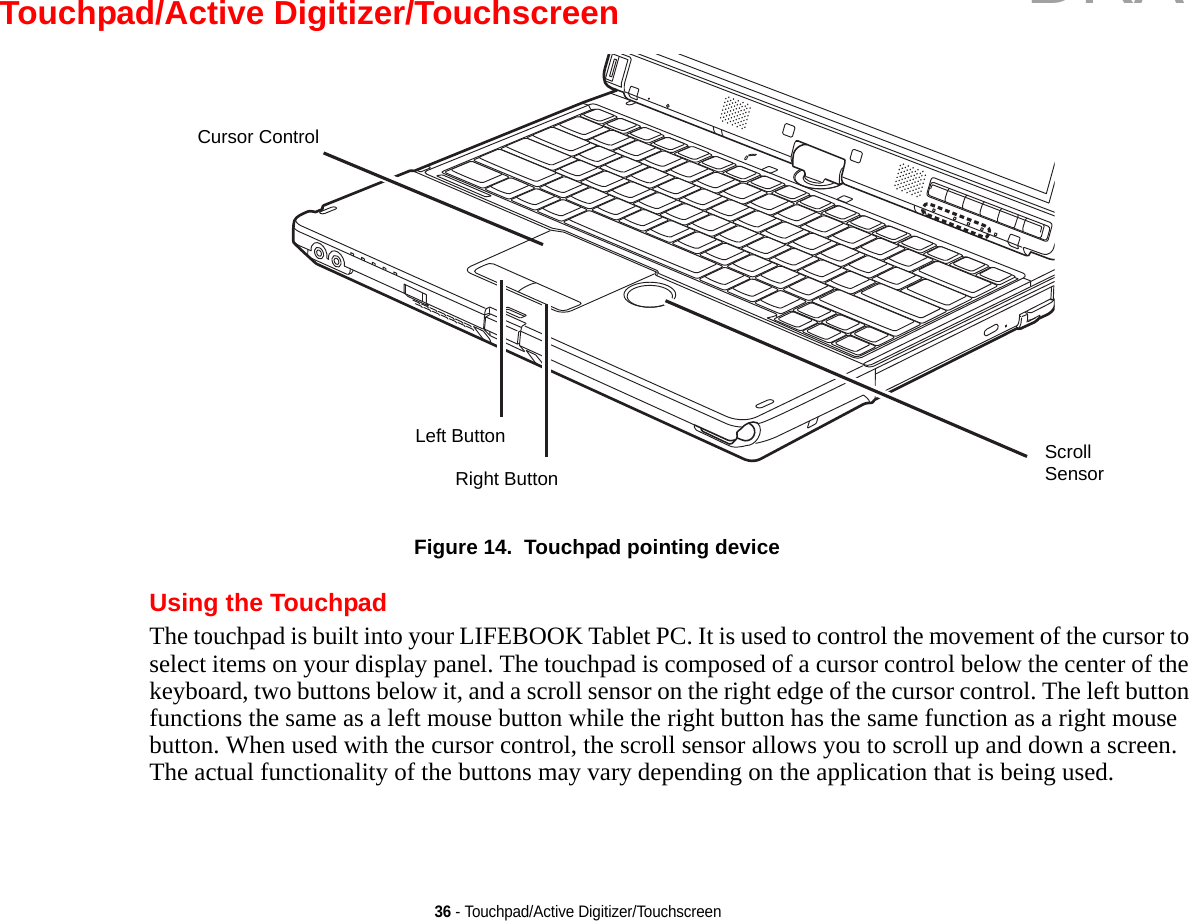
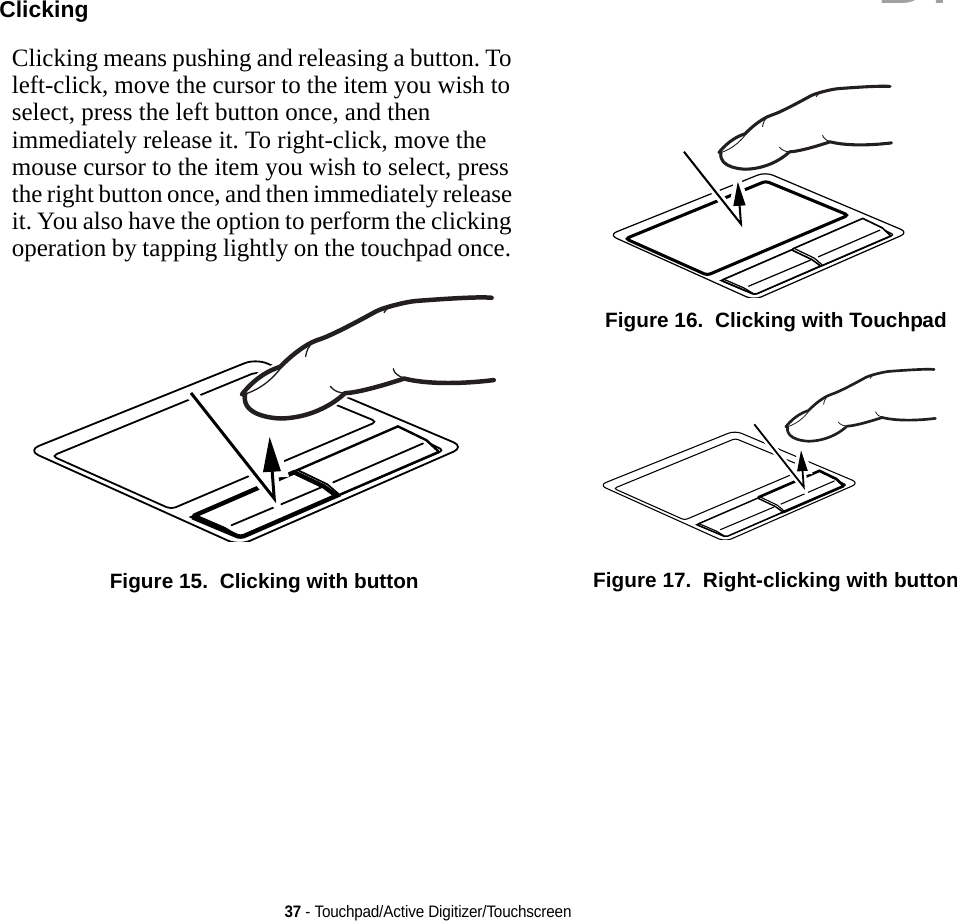
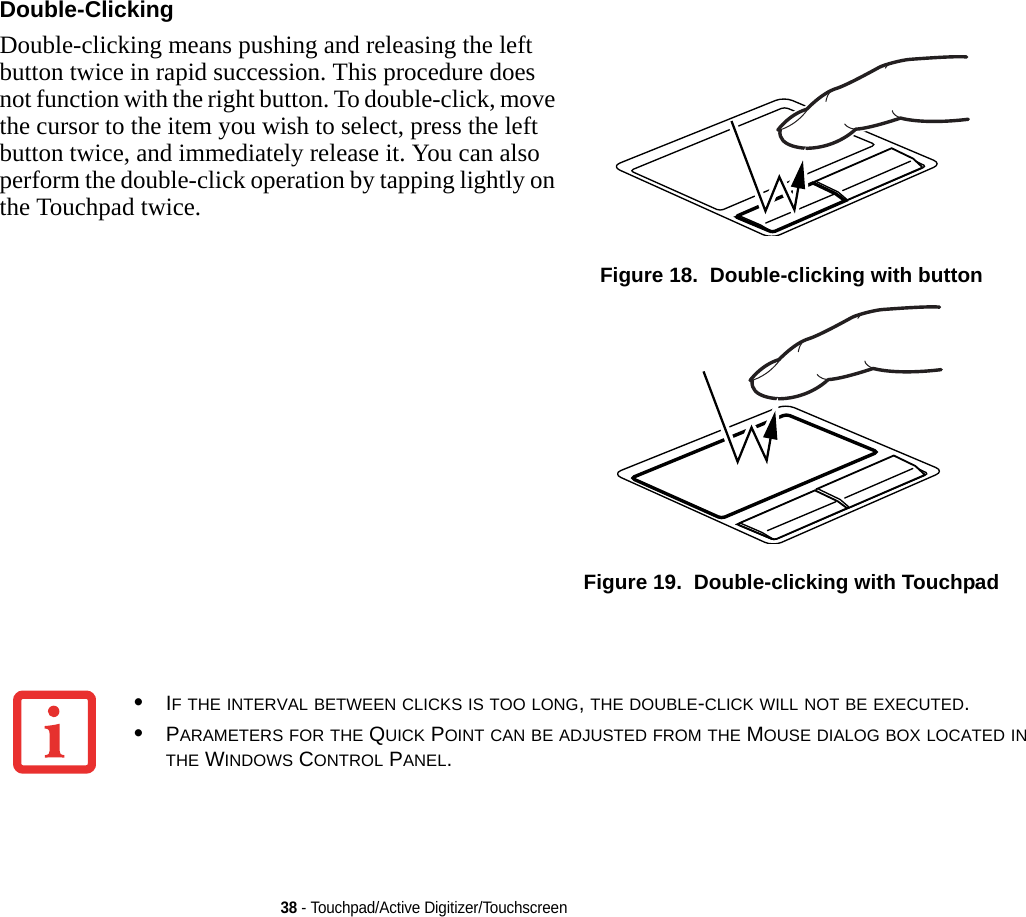
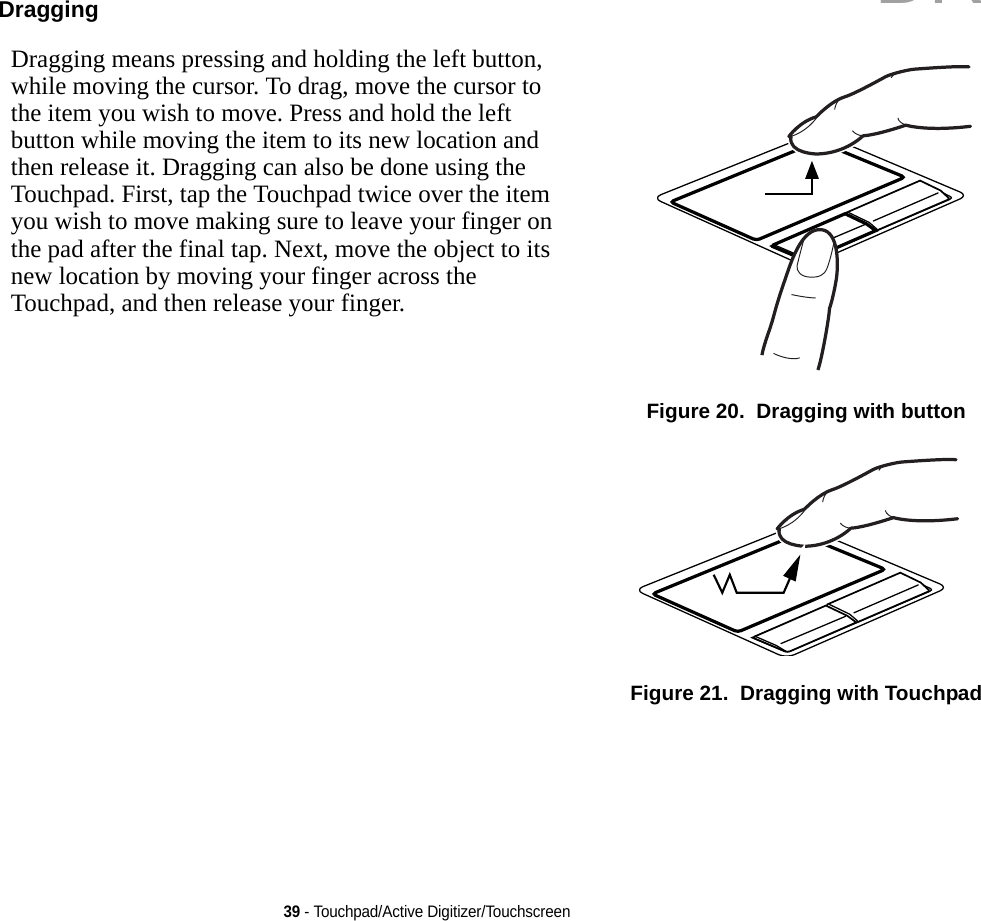
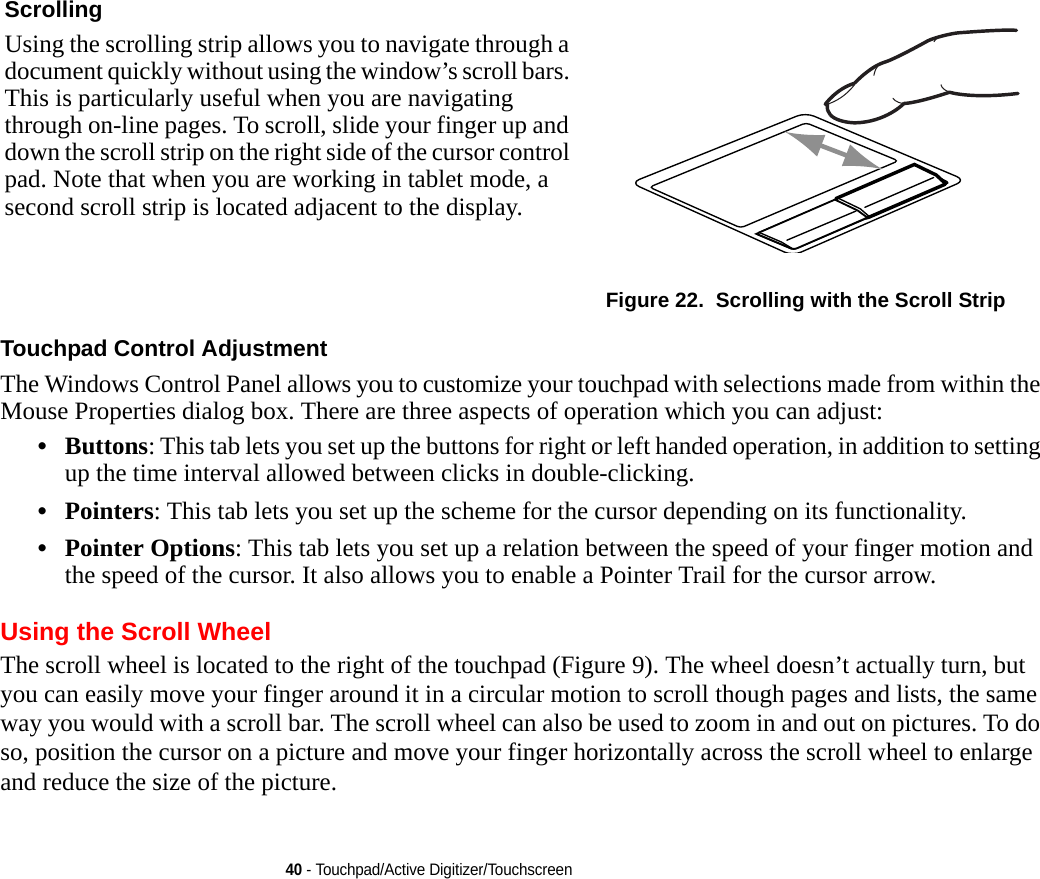
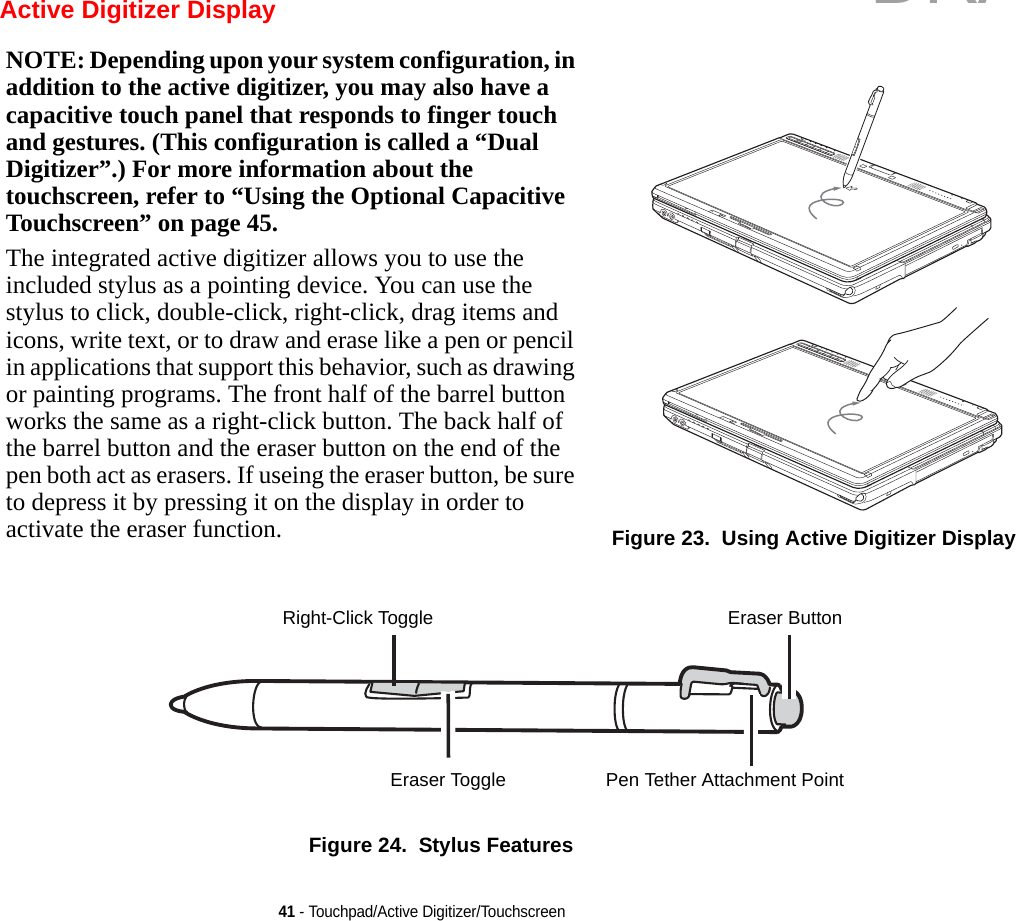
![42 - Touchpad/Active Digitizer/Touchscreen•DO NOT USE EXCESSIVE FORCE WHEN TAPPING OR WRITING ON THE SCREEN WITH THE STYLUS. EXCESSIVE FORCE COULD RESULT IN DAMAGE TO THE LED AND/OR ACTIVE DIGITIZER.•TO PURCHASE ADDITIONAL OR REPLACEMENT STYLUSES, VISIT FUJITSU’S ACCESSORIES WEBSITE AT: WWW.SHOPFUJITSU.COM.Clicking on Active Digitizer Display To left-click, touch the object you wish to select and then lift the stylus tip immediately. Figure 25. Clicking on the Active Digitizer DisplayFigure 26. Right-clicking Active DigitizerRight-Clicking on Active Digitizer Right-click can be accomplished by holding the front of the toggle button down while tapping on the screen. To change the settings for the right-click feature, go to Start -> Control Panel -> Hardware and Sound -> Pen and Touch. In the Pen Options tab, select “Press and Hold” then click the [Settings] button.DRAFT](https://usermanual.wiki/Fujitsu-Client-Computing/WL0024.Updated-manual/User-Guide-1450965-Page-47.png)
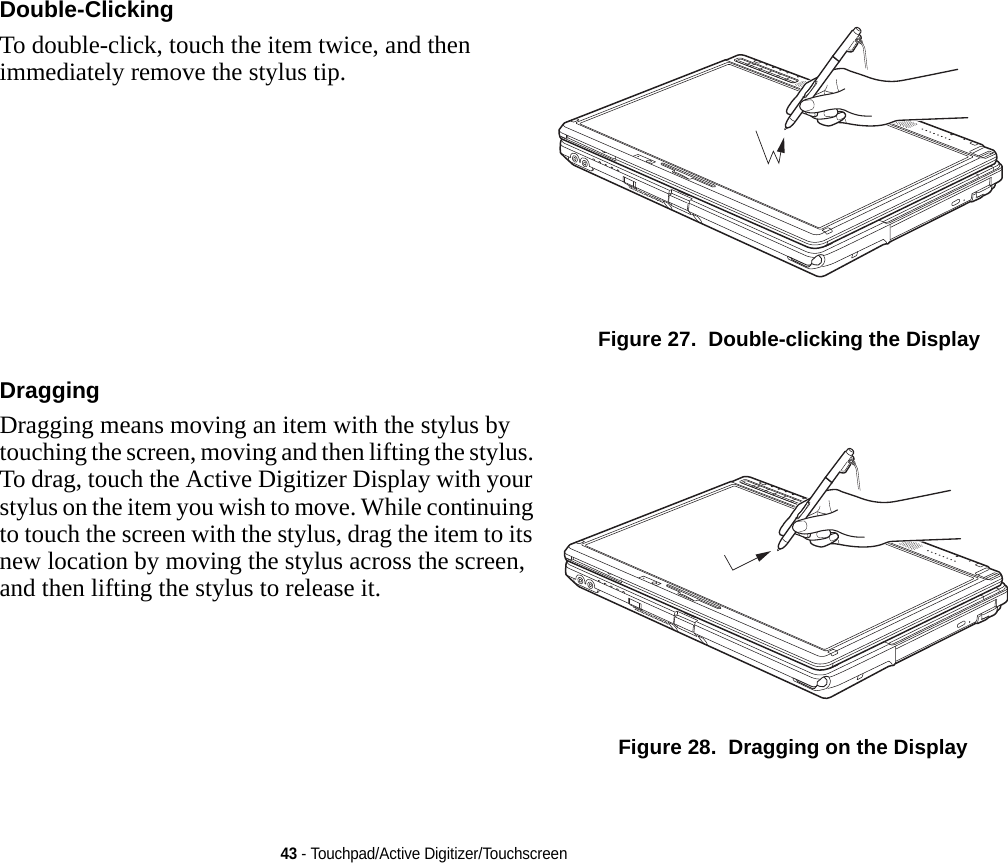
![44 - Touchpad/Active Digitizer/TouchscreenCalibrating the Active Digitizer Display In order to ensure accurate tracking between the stylus and cursor, you must run the Calibration Utility before you use the system for the first time, or after you change the display resolution.To run the calibration utility:1Go to Start -> Control Panel. 2Click Hardware and Sound, then select Tablet PC Settings3Under the Display tab, click the [Calibrate] button.(Note: If you have the optional capacitive touchscreen, you will need to click on either Pen input or Touch input, depending upon which method you want to calibrate.)4Adjust the display of your Tablet PC to a comfortable angle and find the (+) symbol in the upper-left corner of the display.5Depending upon whether you are calibrating pen input or touch input, firmly touch the screen with the stylus or your finger directly on the (+) symbol. Lift the stylus or your finger from the screen and the target will move to a different location on the screen.6Repeat step 4 until you have selected all of the (+) symbols.7Once you have selected all the symbols, press the [OK] button. 8Touch the stylus or your finger to various points on the screen to verify that the screen is correctly calibrated. If you are not satisfied with the screen’s calibration, press the [Calibrate]) button to begin again.•THE FIRST TIME YOU PERFORM A CALIBRATION, THE SYSTEM DISPLAY SHOULD BE IN LANDSCAPE MODE. SUBSEQUENT CALIBRATIONS CAN BE PERFORMED IN LANDSCAPE OR PORTRAIT MODE.•THE FIRST TIME YOU CALIBRATE, THERE WILL BE 16 CALIBRATION POINTS; SUBSEQUENT CALIBRATIONS WILL REQUIRE ONLY FOUR CALIBRATION POINTS.DO NOT USE EXCESSIVE FORCE WHEN TAPPING ON THE SCREEN DURING CALIBRATION. USE OF EXCESSIVE FORCE COULD RESULT IN DAMAGE TO THE LED AND/OR TOUCH PANEL.DRAFT](https://usermanual.wiki/Fujitsu-Client-Computing/WL0024.Updated-manual/User-Guide-1450965-Page-49.png)
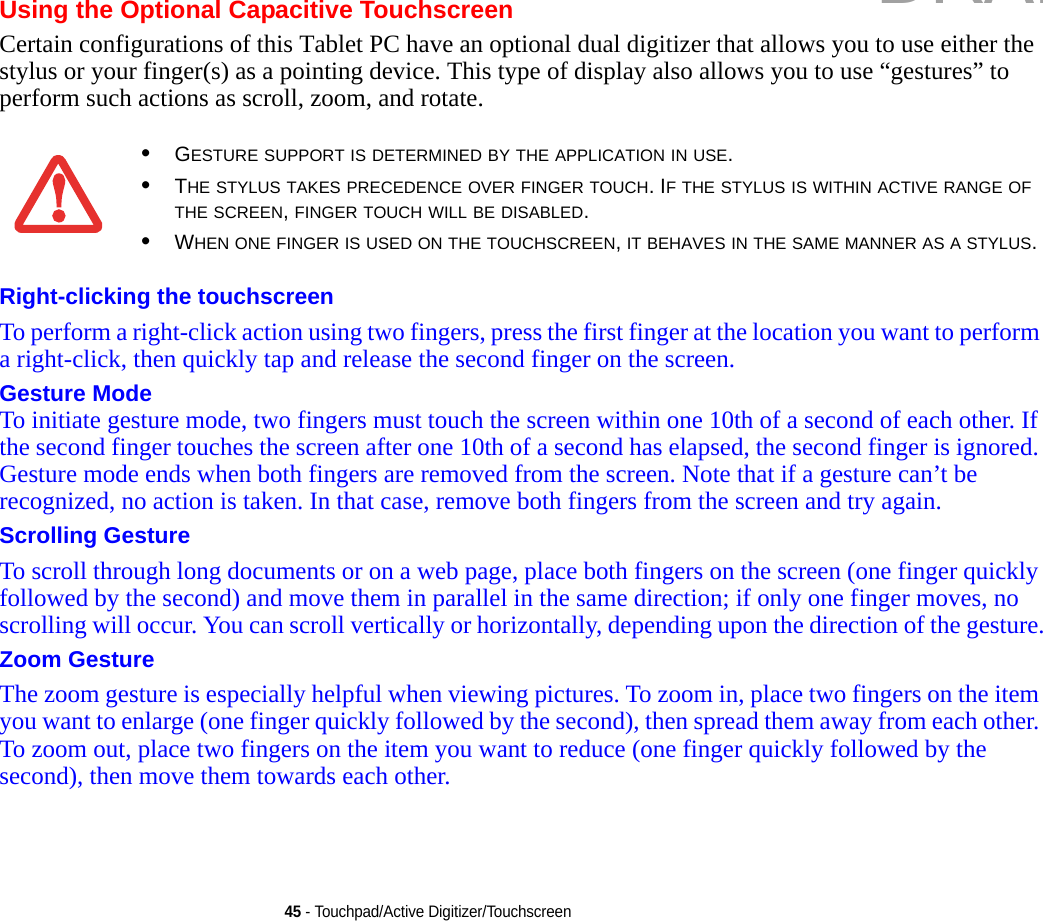
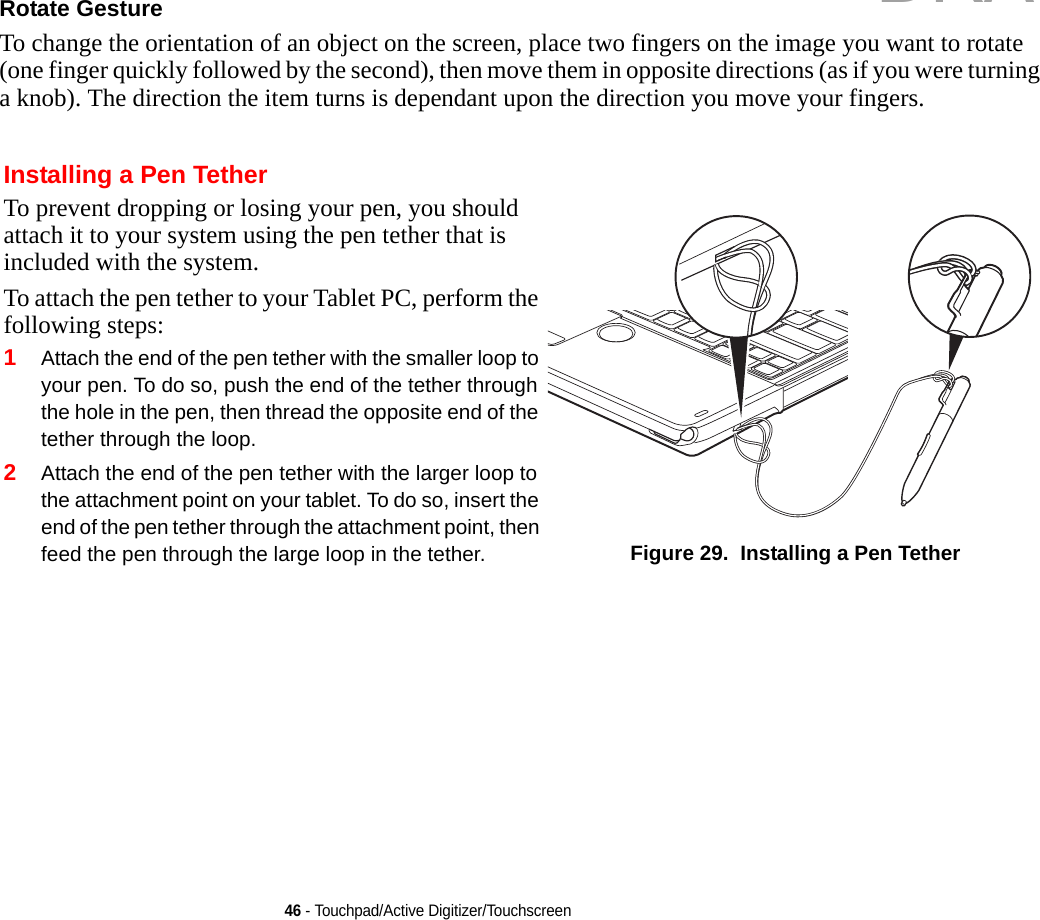
![47 - Volume ControlVolume ControlYour Fujitsu LIFEBOOK Tablet PC has multiple volume controls which interact with each other. Controlling the VolumeThe volume can be controlled in several different ways:•Volume can be changed or muted from within the Volume Control in the system tray.•Volume can be controlled with the F8 and F9 functions keys. Pressing [F8] repeatedly while holding [Fn] will decrease the volume of your Tablet PC. Pressing [F9] repeatedly while holding [Fn] will increase the volume of your Tablet PC.•Volume can be changed by opening the Control Panel and selecting Windows Mobility Center. From there, you can either mute or adjust the sound in the Volume area.•Volume can be muted by pressing the [F3] key while holding down the [Fn] key. To restore audio, repeat the [Fn+F3] procedure.•Volume can be controlled by many volume controls that are set within individual applications.•Certain external audio devices you might connect to your system may have hardware volume controls.Each source discussed above puts an upper limit on the volume level that must then be followed by the other sources. We recommend that you experiment with the various volume controls to discover the optimal sound level.ANY SOFTWARE THAT CONTAINS AUDIO FILES WILL ALSO CONTAIN A VOLUME CONTROL OF ITS OWN. IF YOU INSTALL AN EXTERNAL AUDIO DEVICE THAT HAS AN INDEPENDENT VOLUME CONTROL, THE HARDWARE VOLUME CONTROL AND THE SOFTWARE VOLUME CONTROL WILL INTERACT WITH EACH OTHER. IT SHOULD BE NOTED THAT IF YOU SET YOUR SOFTWARE VOLUME TO OFF, YOU WILL OVERRIDE THE EXTERNAL VOLUME CONTROL SETTING. DRAFT](https://usermanual.wiki/Fujitsu-Client-Computing/WL0024.Updated-manual/User-Guide-1450965-Page-52.png)
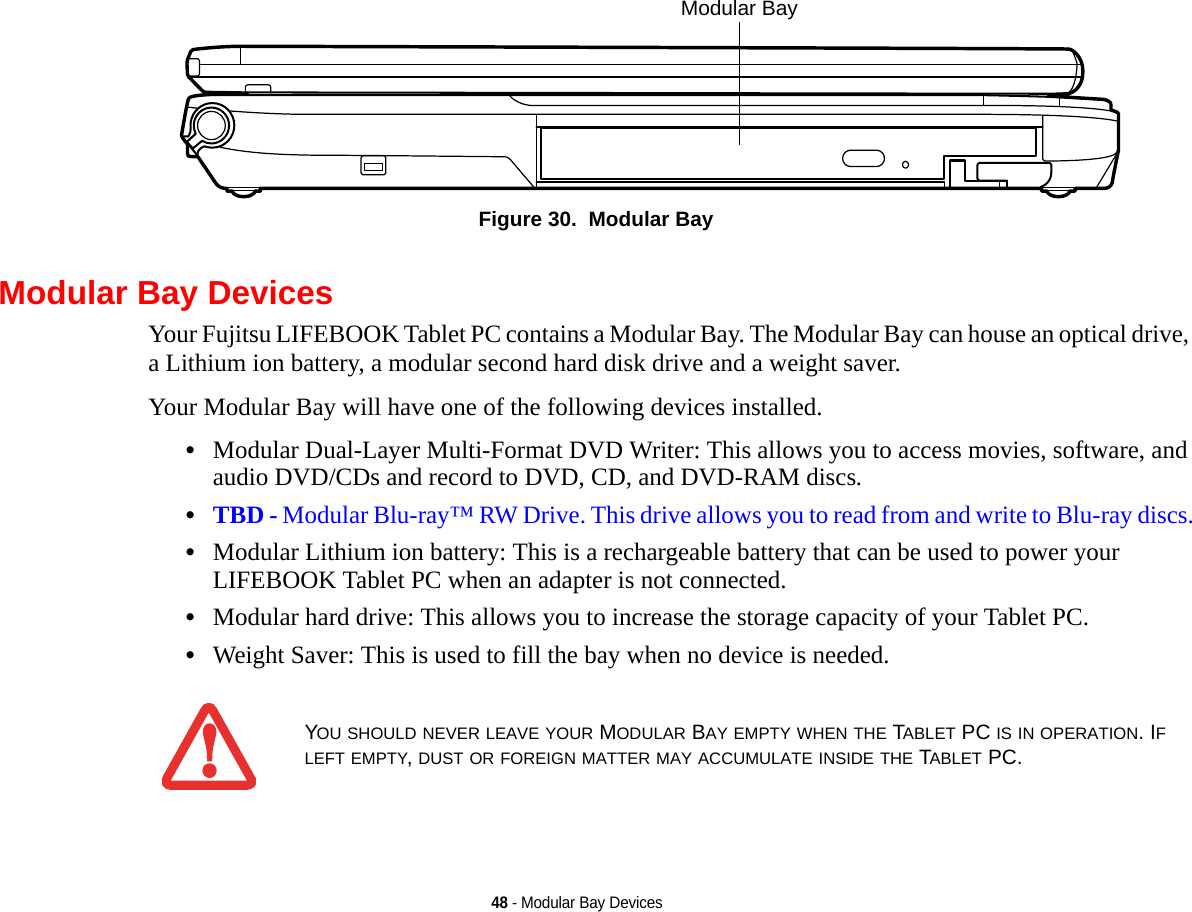
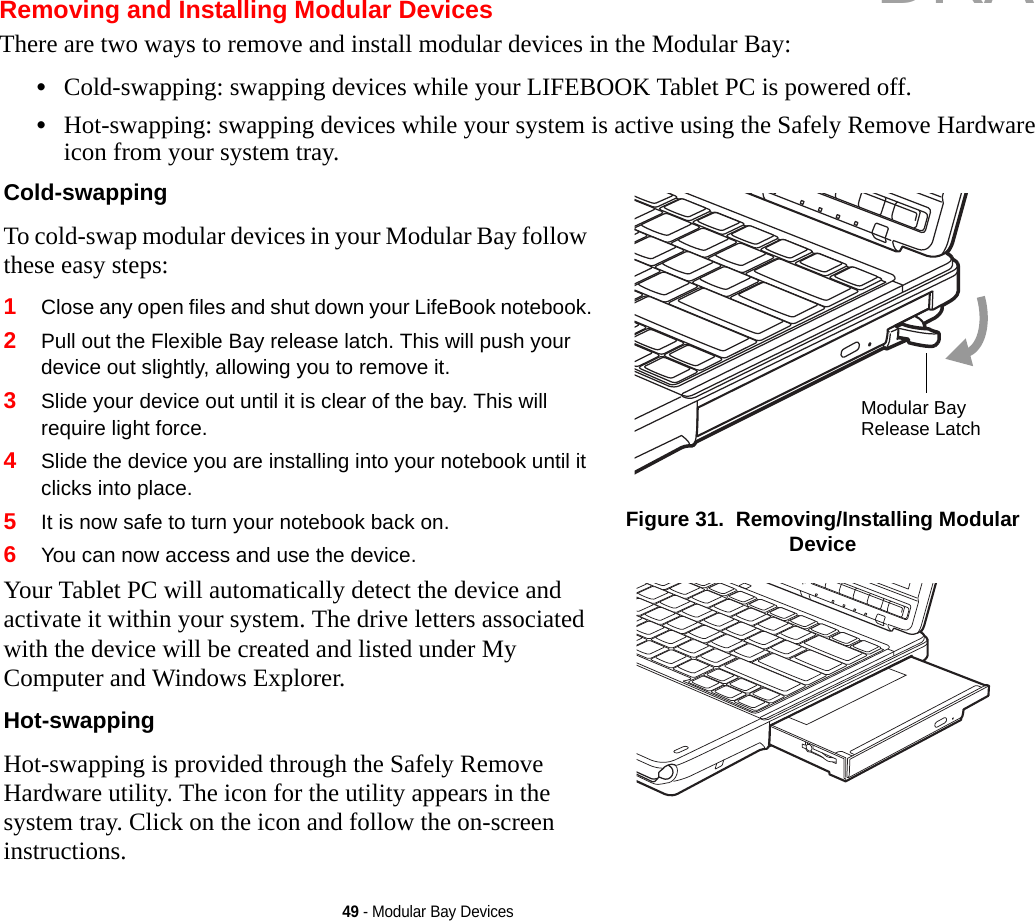
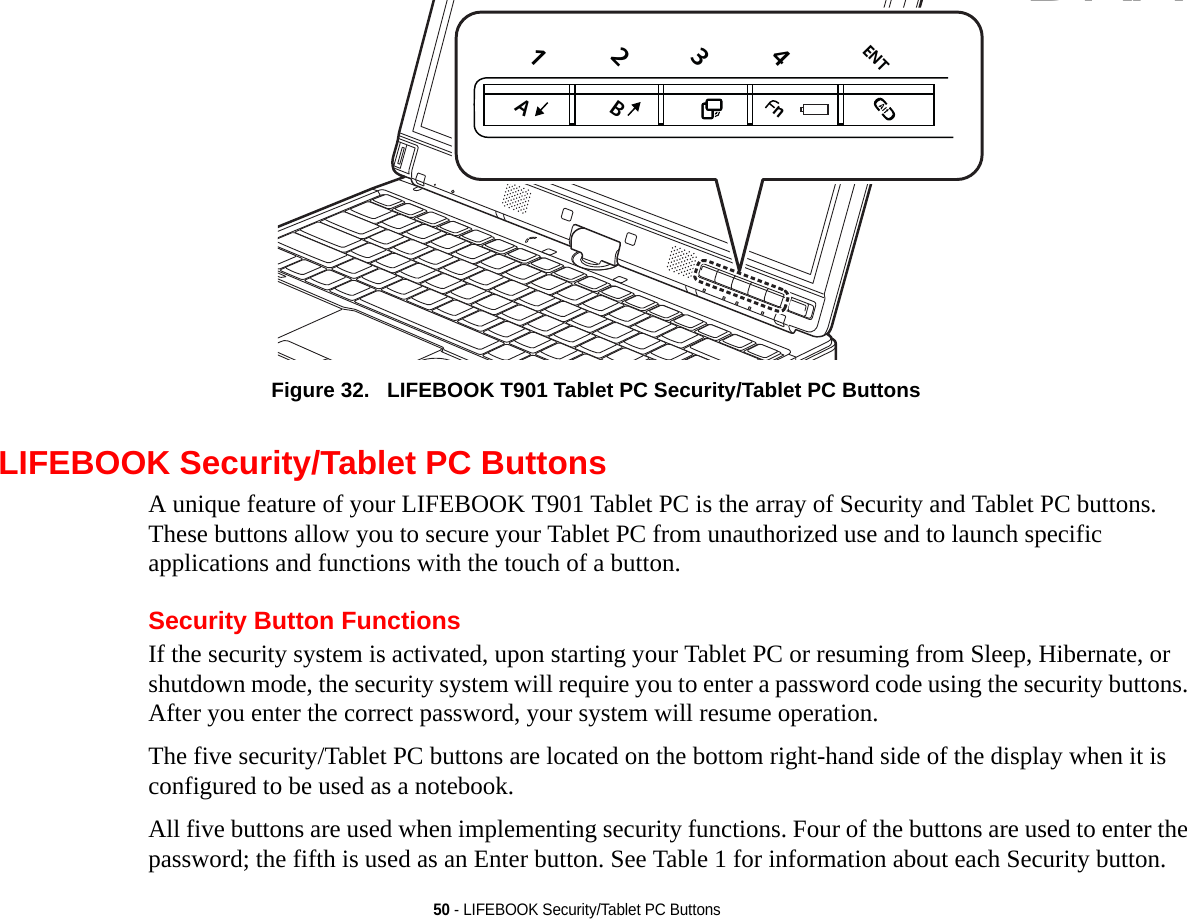
![51 - LIFEBOOK Security/Tablet PC ButtonsTable 1. Security Panel Button FunctionsPre-logon button functionsAll five buttons can be used before logging on to Windows (i.e., when the Windows logon screen is displayed). Three of the buttons have secondary functions. See Table 2 for information about the pre-logon functions.<Tab>/<Shift><Tab> When you press the [Page Down] button when the system is pre-logon, each press of the button will act as if you had pressed the [Tab] key.When you press the [Fn] button then press and release the [Page Down] button, each press of the button will act as if you had pressed the [Shift]+[Tab] key combination.<Enter>/<Escape> When you press the [Page Up] button when the system is pre-logon, each press of the button will act as if you had pressed the [Enter] key.Button Icon System State Security Panel FunctionSystem is pre-boot or resuming from suspend Security Button 1Security Button 2Security Button 3Security Button 4Security Enter ButtonDRAFT](https://usermanual.wiki/Fujitsu-Client-Computing/WL0024.Updated-manual/User-Guide-1450965-Page-56.png)
![52 - LIFEBOOK Security/Tablet PC ButtonsTable 2. Pre-logon Tablet PC Button FunctionsWhen you press the [Fn] button then press and release the [Page Up] button, each press of the button will act as if you had pressed the [Escape] key.Screen Rotation The screen rotation feature would normally be used when the system is configured as a tablet. When you would like to use the tablet as an eBook, for example, you would use the portrait orientation; when accessing spreadsheets or using the system as a notebook, you would more typically use landscape orientation.When the system is changed to tablet configuration, the orientation automatically changes to portrait mode by default.Button Icon System State Tablet PC Function Secondary Functions(Fn + Button)System is pre-logon (Windows logon screen is displayed) <Tab> <Shift><Tab><Enter> <Escape>Rotate screen NoneUsed to invoke secondary function NoneCtl+Alt+Del Button NoneDRAFT](https://usermanual.wiki/Fujitsu-Client-Computing/WL0024.Updated-manual/User-Guide-1450965-Page-57.png)
![53 - LIFEBOOK Security/Tablet PC ButtonsWhen you press the [Screen Rotation] button when the system is in pre-boot, the system screen orientation changes from portrait (vertical) to landscape (horizontal) or from landscape to portrait.Function / Fujitsu Menu Utility Button The [Function] button works in conjunction with the other application buttons to provide additional functionality for the buttons. Refer to specific details above.Post-logon button functionsAll five buttons can be used after logging on to Windows. Four of the buttons have secondary functions. See Table 3 for information about each of the post-logon functions.Page Down / Application A Button When you press the [Page Down] button when the system is running, each press of the button will scroll the screen down one frame. This allows you to navigate quickly through large documents.When you press the [Fn] button then press and release the [Page Down/Application A] button, you will automatically start whichever program is assigned to the button. The default application for this button is Calculator. See “Changing Tablet PC Button Functions” on page 55 to select a different application for this button.Page Up / Application B Button When you press the [Page Up] button when the system is running, each press of the button will scroll the screen up one frame. This allows you to navigate quickly through large documents.THE SCREEN ORIENTATION DEFAULT CAN BE CHANGED BY GOING TO THE CONTROL PANEL AND DOUBLE-CLICKING ON THE FUJITSU TABLET CONTROLS ICON AND SELECTING THE DESIRED SETTINGS IN THE DISPLAY PROPERTIES. AFTER CHANGING THE SETTINGS, SAVE THEM IN FUJITSU TABLET CONTROLS.DRAFT](https://usermanual.wiki/Fujitsu-Client-Computing/WL0024.Updated-manual/User-Guide-1450965-Page-58.png)
![54 - LIFEBOOK Security/Tablet PC ButtonsWhen you press the [Fn] button then press and release the [Page Up/Application B] button, you will automatically start whichever program is assigned to the button. The default application for this button is Microsoft Journal. See “Changing Tablet PC Button Functions” on page 55 to select a different application for this button.Table 3. Post-logon Tablet PC Button FunctionsScreen Rotation /Display Switching Button The screen rotation feature would normally be used only when the system is configured as a tablet. When you would like to use the tablet as an eBook, for example, you would use the portrait orientation; when accessing spreadsheets or using the system as a notebook, you would more typically use landscape orientation.When the system is changed to tablet configuration, the orientation automatically changes to portrait mode by default. Button Icon System State Primary Tablet PC Function Secondary Functions(Fn + Button)System is post-logon (Windows desktop is displayed) Page Down User-defined Application A(Default = Calculator)Page Up User-Defined Application B(Default = MS Journal)Screen Rotation Display Switching:1. LED only2. CRT only3. Dual DisplaySecondary Function Selection Fujitsu Menu UtilityCtl+Alt+Del Button NoneDRAFT](https://usermanual.wiki/Fujitsu-Client-Computing/WL0024.Updated-manual/User-Guide-1450965-Page-59.png)
![55 - LIFEBOOK Security/Tablet PC ButtonsWhen you press the [Screen Rotation /Display Switching] button, the system screen orientation changes from portrait (vertical) to landscape (horizontal) or from landscape to portrait. Pressing the [Fn] button while pressing the [Screen Rotation] button will switch the display output in the following order: built-in display only, external display only, dual display.Function / Fujitsu Menu Utility Button The [Function] button works in conjunction with the other application buttons to provide additional functionality for the buttons. Refer to specific details above.Pressing the [Fn] button twice in succession causes the Fujitsu Menu Utility to appear on your screen, allowing you to modify certain system settings.Ctl+Alt+Del Button Pressing and holding the [Ctl-Alt-Del] button for up to 8 seconds launches the Logon screen or the Windows Task Manager.Changing Tablet PC Button FunctionsThe Application A and B buttons can be changed to launch a program or perform an action you select. By default, the Application A button launches the Calculator, and the Application B button launches MS Journal.To launch different applications or cause the Application A or B buttons to perform a specific action:1Double-click on the Tablet PC Settings icon in the Control Panel. THE SCREEN ORIENTATION DEFAULT CAN BE CHANGED BY GOING TO THE CONTROL PANEL AND DOUBLE-CLICKING ON THE TABLET PC SETTINGS ICON AND SELECTING THE DESIRED SETTINGS IN THE DISPLAY TAB. AFTER CHANGING THE SETTINGS, SAVE THEM IN FUJITSU TABLET CONTROLS.DRAFT](https://usermanual.wiki/Fujitsu-Client-Computing/WL0024.Updated-manual/User-Guide-1450965-Page-60.png)
![56 - LIFEBOOK Security/Tablet PC Buttons2Select the Buttons tab and select the button you would like to change from the list.3Click [Change] and open the drop down list in the Press: field.4Select the action you would like the button to perform. If you want to launch a program, click on Start a Program, then browse to the location of the program.5Click [OK], then click [OK] again. The buttons will now perform the actions you have assigned to them.Setting up LIFEBOOK Security PanelWhen you receive your Tablet PC, the security panel application is pre-installed without any passwords. The following sections provide detailed information on your security panel, how to set, change or remove passwords.Numbered Buttons Use these buttons to enter your password.Enter Button After entering the button strokes, push this button to enter the password into the Tablet PC. PasswordsThe user and supervisor password may be set on this Tablet PC. A supervisor password is typically the same for all tablets and notebooks in a work group, office, or company to allow for system management. Individual computers in a group environment should not use a common password. A password consists of one to five button strokes plus the enter button. A valid stroke consists of pushing one or up to four buttons simultaneously. The following are valid button strokes: •Pushing [4] by itself•Pushing [2] and [3] at the same time•Pushing [1], [2], and [4] at the same time•Pushing [1], [2], [3], and [4] at the same timeDRAFT](https://usermanual.wiki/Fujitsu-Client-Computing/WL0024.Updated-manual/User-Guide-1450965-Page-61.png)
![57 - LIFEBOOK Security/Tablet PC ButtonsThe following are valid passwords. The numbers within braces ({ }) are button strokes using more than one button. •{[2]+[3]}, [1], [Enter]•[4], [enter]•{[1]+[3]}, {[2]+[3]+[4]}, [1], [4], [2], [Enter]Setting Passwords When shipped from the factory, no passwords are set. You have a choice of having no password or setting a supervisor and user password. You must set the supervisor password before the user password. Setting Supervisor Password You must have set a supervisor password before setting any user passwords. The supervisor password can bypass the user password.1Go to the Start menu.2Click on Run.3Type in: C:\Program Files\Fujitsu\Security Panel Application\Supervisor\ FJSECS.EXE, then press [Enter]4Follow the on-screen instructions to set the Supervisor password.Setting User Password 1Go to the Start menu.2Click on All Programs.3Click on Security Panel Application -> Security Panel Application.4Follow the on-screen instructions to set the user password.•THE PURPOSE OF SUPERVISOR PASSWORD IS TO BE ABLE TO BYPASS THE USER PASSWORD IN CASE THE USER PASSWORD IS FORGOTTEN. THE SUPERVISOR PASSWORD ALONE WILL NOT LOCK THE SYSTEM.•YOU MUST SET THE SUPERVISOR AND USER PASSWORDS FOR THE SECURITY PANEL TO WORK.DRAFT](https://usermanual.wiki/Fujitsu-Client-Computing/WL0024.Updated-manual/User-Guide-1450965-Page-62.png)
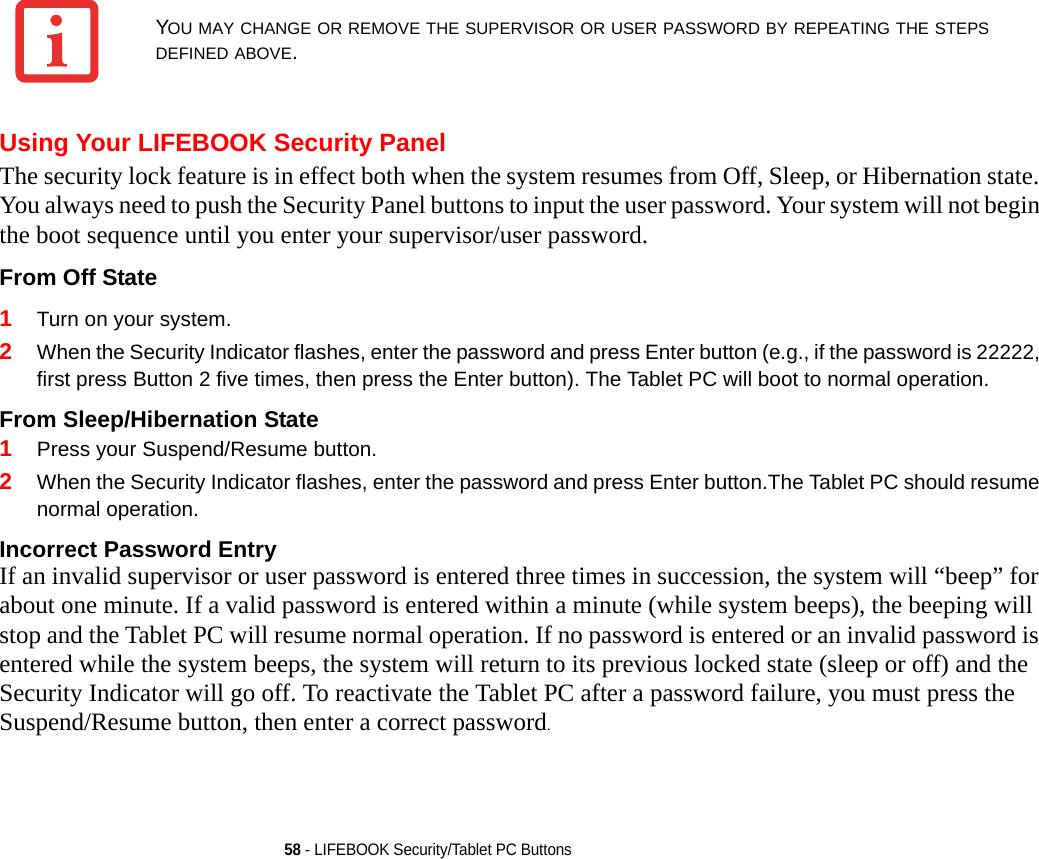
![59 - LIFEBOOK Security/Tablet PC ButtonsPrecautionsOpening and Closing the Cover By default, closing the cover automatically places your system into Sleep mode. To change the default when the cover is closed:1Open the system Control Panel. If the display is in Category view, click one of the icon selections in the View by: field. Click on Power Options.2Click Choose what closing the lid does in the left pane.3Select the desired action for When I close the lid, then click the [Save changes] button.Low Battery Operations If your Tablet PC has a low battery, pushing the suspend/resume button only turns on the Security Indicator. Your Tablet PC does not unlock, the Security Indicator turns off after one minute. To resume normal operation, first attach a power supply to the Tablet PC. Then you may unlock the Tablet PC.Uninstalling/Re-installing the Security Panel ApplicationYou have two options when uninstalling the security panel application:•Remove passwords and uninstall the security panel application software. This will disable all security features.•Uninstall the security panel application with password still active. This will not allow any changes to the password. REMEMBER THE USER PASSWORD YOU SPECIFIED ON THE SECURITY PANEL APPLICATION. IF YOU FORGET THE PASSWORD YOU WILL NOT BE ABLE TO USE YOUR COMPUTER. THE SUPERVISOR PASSWORD CAN OVERRIDE THE USER PASSWORD.DRAFT](https://usermanual.wiki/Fujitsu-Client-Computing/WL0024.Updated-manual/User-Guide-1450965-Page-64.png)
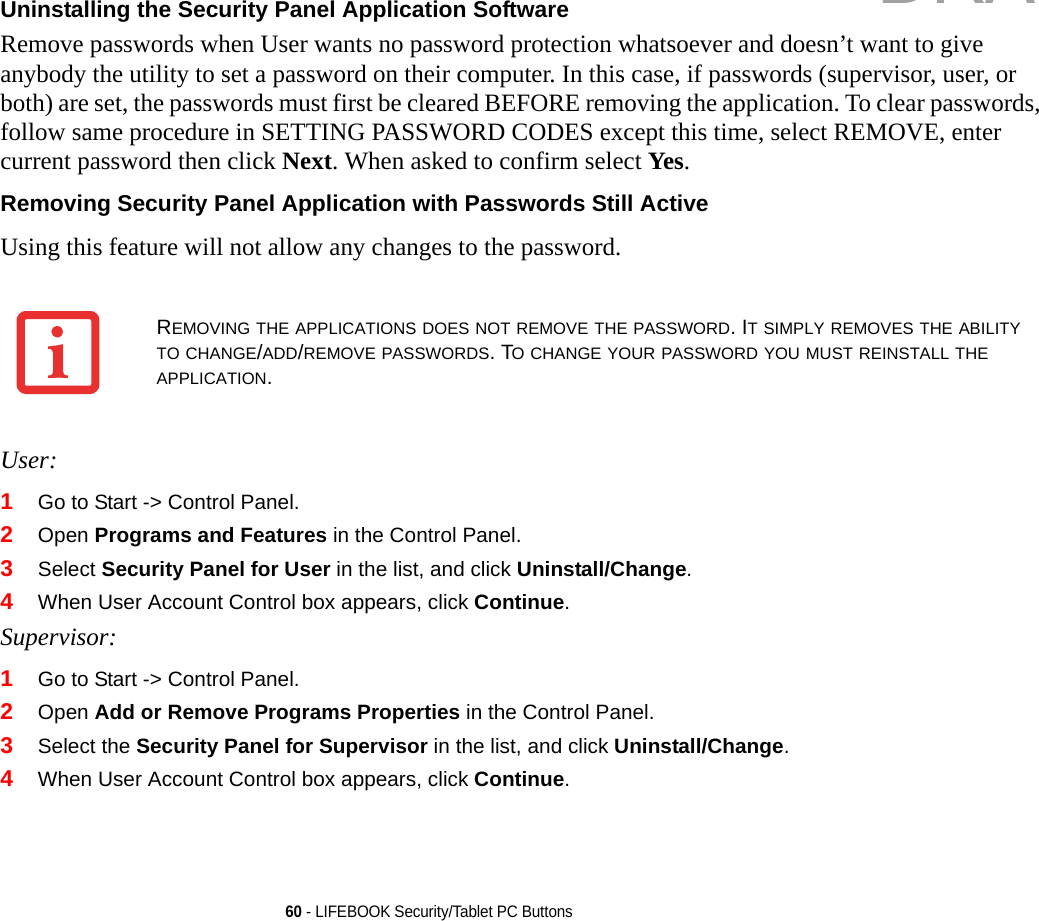
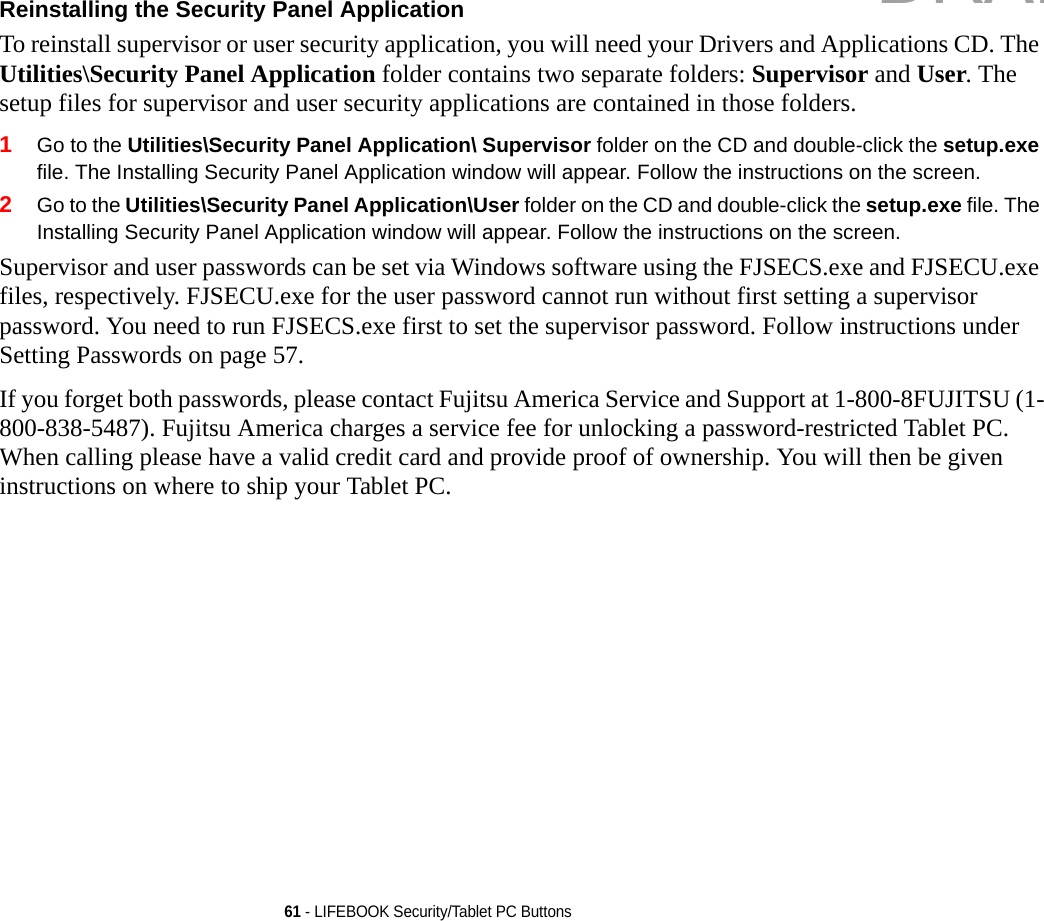
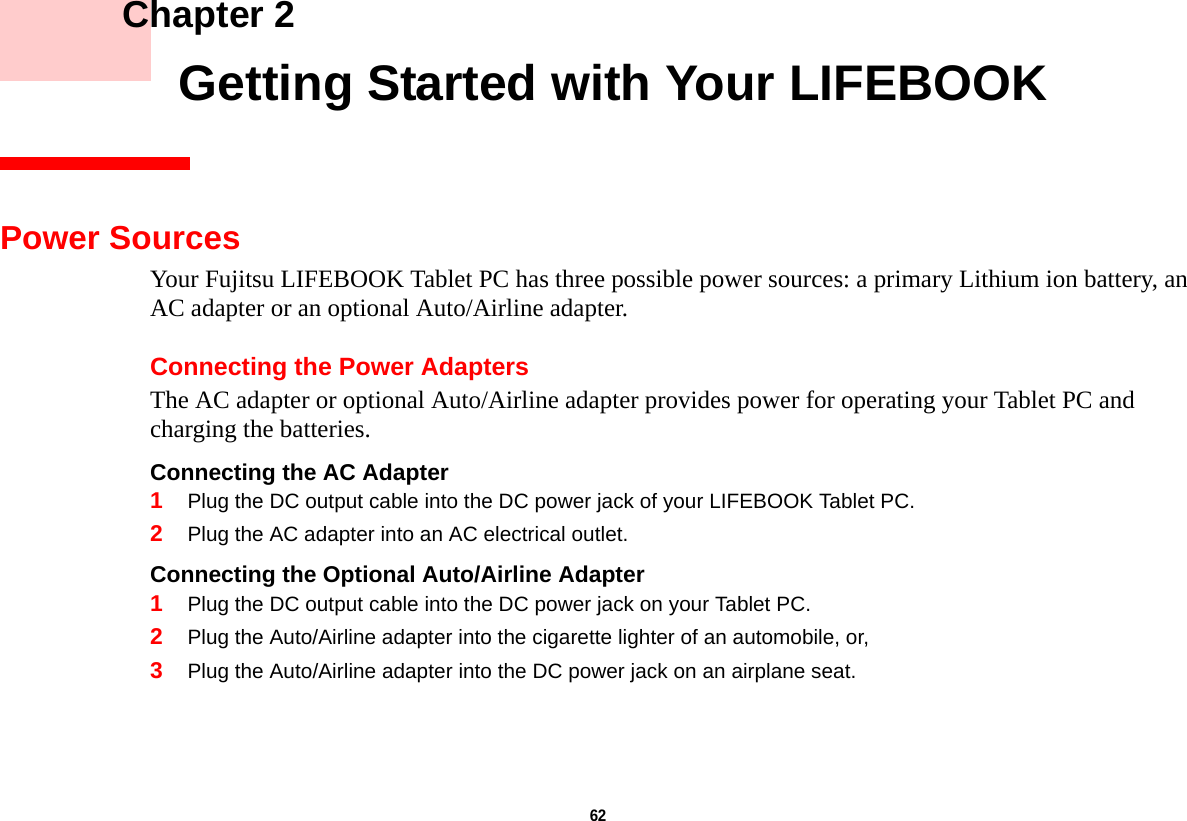
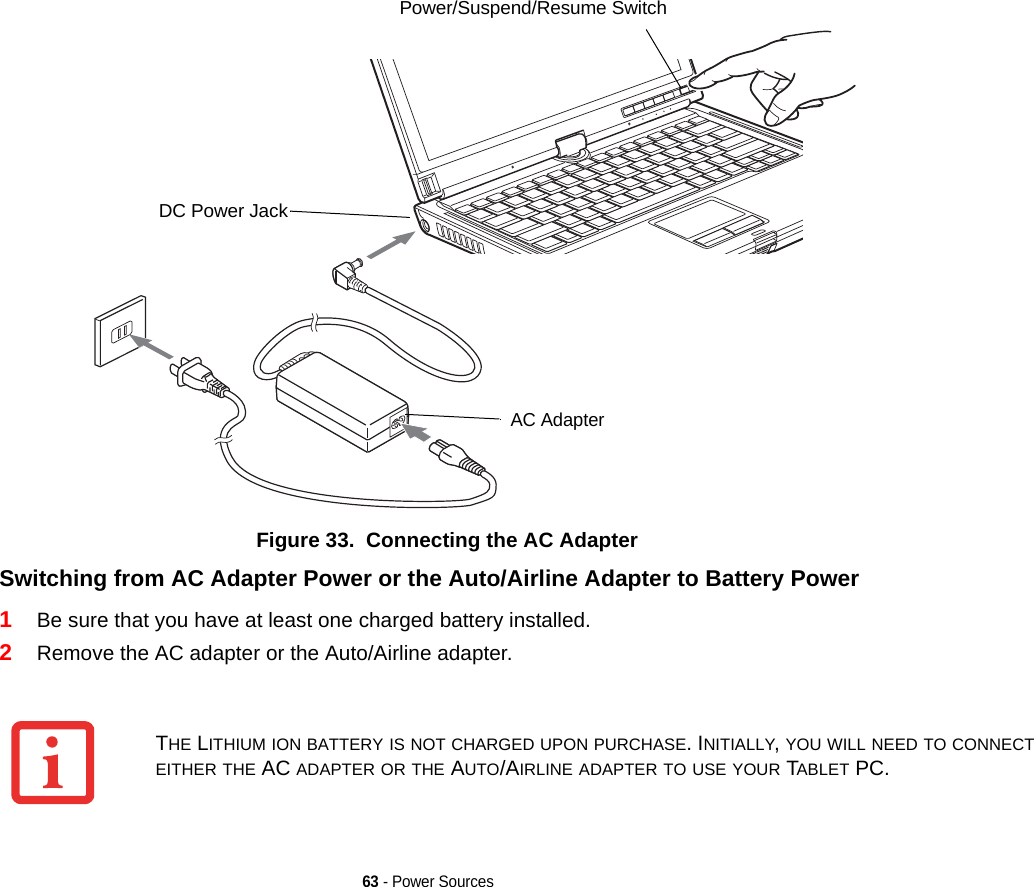
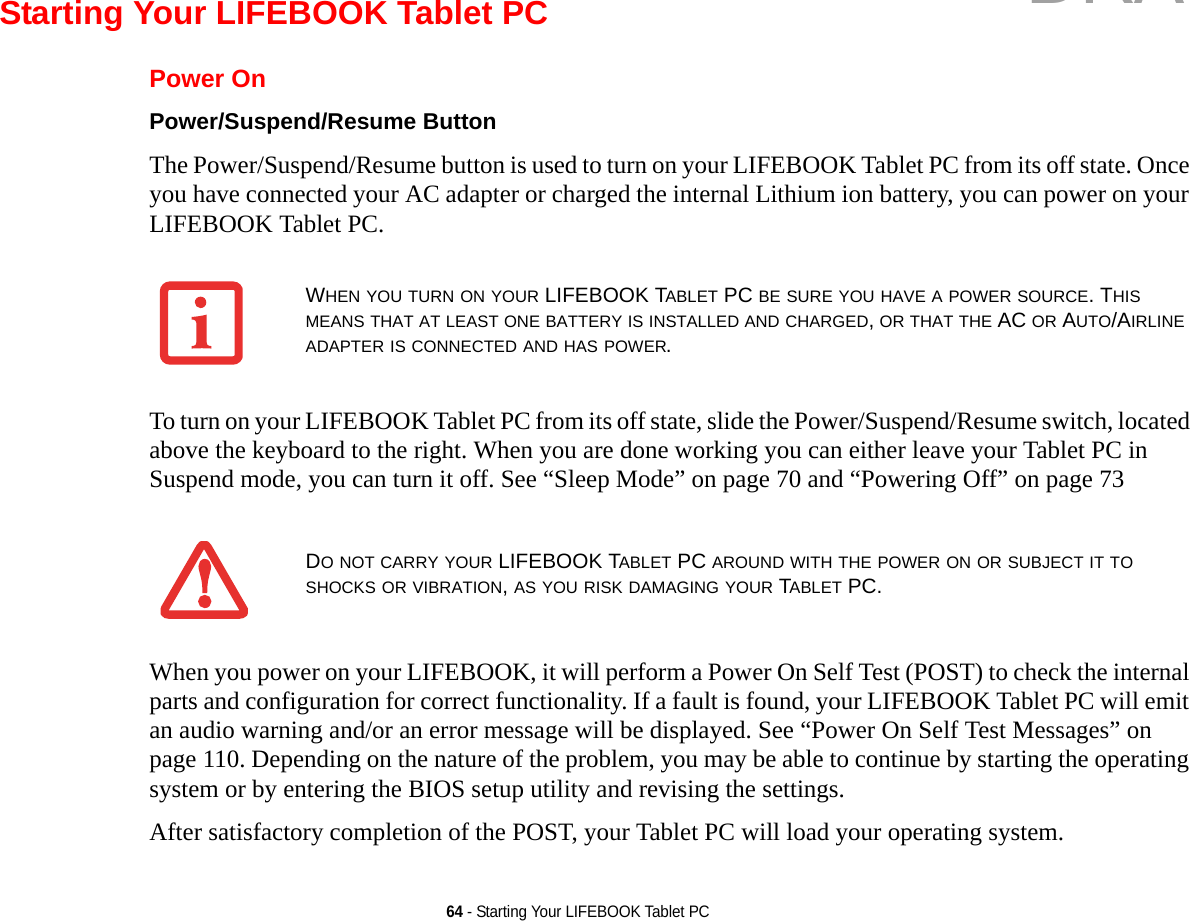
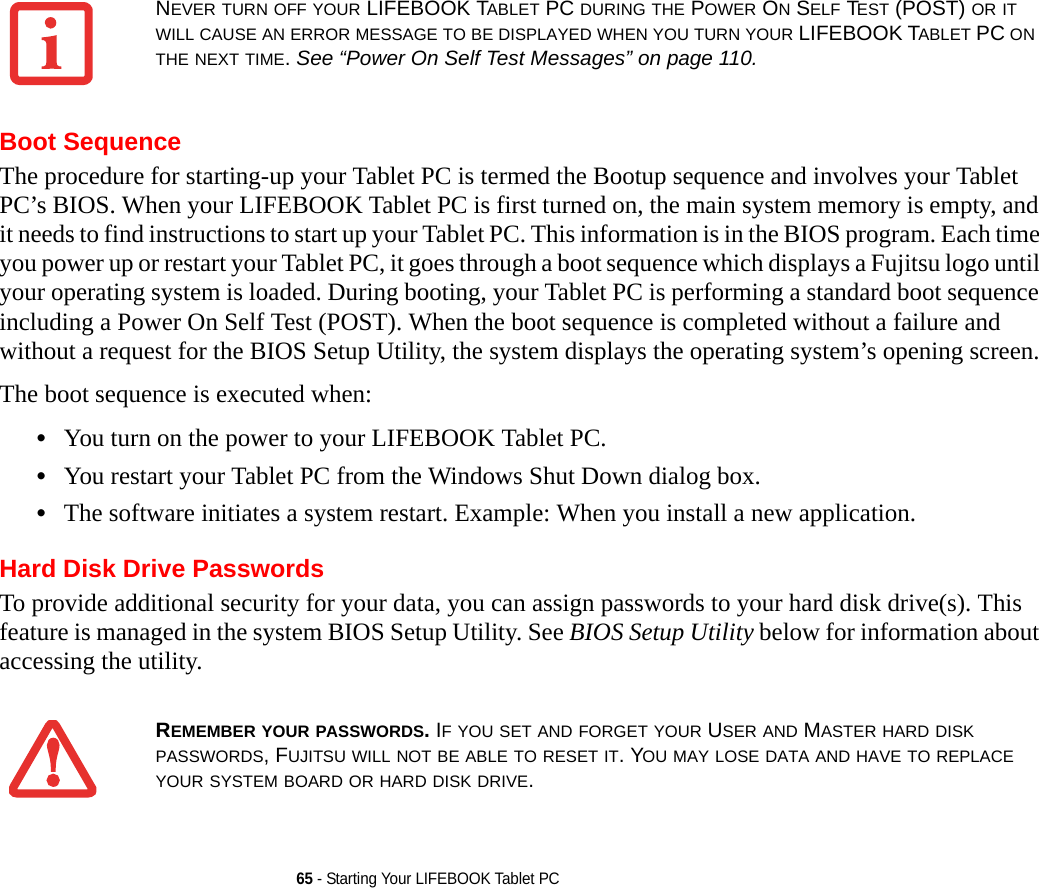
![66 - Starting Your LIFEBOOK Tablet PCBIOS Setup UtilityThe BIOS Setup Utility is a program that sets up the operating environment for your LIFEBOOK Tablet PC. Your BIOS is set at the factory for normal operating conditions, therefore there is no need to set or change the BIOS’ environment to operate your Tablet PC.The BIOS Setup Utility configures:•Device control feature parameters, such as changing I/O addresses and boot devices.•System Data Security feature parameters, such as passwords.Entering the BIOS Setup Utility To enter the BIOS Setup Utility do the following (or use the TrustedCore Menu, as detailed in the next section):1Turn on or restart your LIFEBOOK Tablet PC.2To enter the BIOS Setup Utility, press the [F2] key once the Fujitsu logo appears on the screen. This will open the main menu of the BIOS Setup Utility with the current settings displayed.3Press the [RIGHT ARROW] or [LEFT ARROW] key to scroll through the other setup menus to review or alter the current settings.Using the TrustedCore Menu When the Fujitsu logo appears on the screen. press the [Enter] key or click on the left mouse or touchpad button; the TrustedCore Menu will appear. The TrustedCore Menu provides shortcuts to the following menus and information screens: •BIOS Setup•Diagnostic Screen•Boot Menu•Patent Information•System Information•Continue BootingDRAFT](https://usermanual.wiki/Fujitsu-Client-Computing/WL0024.Updated-manual/User-Guide-1450965-Page-71.png)
![67 - Starting Your LIFEBOOK Tablet PCClicking on any of the fields will invoke the screen, information, or action described.The Boot Menu can also be invoked by pressing the [F12] key when the Fujitsu logo appears on the screen.BIOS Guide A guide to your Tablet PC’s BIOS is available online. Please visit our service and support website at http://www.computers.us.fujitsu.com/support, then select User’s Guides under Online Support. Select your Product, Series, and Model, then click [Go]. Under the Manuals tab, select the BIOS Guide. Booting the SystemWe strongly recommend that you not attach any external devices until you have gone through the initial power on sequence.When you turn on your Tablet PC for the first time, it will display a Fujitsu logo on the screen. If you do nothing the system will load the operating system, and then the Windows Welcome will begin.Starting Windows the First TimeAfter you boot up the system the first time and follow the instructions on the screen, you will eventually come to the Welcome window. After the Welcome window appears, the screen will black out for up to several minutes. This is normal. DO NOT ATTEMPT TO POWER DOWN THE SYSTEM AT THIS POINT. While the screen is blacked out, your system configuration is being set up and the necessary files are being installed. During the course of the first start up, you will need to read and accept the End User License Agreements (EULAs) for Microsoft and Fujitsu. •IF YOU REJECT THE TERMS OF THE LICENSE AGREEMENT YOU WILL BE ASKED TO REVIEW THE LICENSE AGREEMENT FOR INFORMATION ON RETURNING WINDOWS OR TO SHUT DOWN YOUR NOTEBOOK.•YOU CANNOT USE YOUR NOTEBOOK UNTIL YOU HAVE ACCEPTED THE LICENSE AGREEMENT. IF YOU STOP THE PROCESS YOUR NOTEBOOK WILL RETURN TO THE BEGINNING OF THE WINDOWS WELCOME PROCESS, EVEN IF YOU SHUT YOUR NOTEBOOK DOWN AND START IT UP AGAIN.DRAFT](https://usermanual.wiki/Fujitsu-Client-Computing/WL0024.Updated-manual/User-Guide-1450965-Page-72.png)
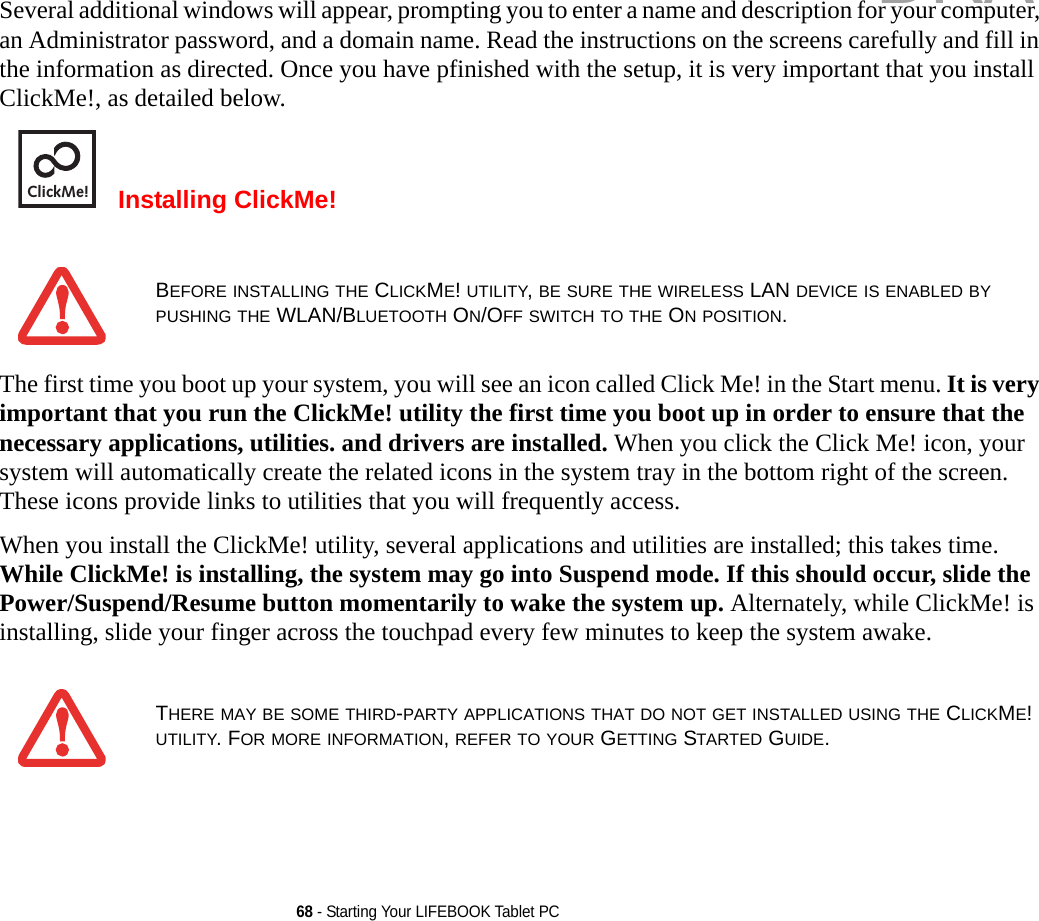
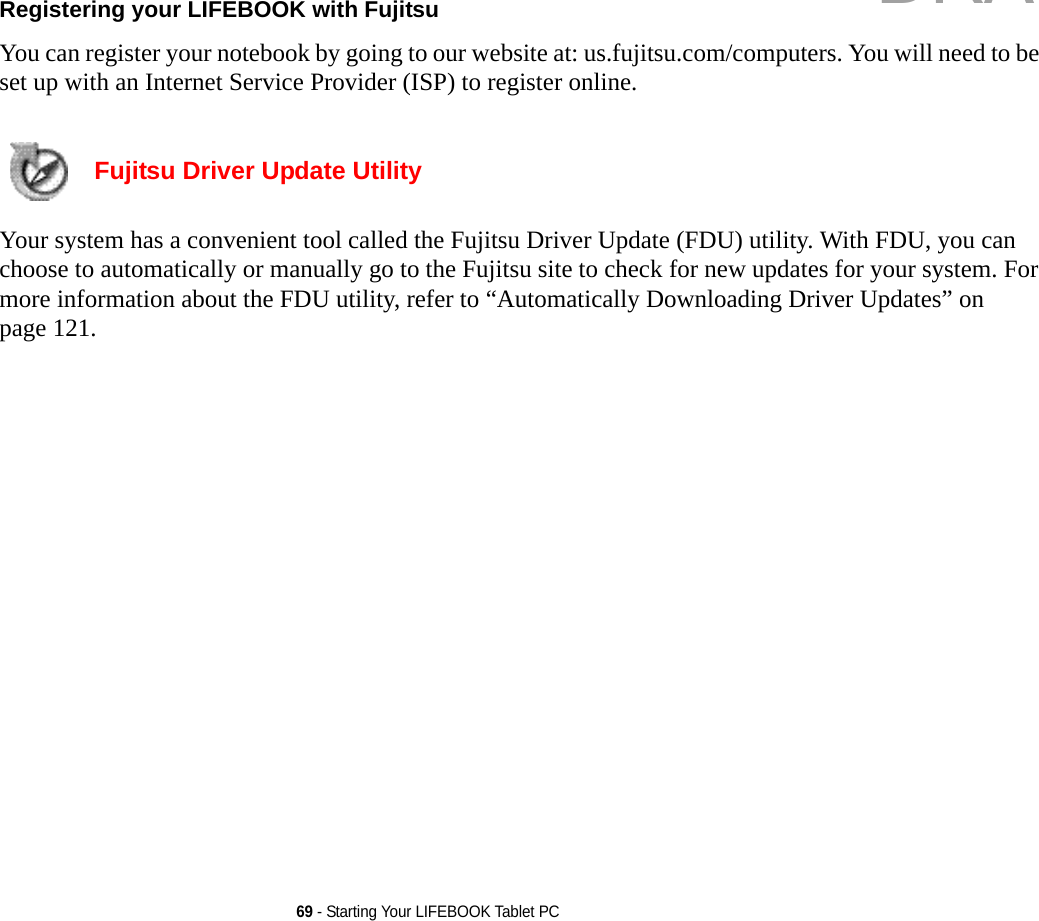
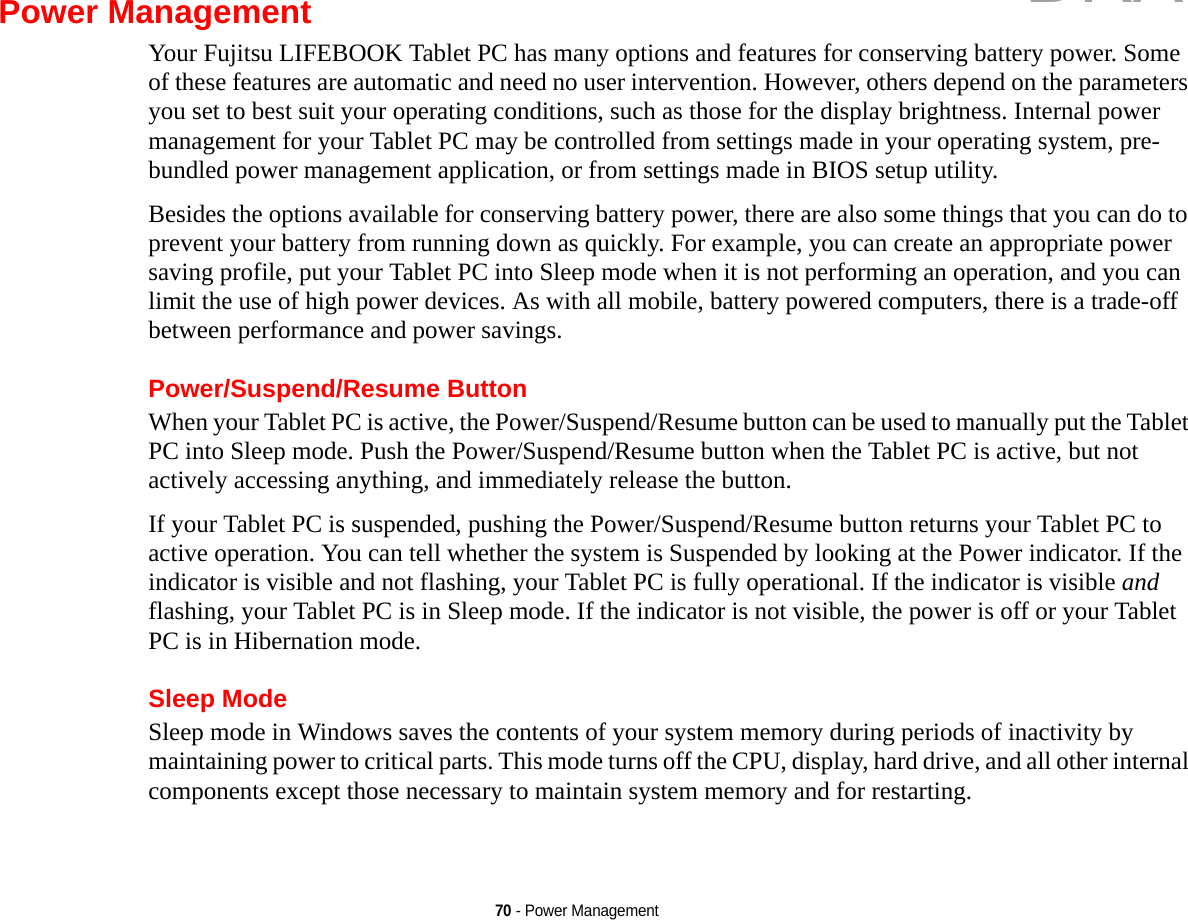
![71 - Power ManagementYour Tablet PC can be put in sleep mode by:•Pressing the Power/Suspend/Resume button when your system is turned on.•Selecting “Sleep” after clicking [Start] then clicking the small arrow at the bottom right of the window.•Timing out from lack of activity.•Allowing the battery to reach the Dead Battery Warning condition.Your Tablet PC’s system memory typically stores the file on which you are working, open application information, and any other data required to support operations in progress. When you resume operation from Sleep mode, your Tablet PC will return to the point where it left off. You must use the Power/Suspend/Resume button to resume operation, and there must be an adequate power source available, or your Tablet PC will not resume.•IF RUNNING YOUR TABLET PC ON BATTERY POWER, BE AWARE THAT THE BATTERY CONTINUES TO DISCHARGE WHILE YOUR TABLET PC IS IN SLEEP MODE, THOUGH NOT AS QUICKLY AS WHEN FULLY OPERATIONAL. •DISABLING THE POWER/SUSPEND/RESUME BUTTON PREVENTS IT FROM BEING USED TO PUT THE TABLET PC INTO SLEEP OR HIBERNATION (SAVE-TO-DISK) MODE. THE BUTTON RESUME FUNCTION CANNOT BE DISABLED.•THE SLEEP OR HIBERNATION MODE SHOULD NOT BE USED WITH CERTAIN EXPRESSCARDS. CHECK YOUR EXPRESSCARD DOCUMENTATION FOR MORE INFORMATION. WHEN EXPRESSCARDS OR EXTERNAL DEVICES ARE IN USE, HIBERNATION MODE CANNOT RETURN TO THE EXACT STATE PRIOR TO SUSPENSION, BECAUSE ALL OF THE PERIPHERAL DEVICES WILL BE RE-INITIALIZED WHEN THE SYSTEM RESTARTS.•IF YOUR TABLET PC IS ACTIVELY ACCESSING INFORMATION WHEN YOU ENTER THE SLEEP OR HIBERNATION MODE, CHANGES TO OPEN FILES ARE NOT LOST. THE FILES ARE LEFT OPEN AND MEMORY IS KEPT ACTIVE DURING SLEEP MODE OR THE MEMORY IS TRANSFERRED TO THE INTERNAL HARD DRIVE DURING HIBERNATION MODE.•THE MAIN ADVANTAGE OF USING HIBERNATION IS THAT POWER IS NOT REQUIRED TO MAINTAIN YOUR DATA. THIS IS PARTICULARLY IMPORTANT IF YOU WILL BE LEAVING YOUR TABLET PC IN A SUSPENDED STATE FOR A PROLONGED PERIOD OF TIME. THE DRAWBACK OF USING HIBERNATION MODE IS THAT IT LENGTHENS THE POWER DOWN AND POWER UP SEQUENCES AND RESETS PERIPHERAL DEVICES.DRAFT](https://usermanual.wiki/Fujitsu-Client-Computing/WL0024.Updated-manual/User-Guide-1450965-Page-76.png)
![72 - Power ManagementHibernation (Save-to-Disk) FeatureThe Hibernation feature saves the contents of your Tablet PC’s system memory to the hard drive as a part of the Suspend/Resume mode. You can enable or disable this feature. Enable or Disable the Hibernation Feature The default settings are not enabled. To enable or disable the Hibernation feature follow these steps:1From the Start menu, select Control Panel, then select the Power Options icon.2Select “Choose what the power button does” or “Choose what closing the lid does”, then make your selections (Do Nothing, Sleep, Hibernate, or Shut Down).Windows Power Management The Power Options icon located in the Windows Control Panel allows you to configure some of the power management settings. For example, you can use the Power Options to set the timeout values for turning off the display and hard disks whether you are running the Tablet PC on battery power or one of the adapters. Restarting the SystemIf your system is on and you need to restart it, be sure that you use the following procedure. 1Click the [Start] button, and then move the mouse over the small arrow at the bottom right of the right-hand pane.2Select Restart from the list.TURNING OFF YOUR LIFEBOOK TABLET PC WITHOUT EXITING WINDOWS OR TURNING ON YOUR TABLET PC WITHIN 10 SECONDS OF THE SYSTEM BEING SHUT OFF MAY CAUSE AN ERROR WHEN YOU START THE NEXT TIME. DRAFT](https://usermanual.wiki/Fujitsu-Client-Computing/WL0024.Updated-manual/User-Guide-1450965-Page-77.png)
![73 - Power ManagementPowering OffBefore turning off the power, check that the hard drive/optical drive access indicator is off. If you turn off the power while accessing a disk there is a risk of data loss. To ensure that your Tablet PC shuts down without error, use the Windows shut down procedure.Using the correct procedure to shut down from Windows allows your Tablet PC to complete its operations and turn off power in the proper sequence to avoid errors. The proper sequence is:1Click the [Start] button, and then move the mouse over the small arrow at the bottom right of the right-hand pane.2Select Shut Down from the list.If you are going to store your Tablet PC for a month or more, see Care and Maintenance Section. BE SURE TO CLOSE ALL FILES, EXIT ALL APPLICATIONS, AND SHUT DOWN YOUR OPERATING SYSTEM PRIOR TO TURNING OFF THE POWER. IF FILES ARE OPEN WHEN YOU TURN THE POWER OFF, YOU WILL LOSE ANY CHANGES THAT HAVE NOT BEEN SAVED, AND MAY CAUSE DISK ERRORS.DRAFT](https://usermanual.wiki/Fujitsu-Client-Computing/WL0024.Updated-manual/User-Guide-1450965-Page-78.png)
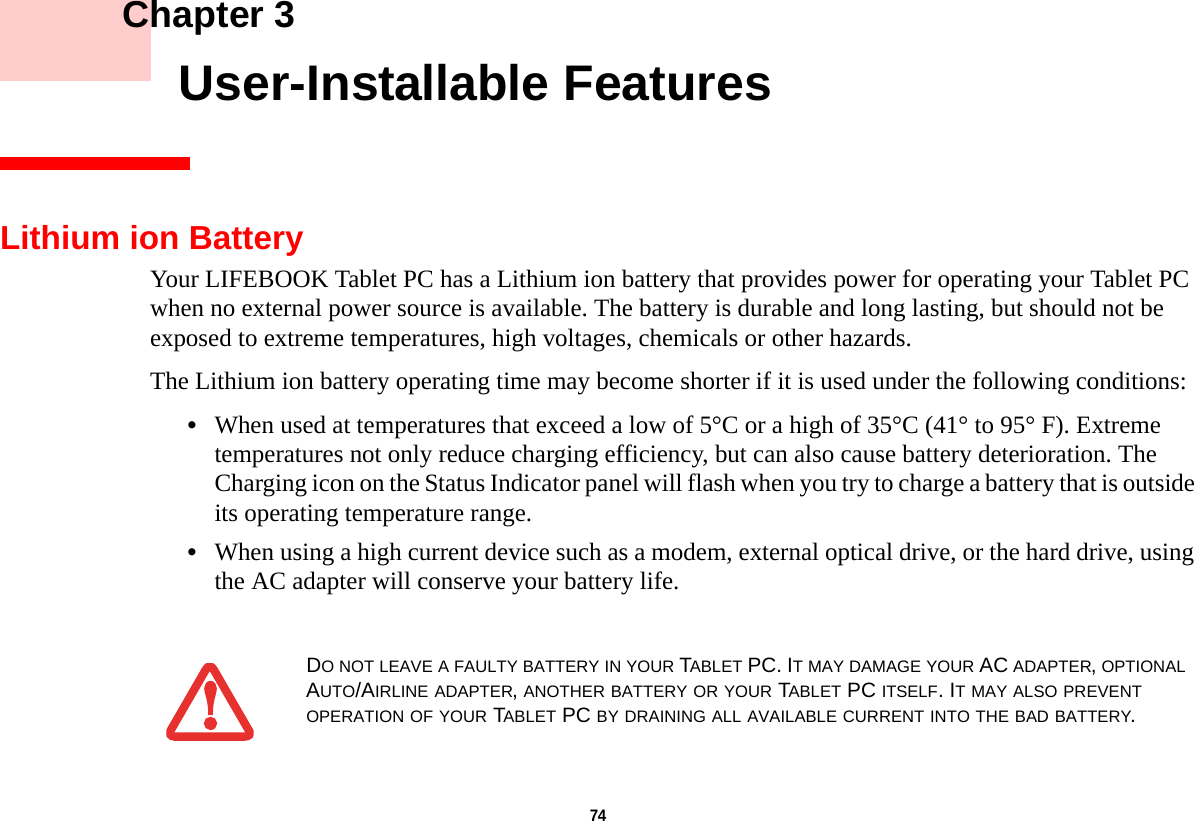
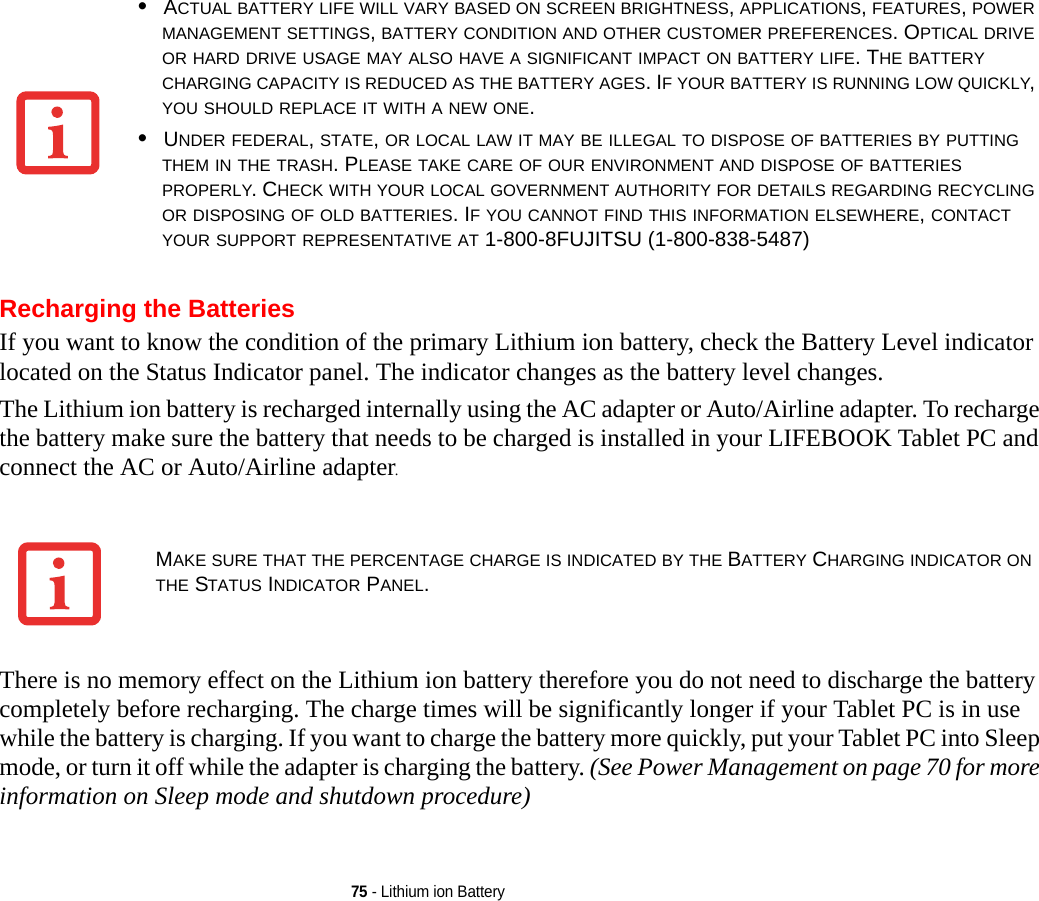
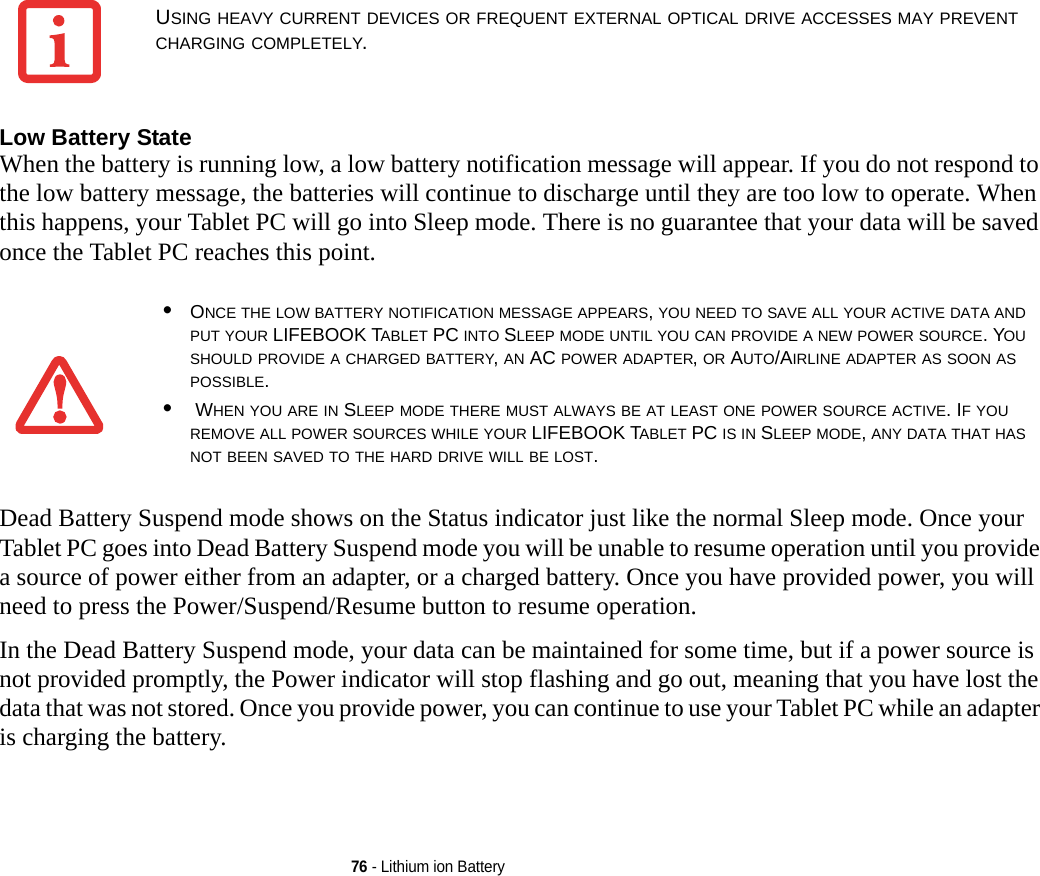
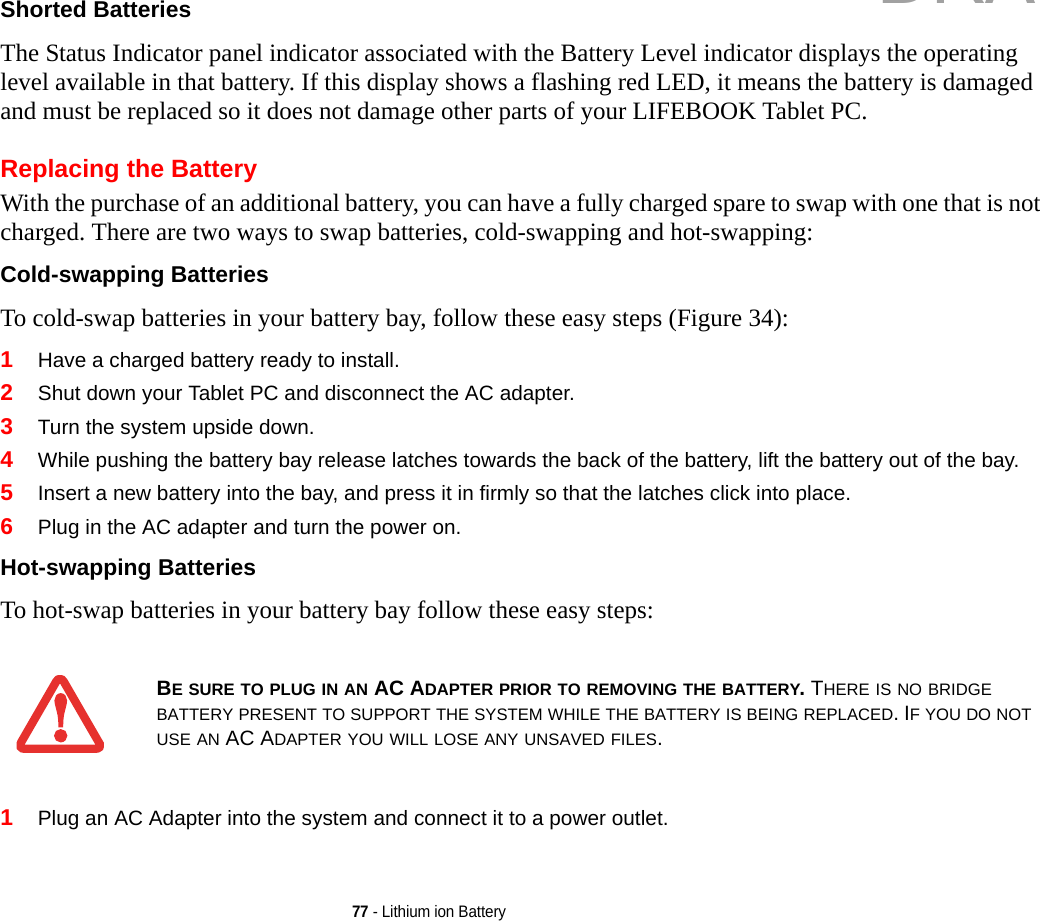
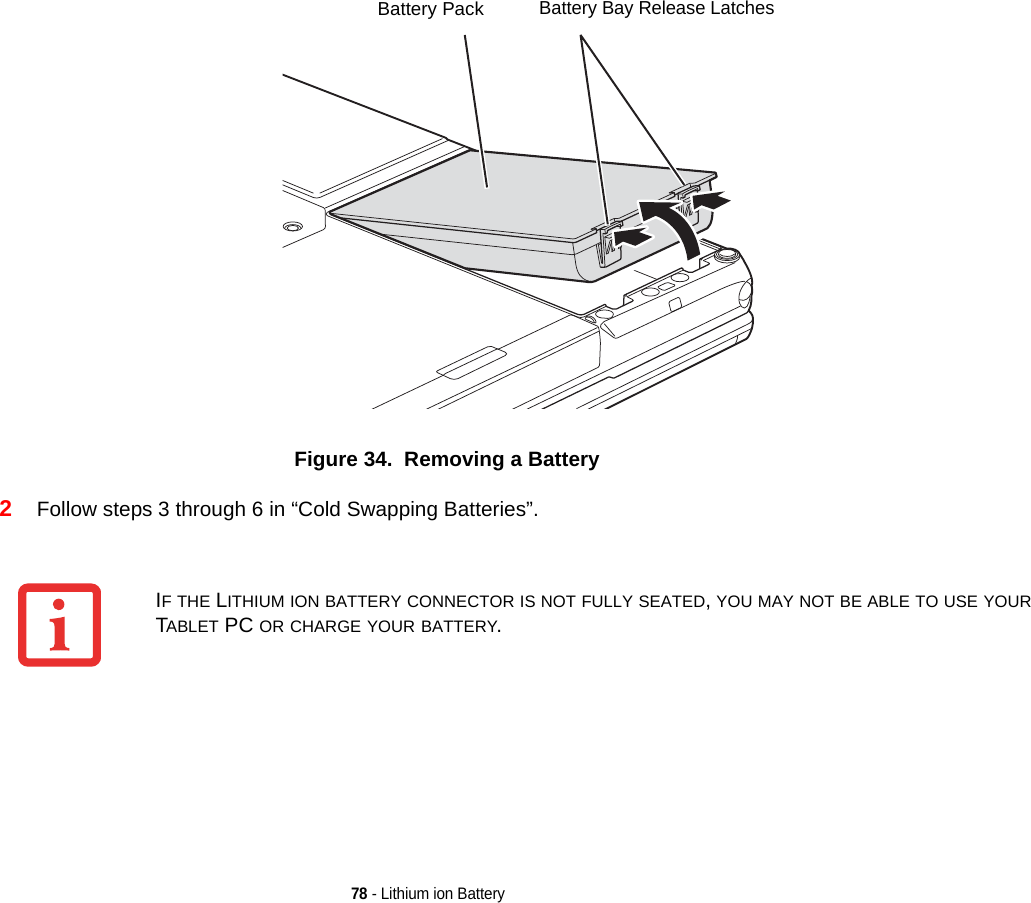
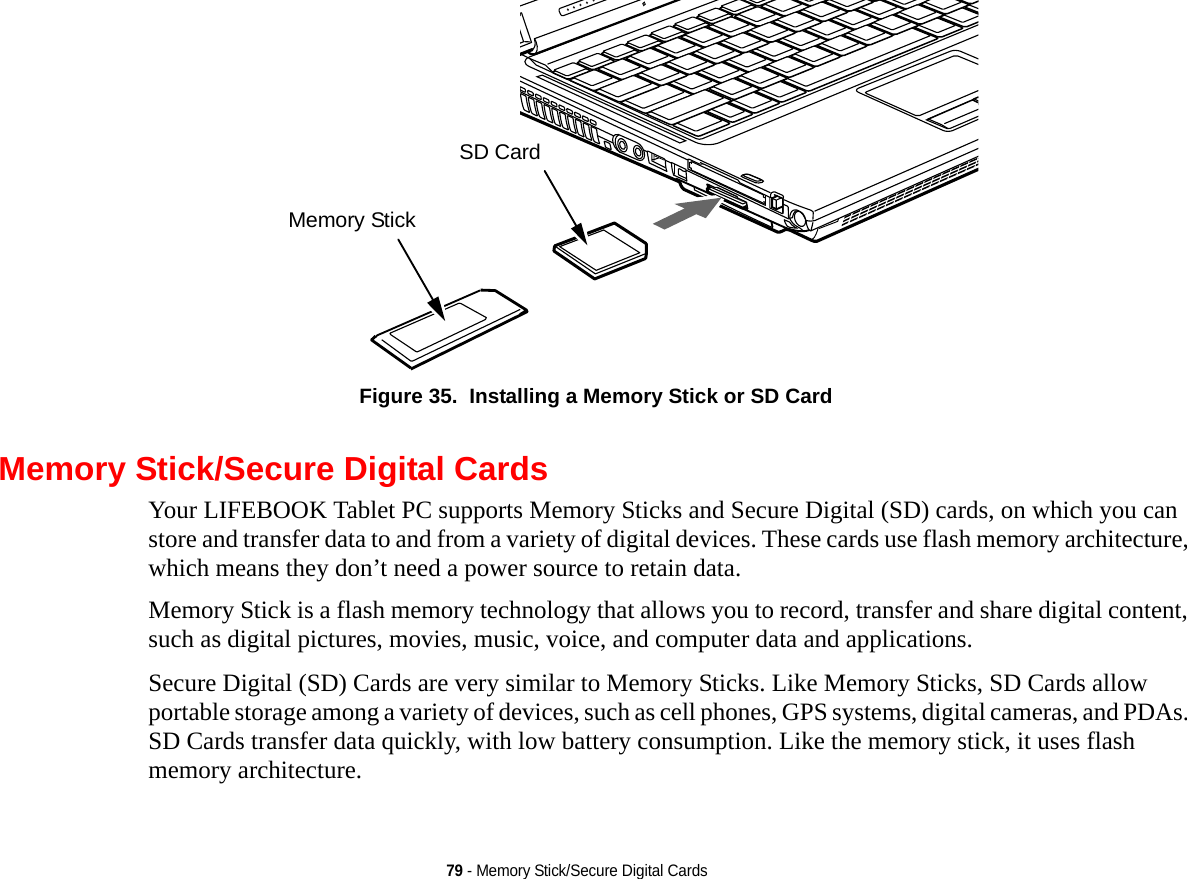
![80 - Memory Stick/Secure Digital CardsInstalling Memory Stick/SD CardsMemory Stick and SD Cards are installed in the Memory Stick/SD Card slot. To install a Memory Stick or SD Card, follow these steps:1See your specific card manual for instructions on the installation of your card. Some cards may require that your Tablet PC is off while installing them.2Make sure there is no card currently in the slot. If there is, see Removing a Memory Stick/SD Card.3Insert your card into the slot with the product label facing up.4Push the card firmly into the slot until it is seated in the connector. Removing A Memory Stick/SD CardTo remove a Memory Stick or SD Card, follow these easy steps:1Select Safely Remove Hardware from the System Tray. Highlight the card in the list, then click [Stop].2Push the Memory Stick or SD Card in until it unlatches. It will then eject from the slot for removal.INSTALLING OR REMOVING A MEMORY STICK OR SD CARD DURING YOUR LIFEBOOK TABLET PC’S SHUTDOWN OR BOOTUP PROCESS MAY DAMAGE THE CARD AND/OR YOUR LIFEBOOK TABLET PC.DO NOT INSERT A CARD INTO A SLOT IF THERE IS WATER OR ANY OTHER SUBSTANCE ON THE CARD AS YOU MAY PERMANENTLY DAMAGE THE CARD, YOUR LIFEBOOK TABLET PC, OR BOTH.SEE YOUR CARD MANUAL FOR SPECIFIC INSTRUCTIONS ON THE REMOVAL OF YOUR CARD. SOME CARDS MAY REQUIRE YOUR LIFEBOOK TABLET PC TO BE IN SLEEP MODE OR OFF WHILE REMOVING THEM.DRAFT](https://usermanual.wiki/Fujitsu-Client-Computing/WL0024.Updated-manual/User-Guide-1450965-Page-85.png)
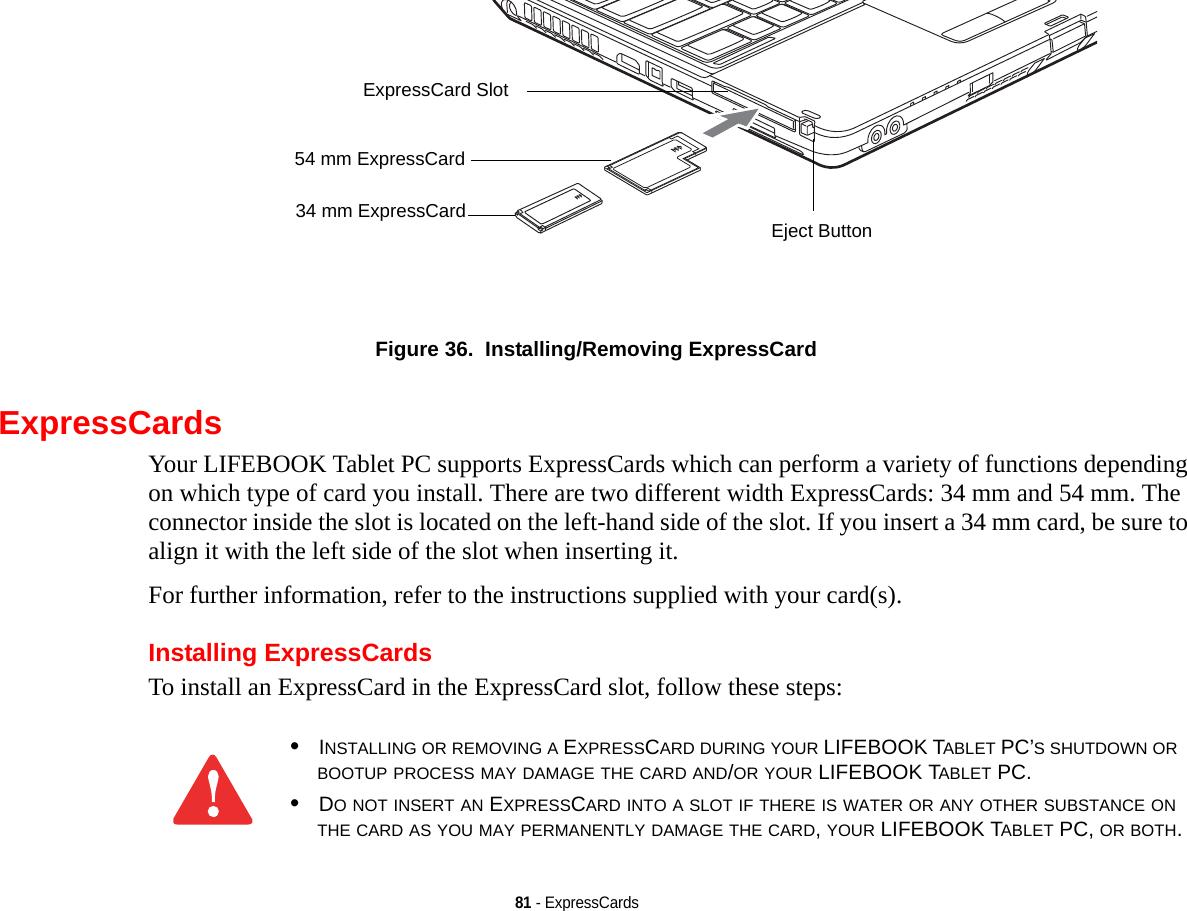
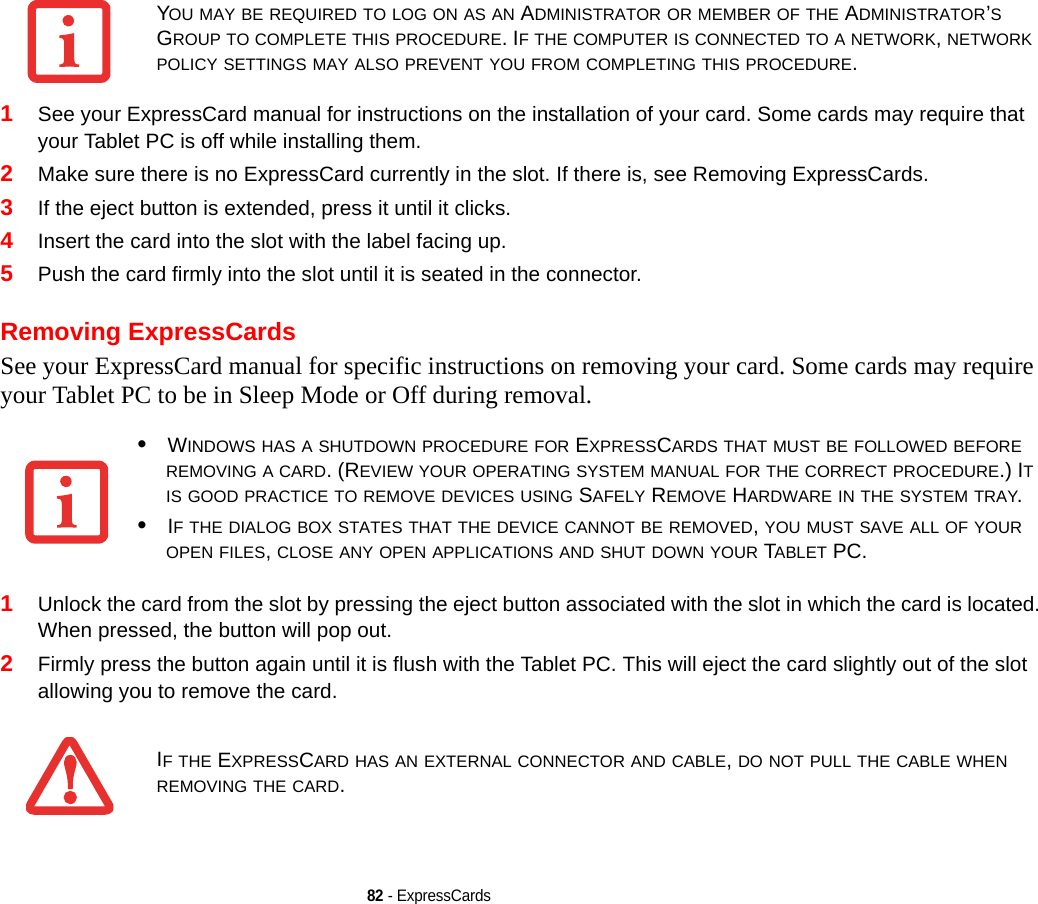
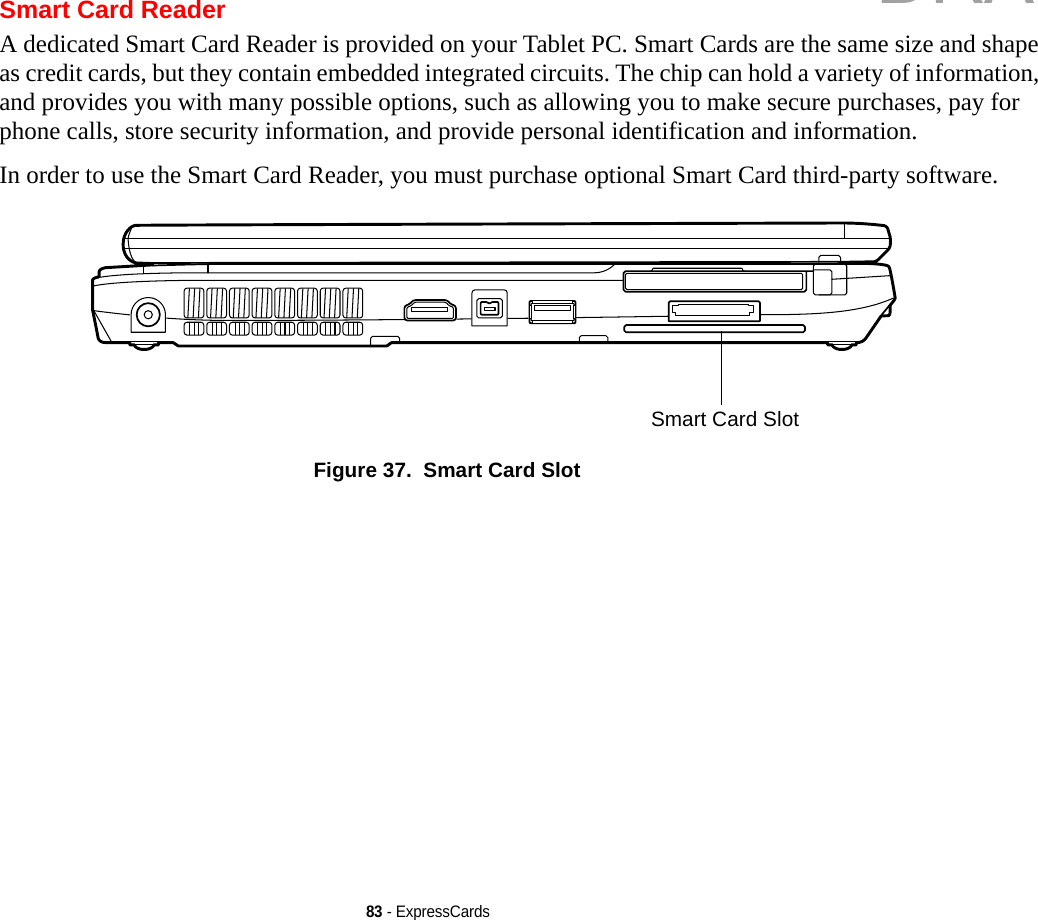
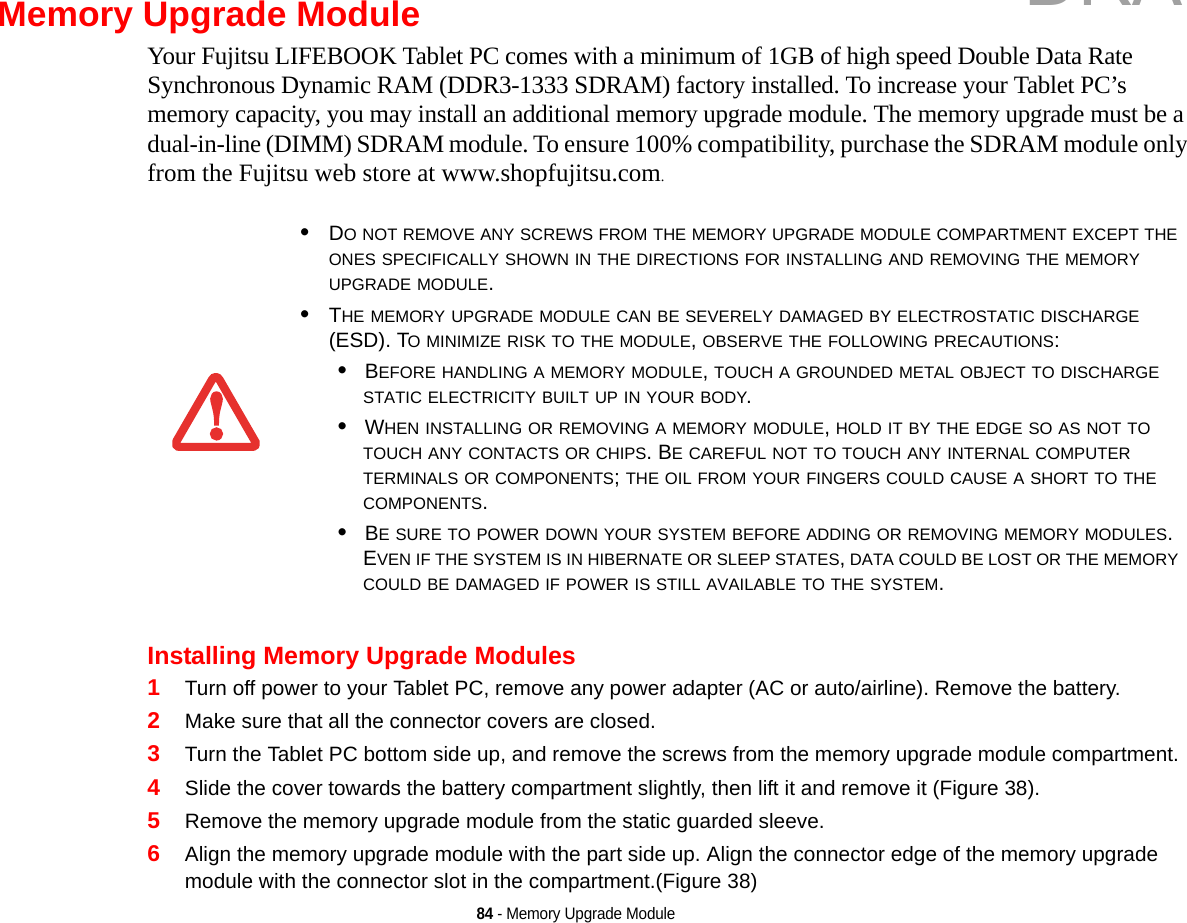
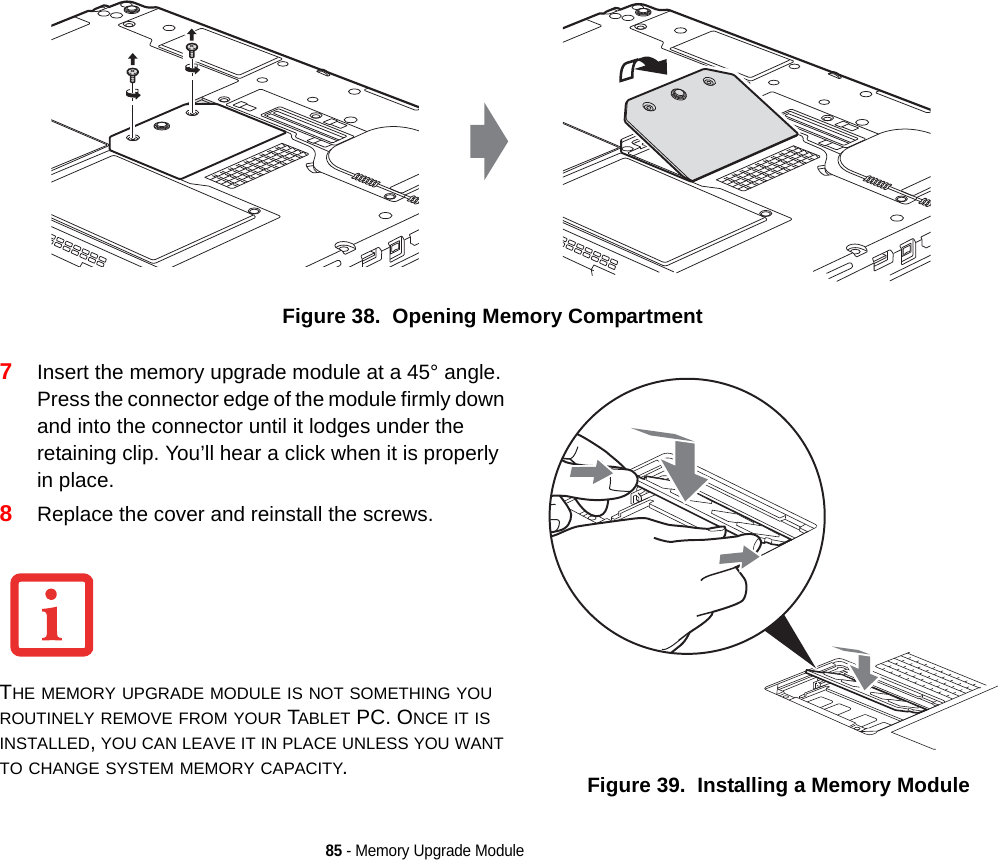
![86 - Memory Upgrade ModuleChecking the Memory CapacityOnce you have changed the system memory capacity by replacing the installed module with a larger one, be sure to check that your Tablet PC has recognized the change.•If you are in Control Panel Category view, check the memory capacity by clicking [Start] -> Control Panel -> System and Security -> System. The amount of memory is displayed next to “Installed Memory - RAM:” •If you are in one of the icon views, check the memory capacity by clicking [Start] -> Control Panel -> System. The amount of memory is displayed next to “Memory - RAM:”Removing a Memory Upgrade Module1Perform steps 1 through 4 of Installing a Memory Upgrade Module.2Pull the clips sideways away from each side of the memory upgrade module at the same time. 3While holding the clips out, remove the module by lifting it up and pulling it away from your Tablet PC. 4Store the memory upgrade module in a static guarded sleeve.5Replace the cover and reinstall the screws.Figure 40. Removing a Memory ModuleDRAFT](https://usermanual.wiki/Fujitsu-Client-Computing/WL0024.Updated-manual/User-Guide-1450965-Page-91.png)
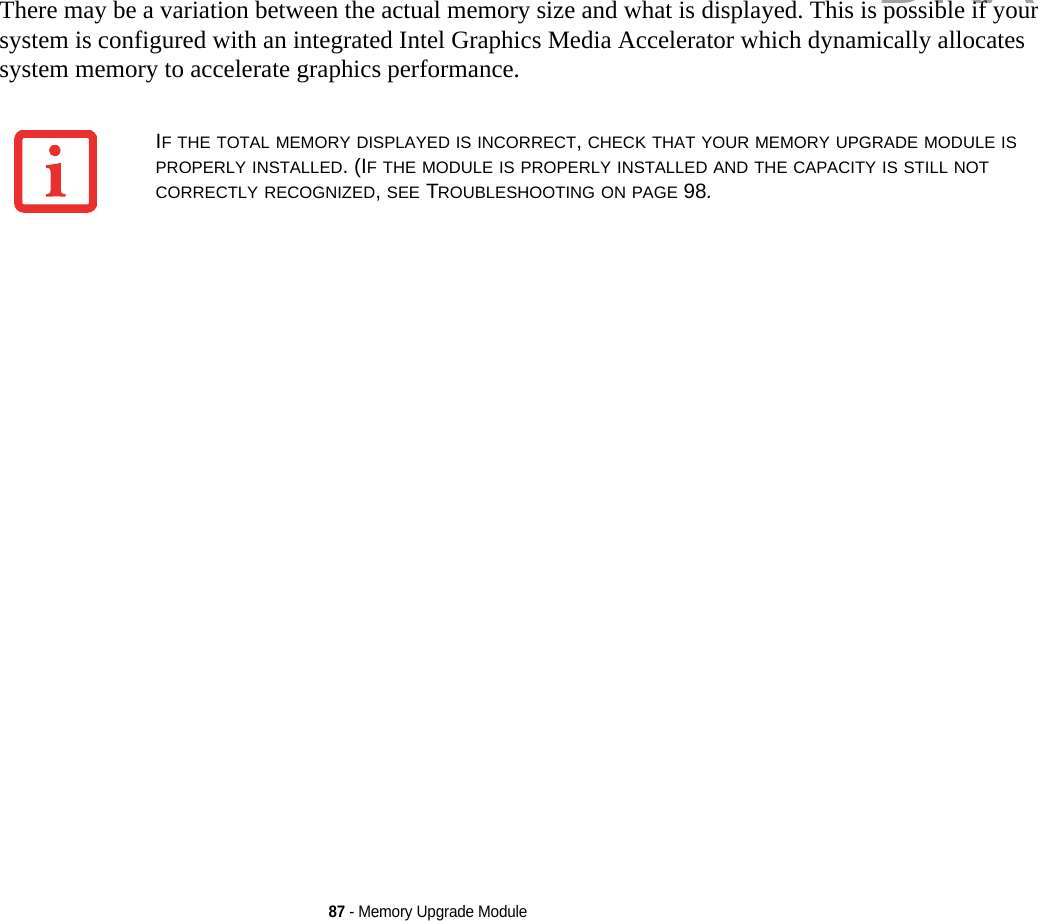
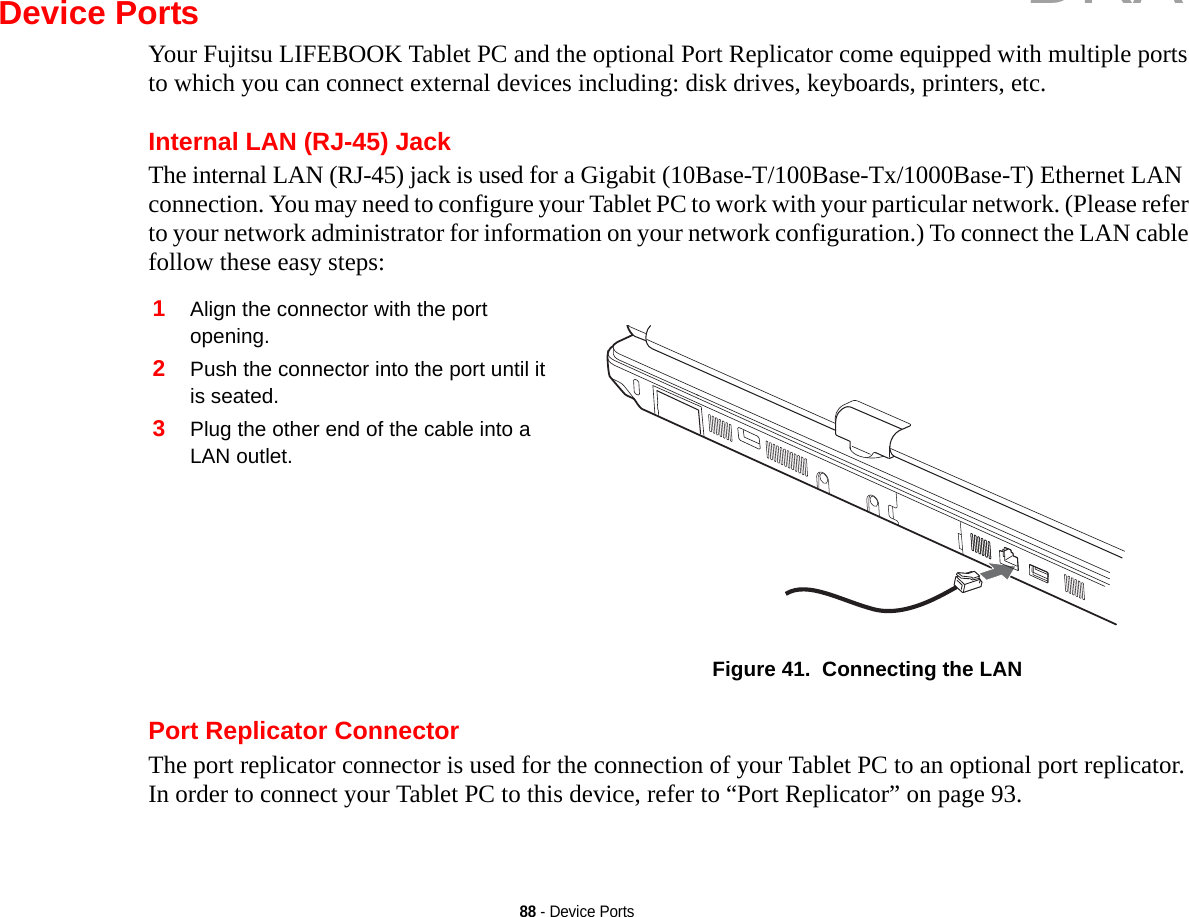
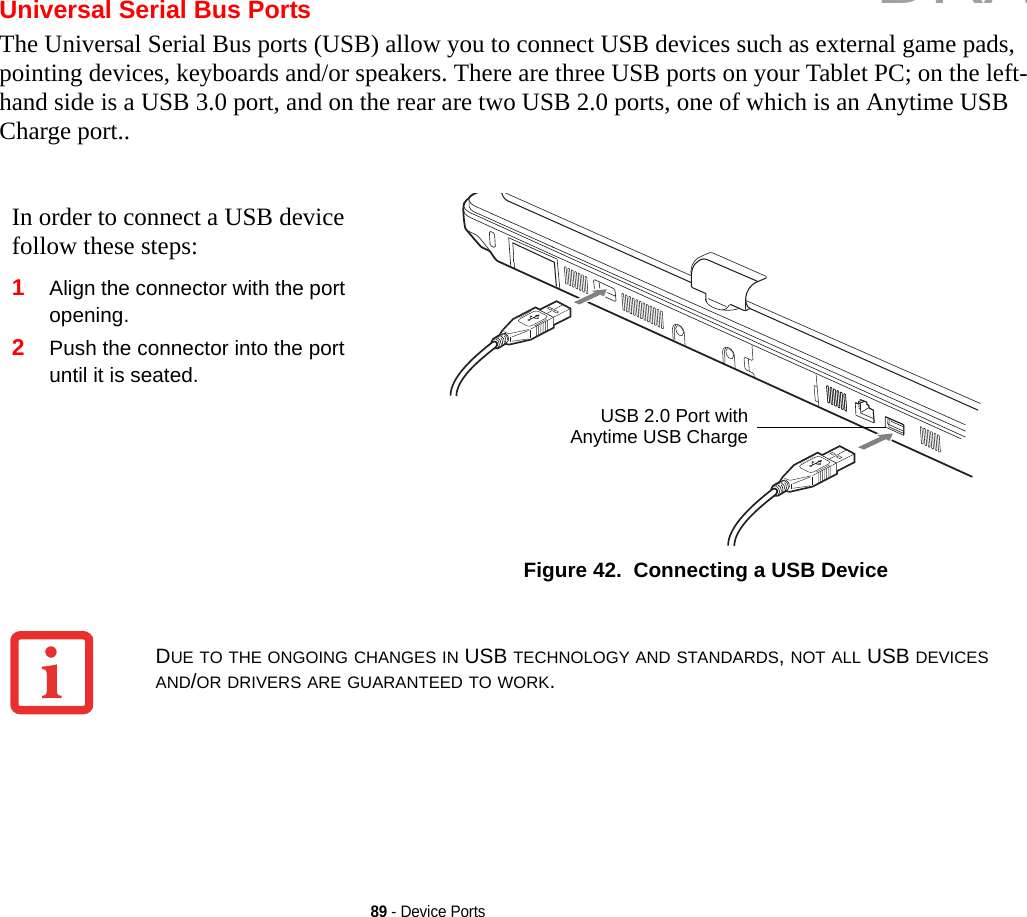
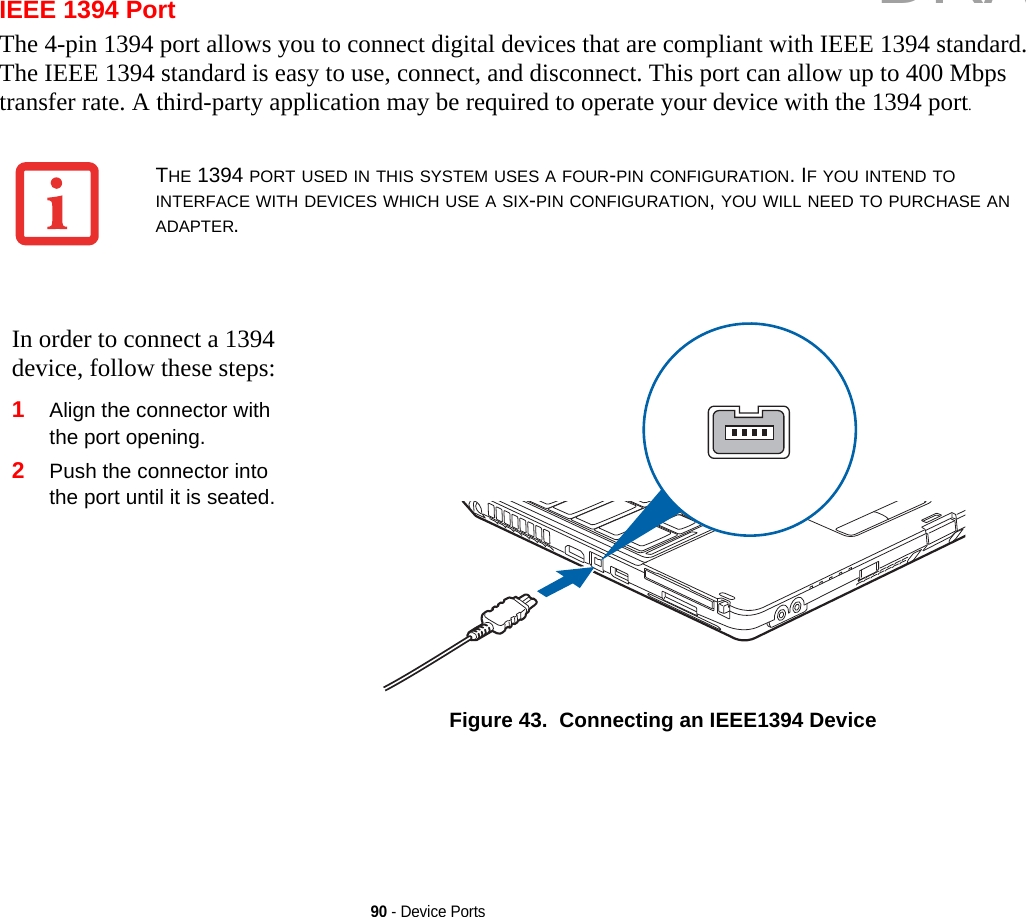
![91 - Device PortsHeadphone JackThe headphone jack allows you to connect headphones or powered external speakers to your Tablet PC. Your headphones or speakers must be equipped with a 1/8” (3.5 mm) stereo mini-plug. In order to connect headphones or speakers follow these easy steps: 1Align the connector with the port opening.2Push the connector into the port until it is seated.Microphone JackThe microphone jack allows you to connect an external microphone. Your microphone must be equipped with a 1/8”(3.5 mm) mono mini-plug in order to fit into the microphone jack of your Tablet PC. In order to connect a microphone follow these easy steps: 1Align the connector with the port opening.2Push the connector into the port until it is seated.External Video PortThe external video port allows you to connect an external monitor or LCD projector. In order to connect an external video device, follow these easy steps: 1Align the connector with the port opening.2Push the connector into the port until it is seated.3Tighten the two hold-down screws, located on each end of the connector. PRESSING THE [FN] + [F10] KEYS ALLOWS YOU TO CHANGE YOUR SELECTION OF WHERE TO SEND YOUR DISPLAY VIDEO. EACH TIME YOU PRESS THE KEY COMBINATION, YOU WILL STEP TO THE NEXT CHOICE, STARTING WITH THE BUILT-IN DISPLAY PANEL ONLY, MOVING TO THE EXTERNAL MONITOR ONLY, FINALLY MOVING TO BOTH THE BUILT-IN DISPLAY PANEL AND AN EXTERNAL MONITOR.DRAFT](https://usermanual.wiki/Fujitsu-Client-Computing/WL0024.Updated-manual/User-Guide-1450965-Page-96.png)
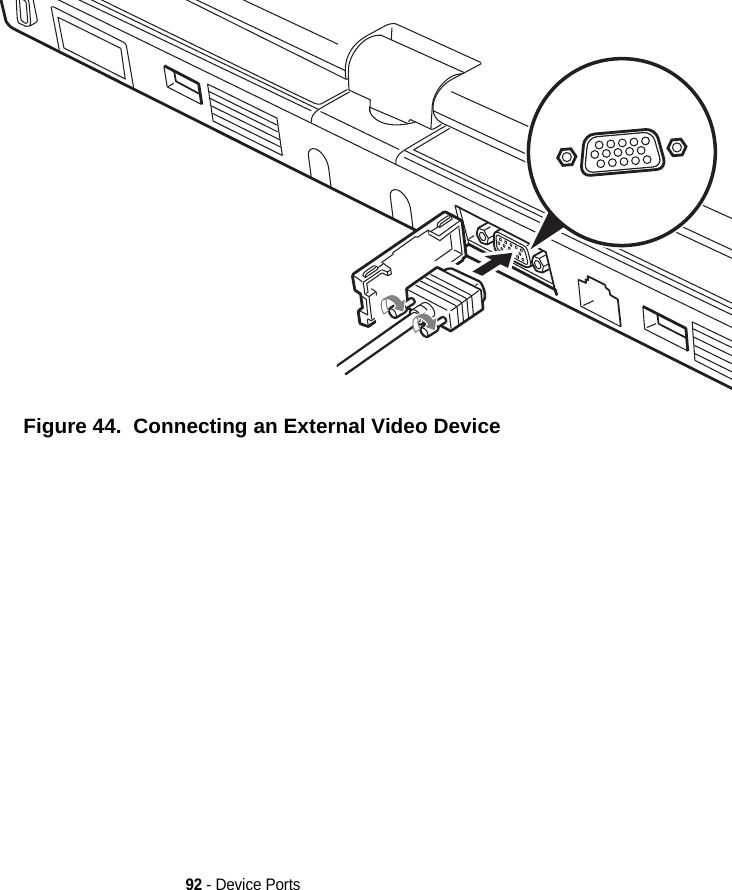
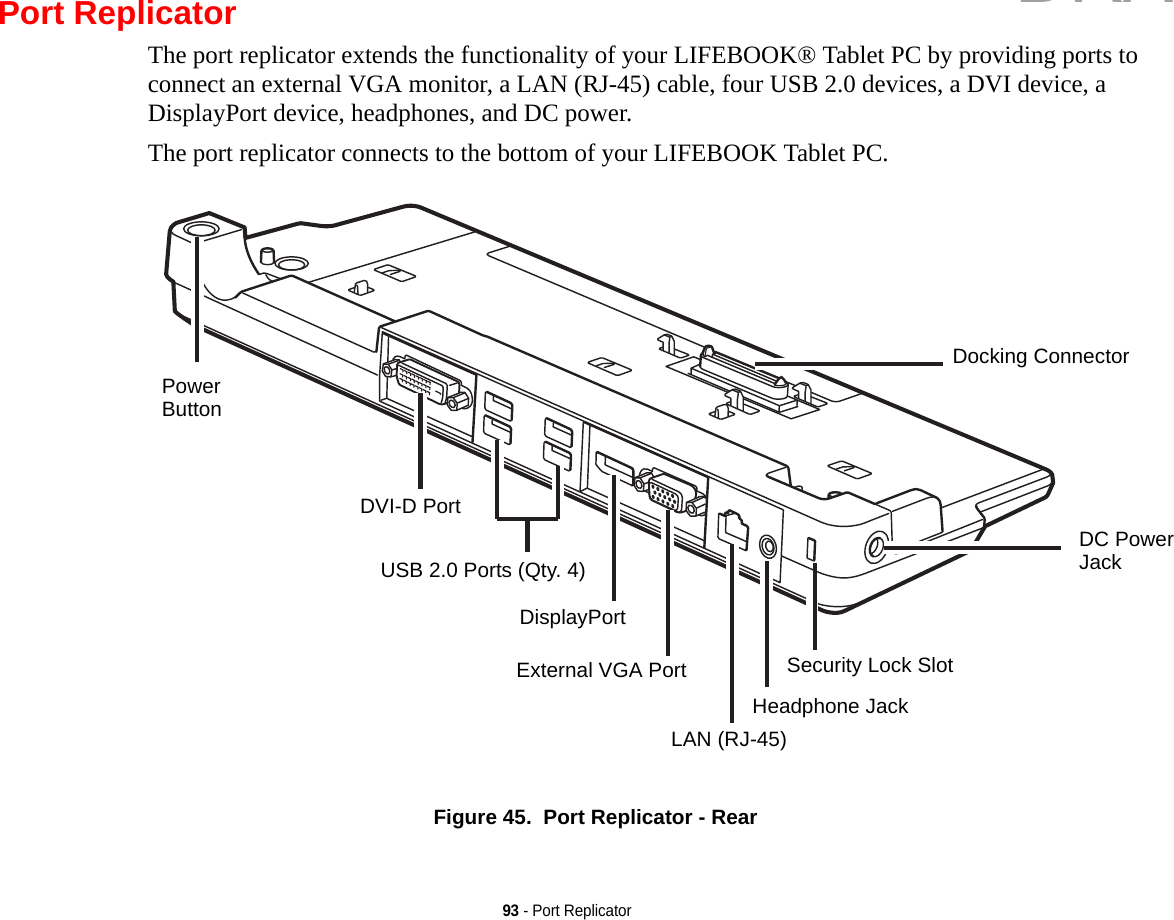
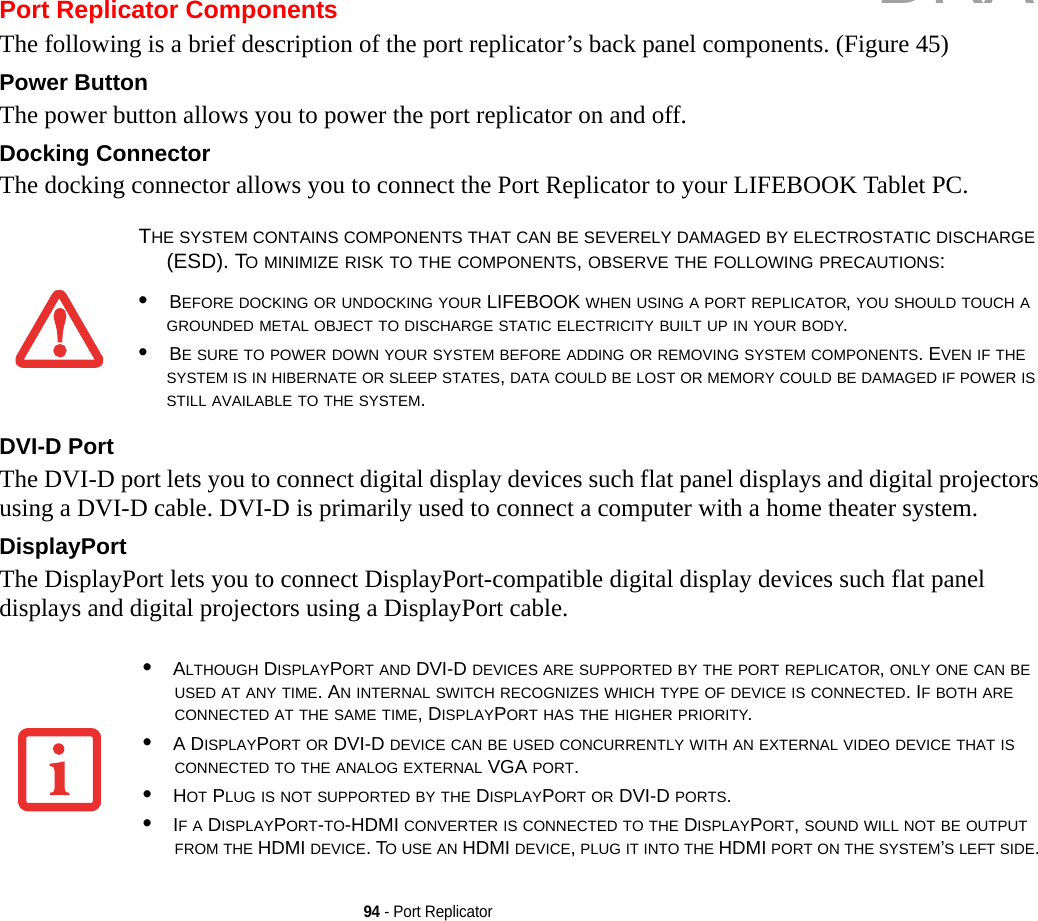
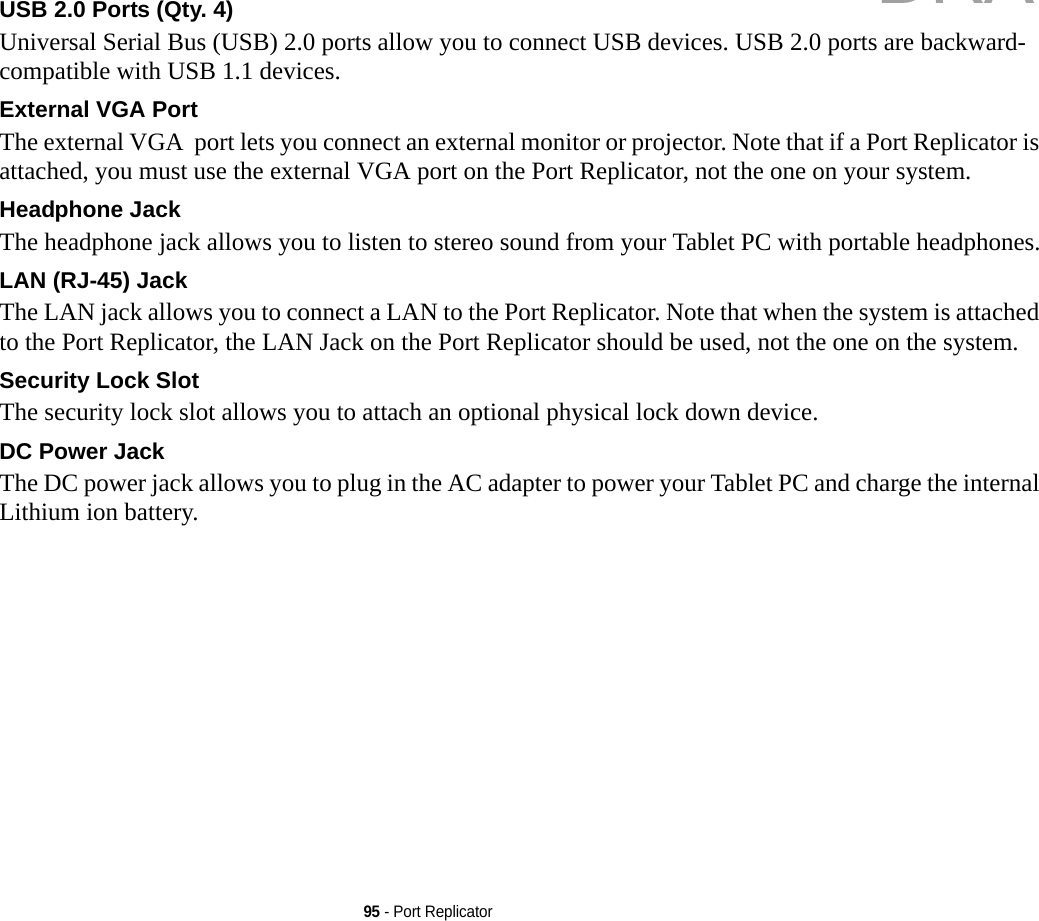
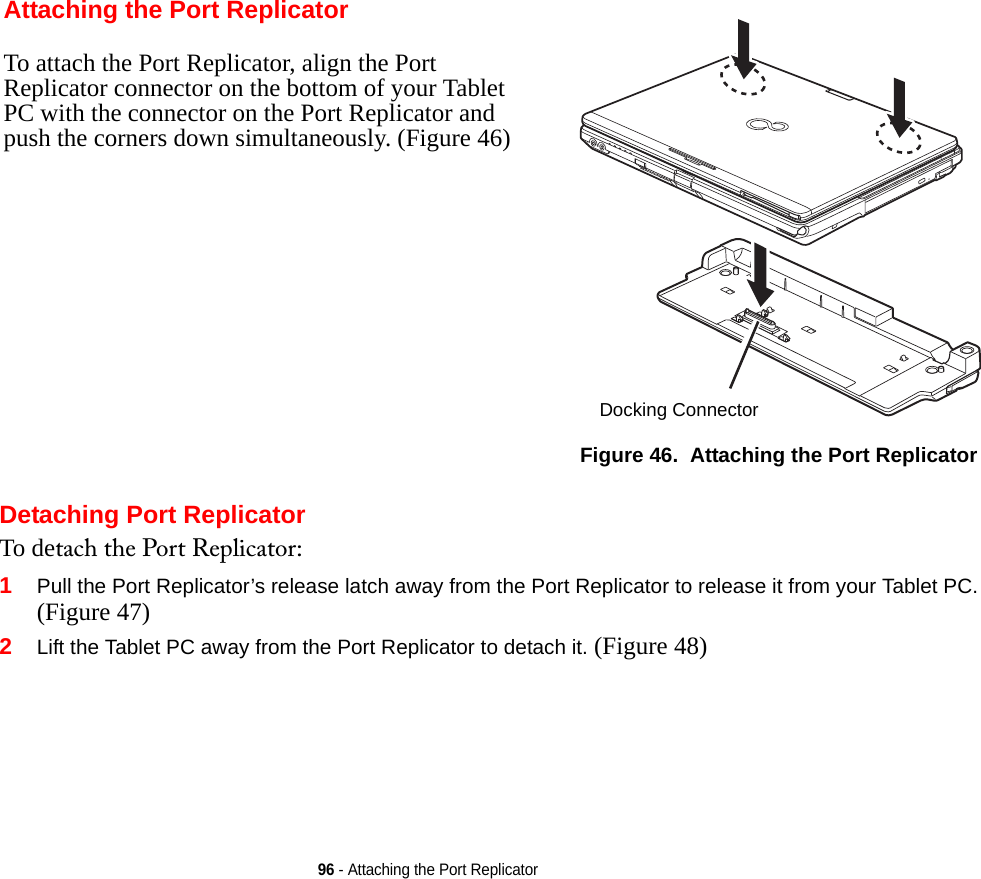
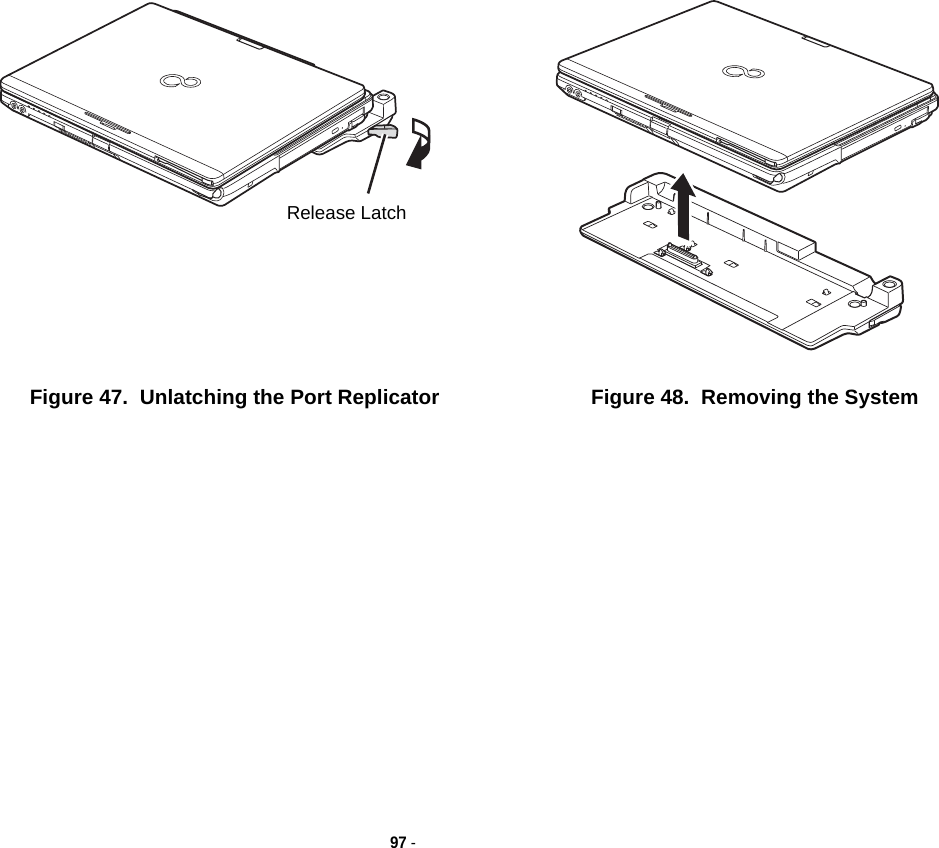
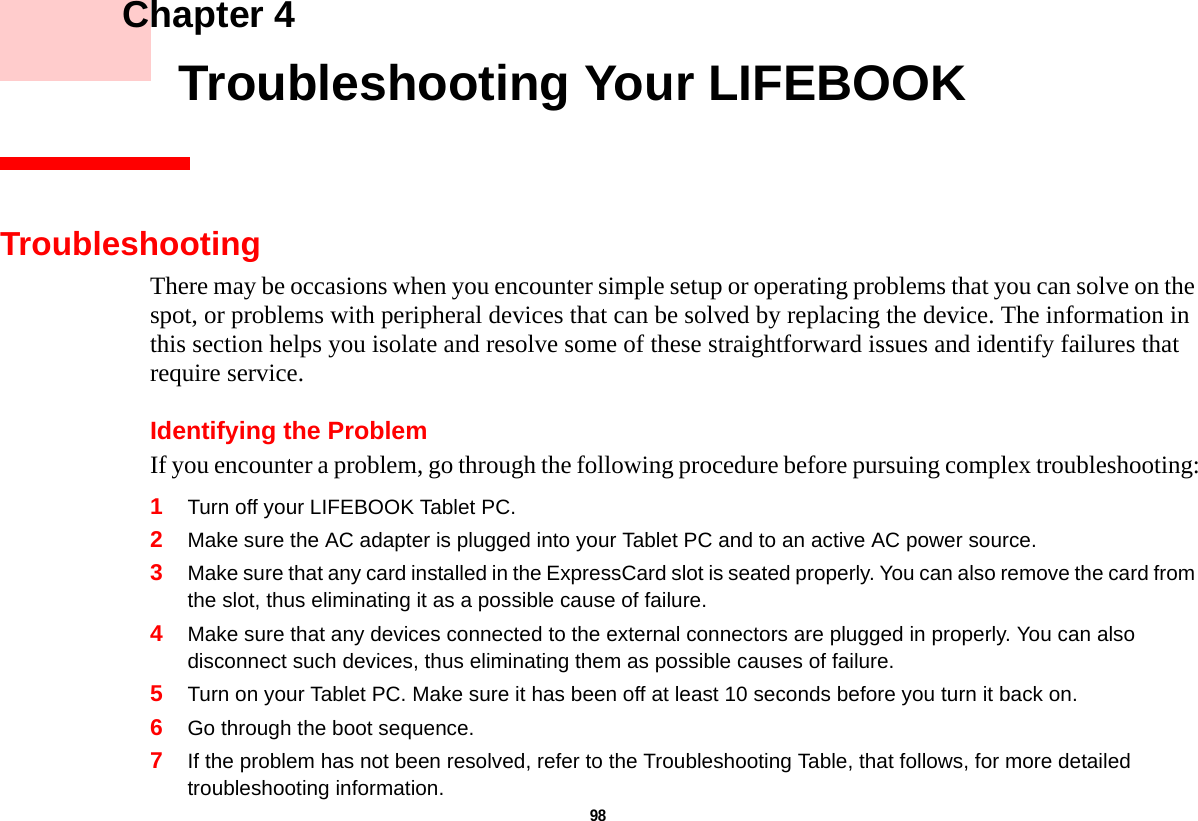
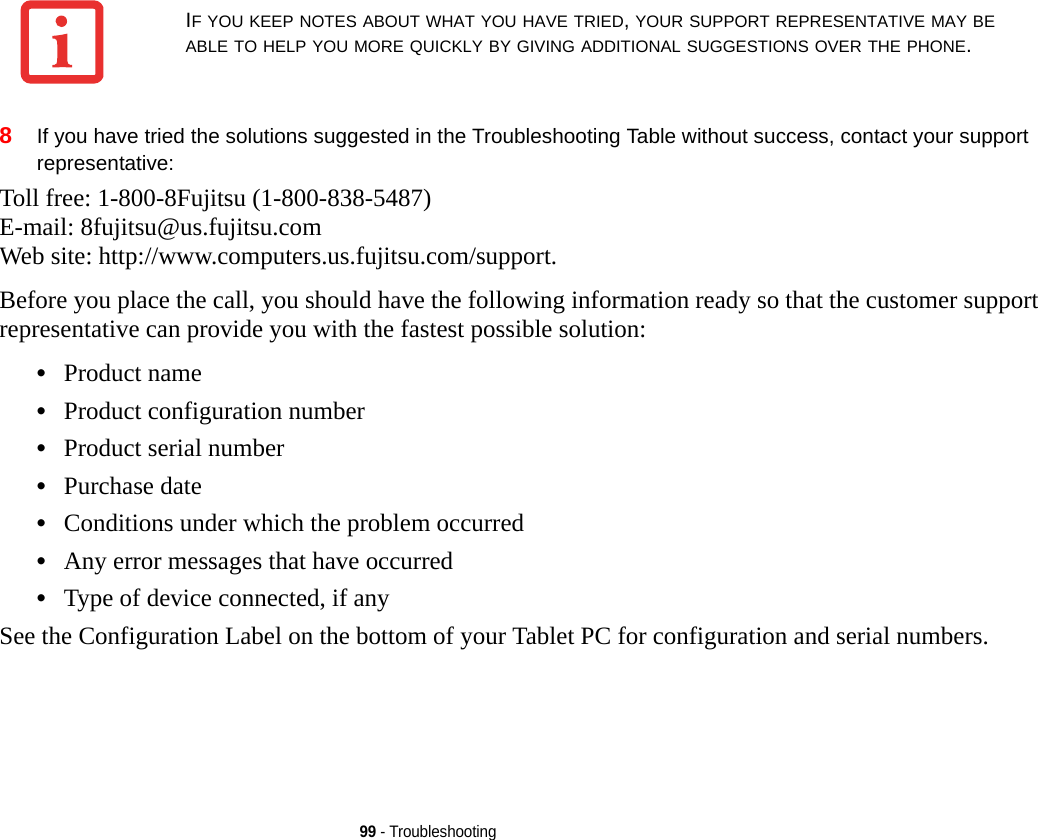
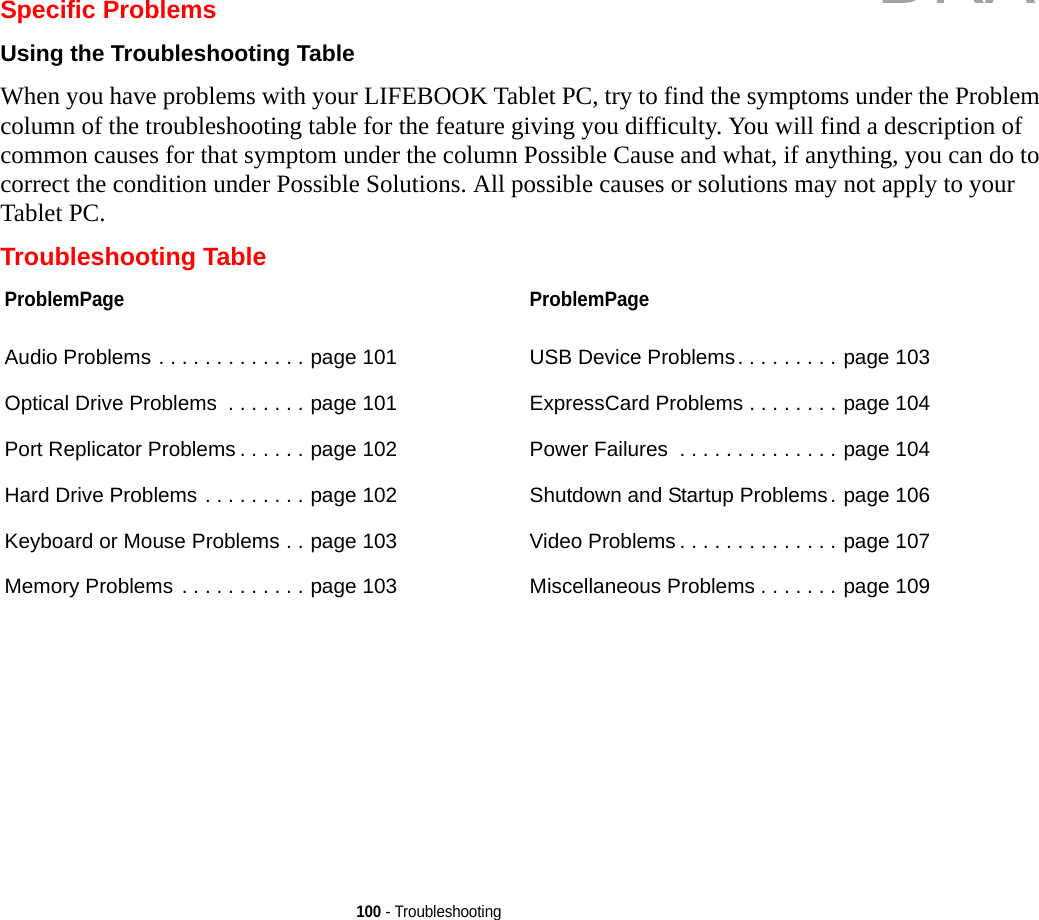
![101 - TroubleshootingProblem Possible Cause Possible SolutionsAudio ProblemsThere is no sound coming from the built-in speaker. The volume is turned too low. Adjust the volume control on your Tablet PC and operating system. Use the [Fn+F9] key combination on your keyboard. Pressing [F9] repeatedly while holding [Fn] will increase the volume of your Tablet PC.The software volume control is set too low. Manually adjusting the volume (i.e., keyboard "hot keys") should dynamically adjust the volume of the operating sys-tem (see above). If that doesn’t work, adjust the sound vol-ume control settings in your software or application.Headphones are plugged into your Tablet PC. Plugging in headphones disables the built-in speakers. Remove the headphones.Software driver is not configured correctly. The audio driver may be installed or reinstalled using the Drivers and Applications CD that came with your Fujitsu LIFEBOOK. Refer to your application and operating system documentation for help.The speakers have been muted using the Volume icon in the system tray.Click the Volume icon in the system tray on the bottom right of the screen. (It looks like a speaker). If the Mute box has a red circle on it, click on it to unselect it. You can also use the [Fn+F3] key combination to toggle the volume on and off. Pressing [F3] while holding [Fn] will toggle the audio mute.Optical Drive Problems LIFEBOOK Tablet PC fails to recognize DVD/CD-RW/CD-ROM’s.The disc is not pushed down onto raised center circle of the drive.Open optical drive tray and re-install the disc properly.Optical drive tray is not latched shut. Push on the front of the optical drive tray until it latches. If that doesn’t work, pull out the modular drive latch to remove the device from the bay, then re-insert the drive until it latched; this ensures that the drive is properly seated. Incorrect DVD Player or player software is installed. Install DVD Player software. (See “Media Player Software” on page 73 for more information.)DRAFT](https://usermanual.wiki/Fujitsu-Client-Computing/WL0024.Updated-manual/User-Guide-1450965-Page-106.png)
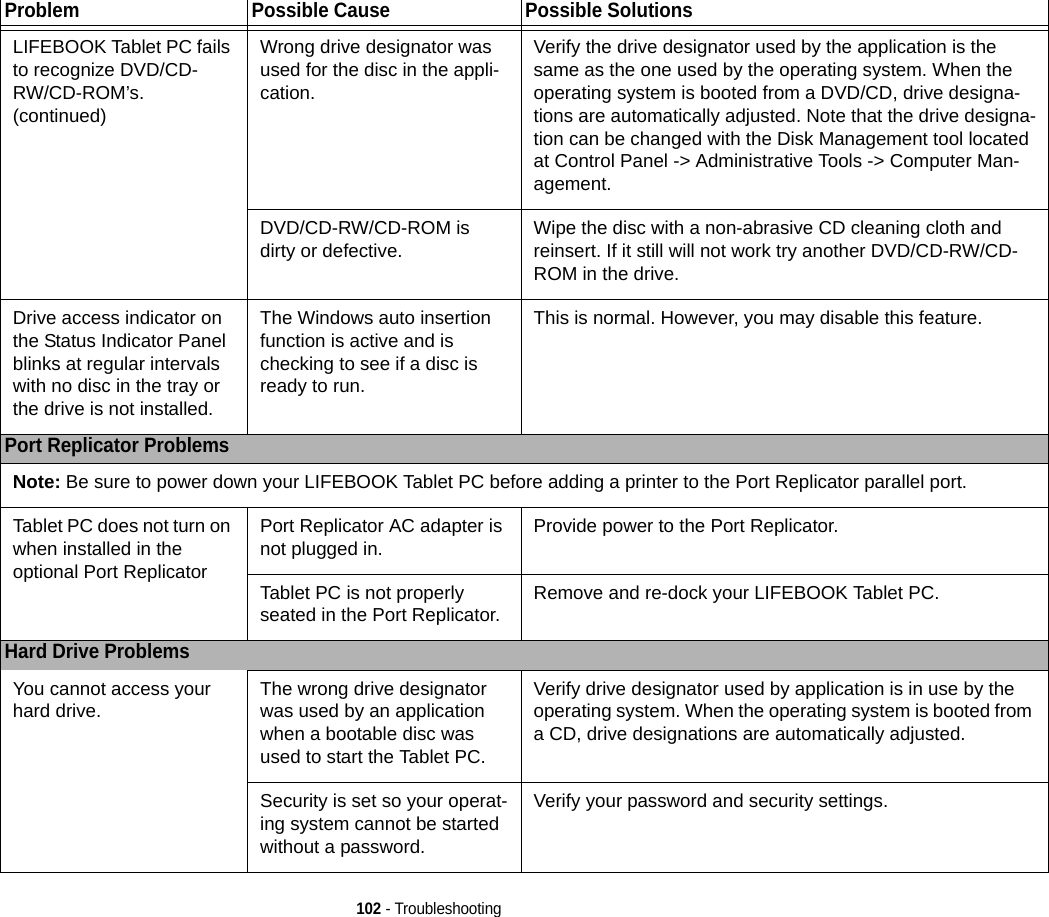
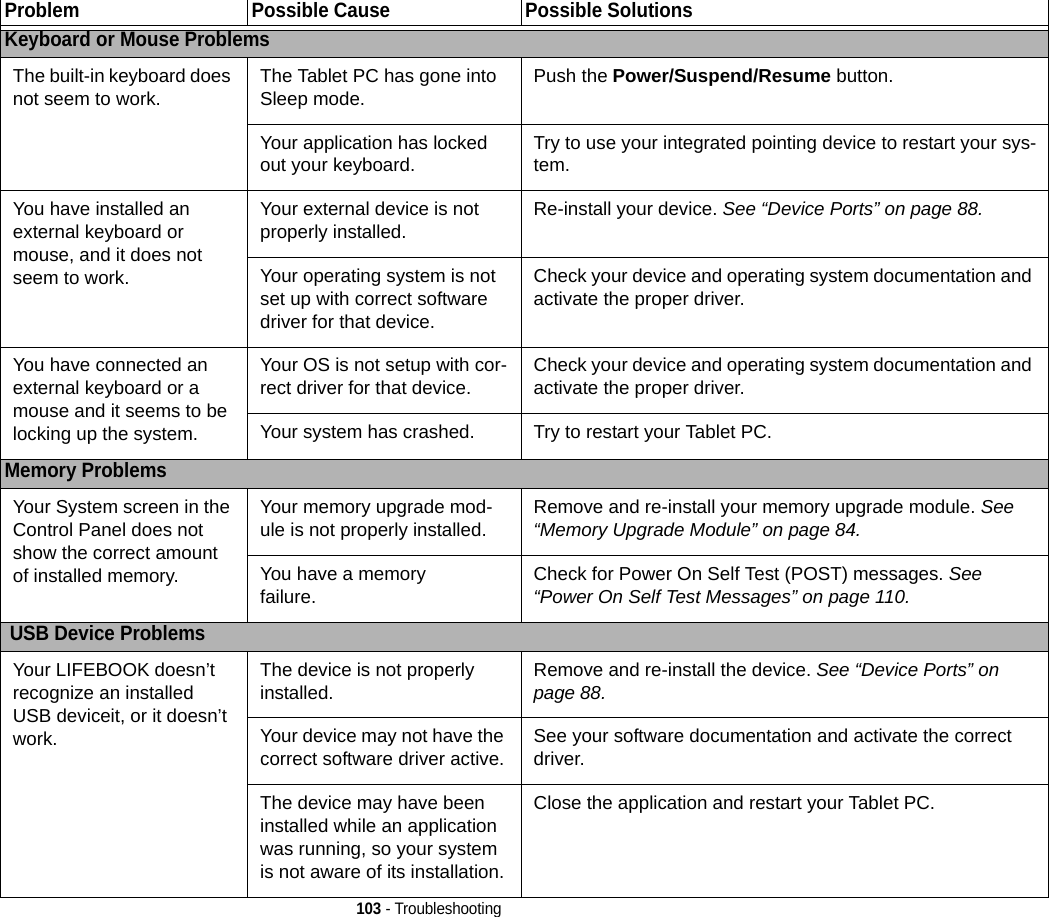
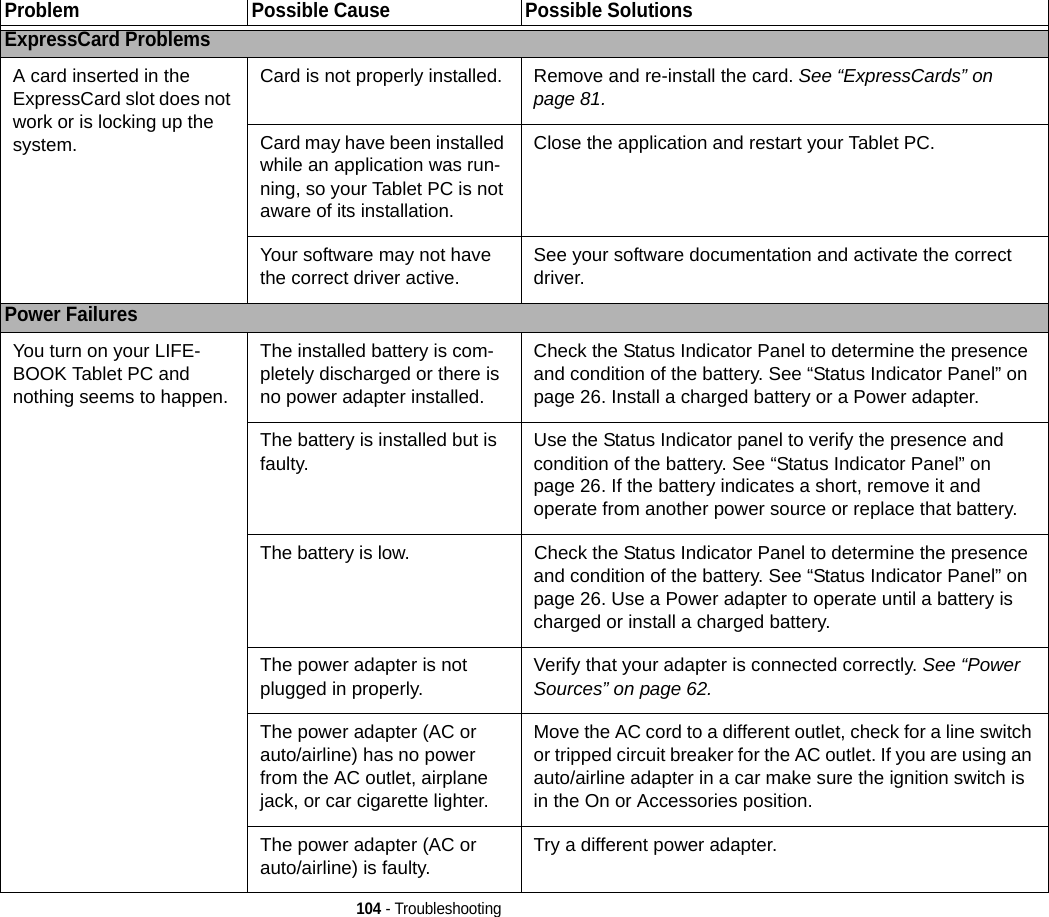
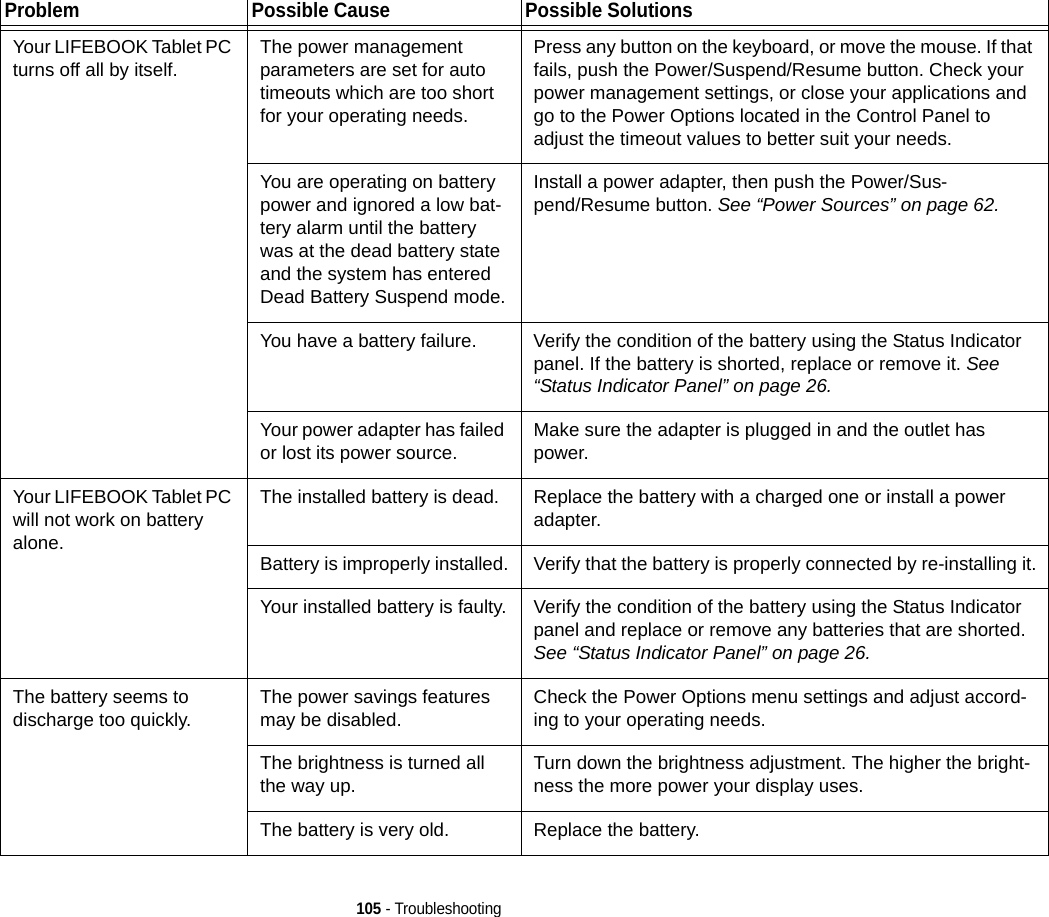
![106 - TroubleshootingThe battery seems to discharge too quickly.(continued)You are running an applica-tion that uses a lot of power due to frequent hard drive access or optical drive access, or use of a Wireless LAN, or Bluetooth device.Use a power adapter for this application when at all possible.The battery has been ex-posed to high temperatures. Replace the battery.The battery is too hot or too cold. Restore the Tablet PC to normal operating temperature. Charging icon on the Status Indicator panel will flash when battery is outside of operating range.Shutdown and Startup ProblemsThe Suspend/Resume button does not work. Suspend/Resume button is disabled. To enable the button, go to the Control Panel -> Power Options Properties and click the Advanced tab. In the Power buttons area, select “Change what the power button does” .There may be application software. conflict Close all applications and try the button again.The system powers up, and displays power on information, but fails to load the operating system.The boot sequence settings of the setup utility are not compatible with your configu-ration.Set the operating source by pressing the [ESC] key while the Fujitsu logo is on screen or use the [F2] key and enter the setup utility and adjust the source settings from the Boot menu. See “BIOS Setup Utility” on page 66.You have a secured system requiring a password to load your operating system.Make sure you have the right password. Enter the setup util-ity and verify the Security settings and modify them as accordingly. See “BIOS Setup Utility” on page 66.Internal hard drive was not detected. Use the BIOS setup utility or Primary Master submenu, located within the Main menu, to try to auto detect the inter-nal hard drive.Problem Possible Cause Possible SolutionsDRAFT](https://usermanual.wiki/Fujitsu-Client-Computing/WL0024.Updated-manual/User-Guide-1450965-Page-111.png)
![107 - TroubleshootingAn error message is dis-played on the screen dur-ing the Boot sequence.Power On Self Test (POST) has detected a problem. See the POST messages to determine the meaning and severity of the problem. Not all messages are errors; some are simply status indicators. See “Power On Self Test Mes-sages” on page 110.Your Tablet PC appears to change setup parameters when you start it.BIOS setup changes were not saved when made and you exited the setup utility.Make sure you select Save Changes And Exit when exiting the BIOS setup utility.The BIOS CMOS hold-up bat-tery has failed. Contact your support representative for repairs. This is not a user serviceable part but has a normal life of 3 to 5 years.Your system display won’t turn on when the system is turned on or has resumed.You have installed the LIFE-BOOK/Security Application panel.Check the Status Indicator Panel for presence of the Security icon. If it is visible, enter your password See “Status Indicator Panel” on page 26.Video ProblemsThe built-in display is blank when you turn on your LIFEBOOK Tablet PC.The Tablet PC is set for an external monitor only. Pressing [F10] while holding down the [Fn] key allows you to change your selection of where to send your display video. Each time you press the keys you will step to the next choice. The choices, in order are: built-in display only, external moni-tor only, both built-in display and external monitor.Display angle and brightness settings are not adequate for your lighting conditions.Move the display and the brightness control until you have adequate visibility. Pressing either the [F6] or [F7] keys while holding down the [Fn] key also allows you to change the brightness level of the display.Power management time-outs are set for short intervals and you didn’t see the display go on and off again.Press a keyboard button or move the mouse to restore oper-ation. If that fails, push the Power/Suspend/Resume button. (The display may be shut off by Sleep mode, Auto Suspend or Video Timeout)The Tablet PC turned on with a series of beeps and the built-in display is blank.Power On Self Test has detected a failurethat doesn’t allow the display to operate.Contact your support representative.Problem Possible Cause Possible SolutionsDRAFT](https://usermanual.wiki/Fujitsu-Client-Computing/WL0024.Updated-manual/User-Guide-1450965-Page-112.png)
![108 - TroubleshootingThe display goes blank by itself after you have been using it.The Tablet PC has gone into Video timeout, Sleep mode, or Save-to-Disk mode because you have not used it for a period of time.Press any keyboard button, or move the mouse to restore operation. If that fails, push the Power/Suspend/Resume but-ton. Check your power management settings, or close your applications and go to the Power Savings menu of the setup utility to adjust the timeout values to better suit your opera-tion needs. See “BIOS Setup Utility” on page 66.The power management time-outs may be set for very short intervals and you failed to notice the display come on and go off again.Press any button on the keyboard, or move the mouse to restore operation. If that fails, push the Power/Sus-pend/Resume button. (The display may be shut off by Sleep Mode, Auto Suspend or Video Timeout)Your display won’t turn on when the system is turned on or when it has resumed.The system may be pass-word-protected. Check the status indicator panel to verify that the Security icon is blinking. If it is blinking, enter your password.The display does not close. A foreign object, such as a paper clip, is stuck between the display and keyboard.Remove all foreign objects from the keyboard.The display has bright or dark spots. If the spots are very tiny and few in number, this is normal for a large LCD display.This is normal; do nothing.If the spots are numerous or large enough to interfere with your operation needs.Display is faulty; contact your support representative.The display is dark when on battery power. The Power Management util-ity default is set on low bright-ness to conserve power.Press [Fn] + [F7] to increase brightness or click the battery gauge, click on More power options, and select Adjust the display brightness.You have connected an external monitor but it does not display anything.Your operating system is not setup with the correct soft-ware driver for that device. Check your device and operating system documentation and activate the proper driver.Problem Possible Cause Possible SolutionsDRAFT](https://usermanual.wiki/Fujitsu-Client-Computing/WL0024.Updated-manual/User-Guide-1450965-Page-113.png)
![109 - TroubleshootingYou have connected an external monitor but it does not display anything.(continued)Your BIOS setup is not set to enable your external monitor. Toggle the video destination by pressing [Fn]+ [F10] together, or check your BIOS setup and enable your external monitor. (See the Video Features submenu, located in the Advanced Menu of the BIOS. See “BIOS Setup Utility” on page 66.Your external monitor is not properly installed. Reinstall your device. See “External Video Port” on page 91.You have connected an external monitor and it does not come on.Your external monitor is not compatible with your LIFE-BOOK Tablet PC.See your monitor documentation and the External Monitor Support portions of the Specifications section. See “Specifi-cations” on page 130.Miscellaneous ProblemsError message is dis-played on the screen dur-ing the operation of an application.Application software often has its own set of error message displays. See your application manual and help displays screens for more information. Not all messages are errors some may simply be status.Problem Possible Cause Possible SolutionsDRAFT](https://usermanual.wiki/Fujitsu-Client-Computing/WL0024.Updated-manual/User-Guide-1450965-Page-114.png)
![110 - TroubleshootingPower On Self Test MessagesThe following is a list of error-and-status messages that the Phoenix BIOS and/or your operating system can generate and an explanation of each message. Error messages are marked with an *. If an error message is displayed that is not in this list, write it down and check the operating system documentation on screen and in the manual. If you can find no reference to the message, contact a support representative.*Invalid NVRAM Data Problem with NVRAM access. In the unlikely case that you see this message you may have a display problem. You can continue operating but should contact your support representative for more information.*Keyboard controller error The keyboard controller test failed. You may have to replace your keyboard or keyboard controller but may be able to use an external keyboard until then. Contact your support representative.*Keyboard not detected Keyboard not working. You may have to replace your keyboard or keyboard controller but may be able to use an external keyboard until then. Contact your support representative.*Operating system not found Operating system cannot be located on either drive A: or drive C: Enter the setup utility and see if both the fixed disk, and drive A: are properly identified and that the boot sequence is set correctly. Unless you have changed your installation greatly, the operating system should be on drive C:. If the setup utility is correctly set, your hard drive may be corrupted.*Press <F1> to resume, <F2> to SETUP Displayed after any recoverable error message. Press [F1] key to Continue or [F2] key to Enter Setup.*Real time clock error - Check date and time settings Real-time clock fails BIOS test. May require board repair. Contact your support representative.*Fan error, system shutdown in 30s. Contact Fujitsu tech support Fan error occurred. Please contact your sales representative.*Fan error occurred during previous boot. Fan error occurred during previous boot. Please contact your sales representative.DRAFT](https://usermanual.wiki/Fujitsu-Client-Computing/WL0024.Updated-manual/User-Guide-1450965-Page-115.png)
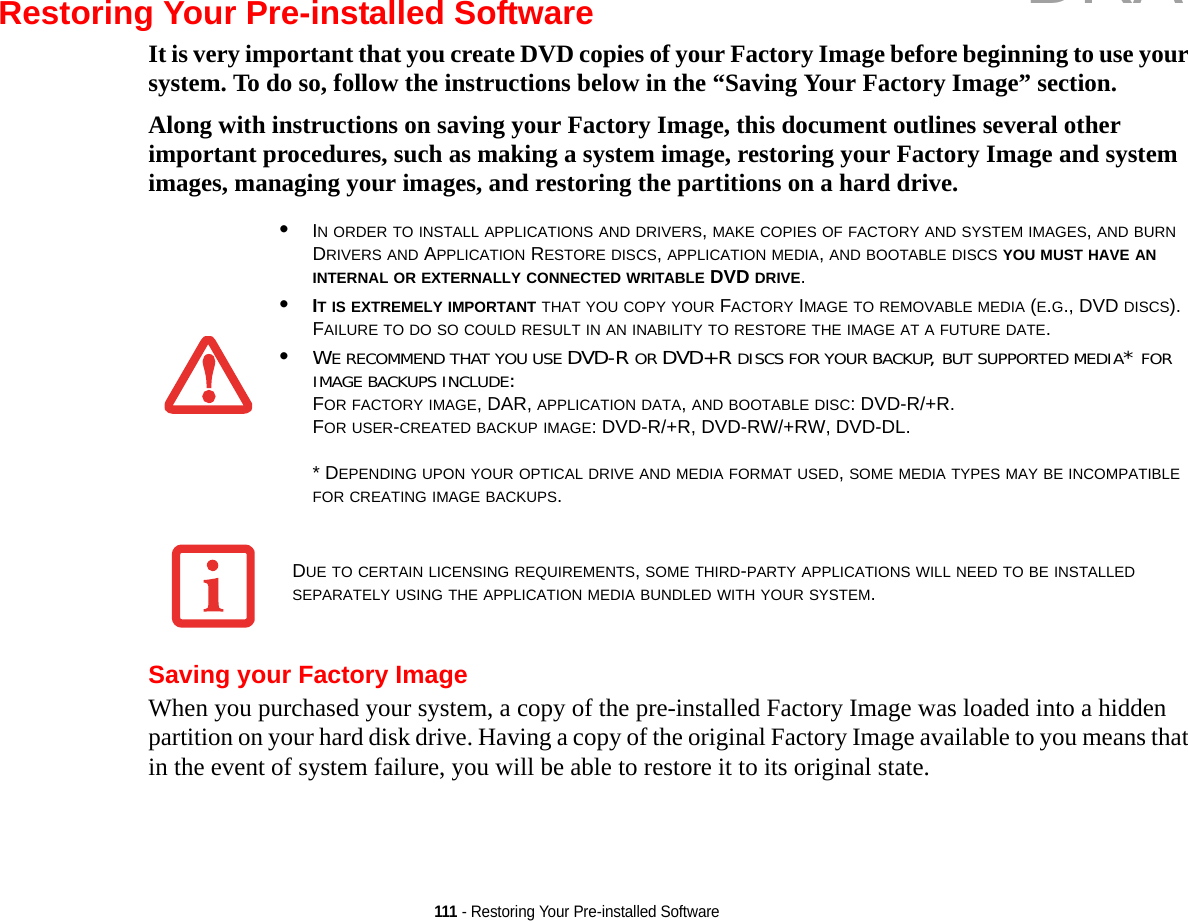
![112 - Restoring Your Pre-installed SoftwareAfter you launch the ClickMe! utility when you first start up your system, you should make a copy of the Factory Image to DVD discs. You will need several blank discs (DVD-R or DVD+R discs are recommended) in order to create the copy. After creating the copy, be sure to label the discs and keep them in a safe place to ensure they do not get damaged.Creating Backup Images of Factory Image, DAR, and DiscsUsing the [Manage/Change] button, you can create backup images of the Factory Image, DAR, Application Disc, or Bootable Disc.1Launch My Recovery from the desktop icon.2Select [Manage/Create] -> [Backup Images] The Backup Images menu displays a list from which you can choose which type of disc you want to burn: Bootable Disc, Drivers and Applications Restore Disc, Application Disc, or Recovery Disc.3Select Recovery Disc, then click [Make DVD]4Confirm that the # box has “2” (Note that in some cases the box may display a larger number for the factory image, depending upon its size.)5The message “Recovery Disc #1. will be created. Enter your comments and number of media on the DVD”. Click [YES] to burn the Factory Image.6While the copy is being made, a “Writing to the media” screen displays a progress bar. When the copy is complete, a dialog will appear informing you of the successful completion of the backup.SOME CONFIGURATIONS OF CERTAIN LIFEBOOK MODELS DO NOT HAVE APPLICATIONS LOADED ON THE HARD DRIVE; RATHER, THEY ARE LOADED ON THE DAR DISC. PLEASE TAKE THAT INTO ACCOUNT WHEN READING THE FOLLOWING PROCEDURES.IN THE FOLLOWING STEP, DO NOT USE THE SYSTEM UNTIL THE COPY IS COMPLETE.DRAFT](https://usermanual.wiki/Fujitsu-Client-Computing/WL0024.Updated-manual/User-Guide-1450965-Page-117.png)
![113 - Restoring Your Pre-installed Software7Repeat the process for the remaining three images on disc (Bootable Disc, Drivers and Applications Restore Disc, and Application Disc). The number of images available may vary depending on your system model; some models do not have the applications loaded on the hard drive.Recovering Your Factory ImageIn the event you need to restore your original Factory Image, perform the following steps. Note that there may be some third-party applications that need to be installed from the application media bundled with your system.In order to recover your Factory Image, perform the steps outlined in “Running Recovery and Utility from hard disk” on page 3. Backing Up a System Image User-Configured System Backups: On your desktop, there is a [MyRecovery] icon that allows you to make backups of your current system image either to another location on your hard drive or on removable media. A system image is the configuration of your C: drive at a particular point of time. You may want to make system image backups occasionally in order to have points to which you can return without having to go all the way back to the Factory Image.By default, system images are saved in the D: drive in the MyRecovery folder. You can also elect to save the image to an external hard drive.1Click the [MyRecovery] icon on your desktop.2Click the [Backup] button on the MyRecovery screen.3On the next screen that appears, you can enter up to 200 characters of information about the backup file. This information will help you to identify the image at a later date.4Click the [OK] button and the system will reboot.ALL USER-CREATED DATA WILL BE DELETED FROM YOUR SYSTEM WHEN THE FACTORY IMAGE IS RESTORED.My RecoveryDRAFT](https://usermanual.wiki/Fujitsu-Client-Computing/WL0024.Updated-manual/User-Guide-1450965-Page-118.png)
![114 - Restoring Your Pre-installed Software5After rebooting, the “Creating of the backup image” window appears, in which you can either click [Create the image on D drive] or [Select the drive] if you want to save to an external hard disk drive.6An image appears showing you graphically how the image will be stored. Click the [Next] button.7Click [Execute] to start the backup. DRAFT](https://usermanual.wiki/Fujitsu-Client-Computing/WL0024.Updated-manual/User-Guide-1450965-Page-119.png)
![115 - Restoring Your Pre-installed SoftwareManaging Your Backup ImagesWith the MyRecovery tool you can also make copies of backup images, archive them on DVD, or delete them from your hard drive.1To begin, click the [MyRecovery] icon on your desktop.2Click the [Manage/Create] button in the MyRecovery window.3When the MyRecovery Manager window appears, click [Manage Backup Images].4In the next window, a list of your backup images appears. Below the list are three buttons allowing you to [Make DVD], [Copy], or [Delete] your backup images.5Select an image title from the list, then click the action button you would like to perform.6Note that you need to have an external disk drive connected for the [Copy] button to be enabled. If you elect to copy the image, you will be prompted to enter the destination. If you are ready to copy, click [OK] to proceed. A progress screen appears while the backup copy is being made.7Note that if you copy an image to an external hard drive, both the original and the copy will appear in the [Backup Images] window with identical names, dates, and file sizes, but with the different drive letter to distinguish them. Before you select [Make DVD], be sure you have a recordable DVD drive connected and blank DVDs available.Using the Recovery and Utility ToolsThe Recovery and Utility tools consist of a variety of tools that will help you recover your Factory Image, recover system images, and delete the data from your hard disk.Methods for accessing the utilities Recovery and Utility Tools are preinstalled in a hidden partition by the factory, or they can be accessed by using the bootable disc. Please note that you can delete Recovery and Utility tools from your hard disk drive if you modify the partitions. In this case you will not be able to use the hidden partition for booting to Recovery and Utility Tools, but you will still be able to boot from the disc.Determining whether Recovery and Utility is pre-loaded 1Turn on or reboot your system. When the Fujitsu logo appears, press [F12] key. 2From the Boot Menu that appears, check whether the <Recovery and Utility> option is present. If it is not present, it means that the utility must be used from the disc. Proceed to “Running Recovery and Utility from the Bootable Disc” if <Recovery and Utility> is unavailable.DRAFT](https://usermanual.wiki/Fujitsu-Client-Computing/WL0024.Updated-manual/User-Guide-1450965-Page-120.png)
![116 - Restoring Your Pre-installed Software3You can also use the SecureCore menu to determine whether the utility is pre-loaded by powering on your system then pressing the [Enter] key when the Fujitsu logo appears on the screen. The SecureCore Menu will appear and the Recovery and Utility option will appear in the menu.Running Recovery and Utility from hard disk 1Turn on or reboot your system. When the Fujitsu logo appears, press [F12] key. 2Cursor down to <Recovery and Utility> and press the [Enter] key.3While the files are being loaded from the disc, a progress bar will appear at the bottom of the screen.4When the System Recovery Options dialog opens, select a new keyboard layout, if necessary, then click [Next].5When the Operating System dialog appears, select “Use recovery tools...”, then click [Next]. 6If necessary, enter your password, then click [OK].7When System Recovery Options window appears, click on Recovery and Utility.8The Recovery and Utility screen appears on the screen with three tabs: Diagnostics, Recovery and Utility. Please note that Diagnostics tab is not supported on certain LifeBook/Stylistic models when running Recovery and Utility from the hard disk. In order to restore the operating system, please use the middle icon “Restoring the Factory Image (only C:\drive)” under the Recovery tab. Running Recovery and Utility from the Bootable disc To verify/change boot-up priority (rather than booting-up from a hard drive or external floppy drive), perform the following steps:1Power on your system. When the Fujitsu logo appears on the screen. press the [Enter] key or click on the left mouse or touchpad button; the SecureCore™ Menu will appear. 2Select the Boot Menu from the SecureCore Menu.3Highlight the CD/DVD option.4Insert the bootable disc into the drive tray.5Click [OK]. While the files are being loaded from the disc, a progress bar will appear at the bottom of the screen.THE BOOTABLE DISC CAN ONLY BE USED WITH THE SYSTEM WITH WHICH IT WAS PURCHASED.DRAFT](https://usermanual.wiki/Fujitsu-Client-Computing/WL0024.Updated-manual/User-Guide-1450965-Page-121.png)
![117 - Restoring Your Pre-installed Software6When the System Recovery Options dialog opens, select a new keyboard layout, if necessary, then click [Next].7When the Operating System dialog appears, click [Next]. 8If necessary, enter your password, then click [OK].9When System Recovery Options window appears, click on Recovery and Utility.10 When the Recovery and Utility screen appears, three tabs will be present: Diagnostics, Recovery, and Utility.Recovery and Utility tabs Diagnostics tab: The Diagnostics tool is designed for use by IT professionals. It is not likely you will need to use this tool. When you select devices from the Diagnosis window then click [Execute], several tests are performed on the selected components.Recovery tab: The Recovery tab contains three tools: Recovering User-Configured System Backups, Restoring the Factory Image (only C: drive), and Restoring the Factory Image (full hard drive recovery). You can use these tools to restore the Factory Image from the hidden partition, restore backup image(s) you created or images stored on DVD discs, and perform a full hard drive recovery. Refer to instructions above for details on how to create Factory Image Recovery DVDs, user backup DVDs and system image backup. Utility tab: The Utility tab contains three tools: Hard Disk Data Delete, Restore Recovery and Utility, and Windows Complete PC Restore.•The Hard Disk Data Delete utility is used to delete all data on the hard disk and prevent the data from being reused. NOTE: Do not use the Hard Disk Data Delete utility unless you are absolutely certain that you want to erase your entire hard disk, including all partitions.•Restore Recovery and Utility allows you to restore the first hidden partition.•Windows Complete PC Restore utility allows you to restore an image created with Windows Backup and Restore Center. Windows Complete PC Restore will overwrite the data on your hard disk drive.DRAFT](https://usermanual.wiki/Fujitsu-Client-Computing/WL0024.Updated-manual/User-Guide-1450965-Page-122.png)
![118 - Restoring Your Pre-installed SoftwareRecovering your Factory Image using Recovery and Utility(new or non-bootable hard drive)If you have installed a new hard drive or your hard drive is not bootable, perform the following steps. Note that first you will need to create new partitions on the hard drive, then restore the Factory Image:1Power on your system. When the Fujitsu logo appears on the screen. press the [Enter] key or click on the left mouse or touchpad button; the SecureCore™ Menu will appear. 2Select the Boot Menu from the SecureCore Menu.3Highlight the CD/DVD option.4Insert the bootable disc in your DVD drive, then click [OK].5When System Recovery Options window appears, click on <Recovery and Utility>.6When the System Recovery Options dialog opens, select a new keyboard layout, if necessary, then click [Next].7When the Operating System dialog appears, click [Next]. 8If necessary, enter your password, then click [OK].9When System Recovery Options window appears, click on <Recovery and Utility>.10 Click the Recovery tab in the Recovery and Utility window, then click <Restoring the Factory Image (full hard drive recovery> icon.11 Click [Execute].12 Read the precautions, then select “I Agree”. 13 Click [Next], then click [Next] to start the recovery process. 14 “1. Recovery Disc Check” will be in bold and the rest will be grayed out. Follow the instructions and “Insert the Recovery Disc #1”. In some cases, you may prompted to “Insert the Recovery Disc #2”, depending upon the size of the Recovery Image15 Click [Next] to begin the check. Click [Next] again when the check is complete.16 “2. Initializing hard disk drive” will be in bold with the message “Please insert the Bootable Disc into your optical drive”. Insert the bootable disc. Click [Next] to proceed. A dialog box appears, with a checking disc message.17 “Warning All DATA on the Hard Disk will be completely erased!!!” will appear. Select [OK]. The partition creation process will begin.DRAFT](https://usermanual.wiki/Fujitsu-Client-Computing/WL0024.Updated-manual/User-Guide-1450965-Page-123.png)
![119 - Restoring Your Pre-installed Software18 “3. Restoring Factory Image to hidden partition” will be in bold with the message “Please insert the Recovery Disk#1 into the optical drive”. Click [Next] to proceed.19 After completion, the tool will automatically go back to "3.Restoring Factory Image to hidden partition" but will include the note "Please insert your Application Disc(s) starting with #1, then click [OK]. After installation of each disc, insert the next and continue until all have been installed. If you don't have your Application Disc(s) or you have inserted all your application discs. Please click [Cancel] to continue." At this point, you can either:•Insert Application Disc(s) to restore back to hidden partition, or, •Click [Cancel] to skip restoring Application disc(s) and continue with restore.20 If you select to insert Application Disc, after copying of application disc(s) to hidden partition is completed, the message will appear again. Repeat inserting application disc(s) until all discs have been copied, then click [Cancel] to continue with Restore.21 After clicking [Cancel], a confirmation message will appear "If you want to skip copying or copy has been finished, click [OK]. Click [Cancel] to return to Restoring Factory Image to hidden partition." 22 Click [OK] and Restoring Factory Image will begin.23 When restoration is complete, you will see the message “Restoration has been completed. Click [OK] to reboot the computer.” Click [OK].Automatically Downloading Driver UpdatesYour system has a convenient tool called the Fujitsu Driver Update (FDU) utility. With FDU, you can choose to automatically or manually go to the Fujitsu site to check for new updates for your system.The FDU icon should appear in the system tray at the bottom right of your screen (roll the cursor over the icons to find the correct one). If the icon does not appear in the system tray, go to [Start] -> All Programs, and click on Fujitsu Driver Update; this will create the icon automatically.To invoke the FDU menu, right-click on the FDU icon. The menu contains the following items:DRAFT](https://usermanual.wiki/Fujitsu-Client-Computing/WL0024.Updated-manual/User-Guide-1450965-Page-124.png)
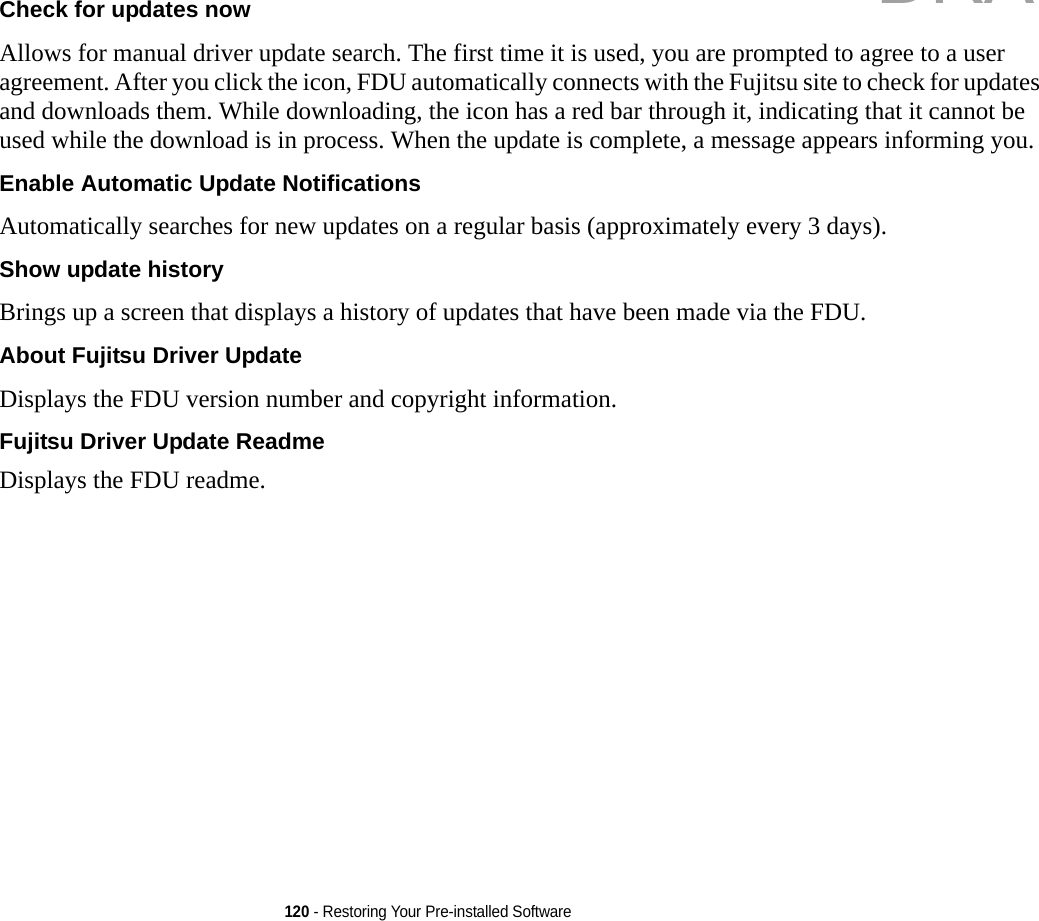
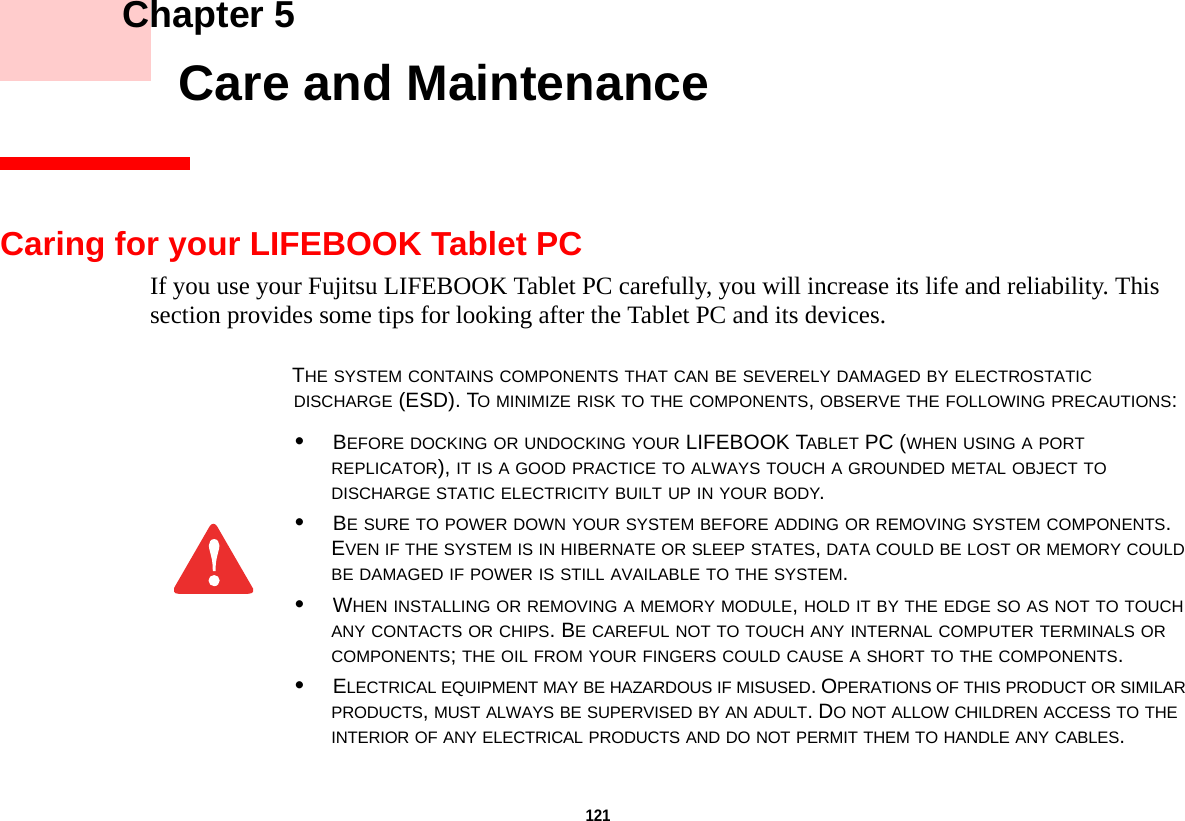
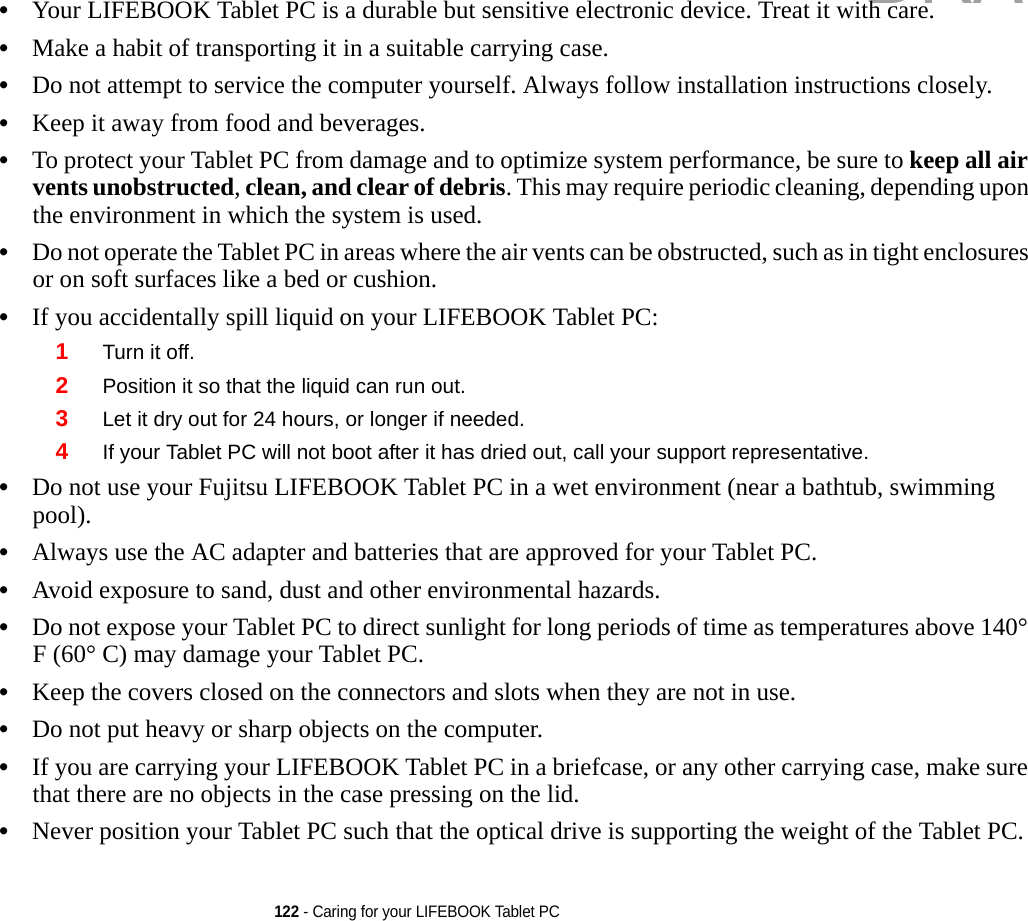
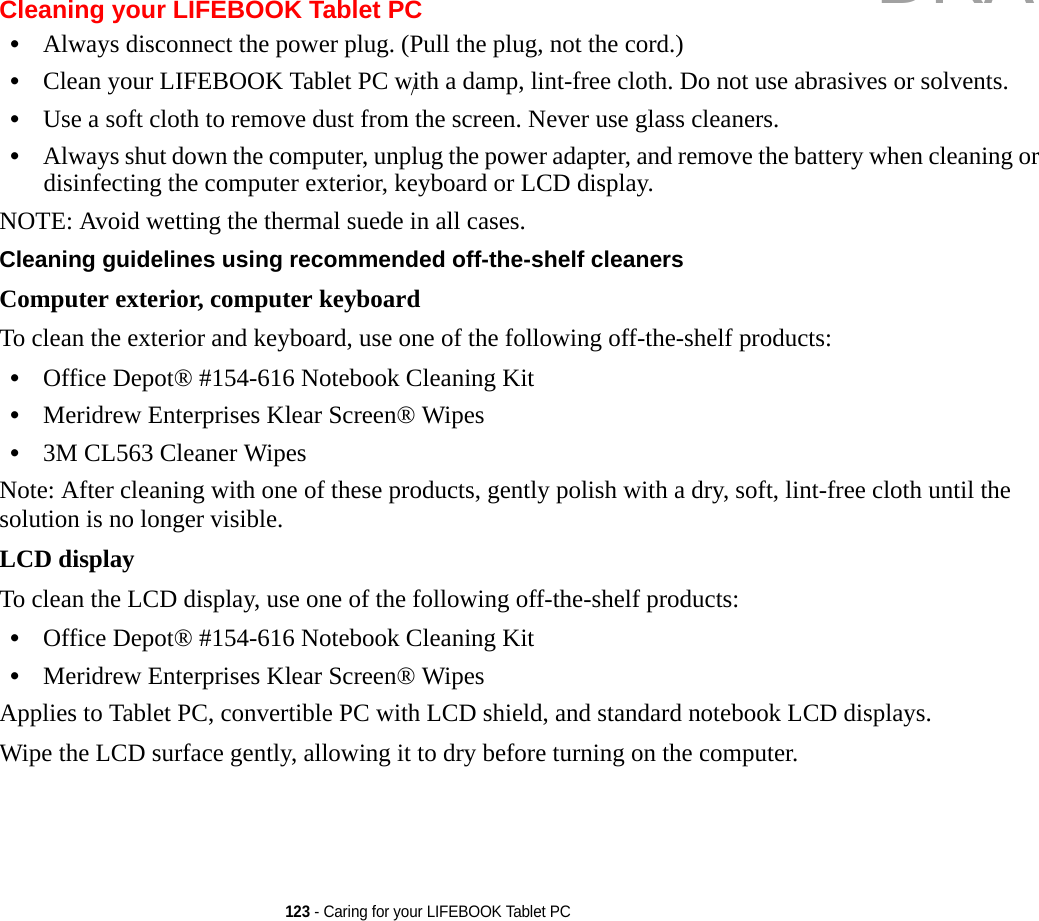
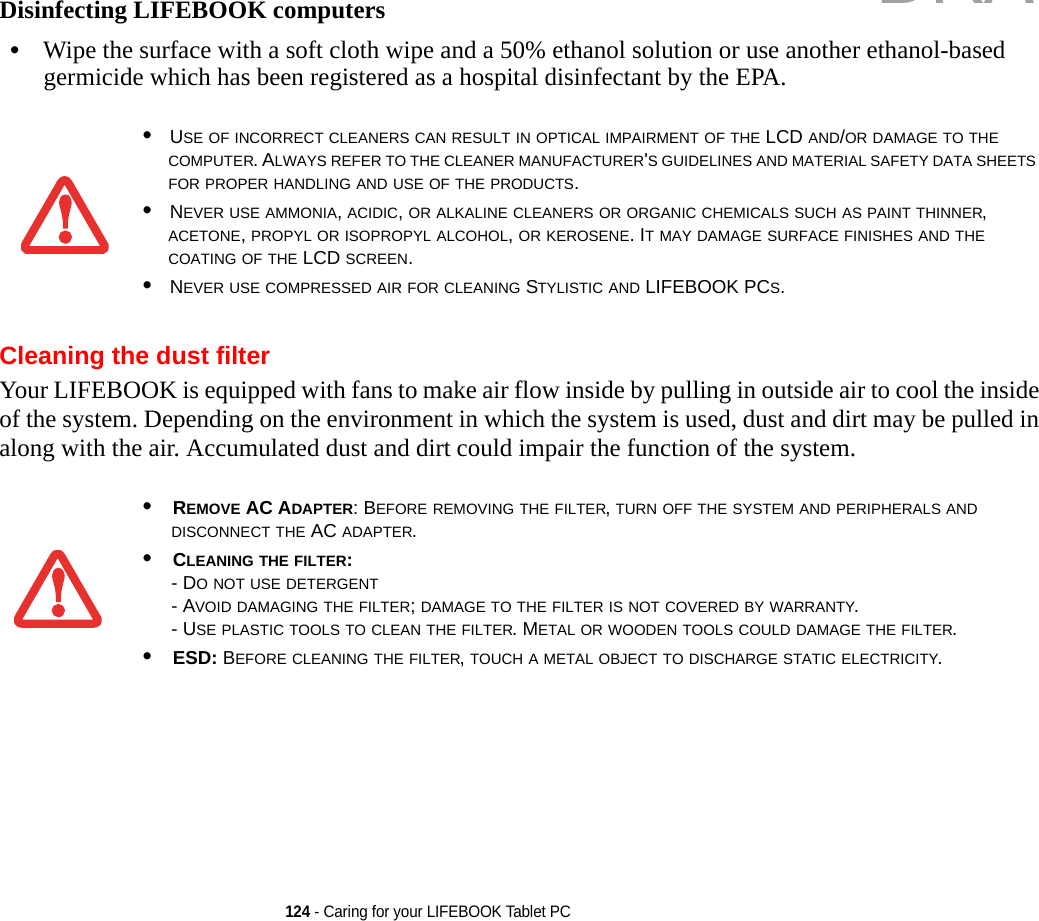
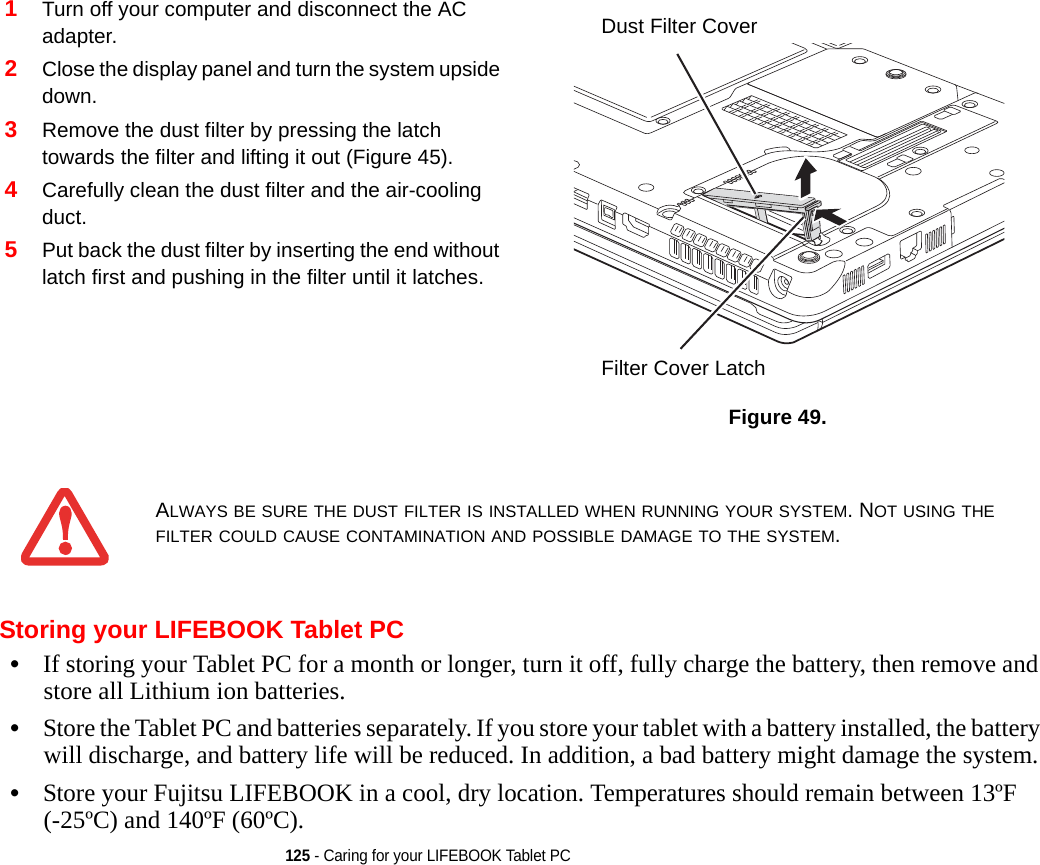
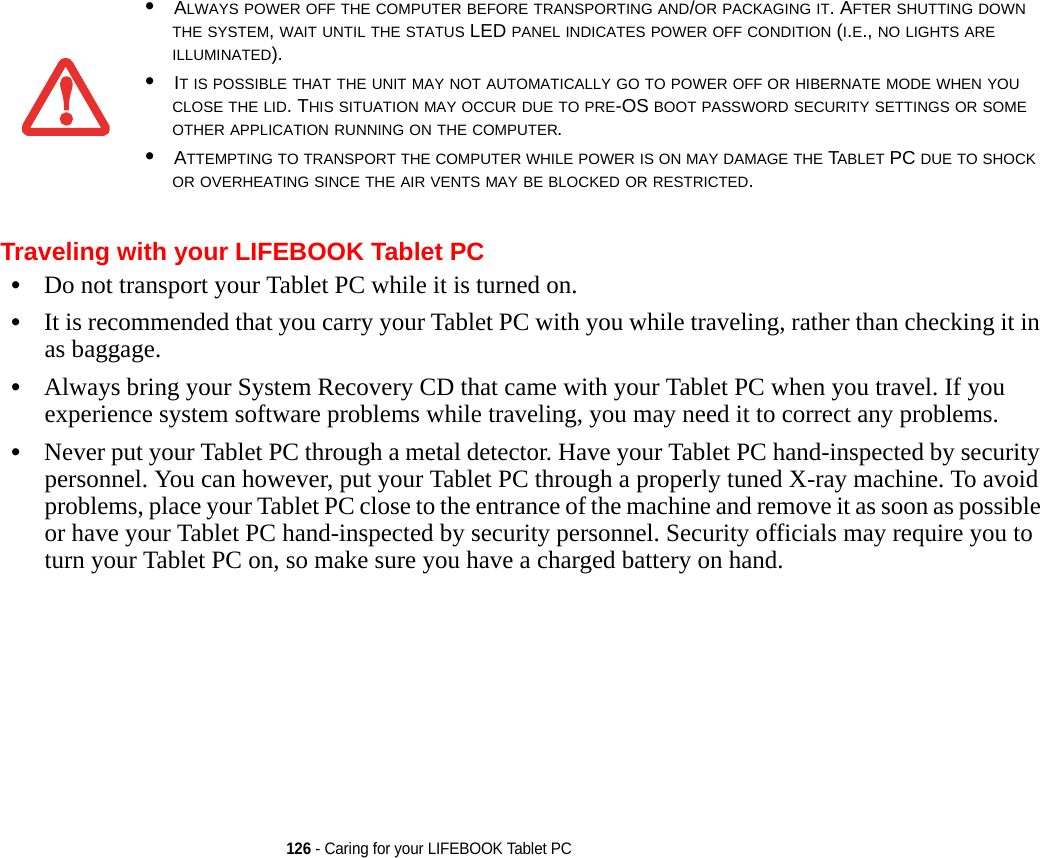
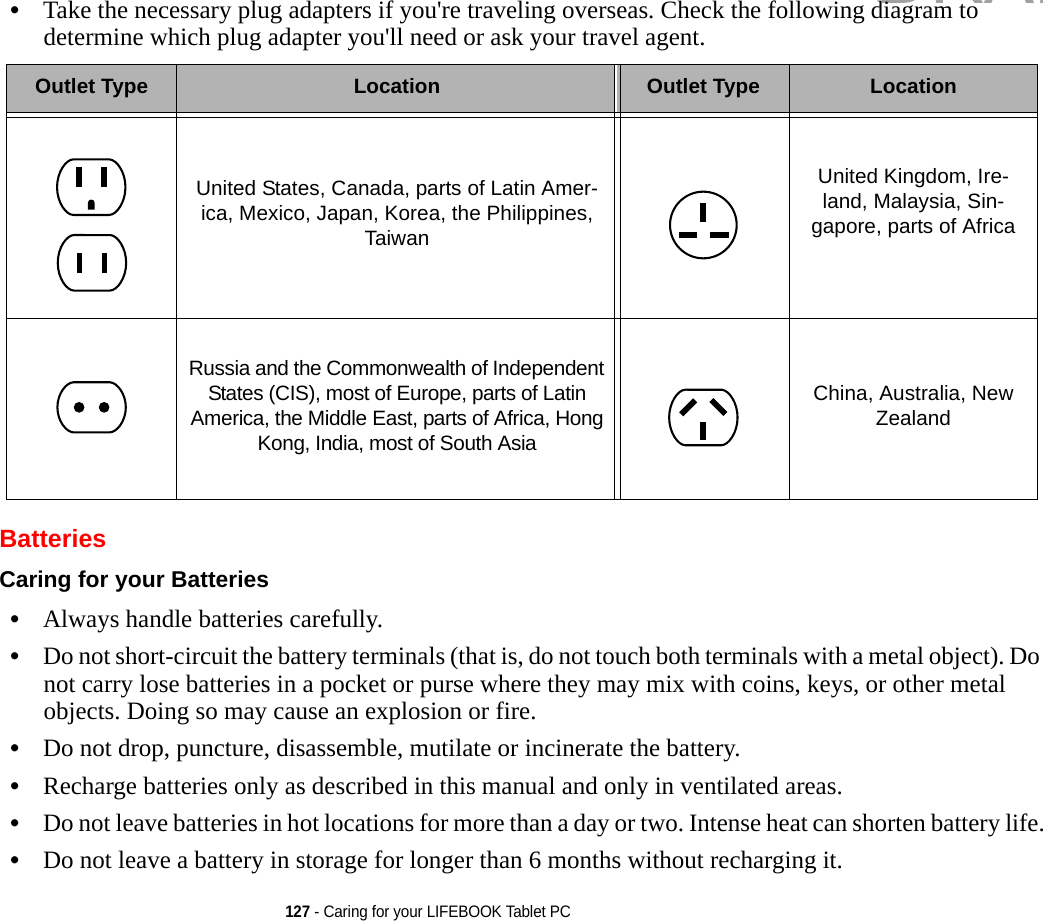
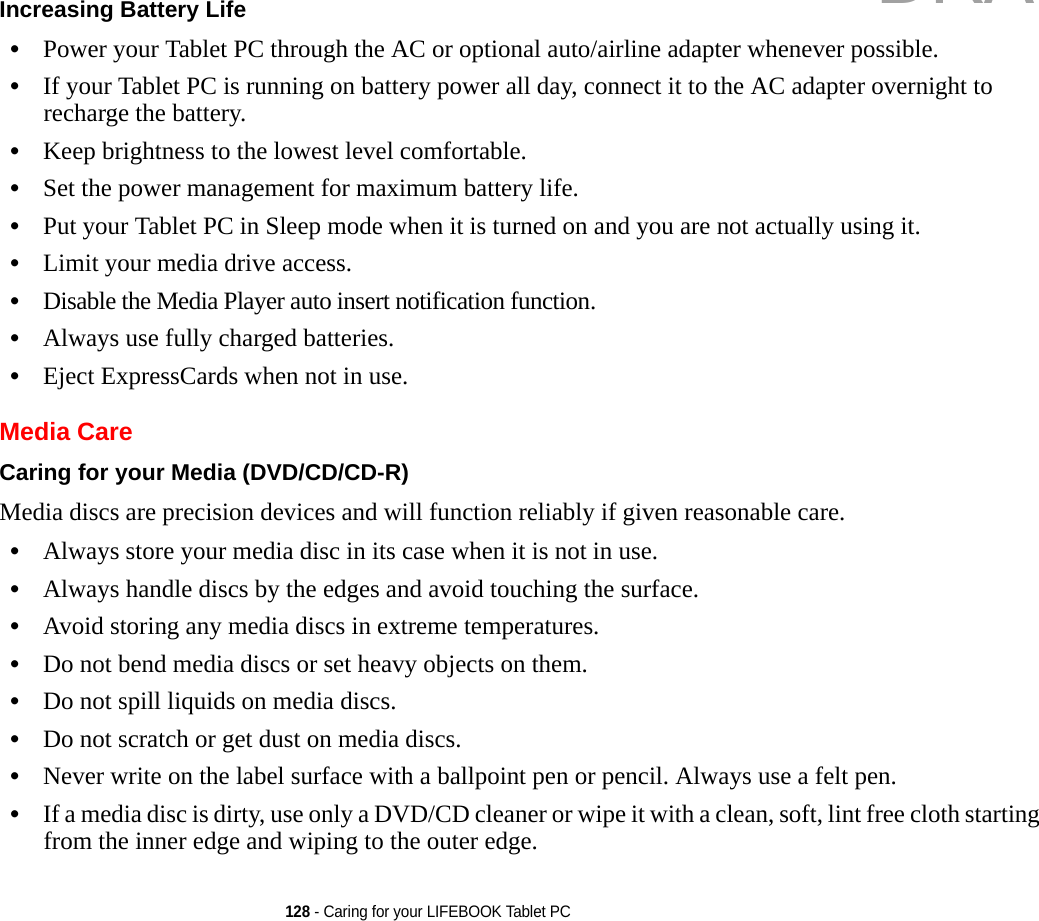
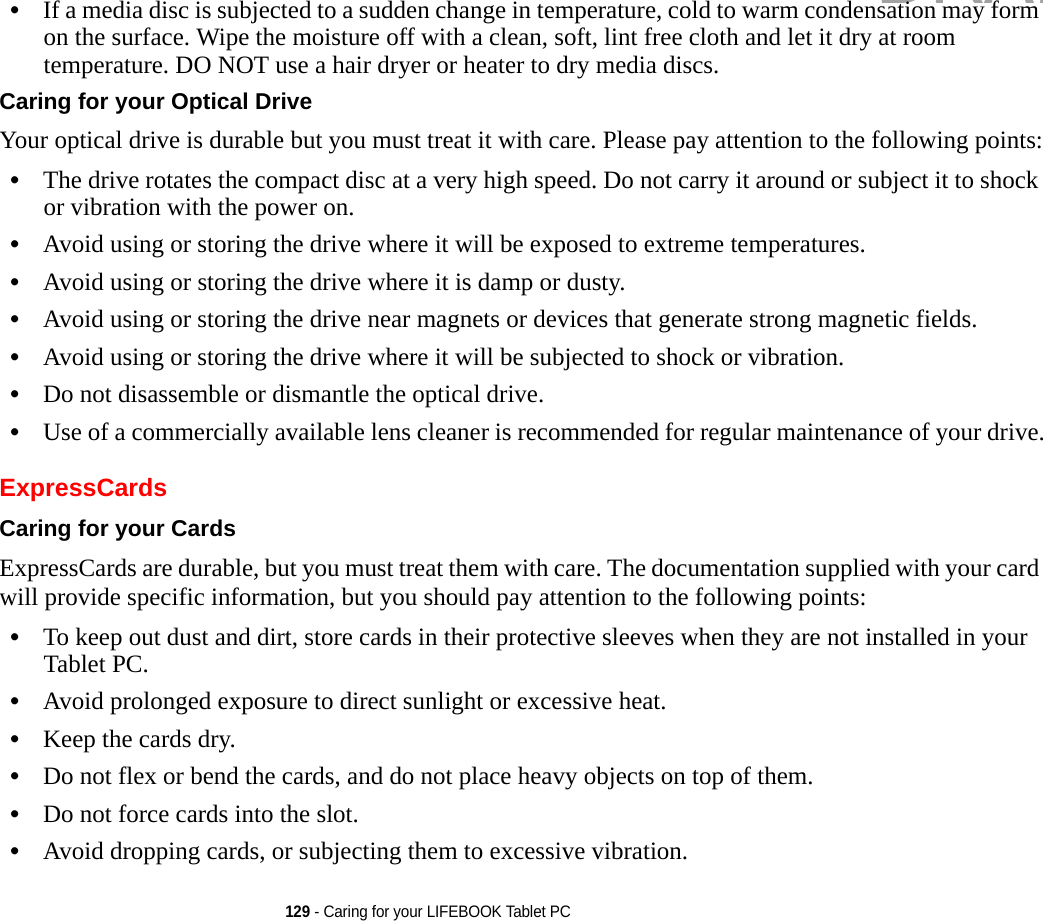
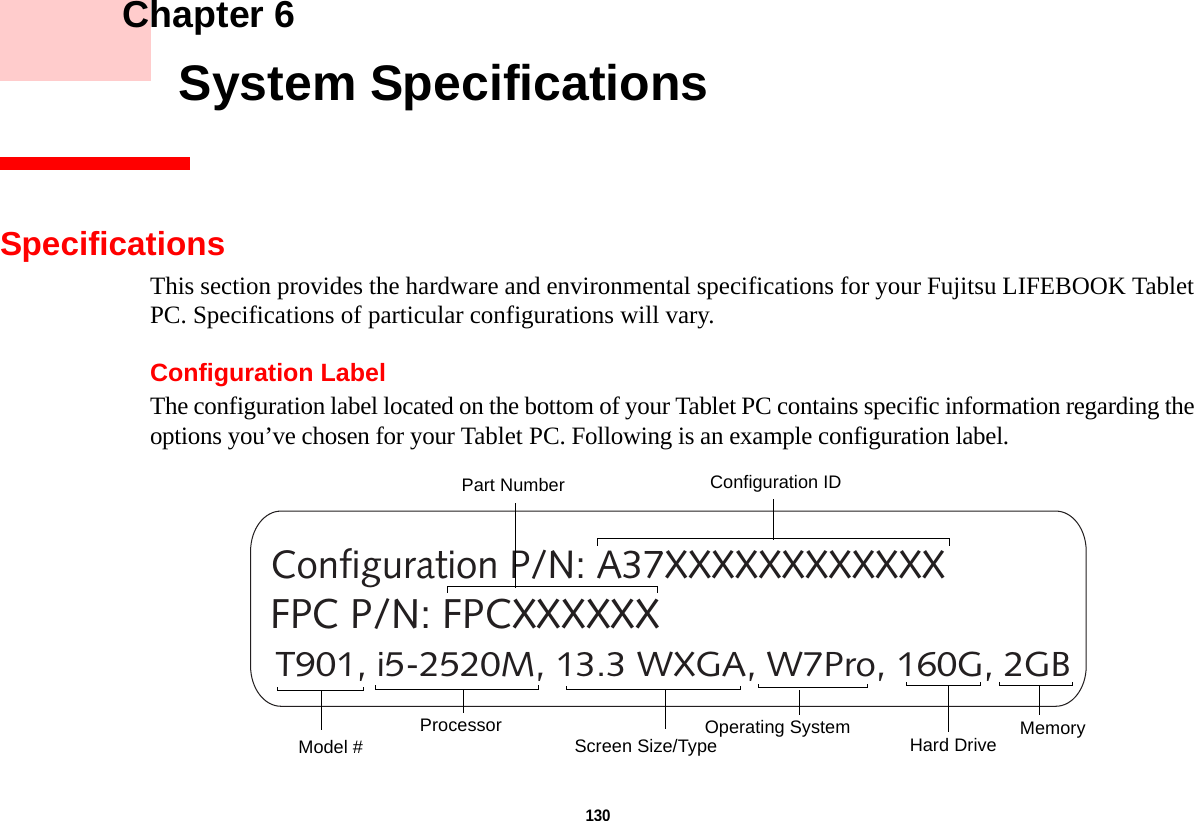
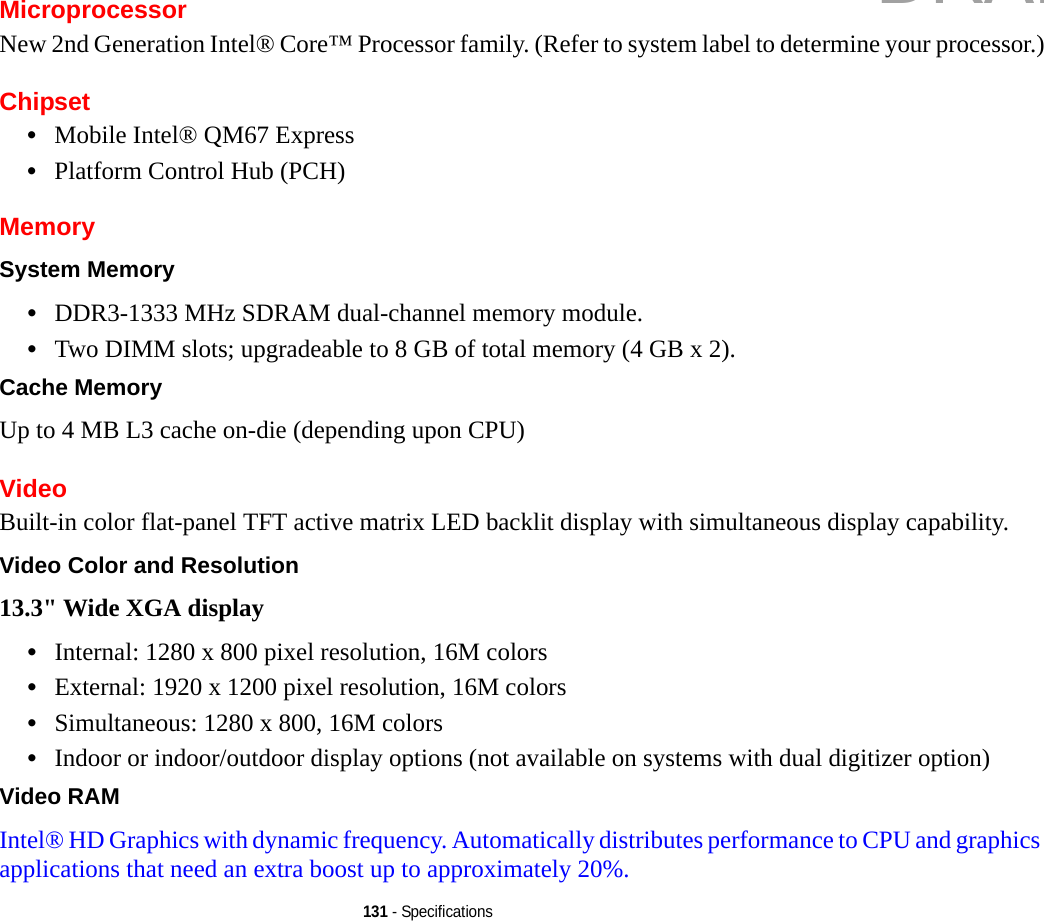
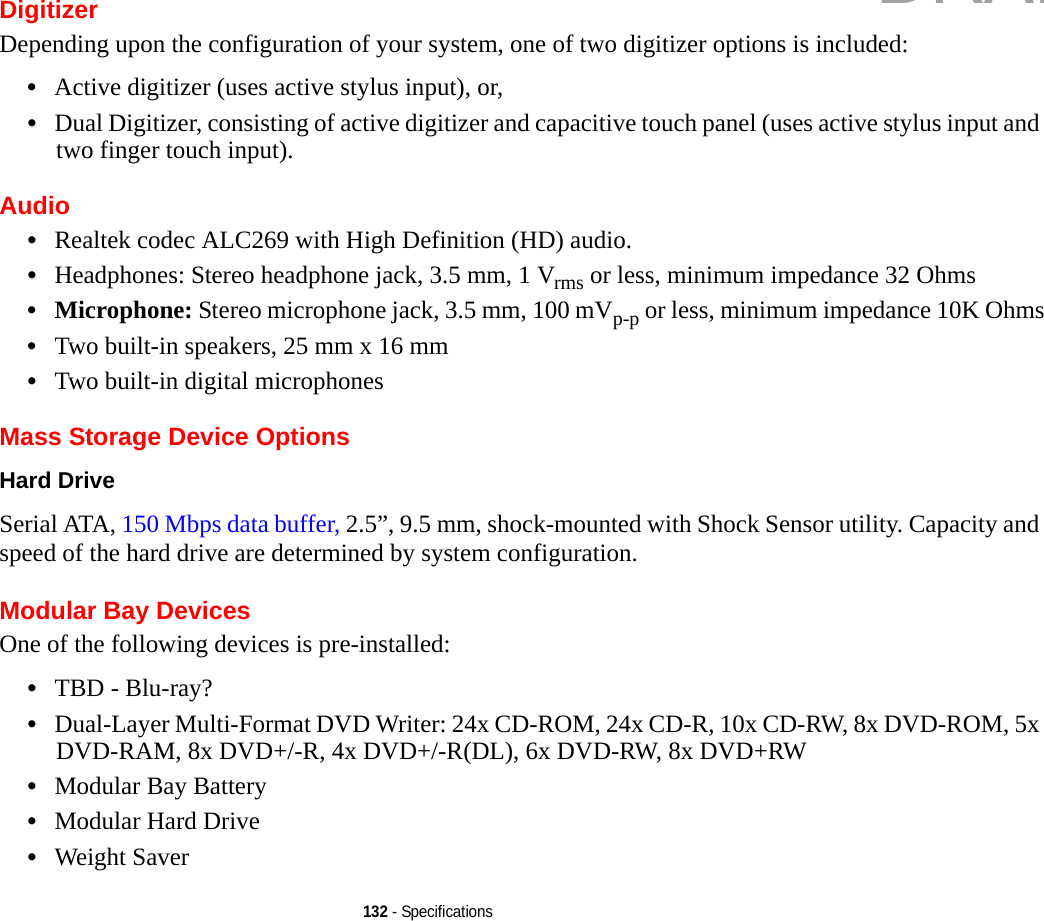
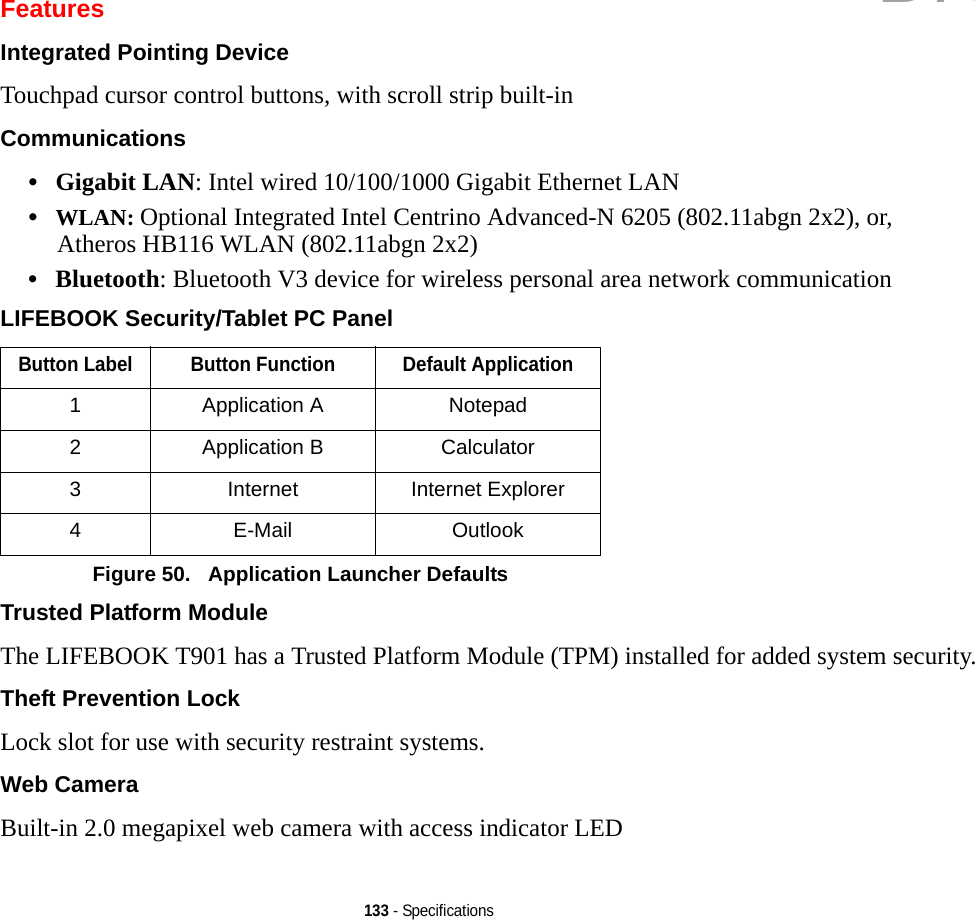
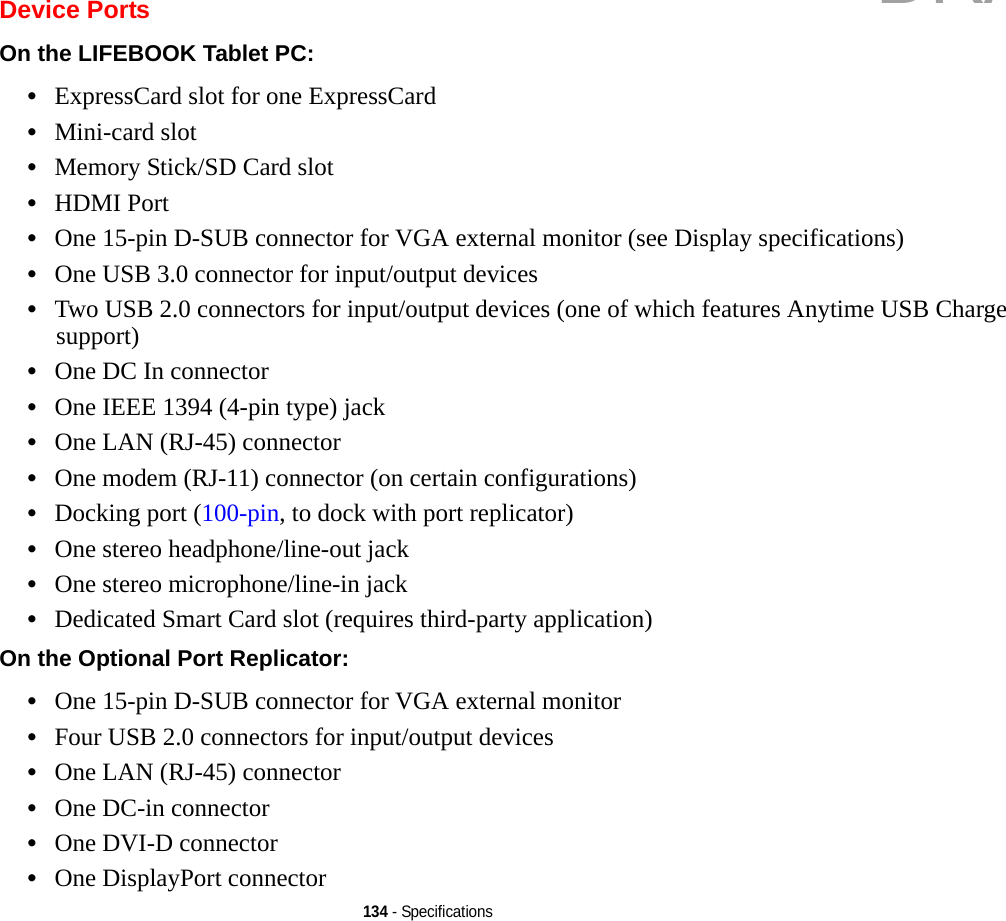
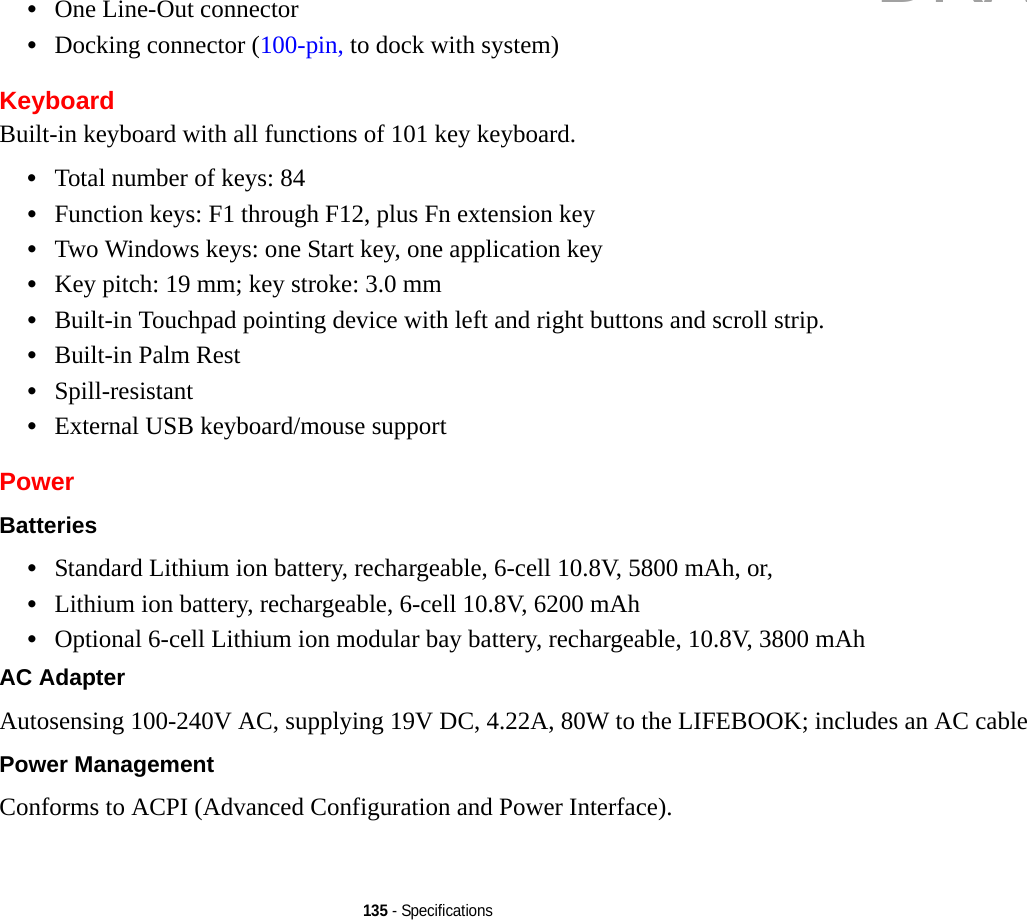
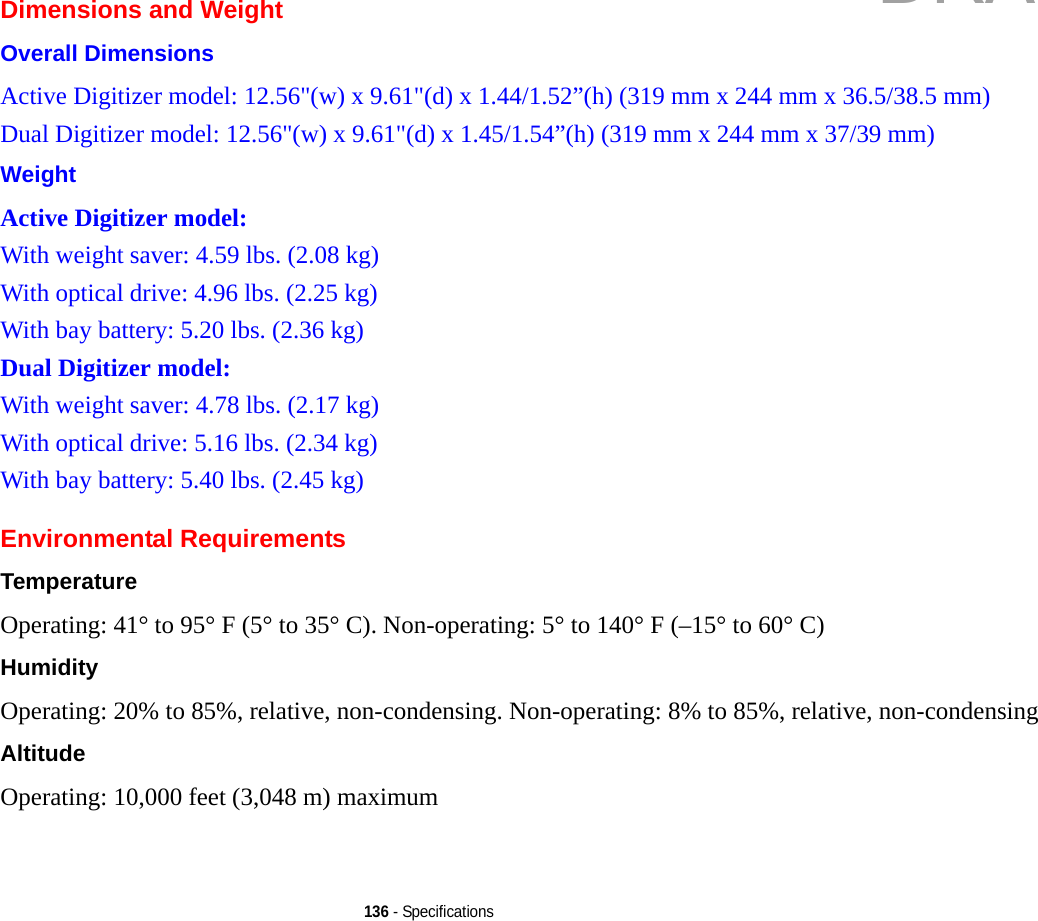
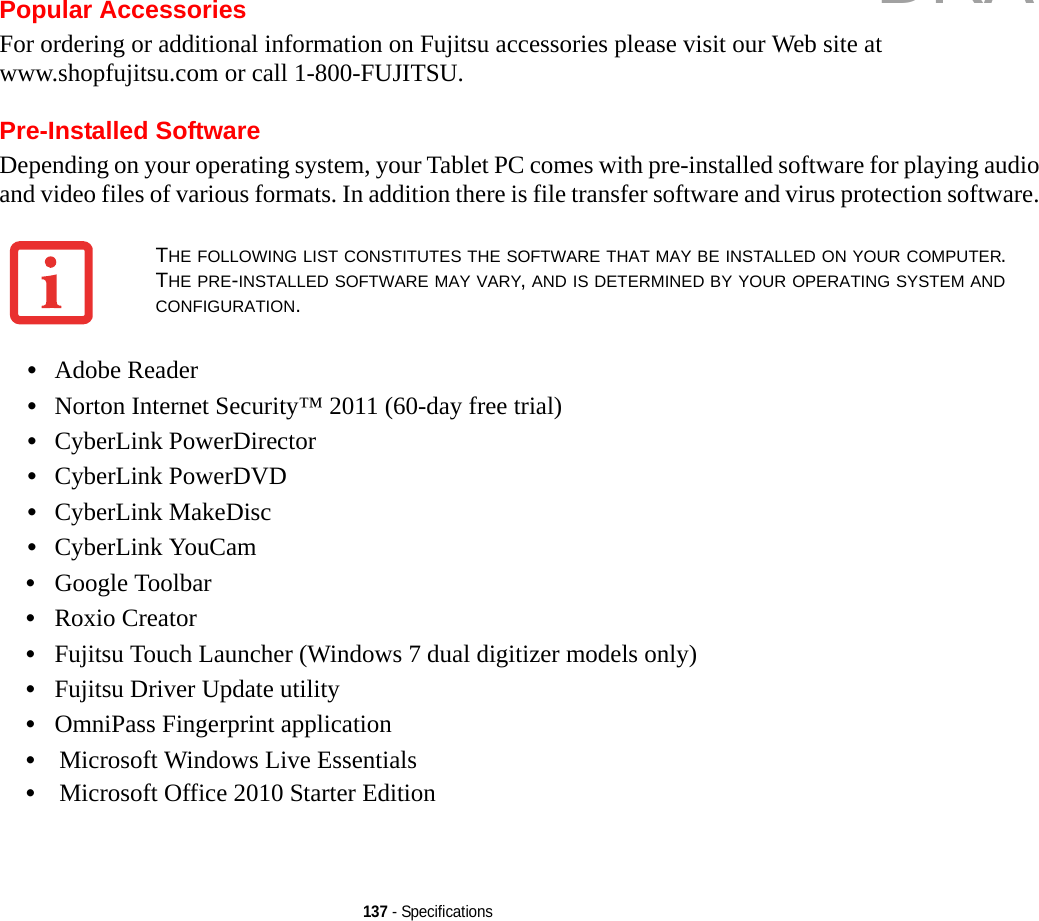
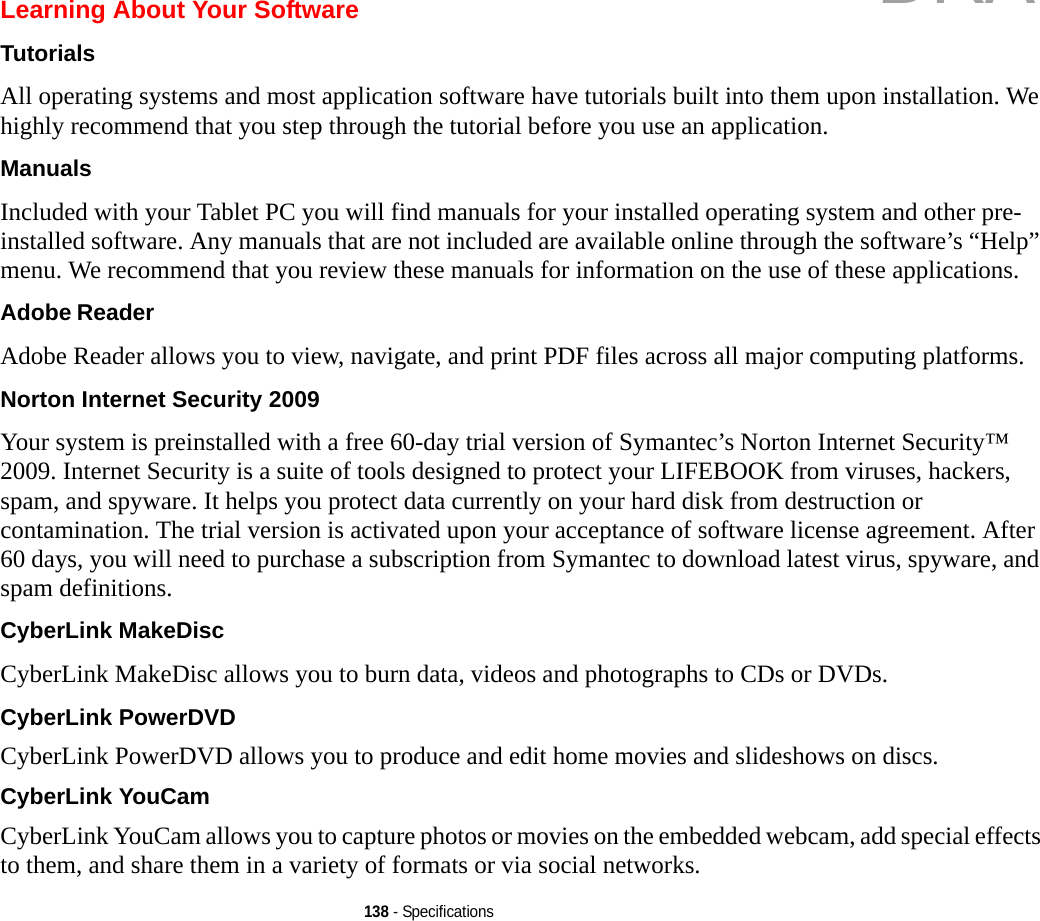
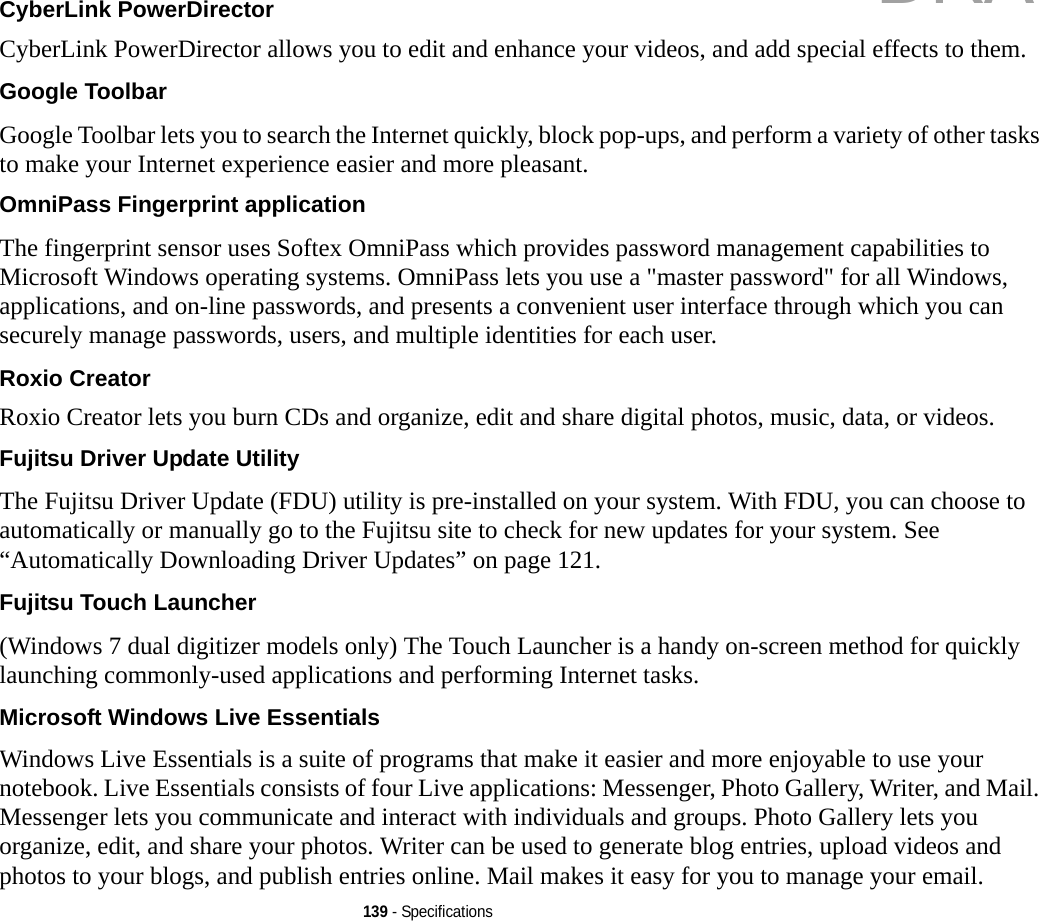
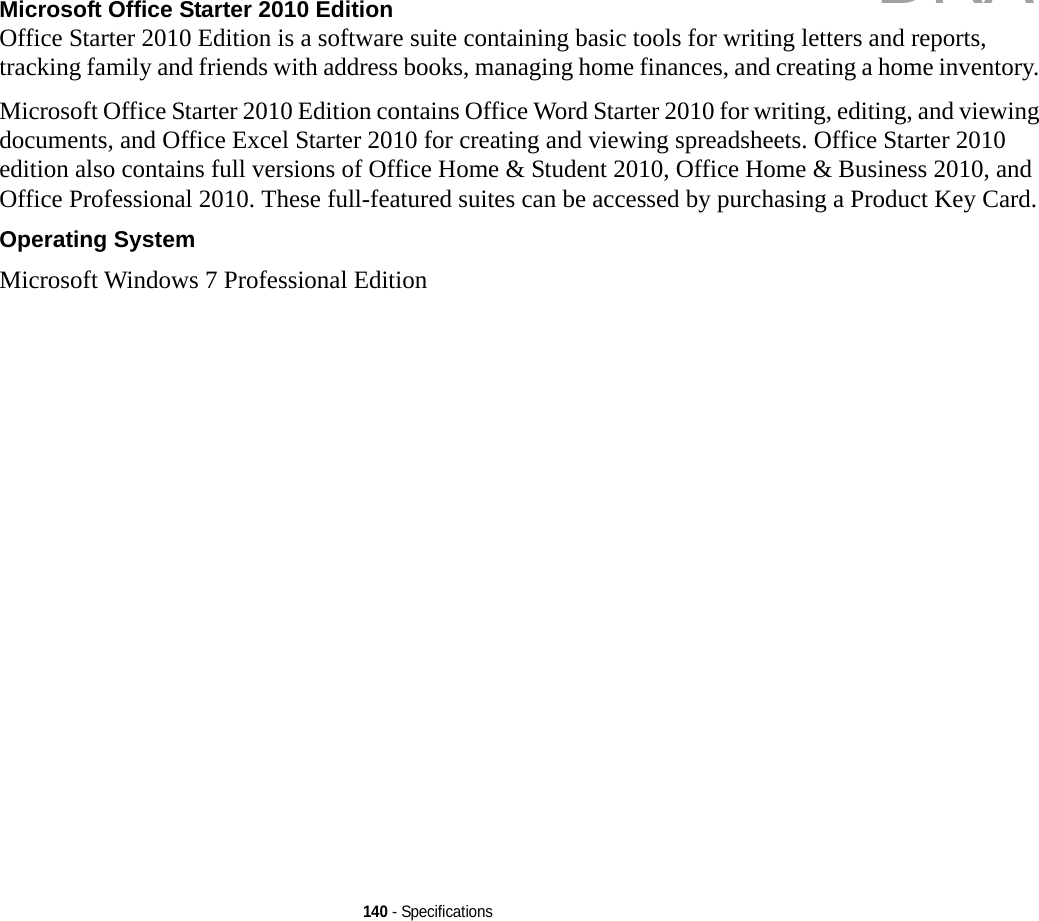
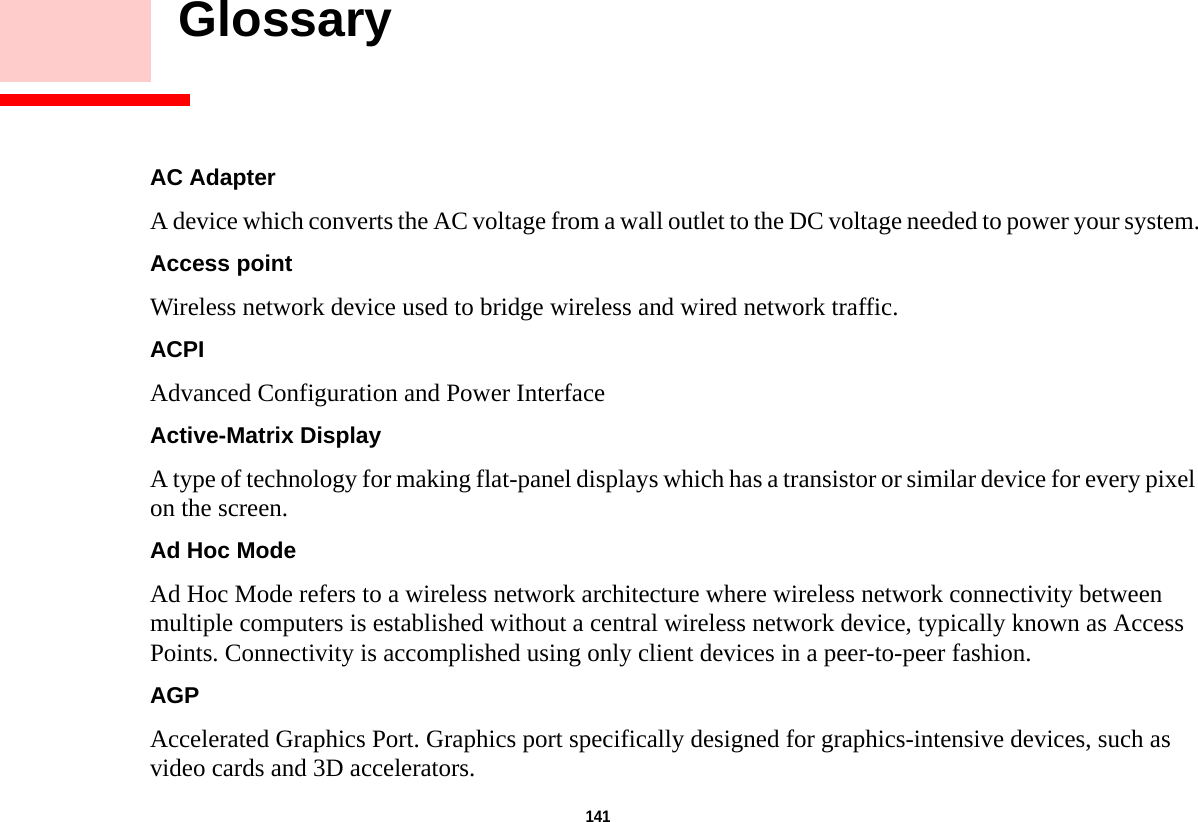
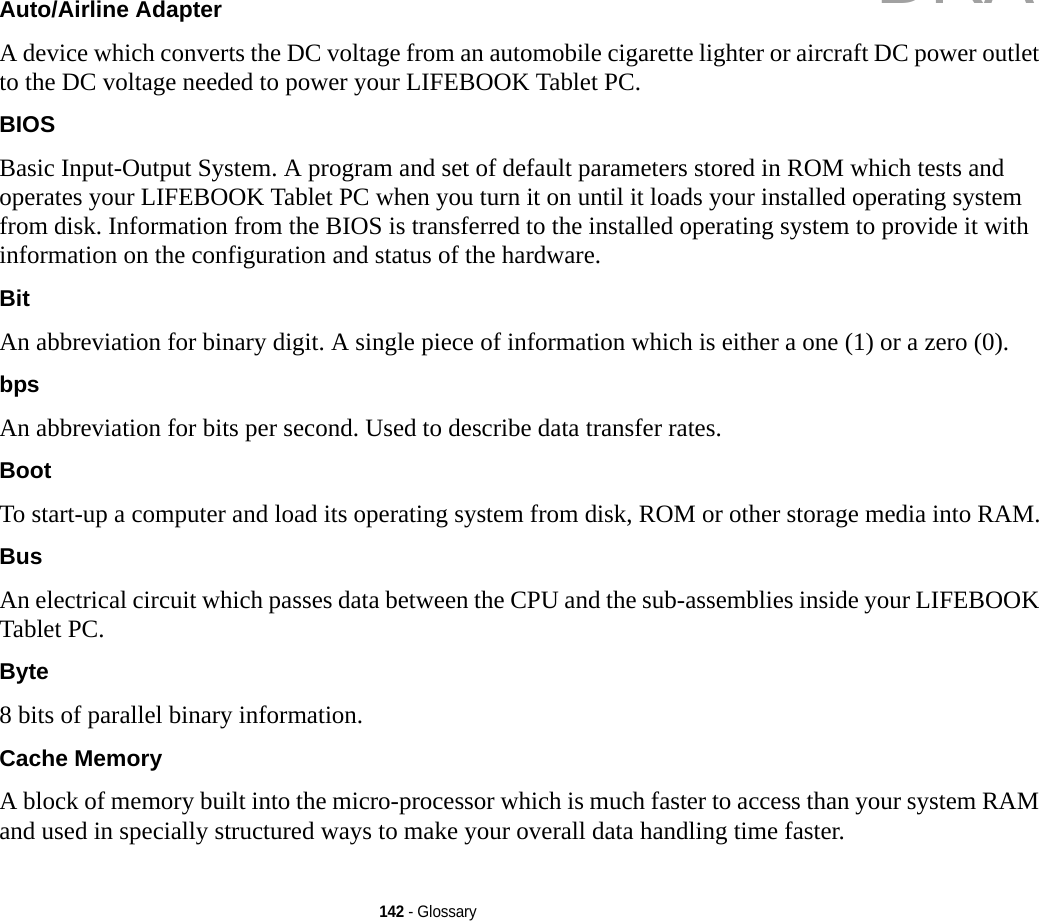
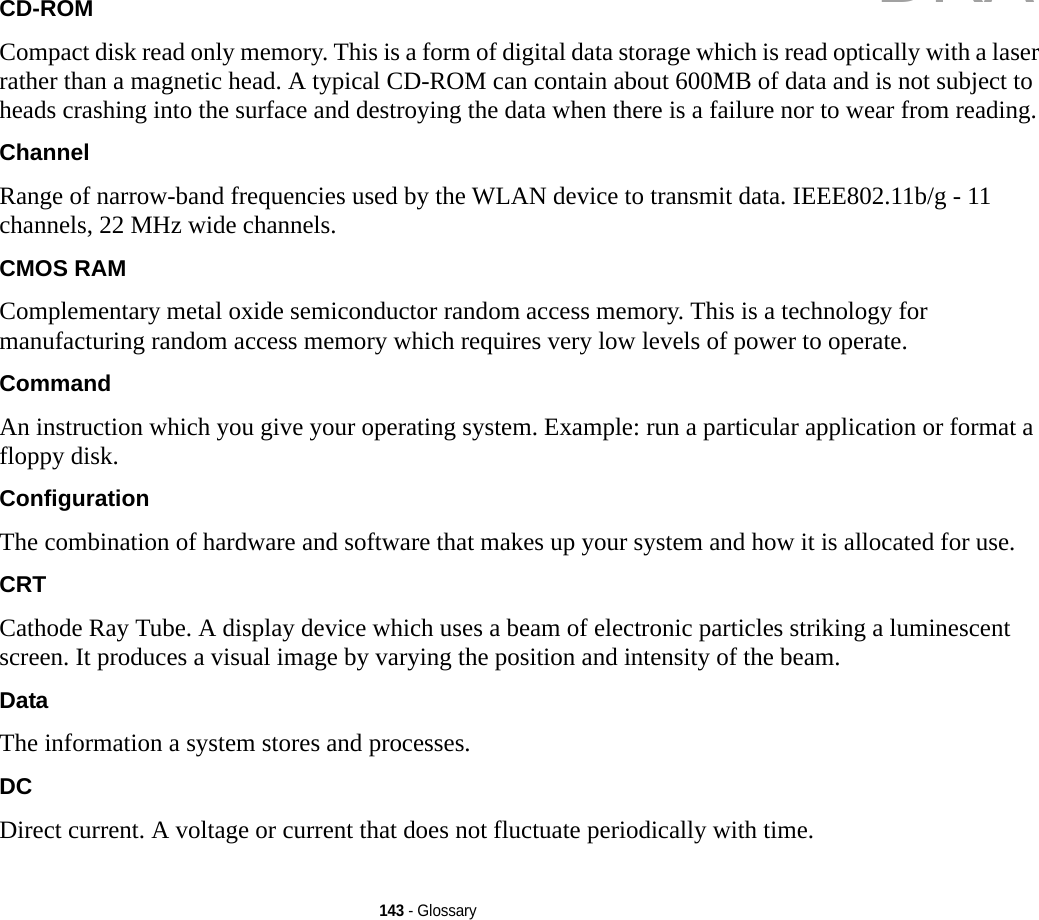
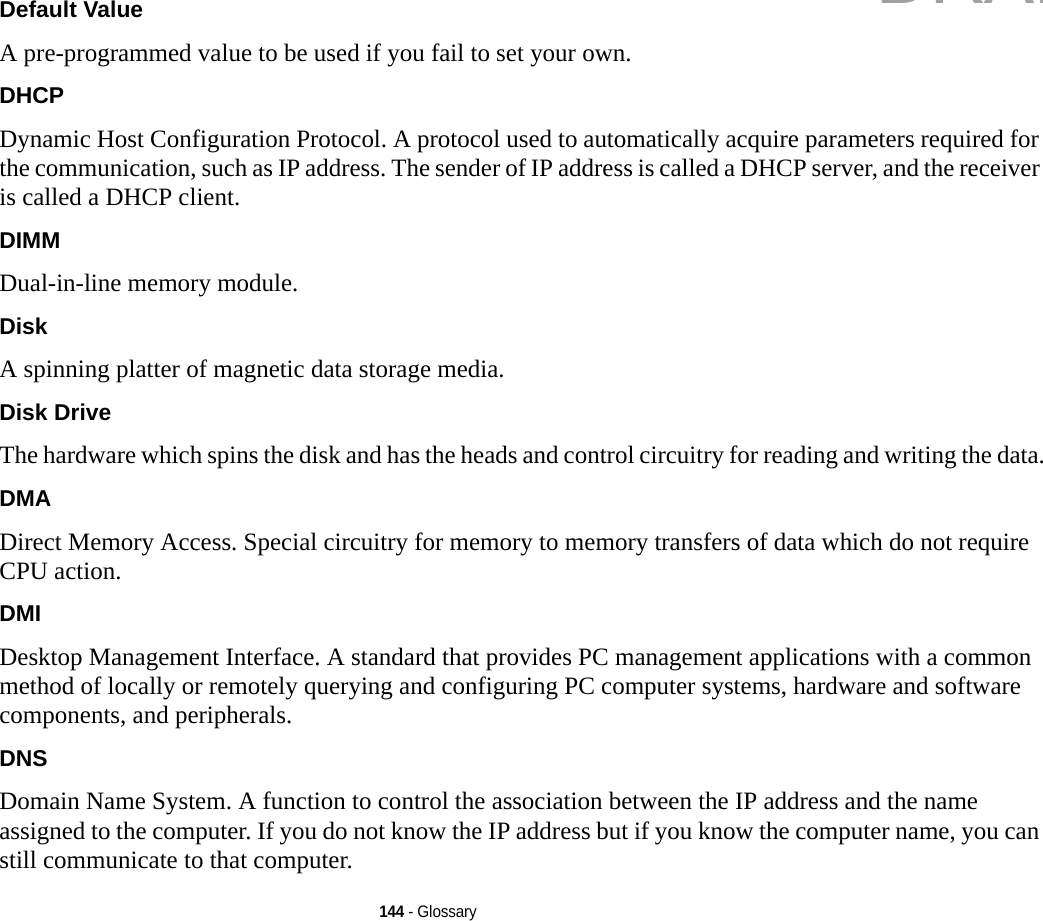
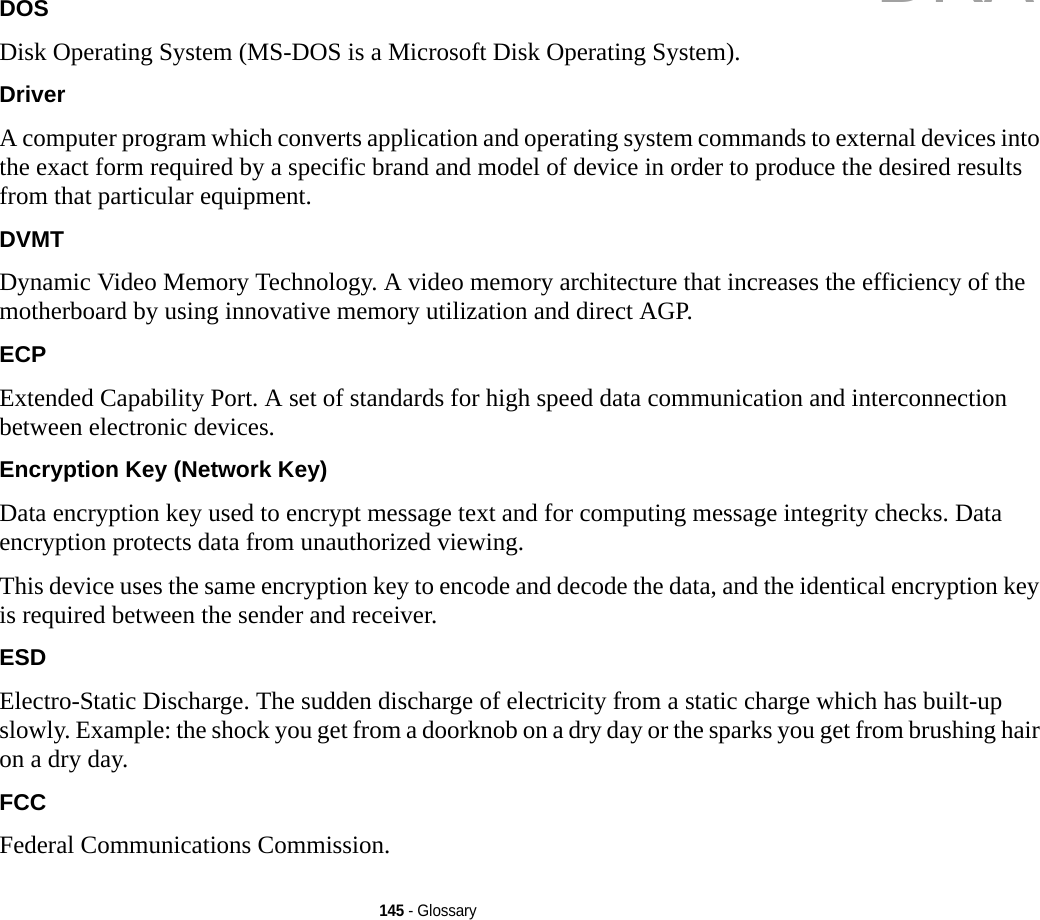
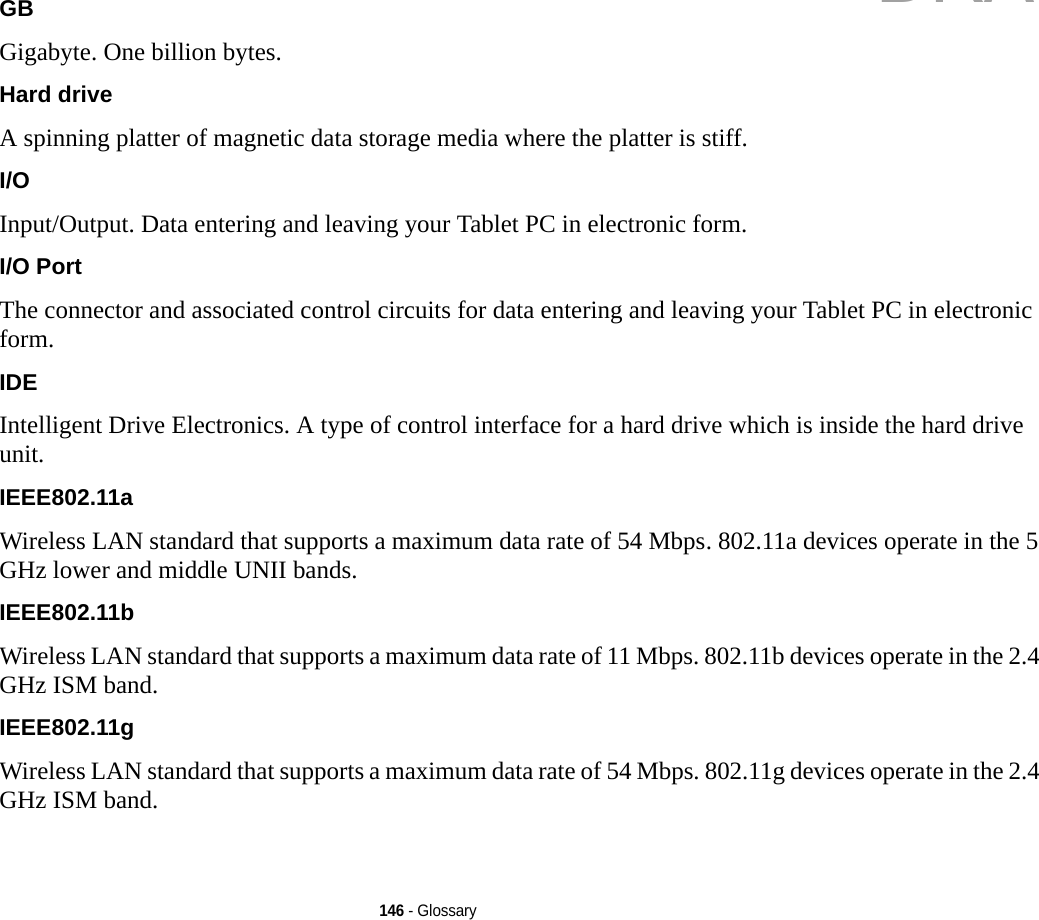
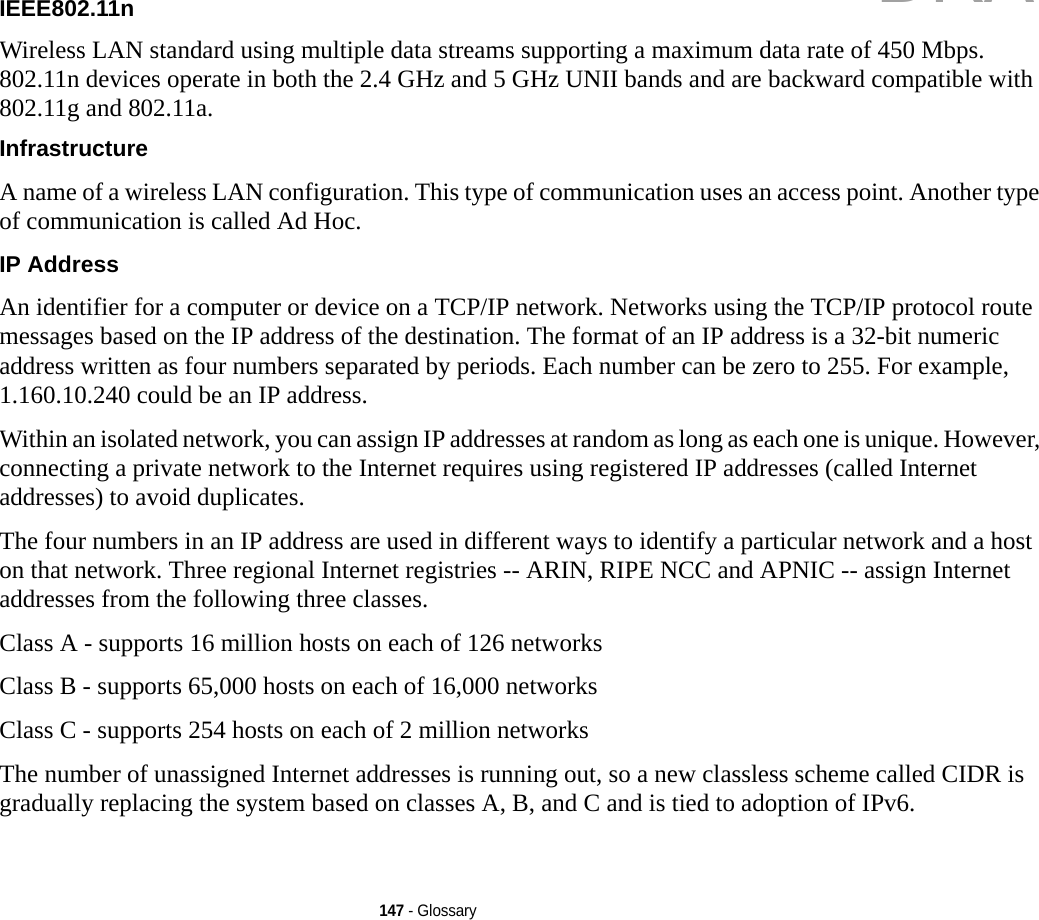
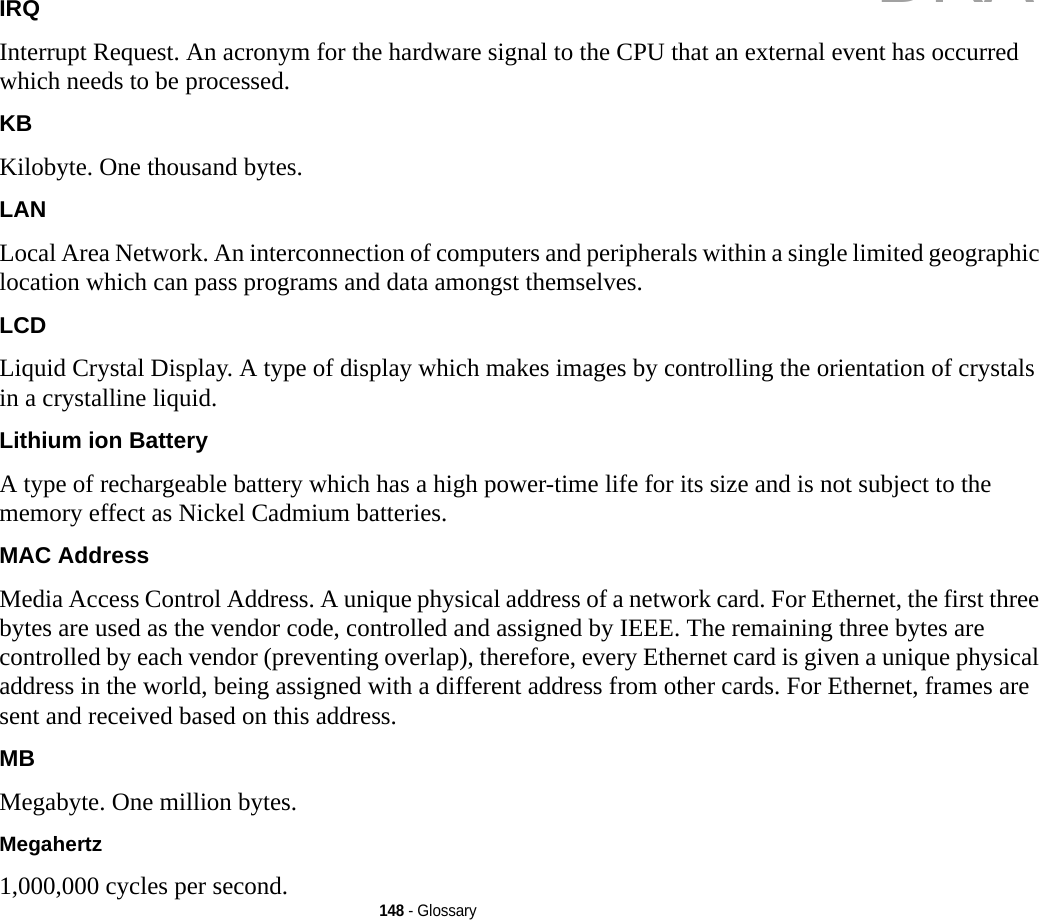
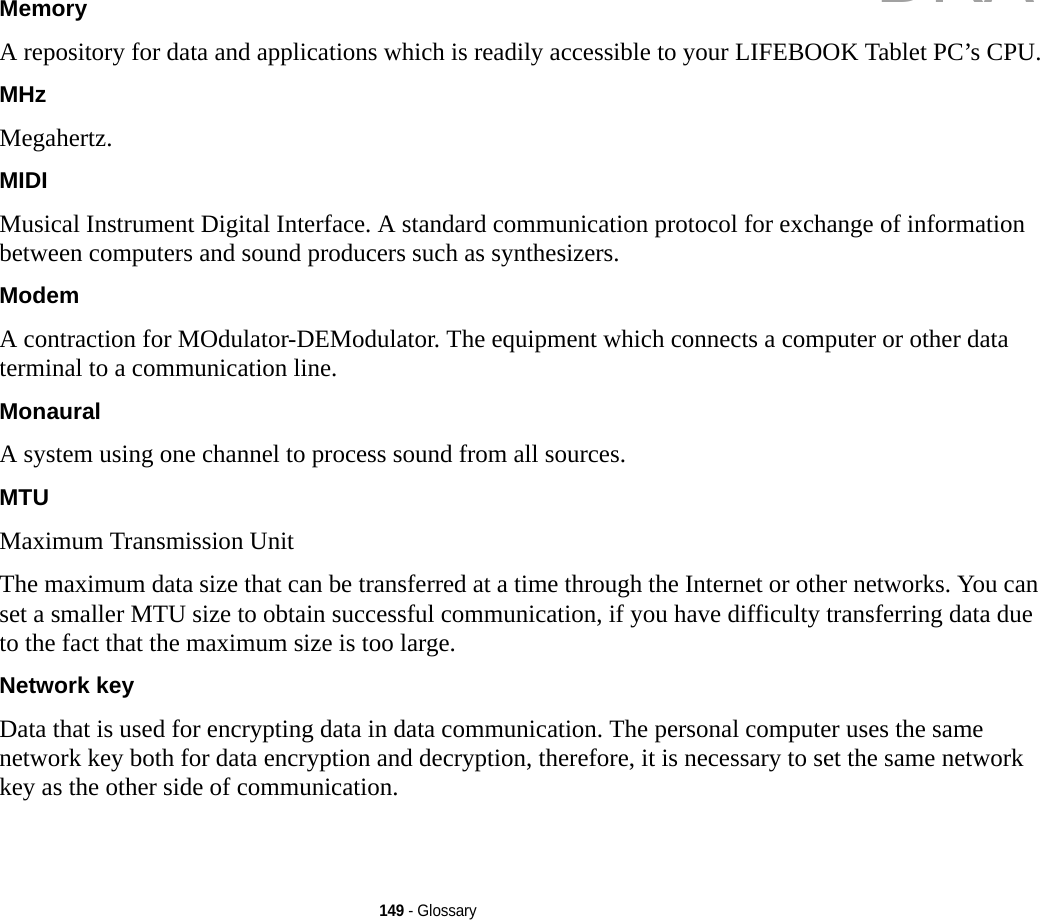
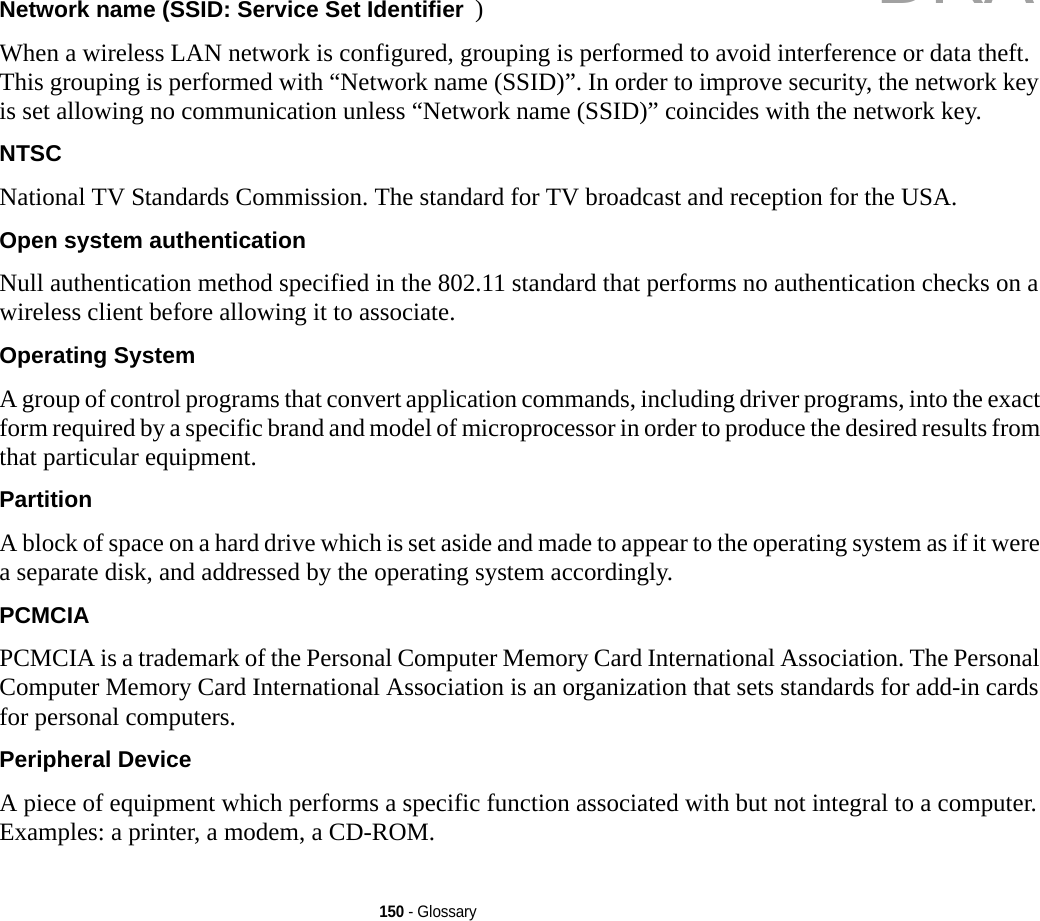
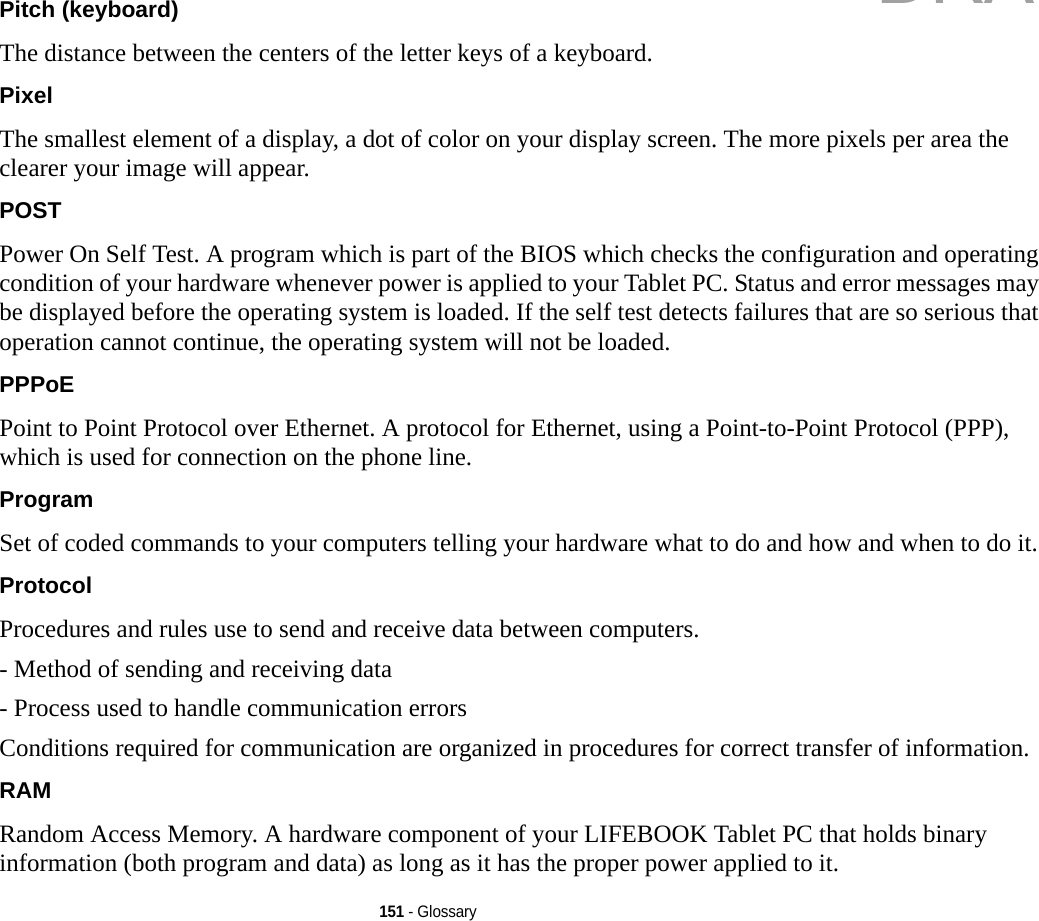
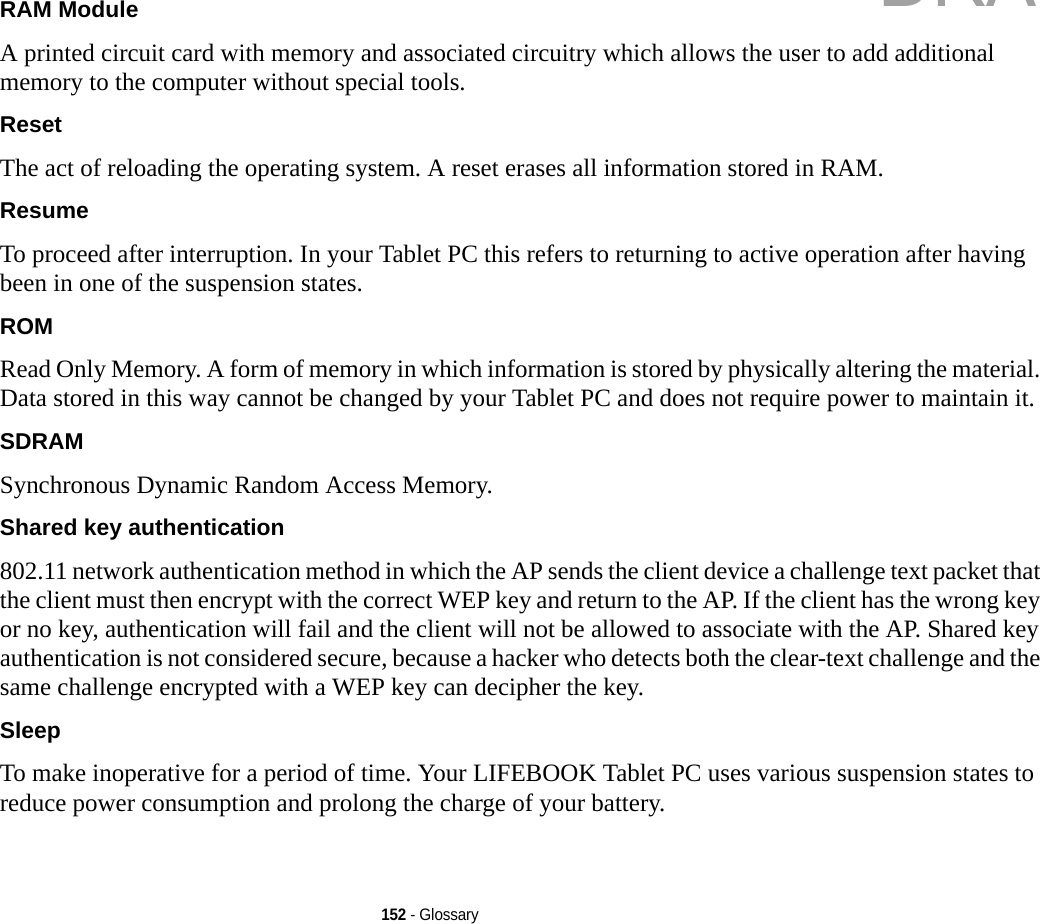
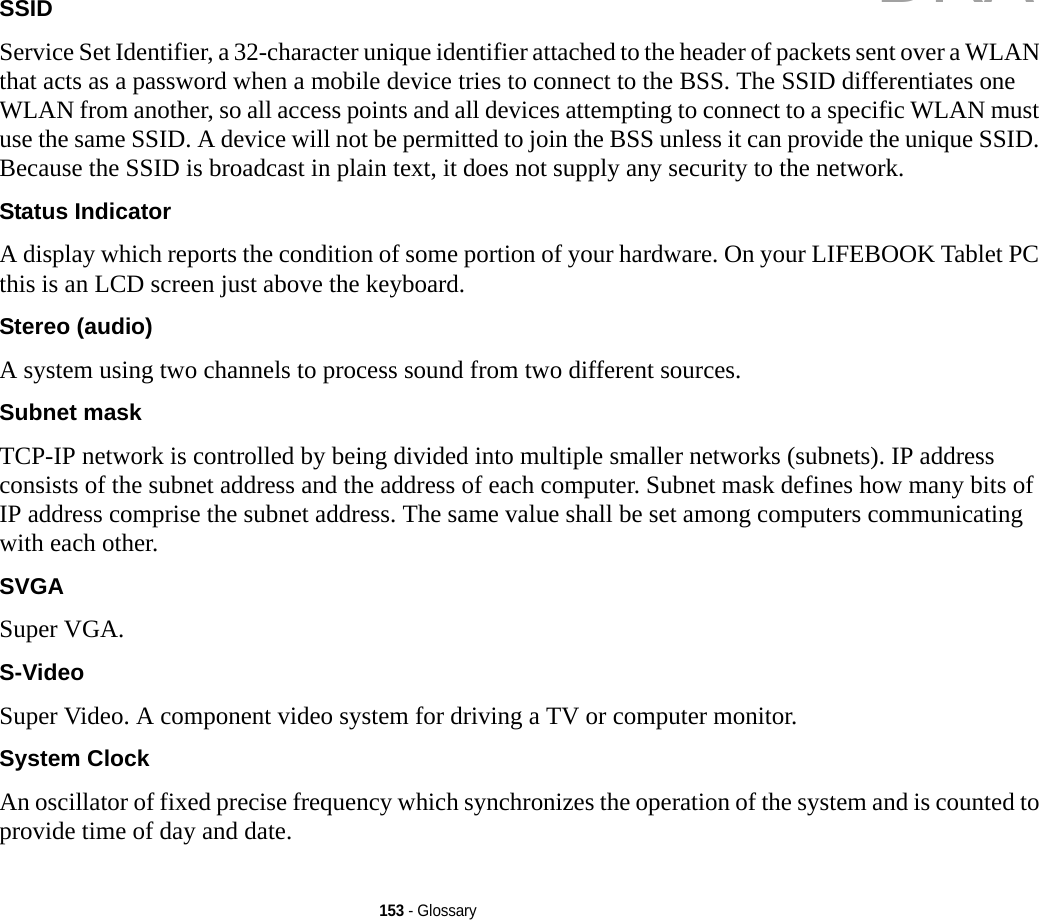
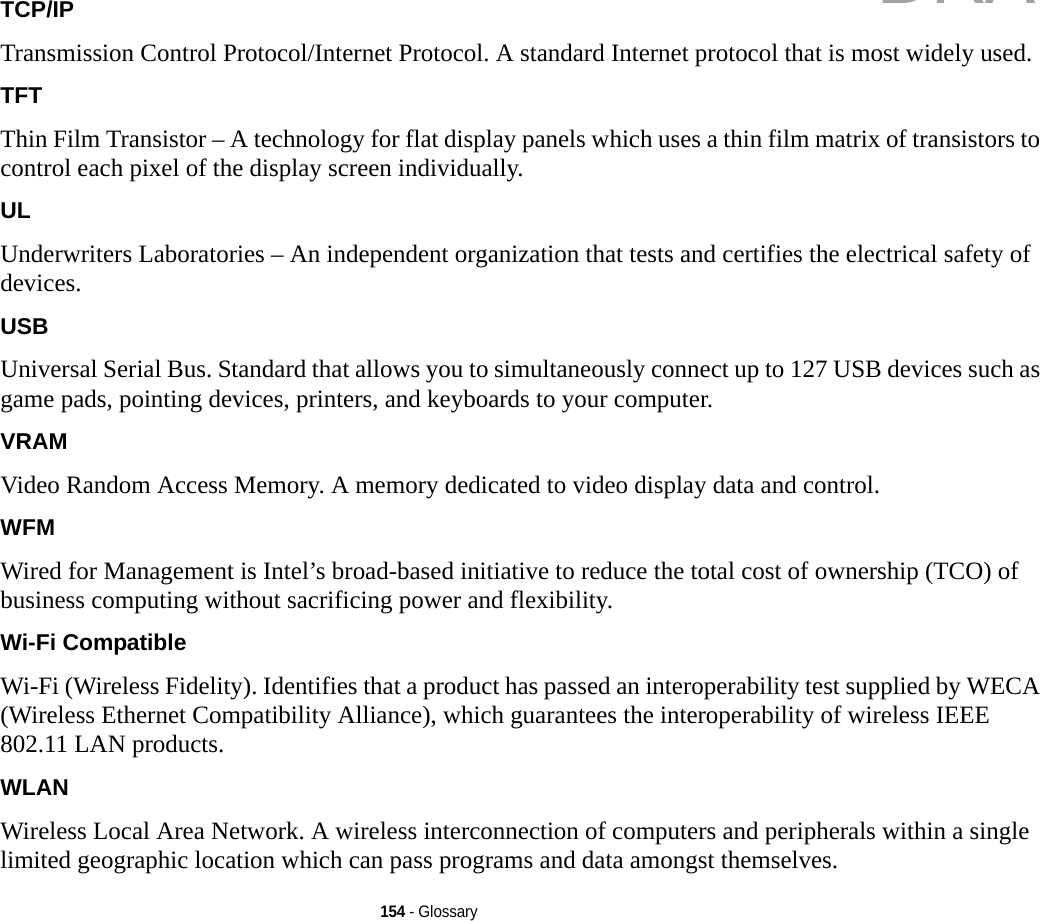
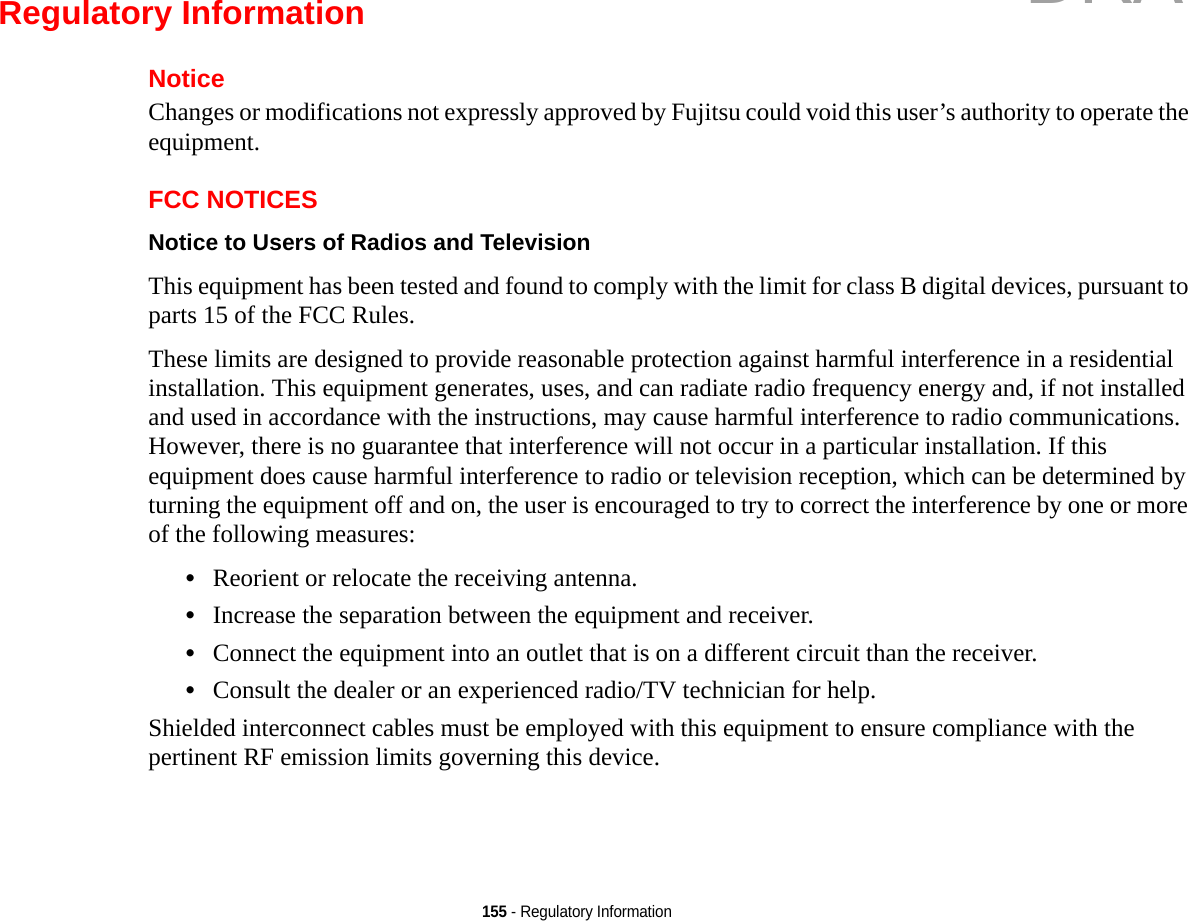
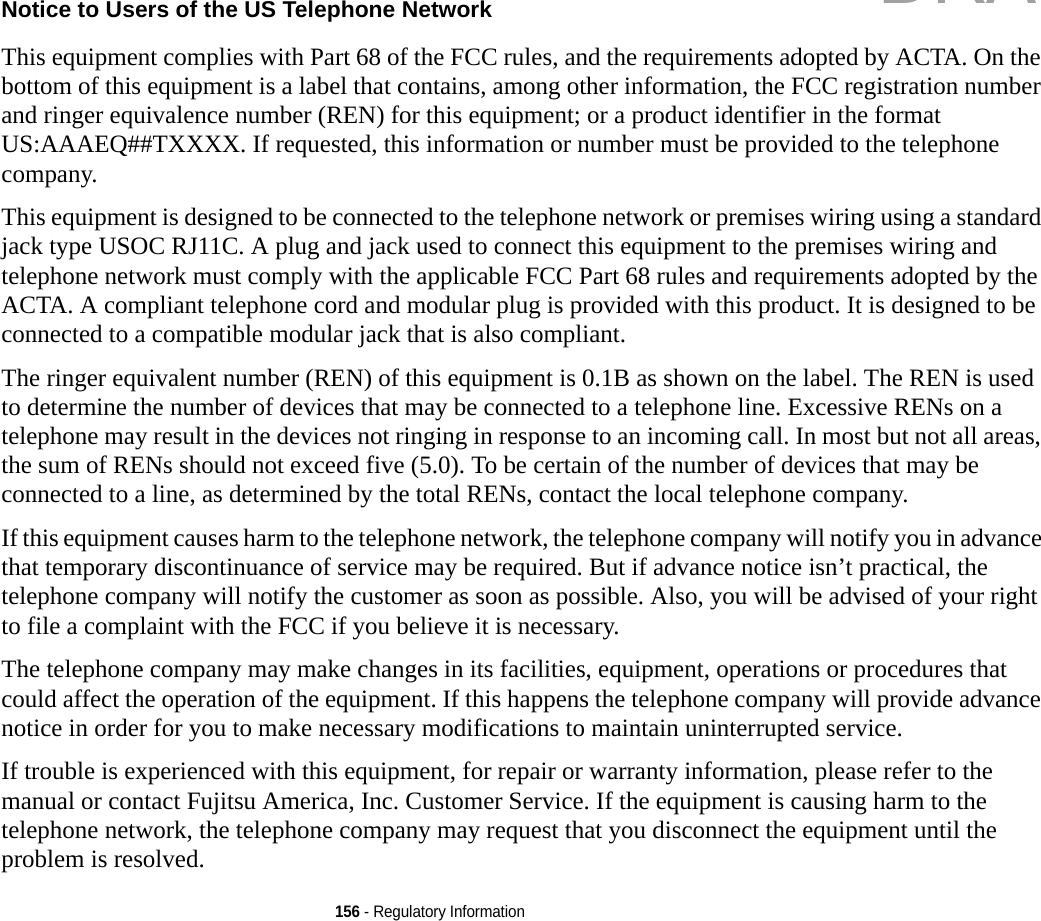
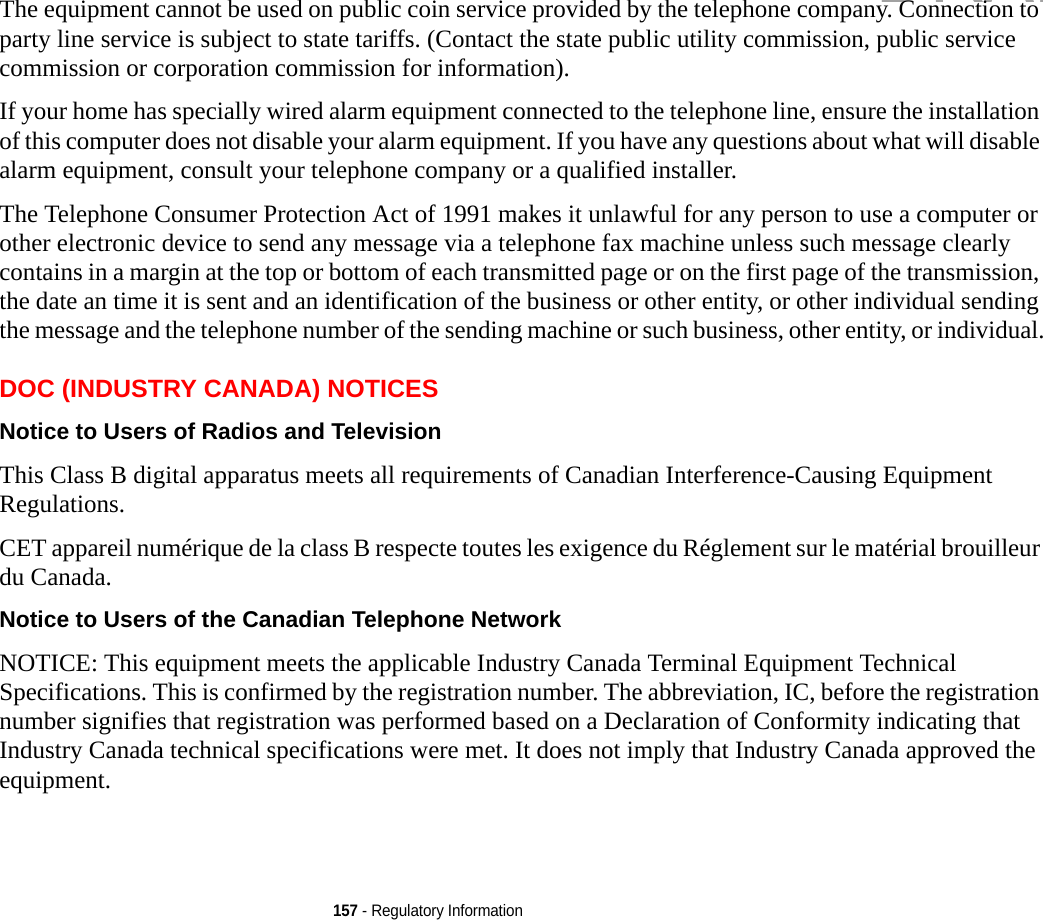
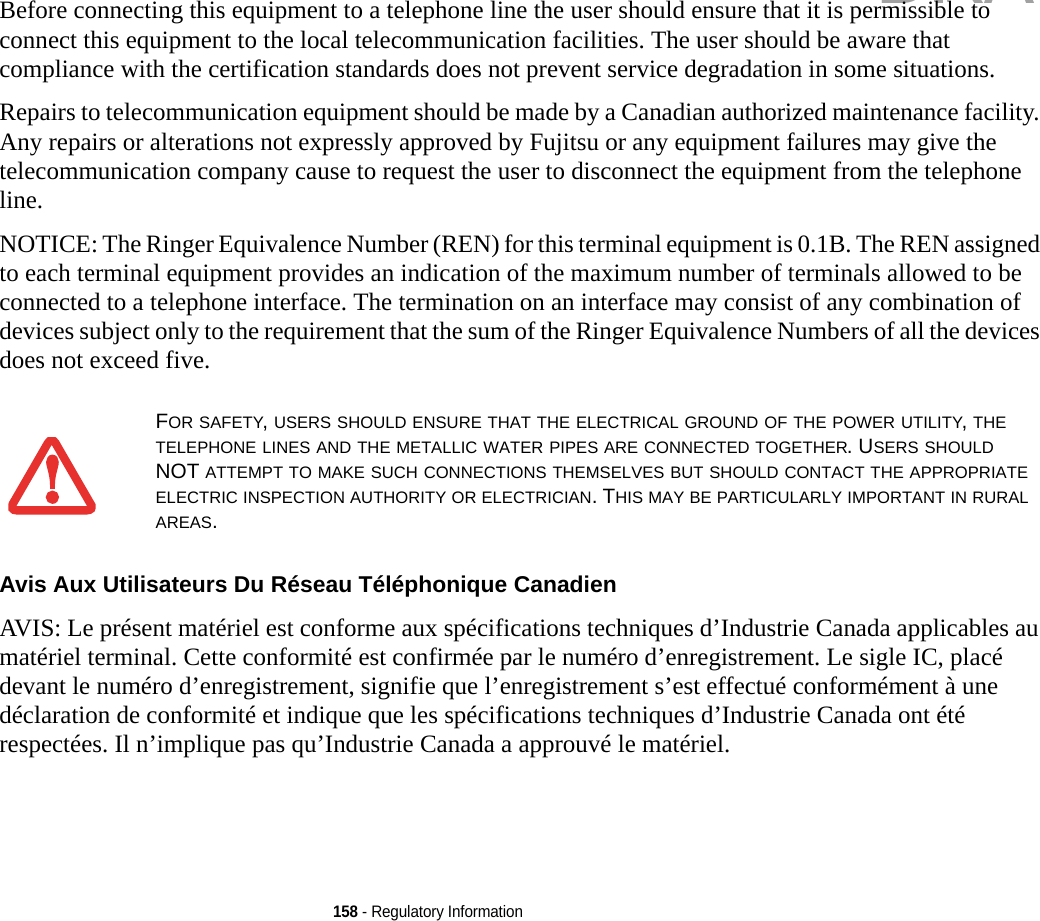
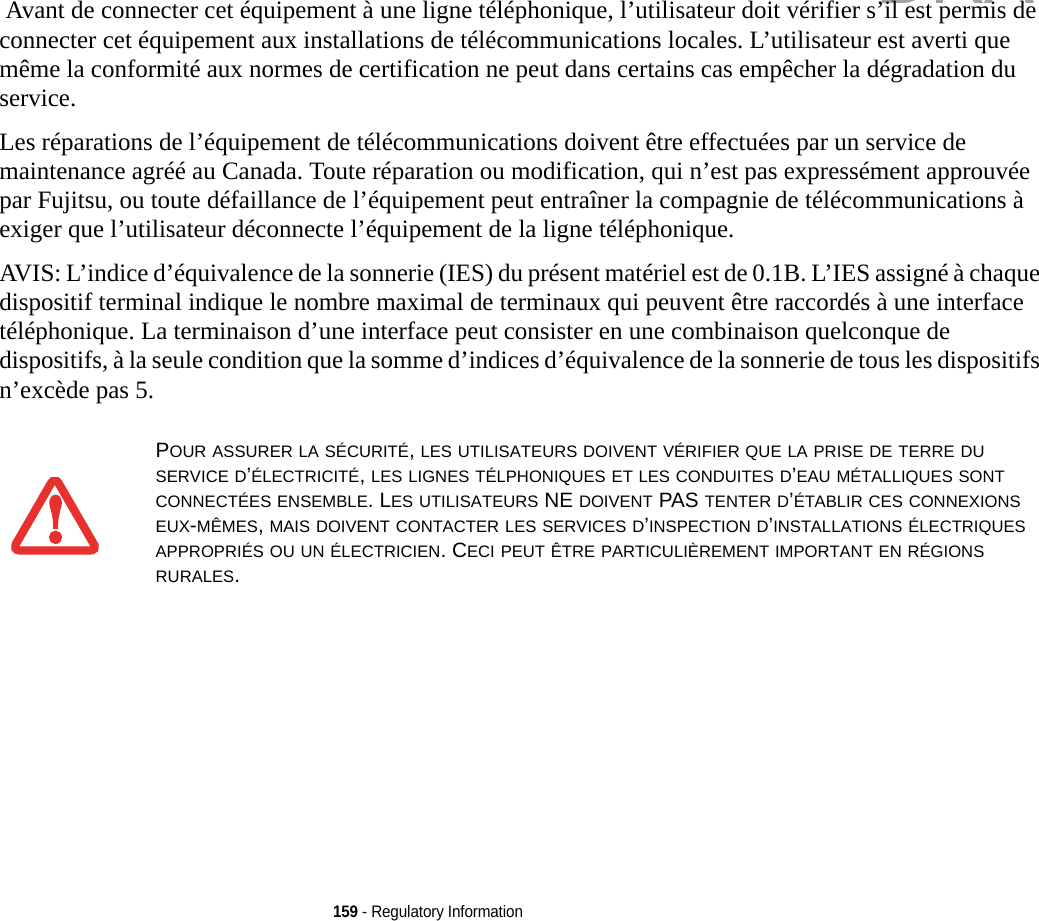
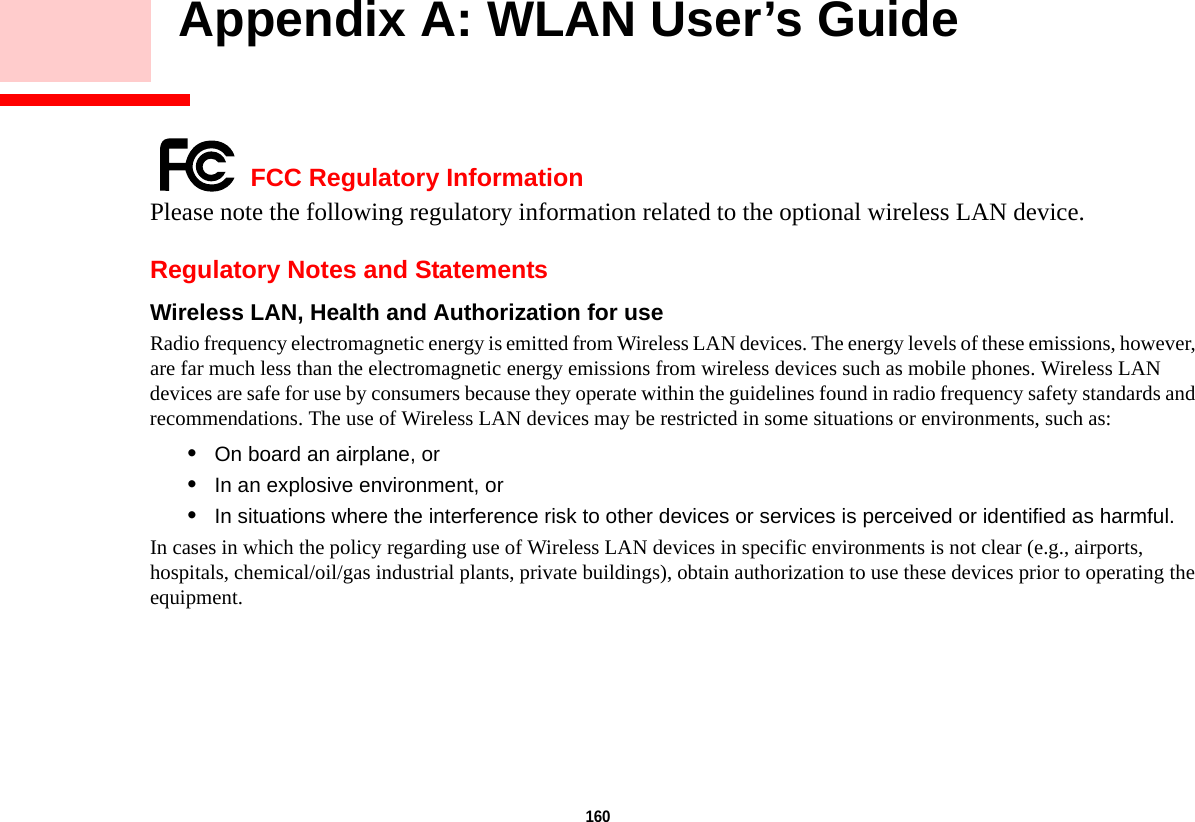
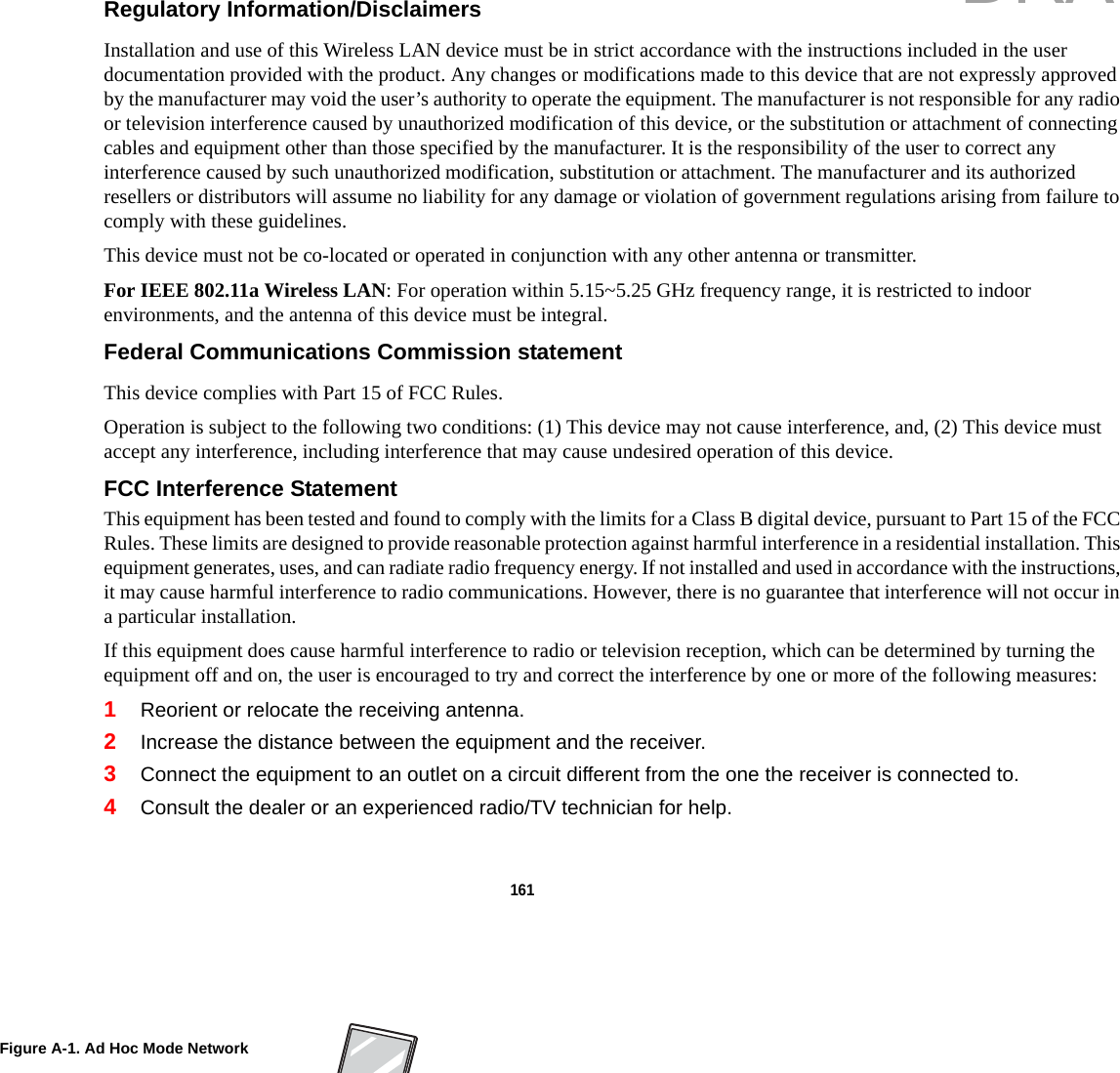
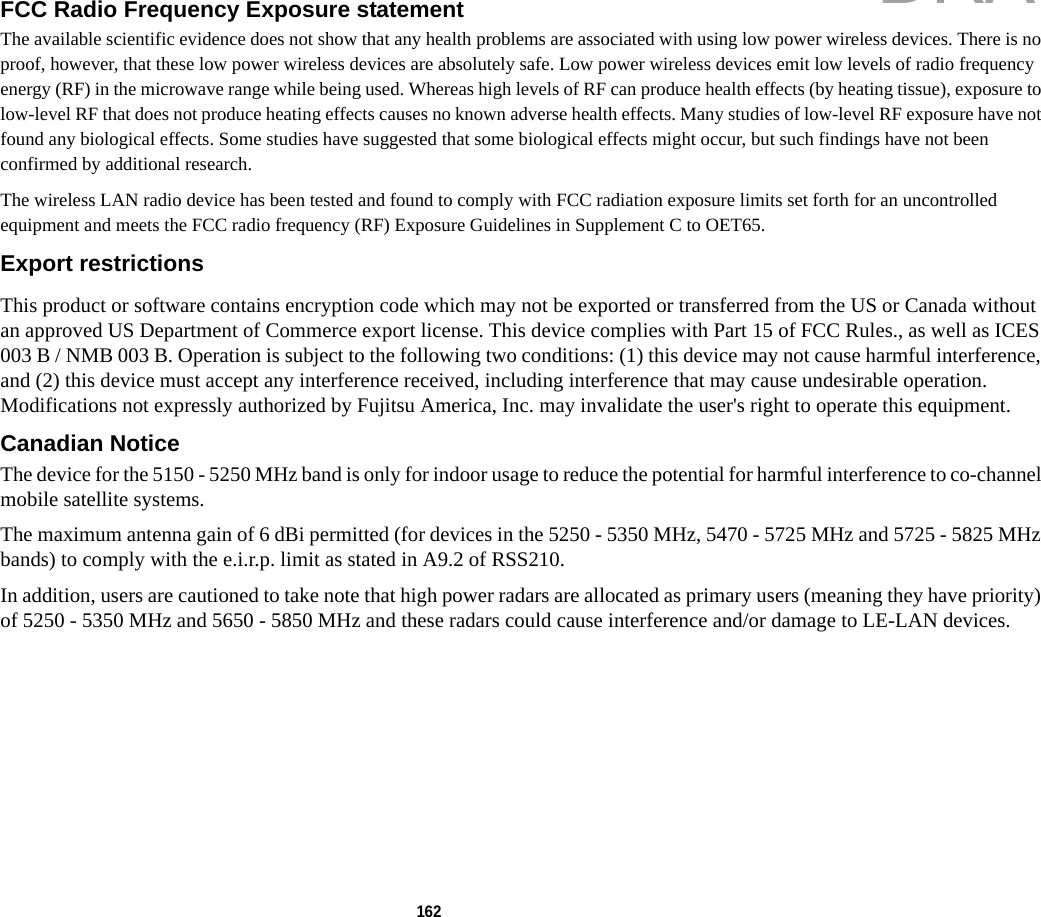
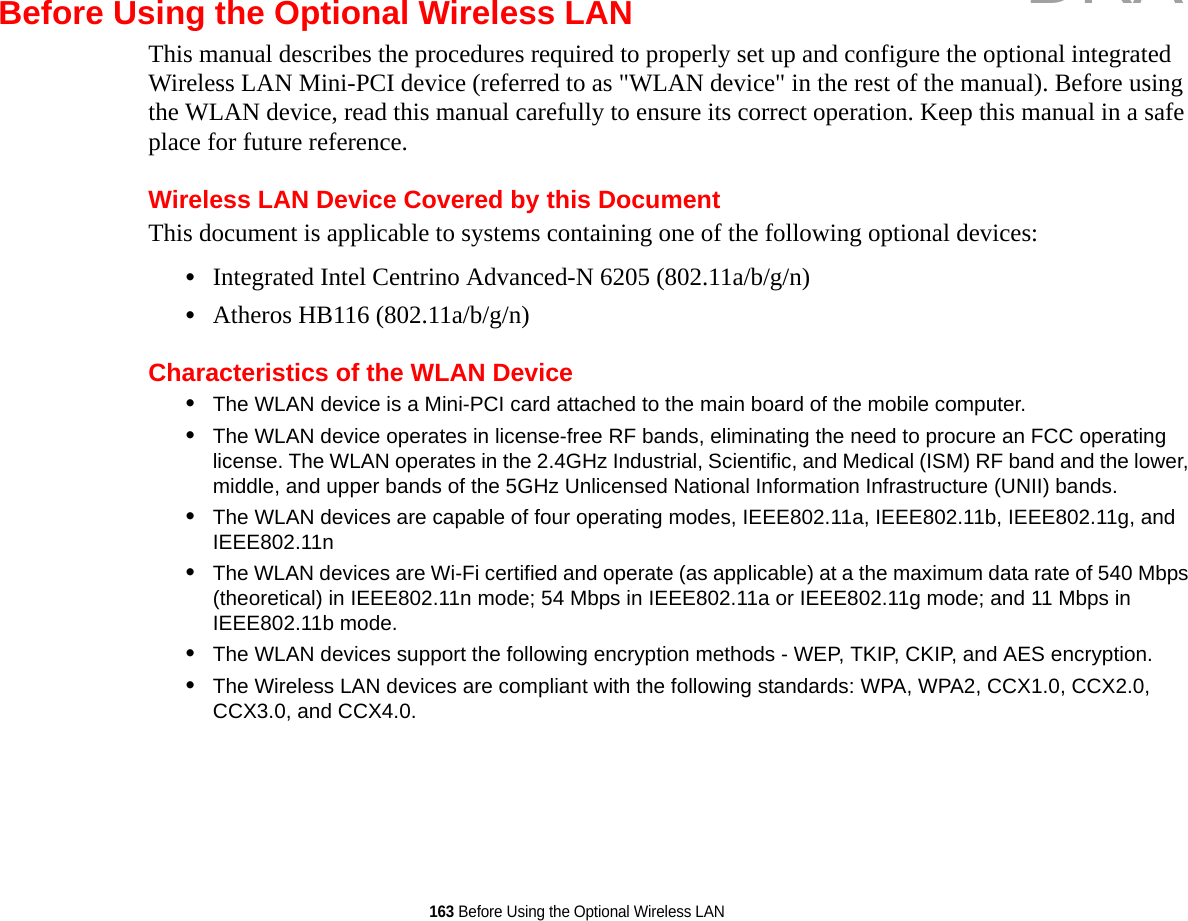
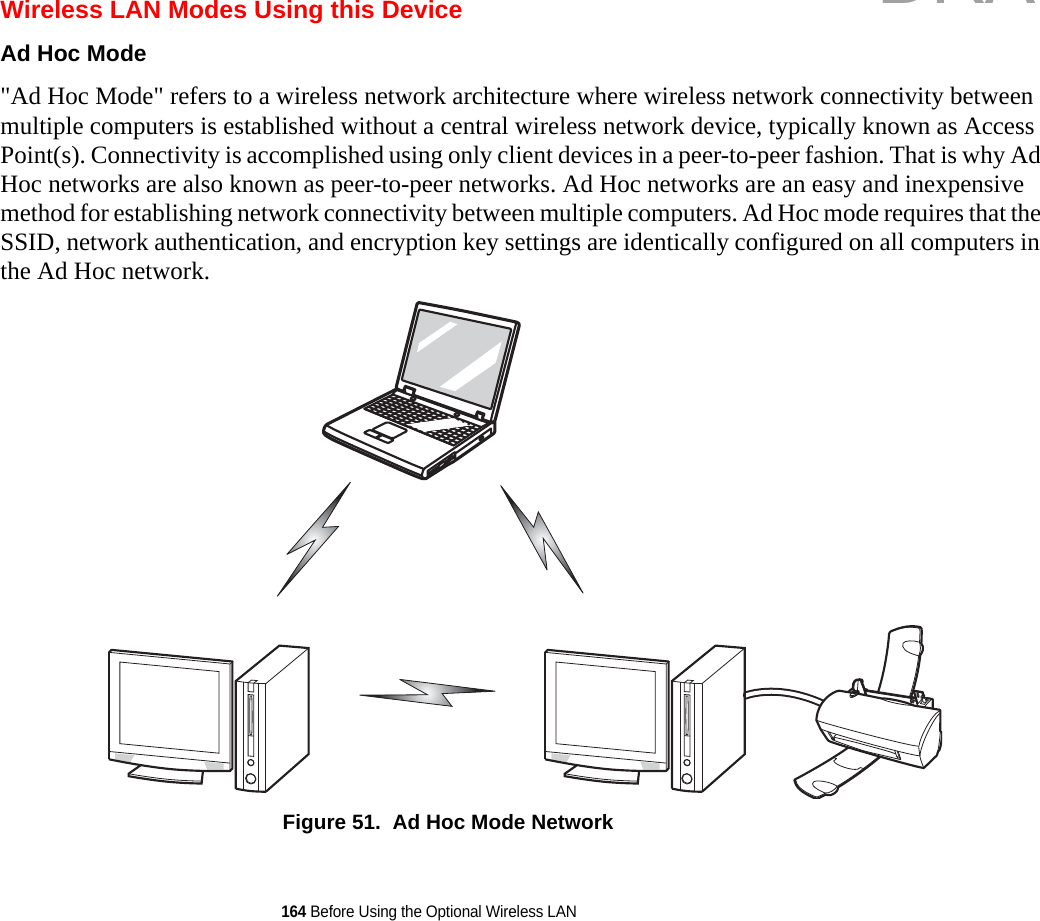
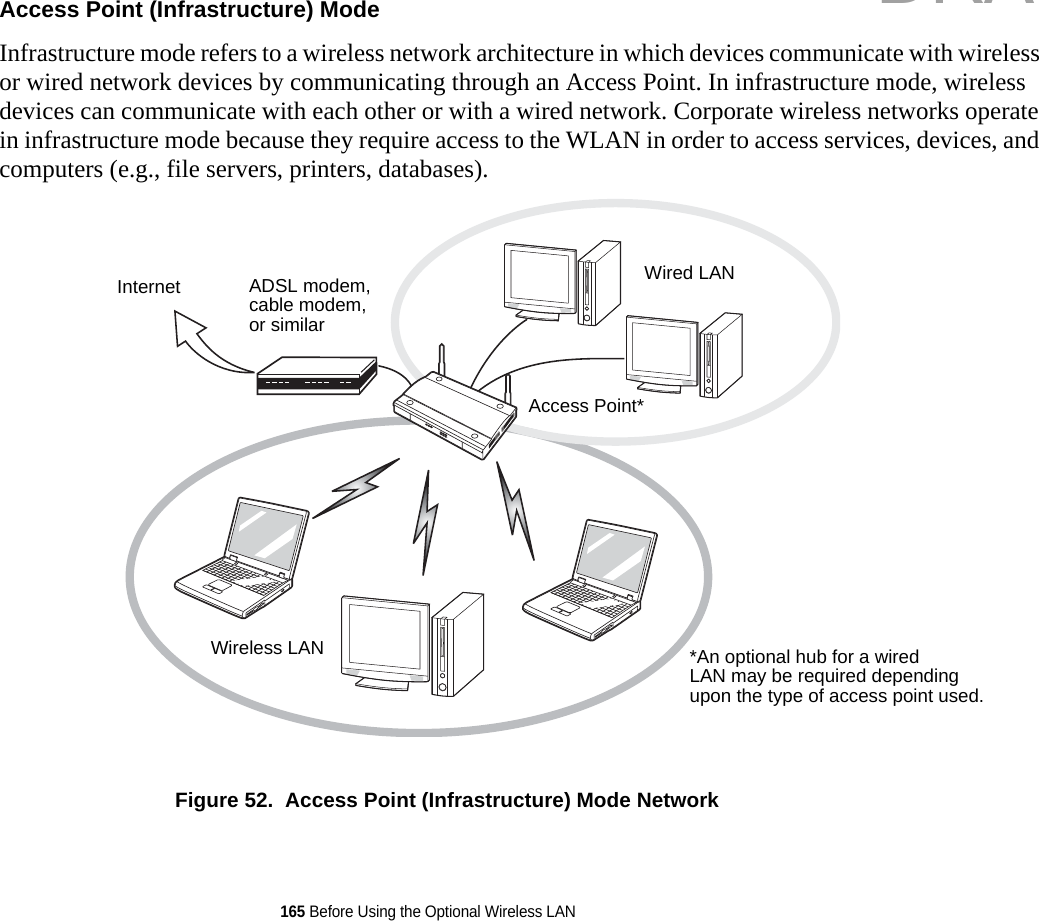
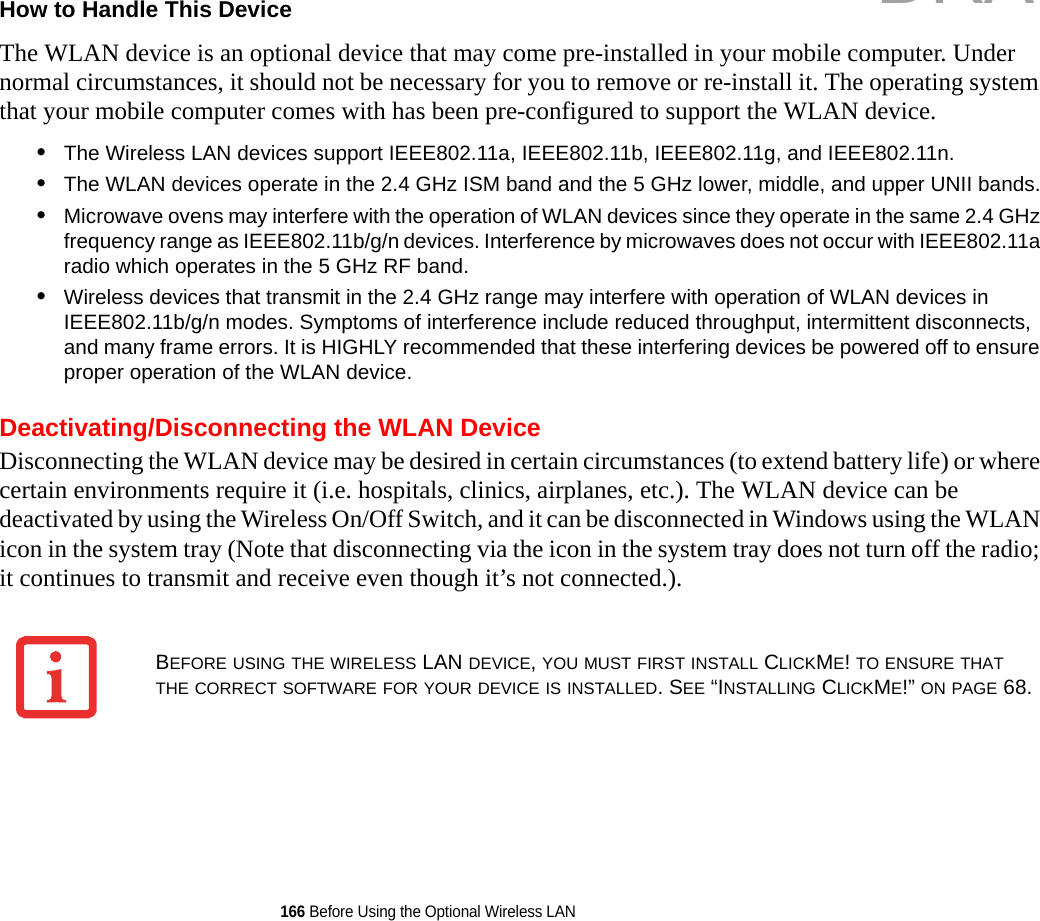
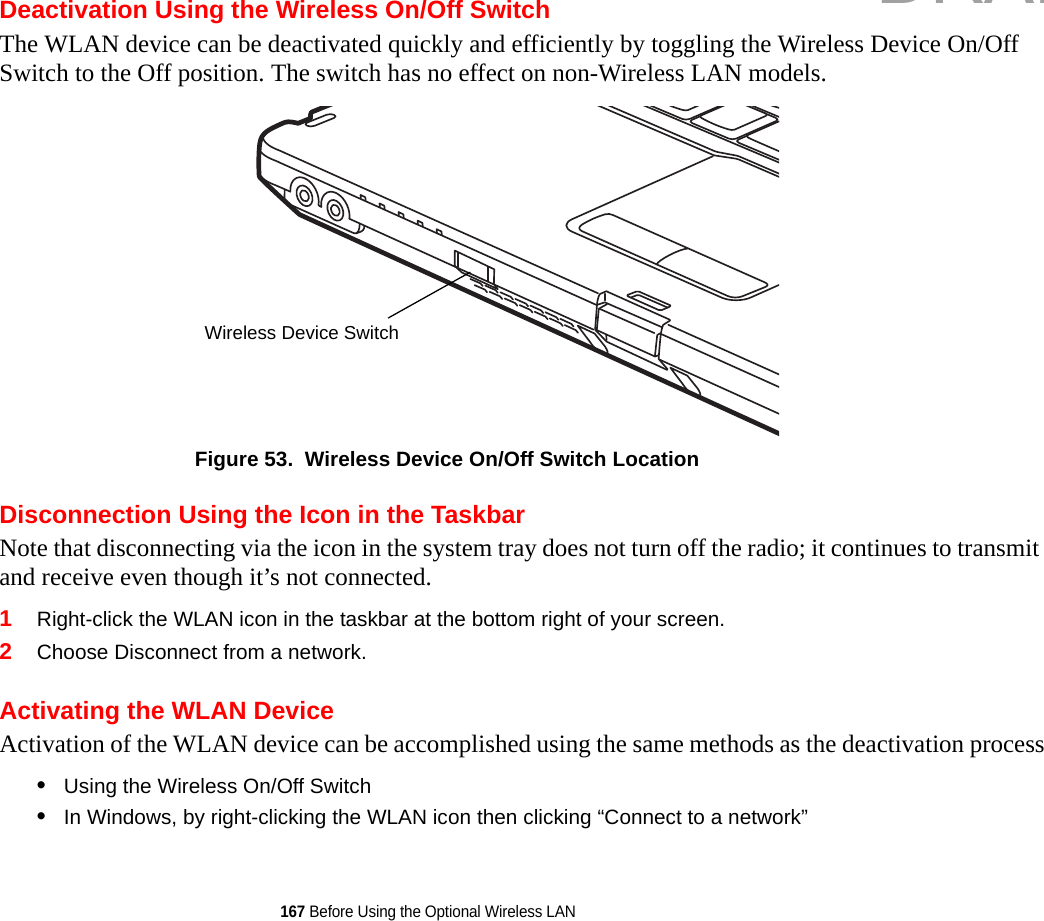
![168 Configuring the Wireless LANConfiguring the Wireless LANThe optional WLAN device can be configured to establish wireless network connectivity using the software that is built into Windows. Support for most industry standard security solutions is contained in this software.Pre-defined parameters will be required for this procedure. Please consult with your network administrator for these parameters:Configuring the WLAN1Click the Start button, then select Control Panel. (If you are in Windows Vista and the Control Panel is not in Classic View, select Classic View from the left panel.)2Double-click the Network and Sharing Center icon.3Select “Manage wireless networks” from the left panel.4Click on the [Add] button.5Depending upon what type of connection you would like to make, make a selection. For an infrastructure network, select “Manually create a network profile. For ad hoc network, select “Create an ad hoc network”.6Enter the required information. If necessary, consult with your network administrator for some of the information.7In the event you require assistance, go to the Network and Sharing Center window (Start -> Control Panel -> Network and Sharing Center), and type in relevant keywords in the Search box. Connecting to a Network After you have configured your computer, you can connect to an active network by performing the following steps:1Click on the WLAN icon in the system tray.2Select “Connect to a network”.3Select a network from the list that appears, and click the [Connect] button.Connection to the networkAfter you have configured your computer, you can connect to an active network by clicking on the Wireless Network icon in the system tray:DRAFT](https://usermanual.wiki/Fujitsu-Client-Computing/WL0024.Updated-manual/User-Guide-1450965-Page-173.png)
![169 Troubleshooting the WLANTroubleshooting the WLANTroubleshootingCauses and countermeasures for troubles you may encounter while using your wireless LAN are described in the following table. If you are unfamiliar with the steps required, consult your System Administrator or go to [Start] -> Help and Support -> Networking and the WebProblem Possible Cause Possible SolutionUnavailable network connectionIncorrect network name (SSID) or network keyAd hoc connection: verify that the network names (SSID’s) and network keys (WEP) of all computers to be connected have been configured correctly. SSID’s and WEP key values must be identical on each machine.Access Point (Infrastructure) connection: set network name (SSID) and network key to the same values as those of the access point. Set the Network Authentication value identically to that of the Access Point. Please consult your network administrator for this value, if necessary. Weak received signal strength and/or link qualityAd hoc connection: Retry connection after shortening the distance to the destination computer or removing any obstacles for better sight.Access Point (Infrastructure) connection: Retry connection after shortening the distance to the access point or removing any obstacles for better transmission.The WLAN device has been deactivated or disabledCheck if the wireless switch is turned On. Go to Start -> Control Panel, and double-click on Windows Mobility Center. If the wireless network is off, click the [Turn wireless on] button. The computer to be connected is turned offCheck if the computer to be connected is turned ON.DRAFT](https://usermanual.wiki/Fujitsu-Client-Computing/WL0024.Updated-manual/User-Guide-1450965-Page-174.png)
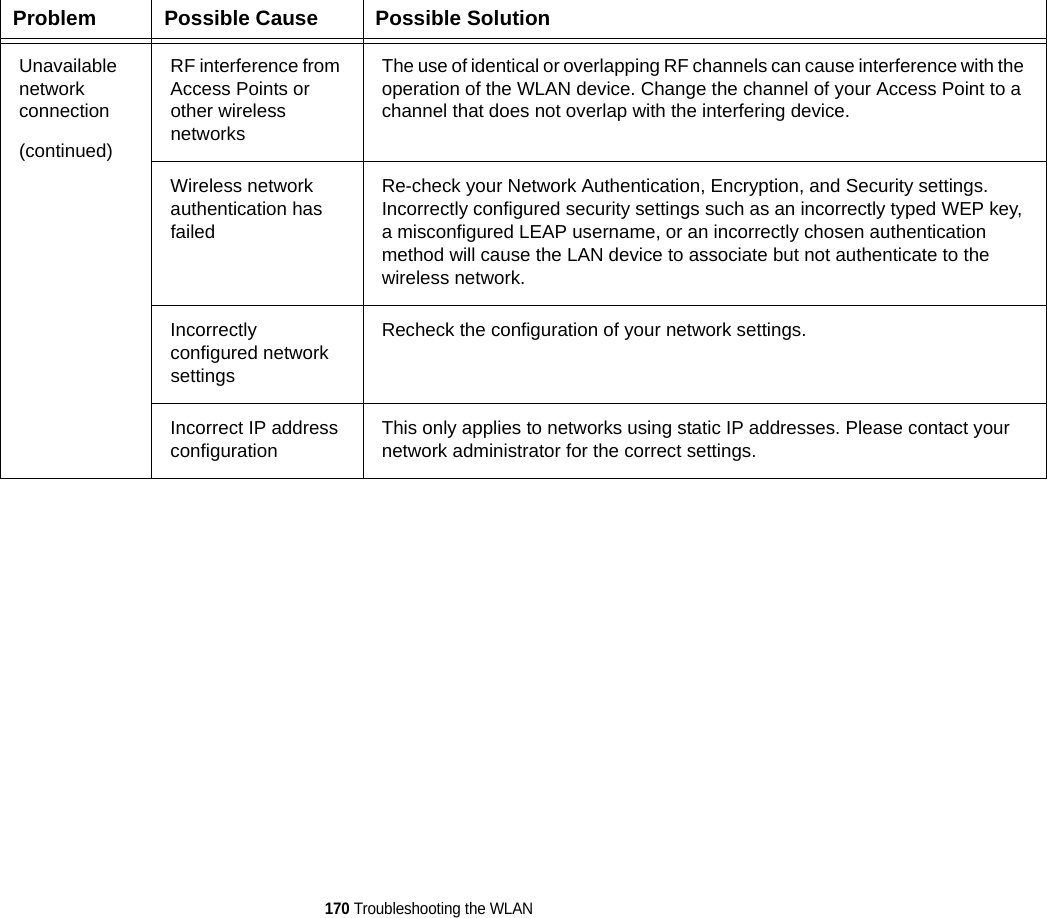
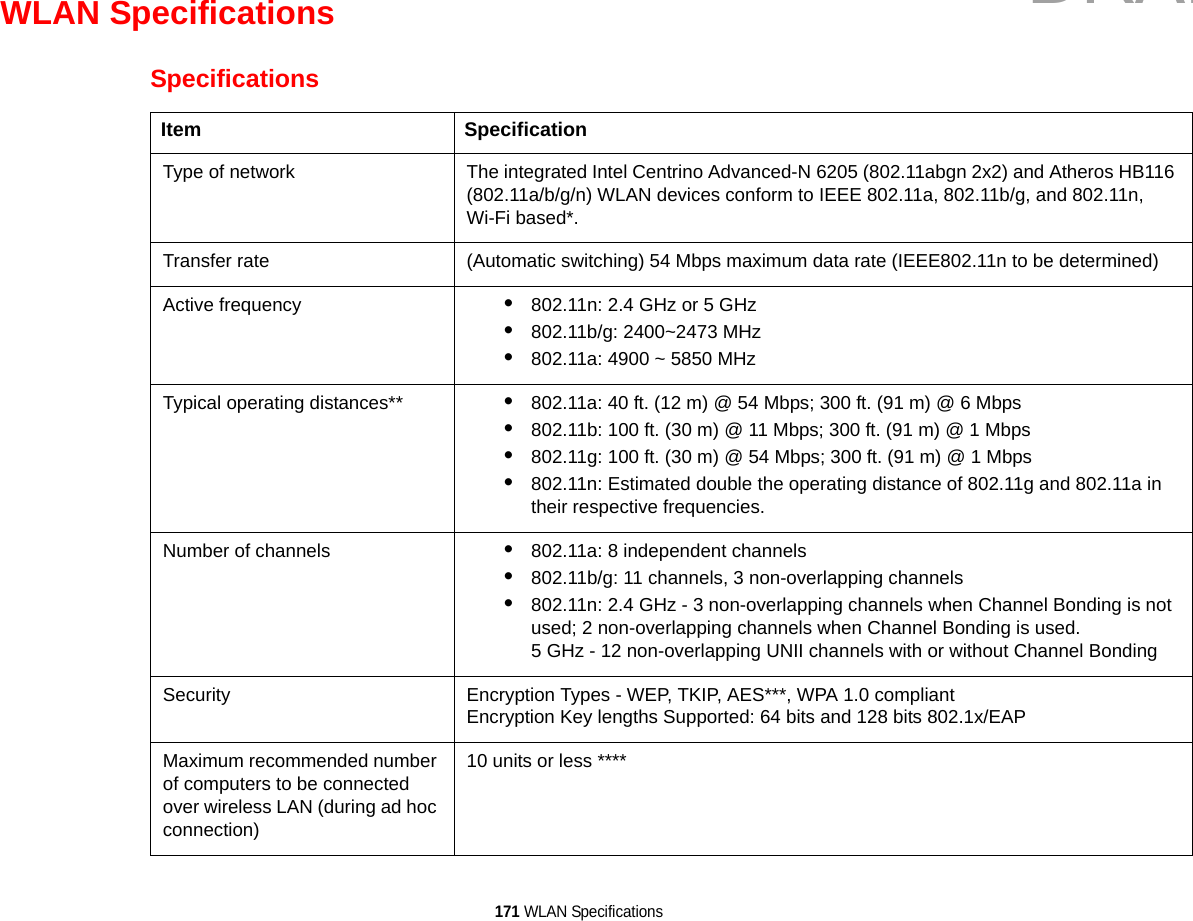
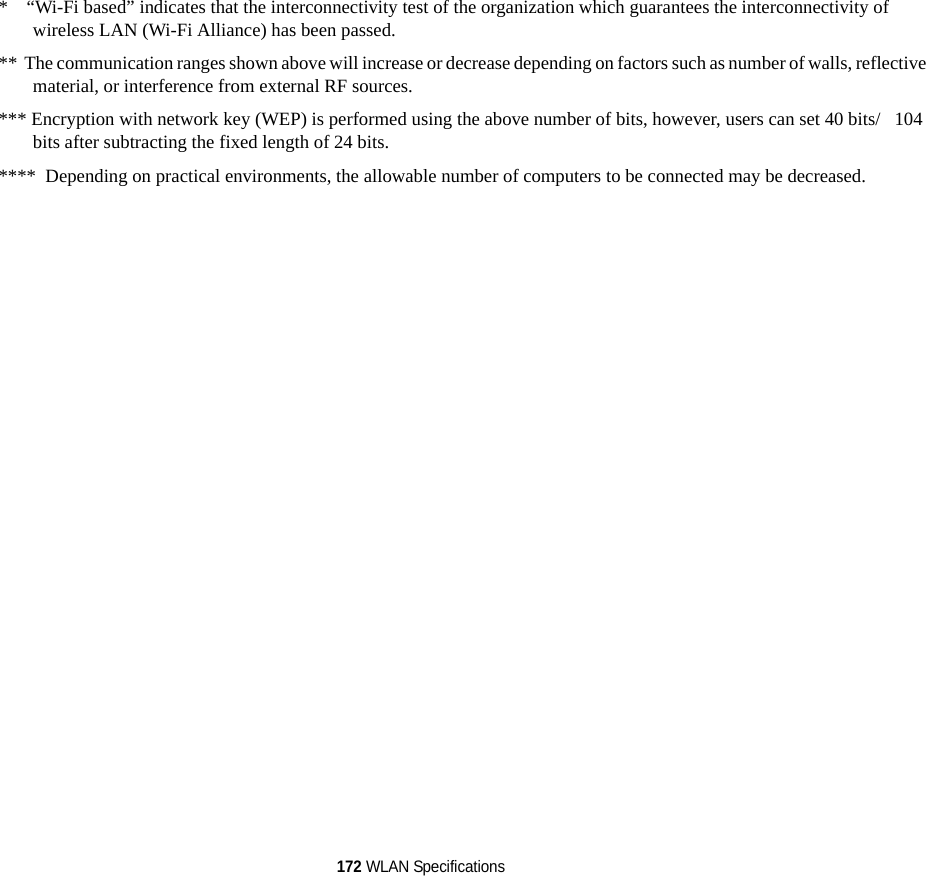
![173 Using the Bluetooth DeviceUsing the Bluetooth DeviceThe Integrated Bluetooth module (EYSMJCS) is a wireless device installed in selected Fujitsu mobile computers. What is BluetoothBluetooth technology is designed as a short-range wireless link between mobile devices, such as laptop computers, phones, printers, and cameras. Bluetooth technology is used to create Personal Area Networks (PANs) between devices in short-range of each other. Where to Find Information About BluetoothThe Bluetooth module contains a robust Help user’s guide to assist you in learning about operation of the Bluetooth device.To access the Help file, click [Start] -> All Programs, and click on Bluetooth, then select User’s Guide.For additional information about Bluetooth Technology, visit the Bluetooth Web site at: www.bluetooth.com.THE WIRELESS LAN/BLUETOOTH ON/OFF SWITCH WILL POWER OFF BOTH THE OPTIONAL WIRELESS LAN AND BLUETOOTH DEVICES AT THE SAME TIME. TO ENABLE OR DISABLE EITHER ONE OF THE DEVICES INDIVIDUALLY, PERFORM THE FOLLOWING STEPS:1Slide the Wireless LAN/Bluetooth on/off switch to On position.2Go to Start > All Programs > Bluetooth.3Click on Options under the Bluetooth menu and click on the Bluetooth Radio Power button. 4Click [OK].DRAFT](https://usermanual.wiki/Fujitsu-Client-Computing/WL0024.Updated-manual/User-Guide-1450965-Page-178.png)
![174 Using the Bluetooth DeviceFCC Radiation Exposure Statement This equipment complies with FCC radiation exposure limits set forth for an uncontrolled environment. The internal Bluetooth antenna is located on the left rear corner of the base unit (just behind the [F1]/[F2]/[F3] keys) and is exempt from minimum distance criteria due to its low power. The transmitters in this device must not be co-located or operated in conjunction with any other antenna or transmitter.Canadian Notice To prevent radio interference to the licensed service, this device is intended to be operated indoors and away from windows to provide maximum shielding. Equipment (or its transmit antenna) that is installed outdoors is subject to licensing.Warranty Users are not authorized to modify this product. Any modifications invalidate the warranty.This equipment may not be modified, altered, or changed in any way without signed written permission from Fujitsu. Unauthorized modification will void the equipment authorization from the FCC and Industry Canada and the warranty.DRAFT](https://usermanual.wiki/Fujitsu-Client-Computing/WL0024.Updated-manual/User-Guide-1450965-Page-179.png)
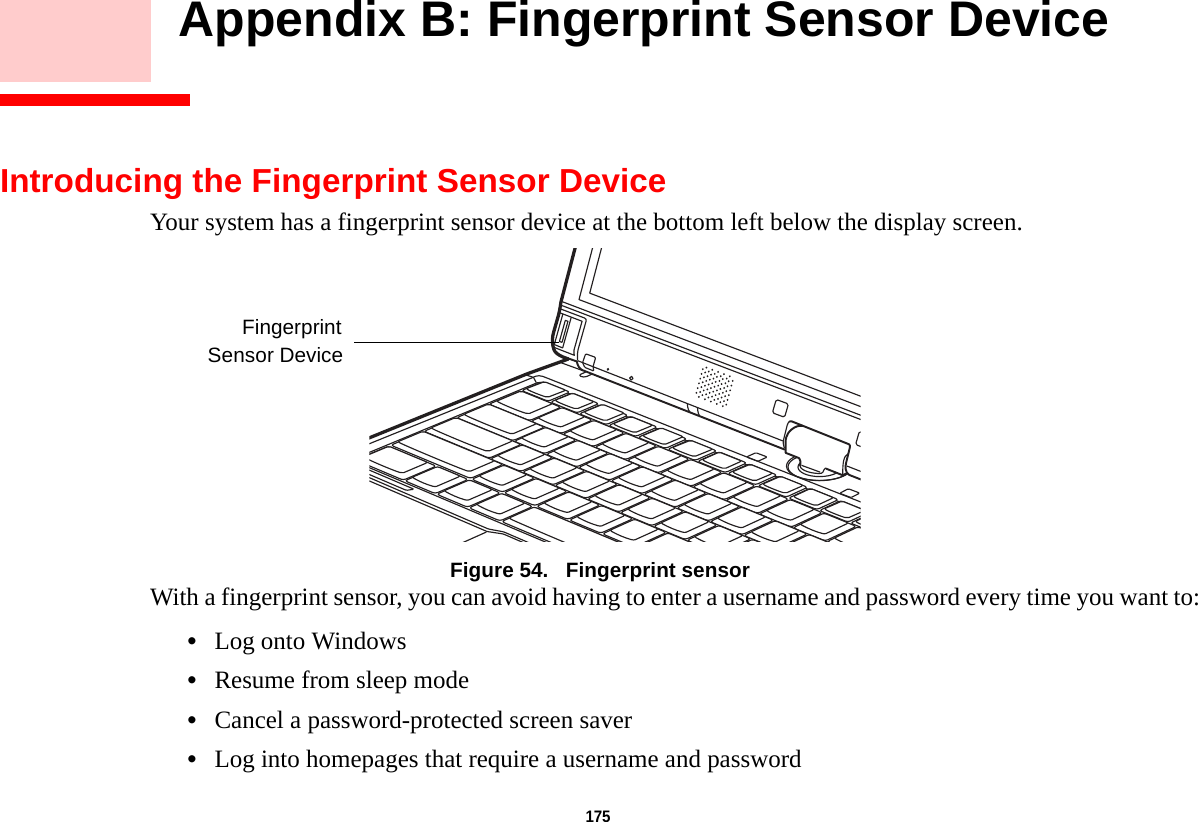
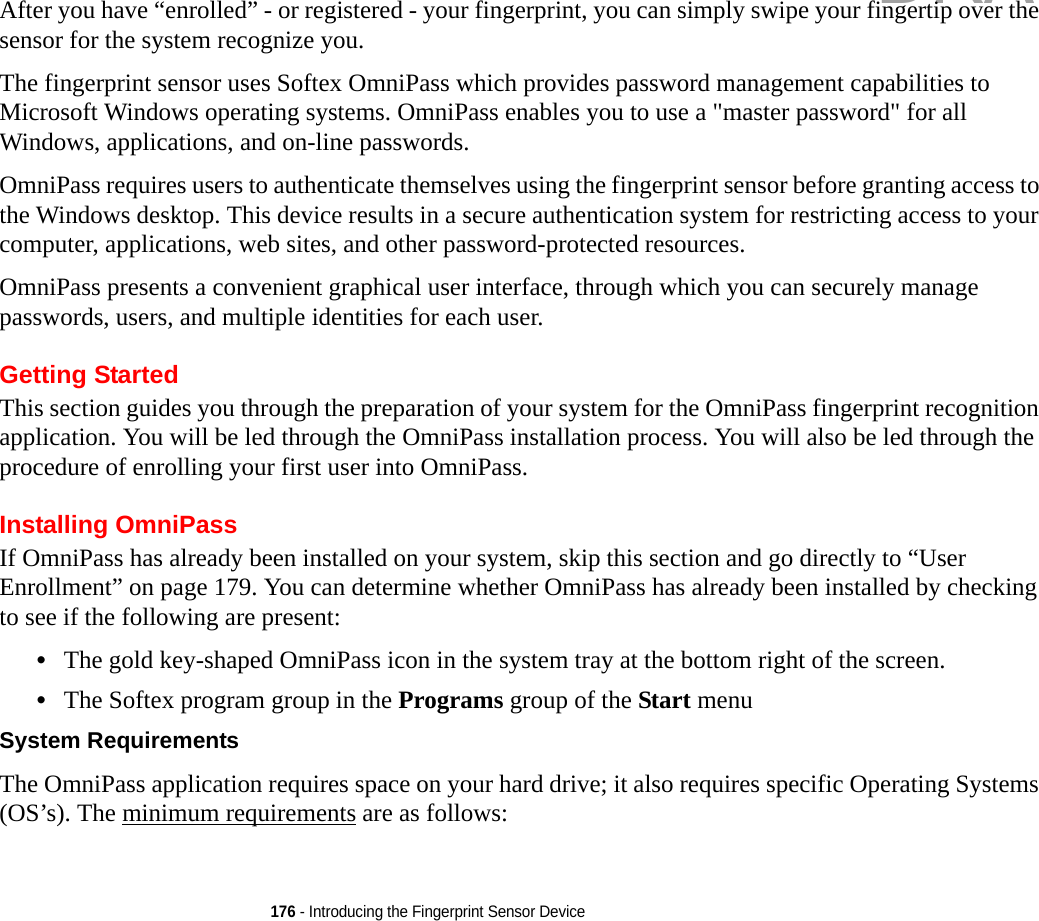
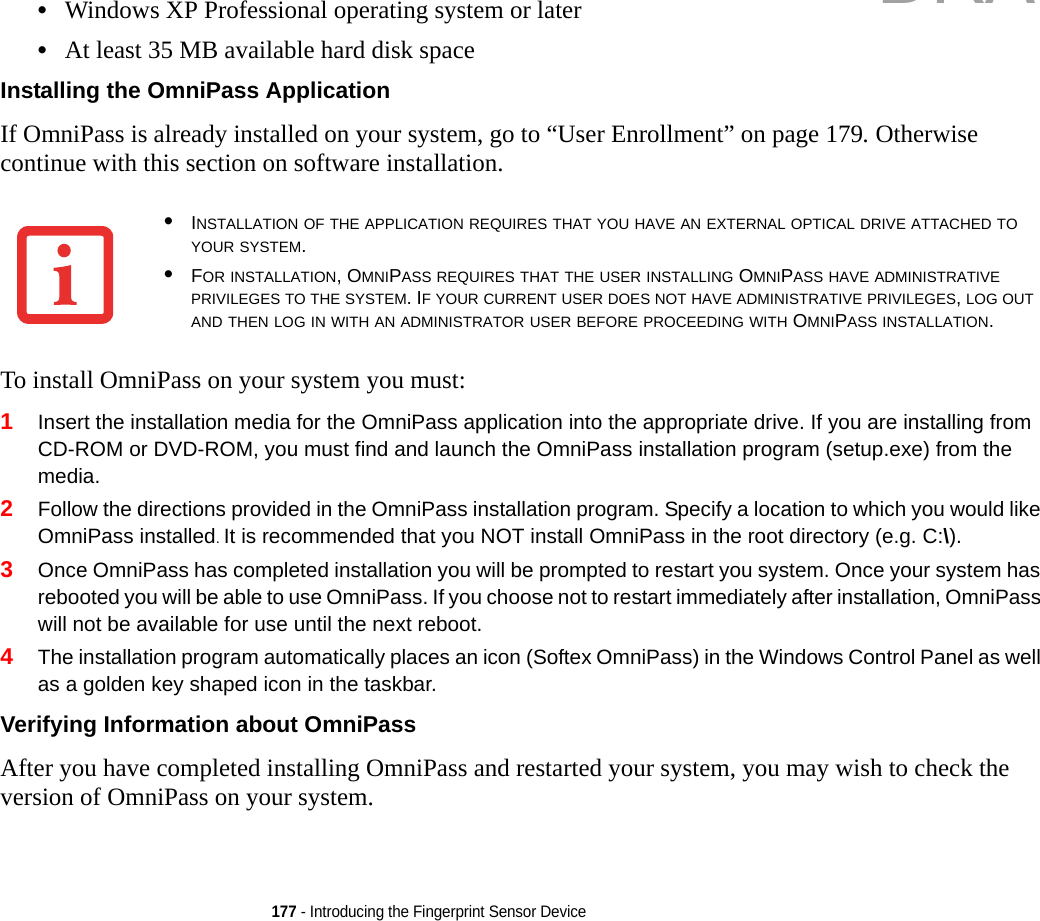
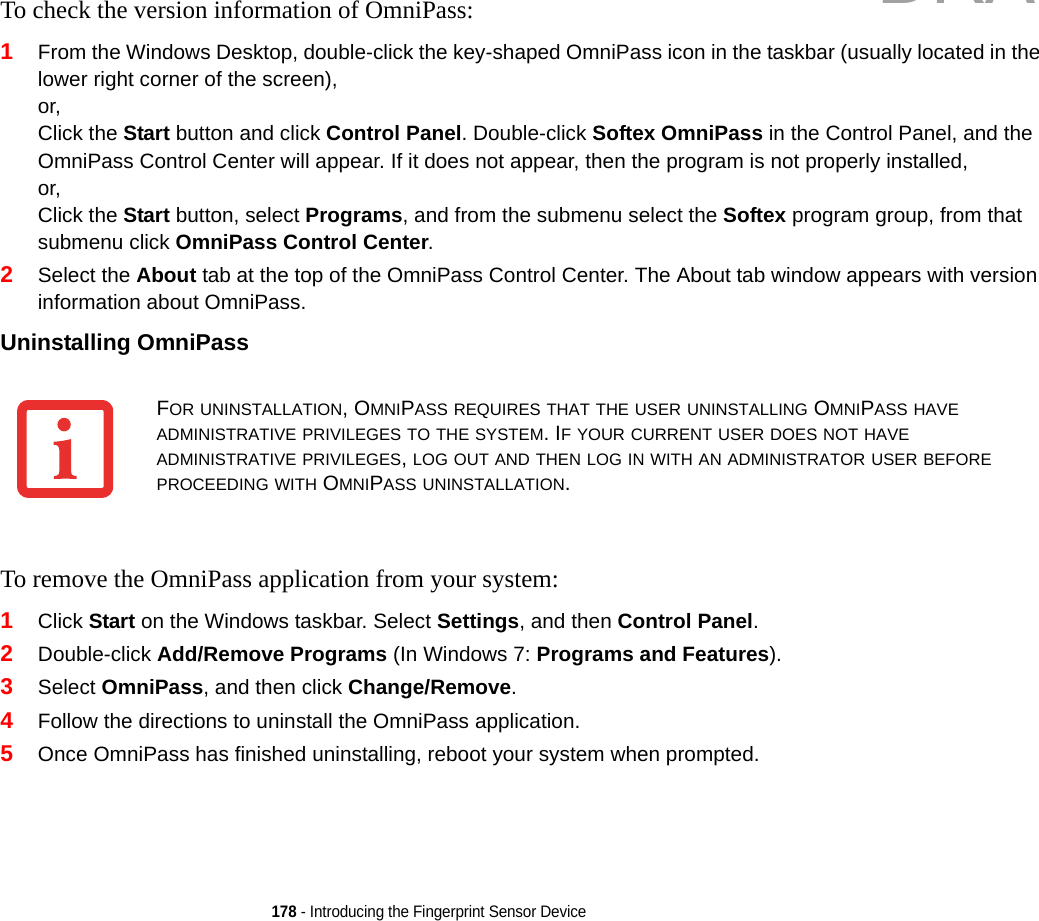
![179 - Introducing the Fingerprint Sensor DeviceUser EnrollmentBefore you can use any OmniPass features you must first enroll a user into OmniPass.Master Password Concept Computer resources are often protected with passwords. Whether you are logging into your computer, accessing email, e-banking, paying bills online, or accessing network resources, you often have to supply credentials to gain access. This can result in dozens of sets of credentials that you have to remember.During user enrollment a "master password” is created for the enrolled user. This master password “replaces” all other passwords for sites you register with OmniPass. Example: A user, John, installs OmniPass on his system (his home computer) and enrolls an OmniPass user with username “John_01” and password “freq14”. He then goes to his webmail site to log onto his account. He inputs his webmail credentials as usual (username “John_02” and password “lifebook”), but instead of clicking [Submit], he directs OmniPass to Remember Password. Now whenever he returns to that site, OmniPass will prompt him to supply access credentials. John enters his OmniPass user credentials (“John_01” and “freq14”) in the OmniPass authentication prompt, and he is allowed into his webmail account. He can do this with as many web sites or password protected resources he likes, and he will gain access to all those sites with his OmniPass user credentials (“John_01” and “freq14”). This is assuming he is accessing those sites with the system onto which he enrolled his OmniPass user. OmniPass does not actually change the credentials of the password protected resource. If John goes to another computer without he OmniPass account to access his webmail, he would need to enter his original webmail credentials (“John_02” and “lifebook”) to gain access. If he attempts his OmniPass user credentials on a system other than a system he’s enrolled on, he will not gain access.THE ENROLLMENT PROCEDURE ASSUMES YOU HAVE NO HARDWARE AUTHENTICATION DEVICES OR ALTERNATE STORAGE LOCATIONS THAT YOU WISH TO INTEGRATE WITH OMNIPASS. IF YOU DESIRE SUCH FUNCTIONALITY, CONSULT THE APPROPRIATE SECTIONS OF THIS DOCUMENT.DRAFT](https://usermanual.wiki/Fujitsu-Client-Computing/WL0024.Updated-manual/User-Guide-1450965-Page-184.png)
![180 - Introducing the Fingerprint Sensor DeviceBasic Enrollment The Enrollment Wizard will guide you through the process of enrolling a user. Unless you specified otherwise, after OmniPass installation the Enrollment Wizard will launch on Windows login. If you do not see the Enrollment Wizard, you can bring it up by clicking Start on the Windows taskbar; select Programs; select Softex; click OmniPass Enrollment Wizard.1Click Enroll to proceed to username and password verification. By default, the OmniPass Enrollment Wizard enters the credentials of the currently logged in Windows user.2Enter the password you use to log in to Windows. This becomes the “master password” for this OmniPass user. In most cases, the Domain: value will be your Windows computer name. In a corporate environment, or when accessing corporate resources, Domain: may not be your Windows computer name. Click [Next] to continue.3In this step OmniPass captures your fingerprint. See “Enrolling a Fingerprint” on page 180 for more information.4Next, choose how OmniPass notifies you of various events. We recommend you keep Taskbar Tips on Beginner mode taskbar tips and Audio Tips on at least Prompt with system beeps only until you get accustomed to how OmniPass operates. Click [Next] to proceed with user enrollment. You will then see a Congratulations screen indicating your completion of user enrollment.5Click [Done] to exit the OmniPass Enrollment Wizard. You will be asked if you’d like to log in to OmniPass with your newly enrolled user; click [Yes].Enrolling a Fingerprint Enrolling a fingerprint increases the security of your system and streamlines the authentication procedure. You enroll fingerprints in the OmniPass Control Center. With an OmniPass user logged in, double-click the system tray OmniPass icon. Select the User Settings tab and click Enrollment under the User Settings area. Click Enroll Authentication Device and authenticate at the authentication prompt to start device enrollment.1During initial user enrollment, you will be prompted to select the finger you wish to enroll. Fingers that have already been enrolled will be marked by a green check. The finger you select to enroll at this time will be marked by a red arrow. OmniPass will allow you re-enroll a finger. If you choose a finger that has already been enrolled and continue enrollment, OmniPass will enroll the fingerprint, overwriting the old fingerprint. Select a finger to enroll and click [Next].DRAFT](https://usermanual.wiki/Fujitsu-Client-Computing/WL0024.Updated-manual/User-Guide-1450965-Page-185.png)
![181 - Introducing the Fingerprint Sensor Device2It is now time for OmniPass to capture your selected fingerprint. It may take a several capture attempts before OmniPass acquires your fingerprint. Should OmniPass fail to acquire your fingerprint, or if the capture screen times out, click [Back] to restart the fingerprint enrollment process. Your system has a “swipe” fingerprint sensor. A swipe sensor is small and resembles a skinny elongated rectangle. To capture a fingerprint, gently swipe or pull your fingertip over the sensor (starting at the second knuckle) towards yourself. Swiping too fast or too slow will result in a failed capture. The Choose Finger screen has a [Practice] button; click it to practice capturing your fingerprint. When you are comfortable with how your fingerprint is captured, proceed to enroll a finger.3Once OmniPass has successfully acquired the fingerprint, the Verify Fingerprint screen will automatically appear. To verify your enrolled fingerprint, place your fingertip on the sensor and hold it there as if you were having a fingerprint captured. Successful fingerprint verification will show a green fingerprint in the capture window and the text Verification Successful under the capture window.Using OmniPassYou are ready to begin using OmniPass. Used regularly, OmniPass will streamline your authentications.Password Replacement You will often use the password replacement function. When you go to a restricted access website (e.g., your bank, your web-based email, online auction or payment sites), you are always prompted to enter your login credentials. OmniPass can detect these prompts and you can teach OmniPass your login credentials. The next time you go to that website, you can authenticate with your fingerprint to gain access.OmniPass Authentication Toolbar After installing OmniPass and restarting, you will notice a dialog you have not seen before at Windows Logon. This is the OmniPass Authentication Toolbar, and it is displayed whenever the OmniPass authentication system is invoked. The OmniPass authentication system may be invoked frequently: during Windows Logon, during OmniPass Logon, when unlocking your workstation, when resuming from sleep or hibernate, when unlocking a password-enabled screensaver, during password replacement for remembered site or application logins, and more. When you see this toolbar, OmniPass is prompting you to authenticate.DRAFT](https://usermanual.wiki/Fujitsu-Client-Computing/WL0024.Updated-manual/User-Guide-1450965-Page-186.png)
![182 - Introducing the Fingerprint Sensor DeviceThe Logon Authentication window indicates what OmniPass-restricted function you are attempting. The icons in the lower left (fingerprint and key) show what authentication methods are available to you. Selected authentication methods are highlighted while unselected methods are not. When you click the icon for an unselected authentication method, the authentication prompt associated with that method is displayed.When prompted to authenticate, you must supply the appropriate credentials: an enrolled finger for the fingerprint capture window or your master password for the master password prompt (the key icon).Remembering a Password OmniPass can remember any application, GUI, or password protected resource that has a password prompt.Using the following procedure, you can store a set of credentials into OmniPass. These credentials will then be linked to your “master password” or fingerprint.Go to a site that requires a login (username and password), but do not log in yet. At the site login prompt, enter your username and password in the prompted fields, but do not enter the site (do not hit [Enter], [Submit], [OK], or Login). Right-click the OmniPass system tray icon and select Remember Password from the submenu. The Windows arrow cursor will change to a golden key OmniPass cursor. Click the OmniPass cursor in the login prompt area, but don’t click [Login] or [Submit].Associating a Friendly Name After clicking the OmniPass key cursor near the login prompt, OmniPass will prompt you to enter a “friendly name” for this site. You should enter something that reminds you of the website, the company, or the service you are logging into. In its secure database, OmniPass associates this friendly name with this website.Additional Settings for Remembering a Site When OmniPass prompts you to enter a “friendly name” you have the opportunity to set how OmniPass authenticates you to this site. There are three settings for how OmniPass handles a remembered site.DRAFT](https://usermanual.wiki/Fujitsu-Client-Computing/WL0024.Updated-manual/User-Guide-1450965-Page-187.png)
![183 - Introducing the Fingerprint Sensor DeviceThe default setting is Automatically click the “OK” or “Submit” button for this password protected site once the user is authenticated. With this setting, each time you navigate to this site OmniPass will prompt you for your master password or fingerprint authentication device. Once you have authenticated with OmniPass, you will automatically be logged into the site. Less secure is the option to Automatically enter this password protected site when it is activated. Do not prompt for authentication. Check the upper box to get this setting, and each time you navigate to this site OmniPass will log you into the site without prompting you to authenticate.If you uncheck both boxes in Settings for this Password Site, OmniPass will prompt you for your master password or fingerprint authentication device. Once you have authenticated with OmniPass your credentials will be filled in to the site login prompt, but you will have to click the website [OK], [Submit], or [Login] button to gain access to the site. Click Finish to complete the remember password procedure. The site location, the credentials to access the site, and the OmniPass authentication settings for the site are now stored in the OmniPass secure database. The OmniPass authentication settings (Settings for this Password Site) can always be changed in Vault Management.Logging in to a Remembered Site Whether or not OmniPass prompts you to authenticate when you return to a remembered site is determined by Settings for this Password Site and can be changed in Vault Management. The following cases are applicable to using OmniPass to login to: Windows, remembered web sites, and all other password protected resources.THIS SETTING IS MORE CONVENIENT IN THAT WHENEVER YOU GO TO A SITE REMEMBERED WITH THIS SETTING, YOU WILL BYPASS ANY AUTHENTICATION PROCEDURE AND GAIN INSTANT ACCESS TO THE SITE. BUT SHOULD YOU LEAVE YOUR SYSTEM UNATTENDED WITH YOUR OMNIPASS USER LOGGED IN, ANYONE USING YOUR SYSTEM CAN BROWSE TO YOUR PASSWORD PROTECTED SITES AND GAIN AUTOMATIC ACCESS.DRAFT](https://usermanual.wiki/Fujitsu-Client-Computing/WL0024.Updated-manual/User-Guide-1450965-Page-188.png)
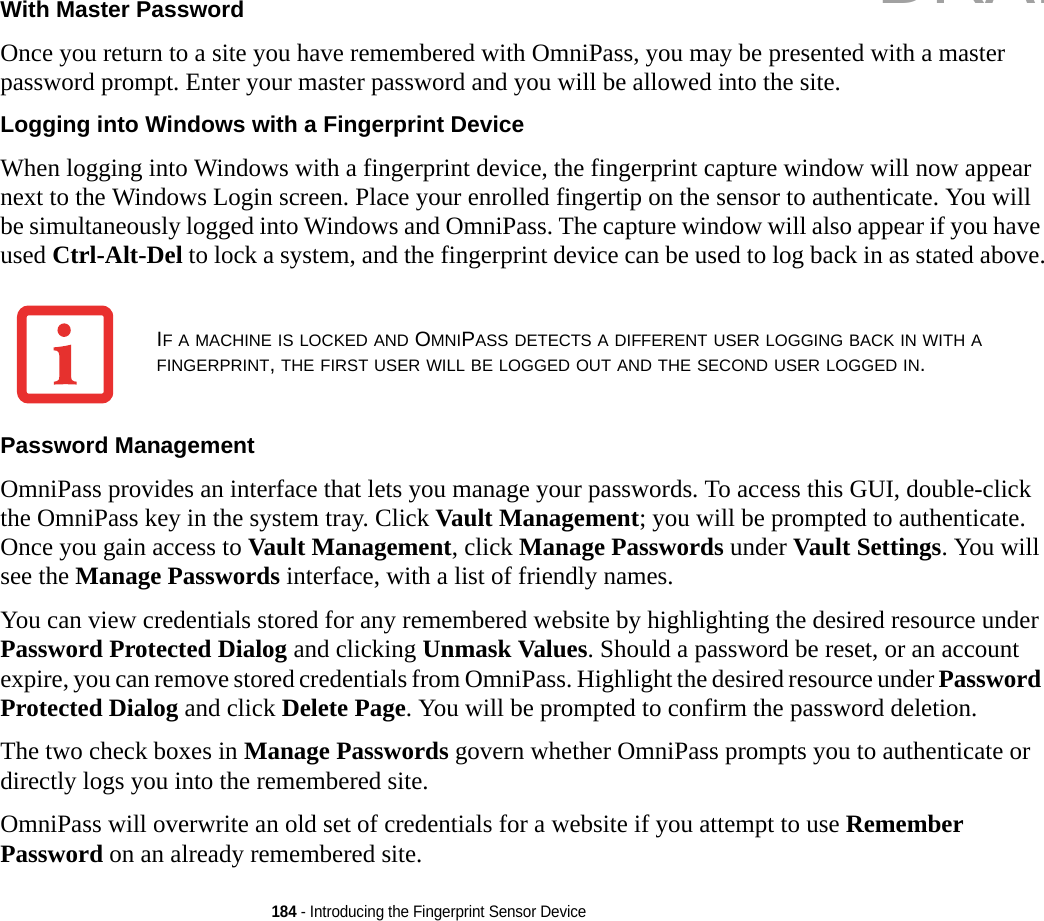
![185 - Introducing the Fingerprint Sensor DeviceThe exception to the above rule is when resetting the Windows password. If your password is reset in Windows, the next time you login to Windows, OmniPass will detect the password change and prompt you to “Update” or “Reconfirm” the password with OmniPass. Enter your new Windows password in the prompt and click OK. Your OmniPass "master password" will still be your Windows password.OmniPass User Identities Identities allow OmniPass users to have multiple accounts to the same site (e.g., bob@biblomail.com and boballen@biblomail.com). If OmniPass did not provide you identities, you would be limited to remembering one account per site.To create and manage identities, double-click the OmniPass key in the system tray. Click Vault Management; OmniPass will prompt you to authenticate. Once you gain access to Vault Management, click Manage Identities under Vault Settings. You can only manage the identities of the currently logged in OmniPass userTo add a new identity, click New Identity or double-click Click here to add a new identity. Name the new identity and click [OK], then click [Apply]. You can now switch to the new identity and start remembering passwords.To delete an identity, highlight the identity you want to delete and click [Delete Identity], then [Apply].To set the default identity, highlight the identity you want as default and click [Set as Default]; click [Apply] to ensure the settings are saved. If you log in to OmniPass with a fingerprint device, you will automatically be logged in to the default identity for that OmniPass user. You can choose the identity with which you are logging in if you login using "master password".WHEN YOU DELETE AN IDENTITY, ALL OF ITS ASSOCIATED REMEMBERED SITES AND PASSWORD PROTECTED DIALOGS ARE LOST.DRAFT](https://usermanual.wiki/Fujitsu-Client-Computing/WL0024.Updated-manual/User-Guide-1450965-Page-190.png)
![186 - Introducing the Fingerprint Sensor DeviceChoosing User Identity during Login To choose your identity during login, type your username in the User Name: field. Press [Tab] and see that the Domain: field self-populates. Click the Password: field to bring the cursor to it, and you will see the pull-down menu in the Identity: field. Select the identity to login as, then click OK.Switch User Identity To switch identities at any time, right-click the OmniPass system tray icon and click Switch User Identity from the submenu. The Switch Identity dialog will appear. Select the desired identity and then click OK.Identities and Password Management On the Manage Passwords interface of the Vault Management tab of the OmniPass Control Center, there is a pull-down selection box labeled, Identity. This field lets you choose which identity you are managing passwords for. When you select an identity here, only those password protected dialogs that are associated with that identity are shown. You can perform all the functions explained in “Password Management” on page 184.Configuring OmniPassThis section gives an overview of both the Export/Import function and the OmniPass Control Center. Exporting and Importing Users Using OmniPass Control Center, you can export and import users in and out of OmniPass. The export process backs up all remembered sites, credentials, and enrolled fingerprints for an OmniPass user. All OmniPass data for a user is backed up to a single encrypted database file. During the import process, the Windows login of the exported user is required. If the proper credentials cannot be supplied, the user profile will not be imported.YOU CANNOT IMPORT A USER INTO OMNIPASS IF THERE ALREADY IS A USER WITH THE SAME NAME ENROLLED IN OMNIPASS. DRAFT](https://usermanual.wiki/Fujitsu-Client-Computing/WL0024.Updated-manual/User-Guide-1450965-Page-191.png)
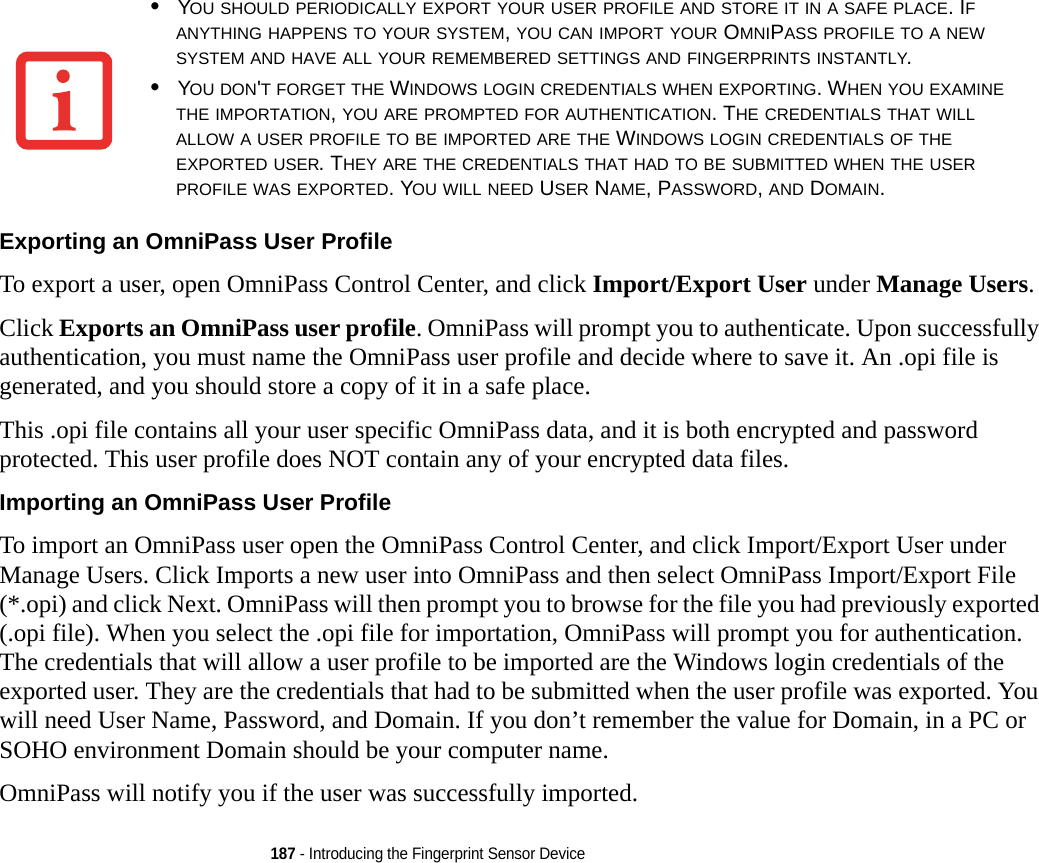
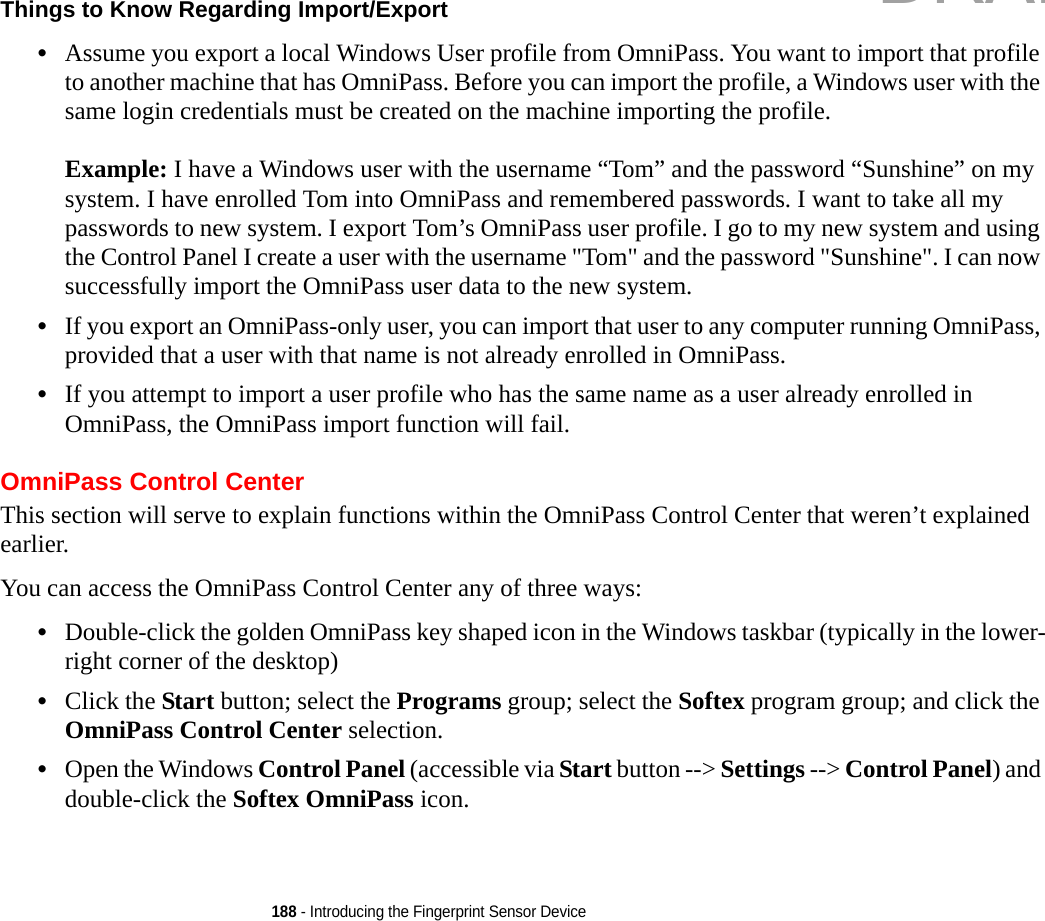
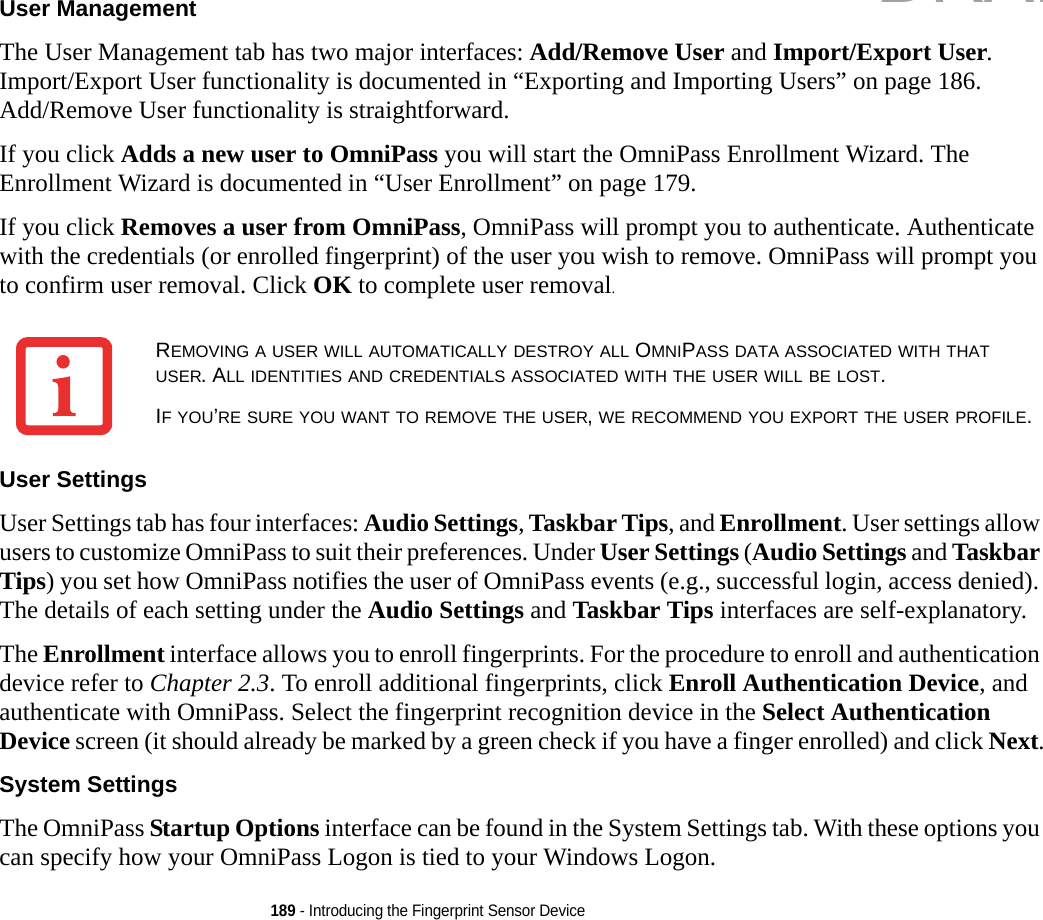
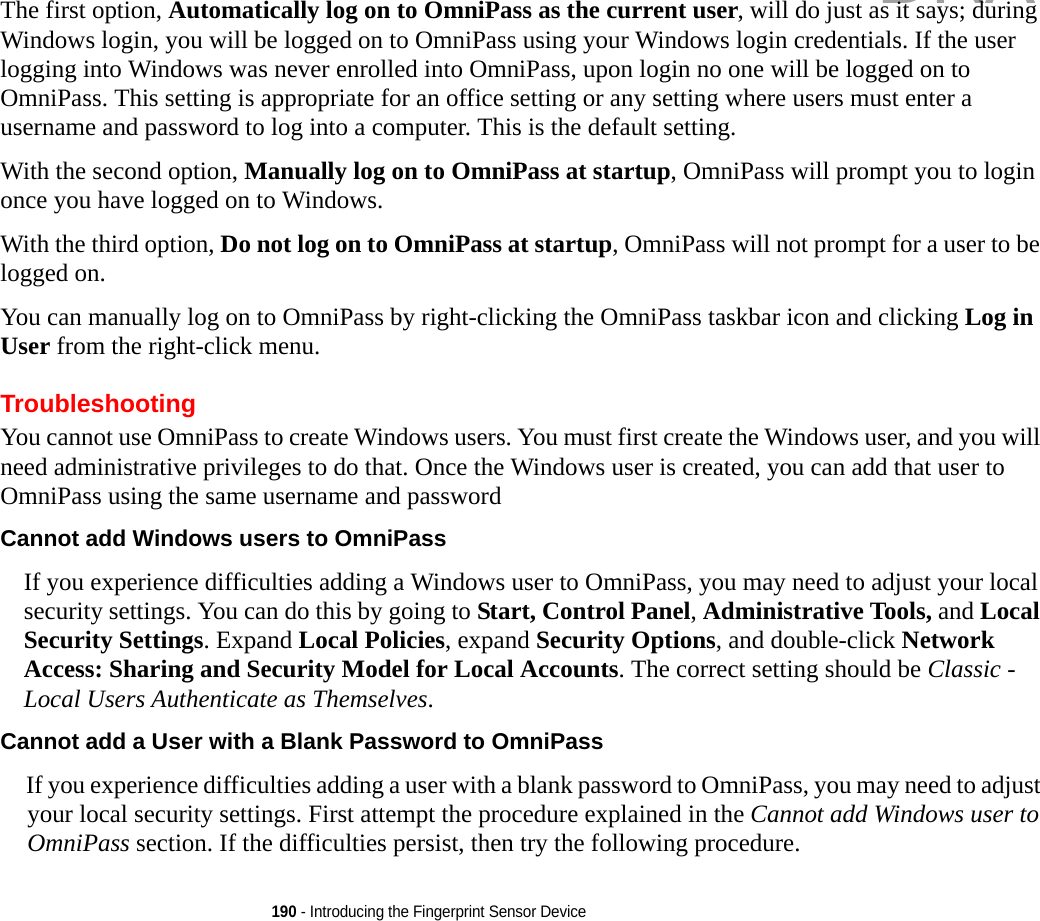
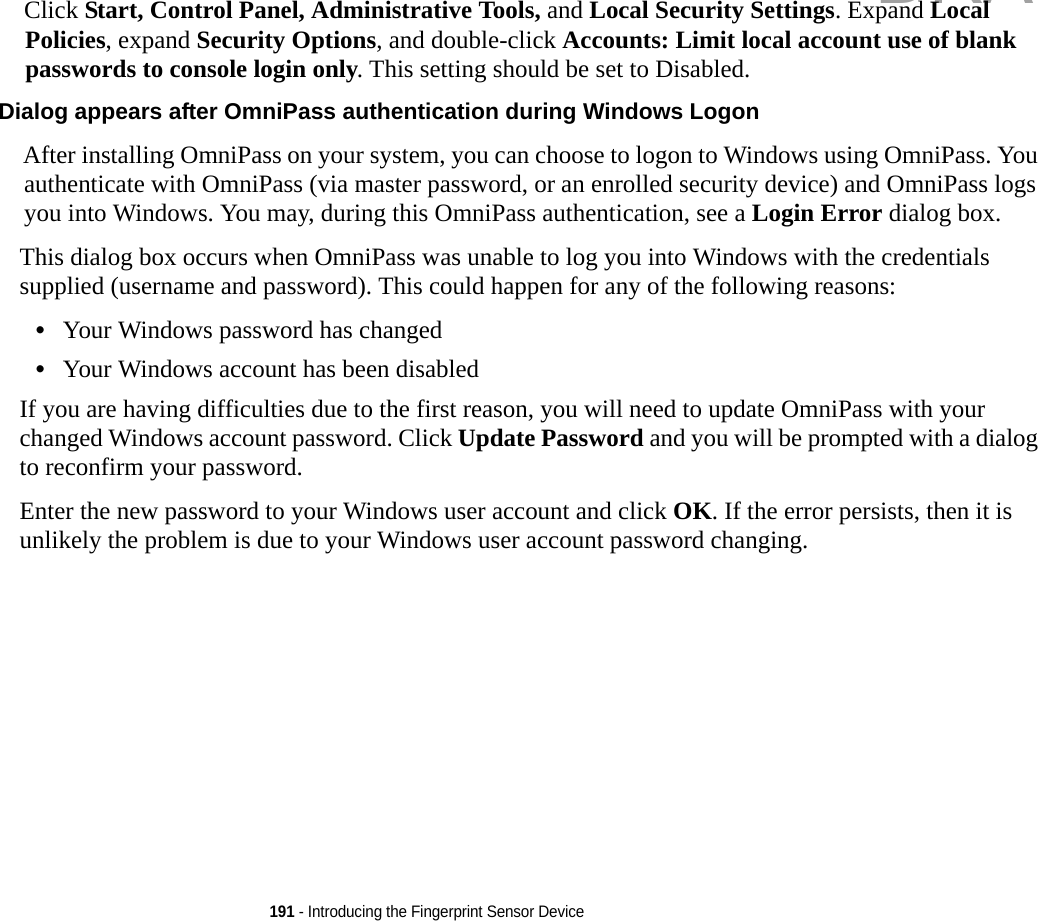
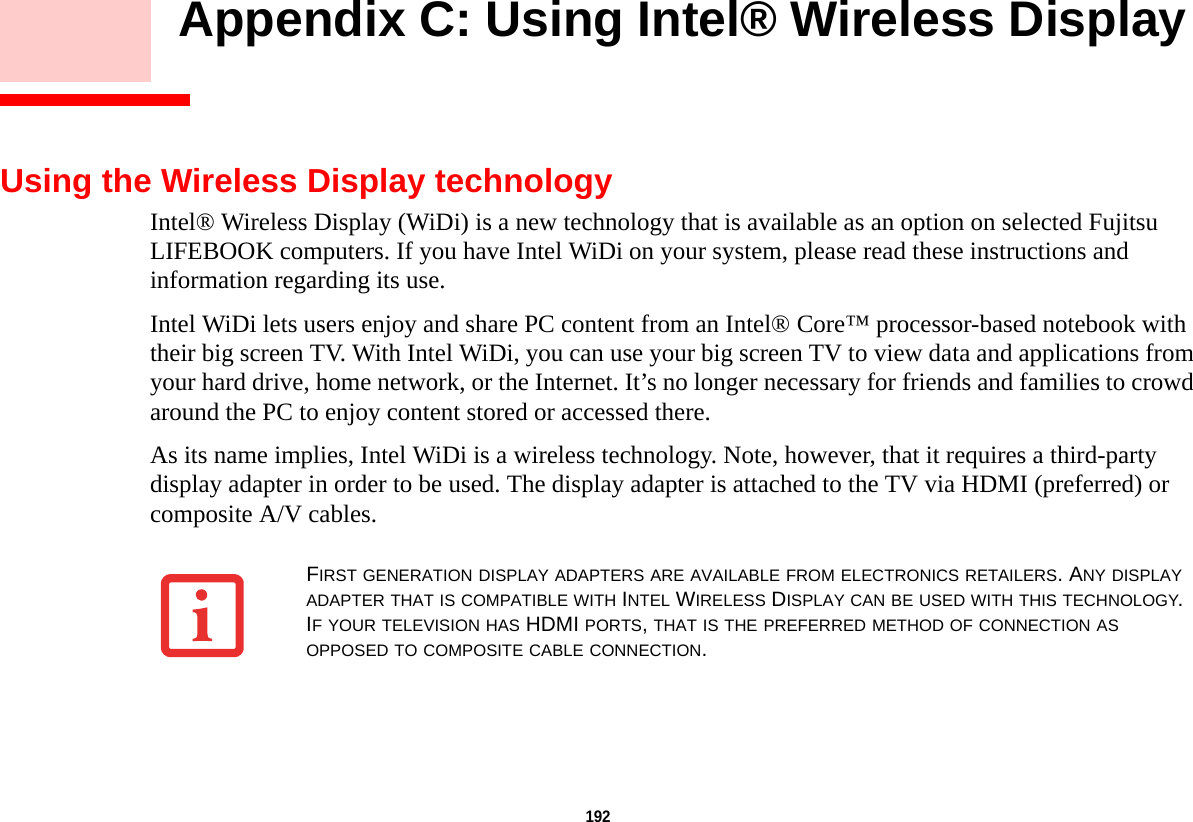
![193 - Using the Wireless Display technologyStarting the WiDi applicationTo launch Intel® Wireless Display, perform the following steps:1Verify that you have a display adapter connected to the television on which you want to use WiDi and turn on the television.2If you haven’t yet turned on the wireless device switch on your notebook, do so now.3Click on the WiDi icon on your desktop or the Start menu shortcut.4The PC content is displayed on the big screen TV.After the initial set-up between the laptop and a compatible display adapter, you can set the adapter as the default to auto-connect. In the future, simply opening the application will automatically connect the two.For detailed information about using and troubleshooting the WiDi technology, click on the WiDi icon then click the [Help] button in the upper right-hand corner to open the Wireless Display Help file.•IF YOU PURCHASED A SYSTEM WITH AN INTEL WIRELESS LAN AND OPTIONAL INTEL WIDI TECHNOLOGY, THE WIDI APPLICATION MAY OR MAY NOT BE PRE-INSTALLED (DEPENDING UPOON YOUR SYSTEM CONFIGURATION). SYSTEMS WITH INTEL WIDI PRE-INSTALLED WILL HAVE A WIDI ICON LOCATED ON THEIR DESKTOP. IF THE ICON IS NOT PRESENT, INTEL WIDI WILL BE INSTALLED AS SOON AS YOU RUN CLICKME.•THE INTEL WIDI TECHNOLOGY WILL ONLY WORK IN COMBINATION WITH AN INTEL WIRELESS LAN.•ONLY WINDOWS MEDIA PLAYER CAN BE USED AS THE MEIA PLAYER FOR WIDI 2.0.•BEFORE USING INTEL WIDI, BE SURE THAT THE SYSTEM’S WIRELESS DEVICE SWITCH IS TURNED ON.•NOTE THAT SECURE CONTENTS ARE NOT SUPPORTED BY INTEL WIDI 2.0. CONTENT REQUIRING OUTPUT PROTECTION SUCH AS BLU-RAY® AND DVD MOVIE PLAYBACK IS NOT SUPPORTED BY WIDI. •THERE MAY BE A SLIGHT TIME LAG WHEN USING WIDI WHEN YOU MOVE THE MOUSE OR TYPE IN CHARACTERS.•THE FIRST TIME YOU USE WIDI, THE DEFAULT DISPLAY RESOLUTION IS 1280X720. IF YOU WOULD LIKE TO CHANGE THE RESOLUTION, GO TO THE CONTROL PANEL -> DISPLAY PROPERTIES UNDER THE SETTINGS TAB. ONCE YOU HAVE SET THE RESOLUTION, IT WILL BECOME THE DEFAULT UNLESS YOU CHANGE IT AGAIN.Figure A-1. Ad Hoc Mode NetworkDRAFT](https://usermanual.wiki/Fujitsu-Client-Computing/WL0024.Updated-manual/User-Guide-1450965-Page-198.png)
